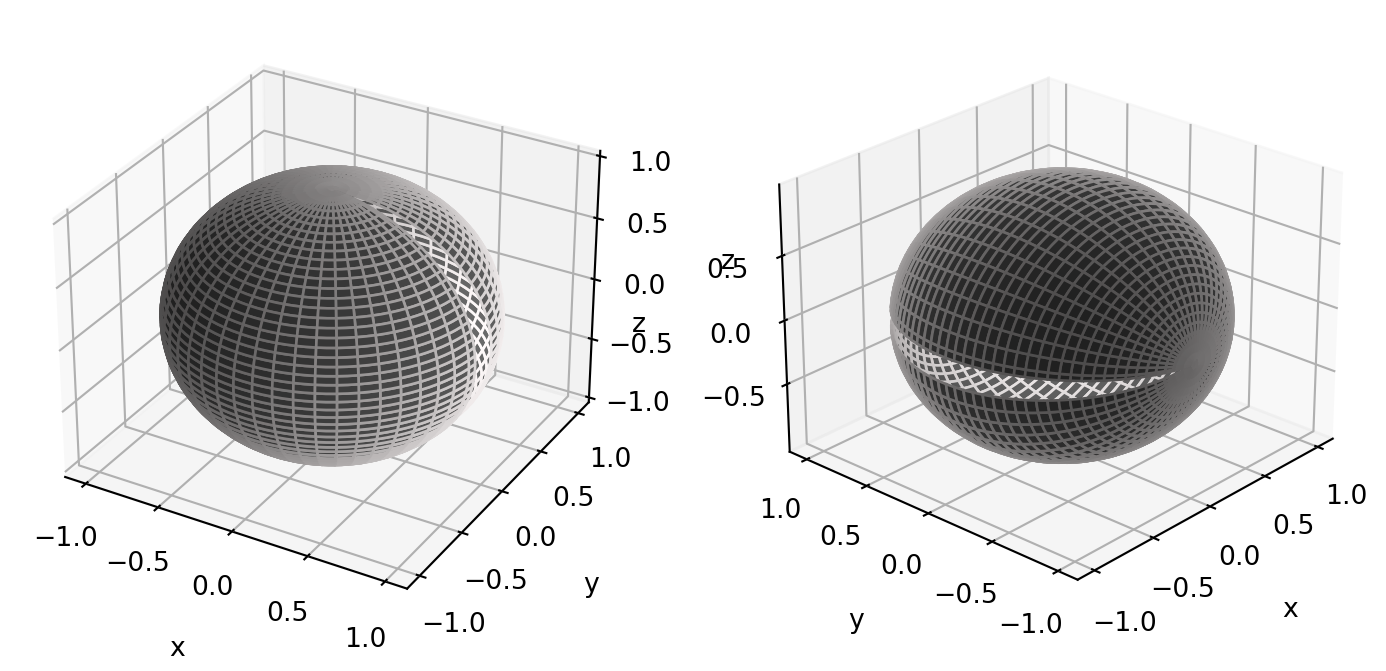
4 Surfaces
Curves are 1D objects in \(\mathbb{R}^3\), parametrized via functions \({\pmb{\gamma}}\colon (a,b) \to \mathbb{R}^3\). There is only one available direction in which to move on a curve:
- \(t \mapsto {\pmb{\gamma}}(t)\) moves forward on the curve
- \(t \mapsto {\pmb{\gamma}}(-t)\) moves backward on the curve
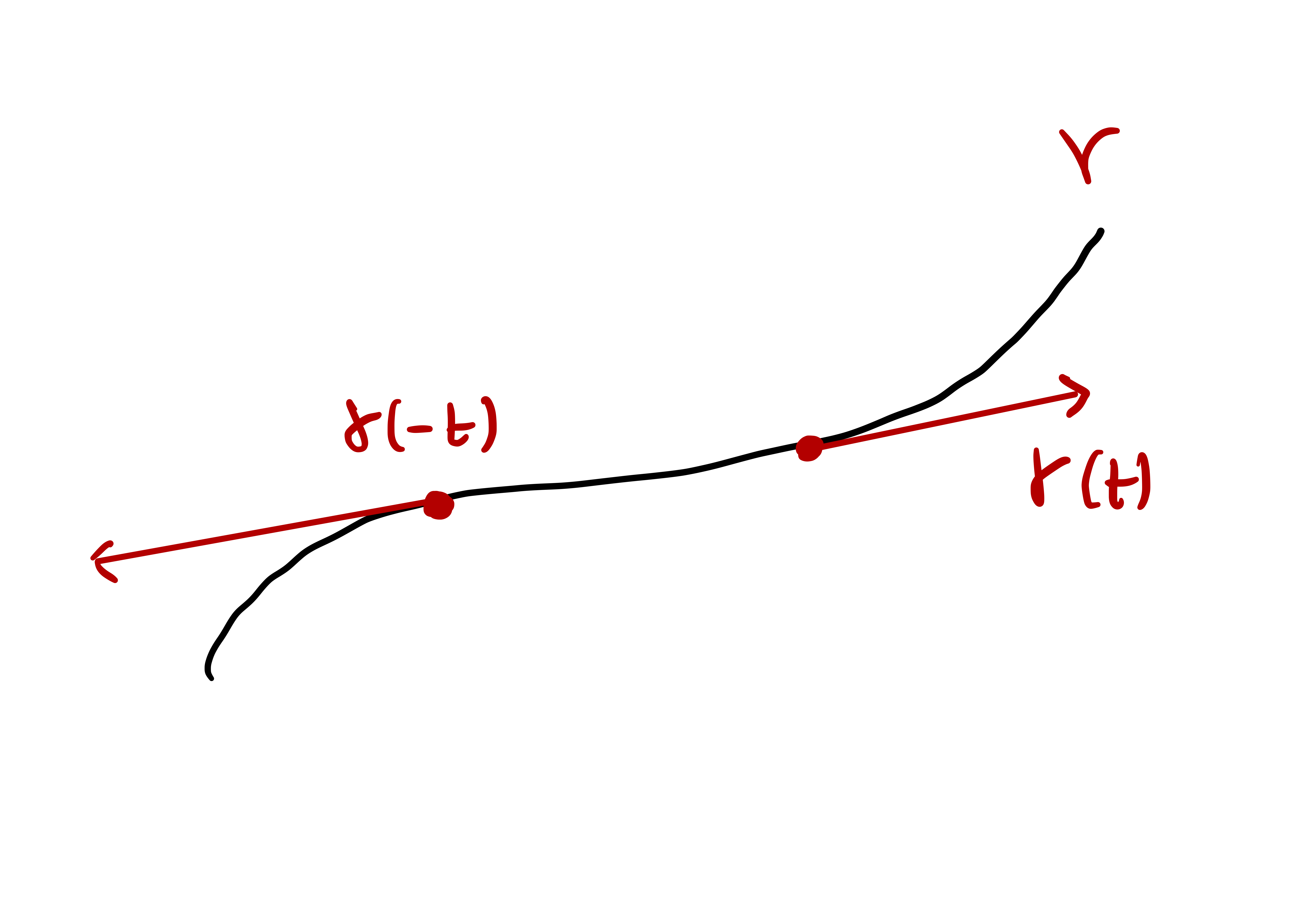
Surfaces are 2D objects in \(\mathbb{R}^3\). There are two directions in which one can move on a surface.
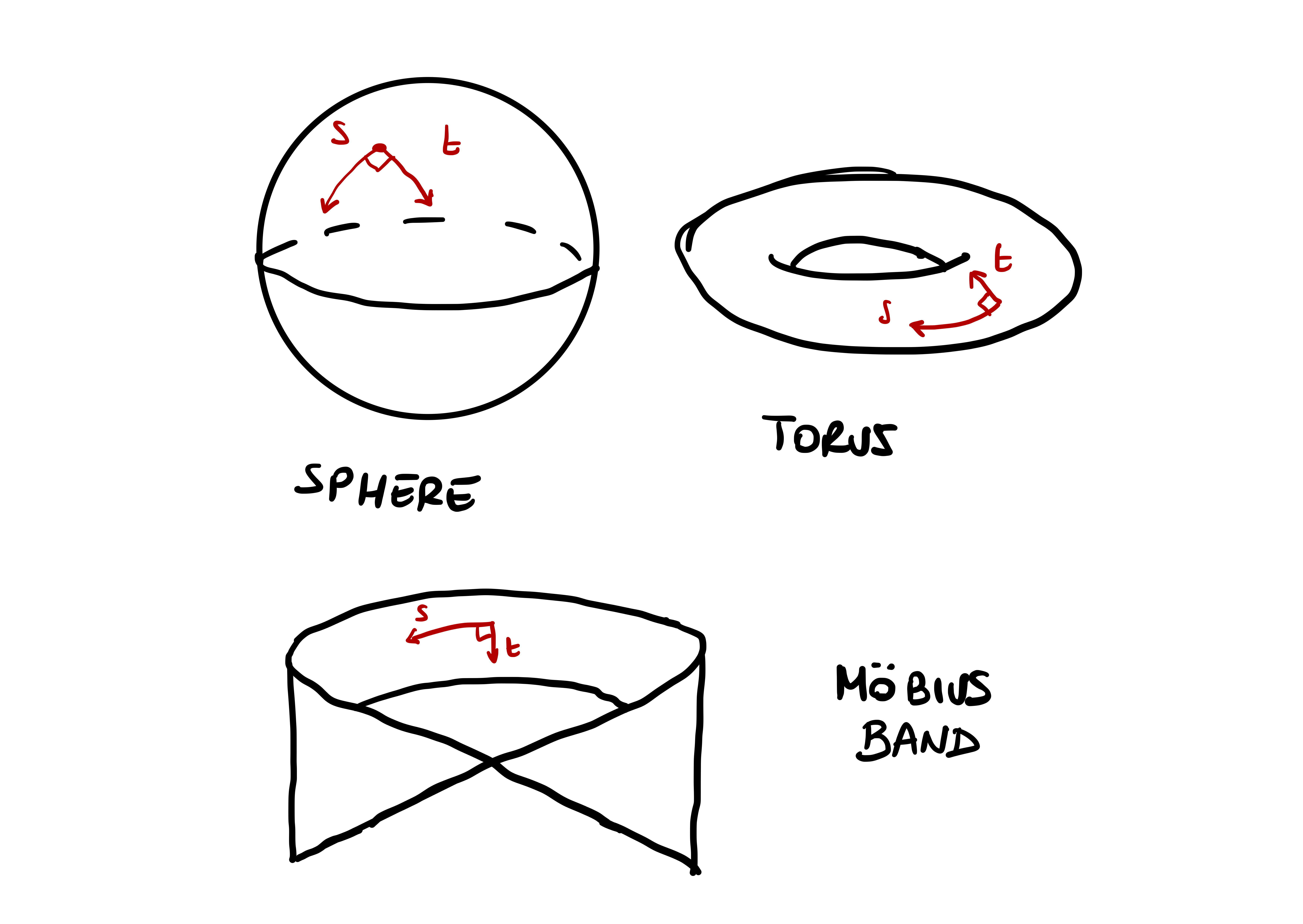
Question 1
A curve \(\Gamma \subseteq \mathbb{R}^3\) can be described with one function \({\pmb{\gamma}}\colon (a,b) \to \Gamma\). The idea is that \(\Gamma\) looks locally like \(\mathbb{R}\).
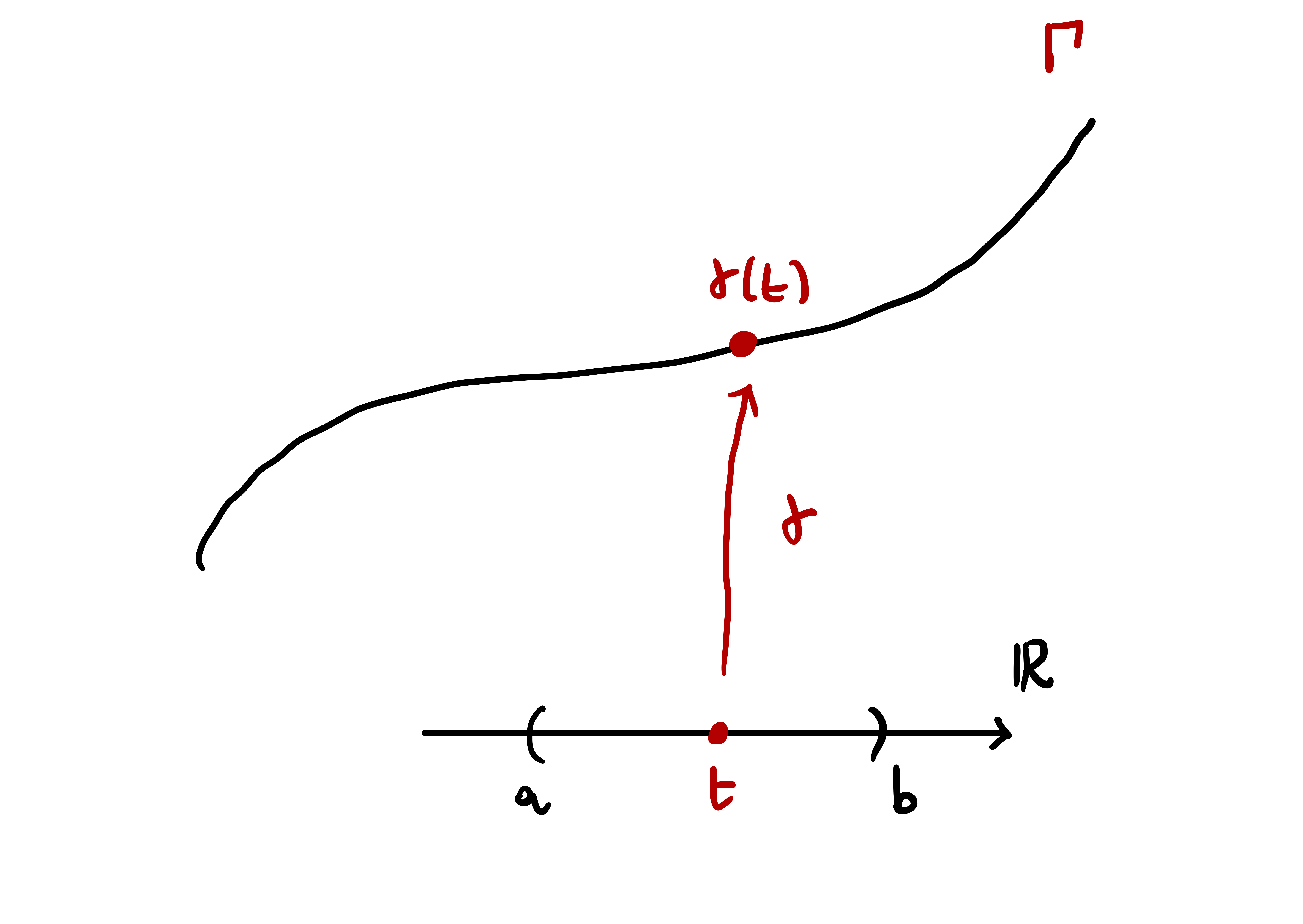
How do we represent a surface? Suppose given a function \({\pmb{\sigma}}\colon U \to \mathbb{R}^3\), with \(U \subseteq \mathbb{R}^2\) open set. Denote by \(\mathcal{S}:= {\pmb{\sigma}}(U)\) the image of \(U\) through \({\pmb{\sigma}}\). We say that \(\mathcal{S}\) is a surface and \({\pmb{\sigma}}\) is a chart. Unofortunately, not all surfaces can be described with just one chart: in most cases one needs to piece together many local charts \({\pmb{\sigma}}_i \colon U_i \to \mathcal{S}\), with \(U_i \subseteq \mathbb{R}^2\) open. The charts \({\pmb{\sigma}}_i\) represent \(\mathcal{S}\) if they cover the whole surface: \[ \mathcal{S}= \bigcup_{i} {\pmb{\sigma}}_i (U_i) \,. \]
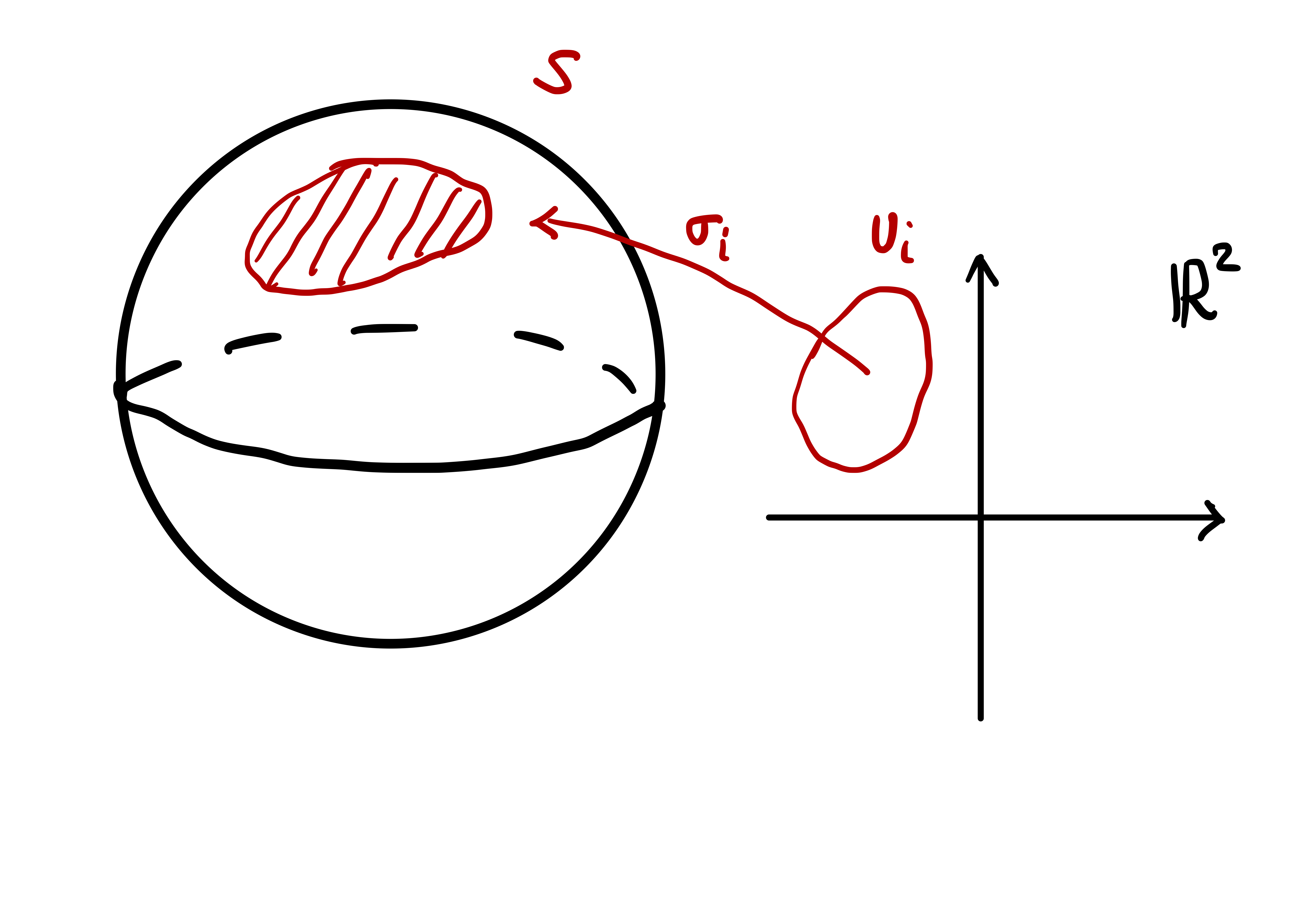
Before proceeding with the formal definition of surface, we collect some preliminary definitions and results.
4.1 Preliminaries
Before proceeding with the formal definition of surface, we need to establish some basic notation and terminology regarding linear algebra, the topology of \(\mathbb{R}^n\), and calculus for smooth maps from \(\mathbb{R}^n\) into \(\mathbb{R}^m\).
4.1.1 Linear algebra
Definition 2: Bilinear form
\(B\) is bilinear if \[\begin{align*} B(\lambda_1 \mathbf{v}_1 + \lambda_2 \mathbf{v}_2 , \mathbf{w}) & = \lambda_1 B(\mathbf{v}_1,\mathbf{w}) + \lambda_2 B(\mathbf{v}_2,\mathbf{w}) \,, \\ B(\mathbf{w}, \lambda_1 \mathbf{v}_1 + \lambda_2 \mathbf{v}_2 ) & = \lambda_1 B(\mathbf{w},\mathbf{v}_1) + \lambda_2 B(\mathbf{w}, \mathbf{v}_2) \,. \end{align*}\] for all \(\mathbf{v}_i,\mathbf{w}\in V\), \(\lambda_i \in \mathbb{R}\).
\(B\) is symmetric if \[ B(\mathbf{v},\mathbf{w}) = B(\mathbf{w}, \mathbf{v}) \] for all \(\mathbf{v},\mathbf{w}\in V\).
A bilinear map \(B\) is called bilinear form on \(V\).
Notation
Bilinear forms can be represented by a matrix.
Remark 3: Matrix representation for bilinear forms
Proof. We can write \(\mathbf{v}\) and \(\mathbf{w}\) in cordinates as \[ \mathbf{v}= \sum_{i=1}^n \lambda_i \mathbf{v}_i \,, \quad \mathbf{w}= \sum_{i=1}^n \mu_i \mathbf{v}_i \,, \] for suitable coefficients \(\lambda_i, \mu_i \in \mathbb{R}\). Using bilinearity of \(B\) we get \[\begin{align*} B(\mathbf{v},\mathbf{w}) & = B \left( \sum_{i=1}^n \lambda_i \mathbf{v}_i, \sum_{j=1}^n \mu_j \mathbf{v}_j \right) \\ & = \sum_{i,j=1}^n \lambda_i \mu_j B(\mathbf{v}_i,\mathbf{v}_j) \\ & = \mathbf{x}^T M \mathbf{y}\,. \end{align*}\]
Definition 4: Quadratic form
A symmetric bilinear form is uniquely determinded by its quadratic form, as stated in the following proposition.
Proposition 5
The proof is an easy check, and is left as an exercise.
Definition 6: Inner product
Let \(V\) be a vector space. An inner product on \(V\) is a symmetric bilinear form \(\left\langle \cdot,\cdot \right\rangle \colon V \times V \to \mathbb{R}\) such that \[ \left\langle \mathbf{v},\mathbf{v} \right\rangle > 0 \,, \quad \forall \, \mathbf{v}\in V \,. \] Moreover:
The length of a vector \(\mathbf{v}\in V\) with respect to \(B\) is defined as \[ \| \mathbf{v}\| := \sqrt{\left\langle \mathbf{v},\mathbf{v} \right\rangle} \,. \]
Two vectors \(\mathbf{v},\mathbf{w}\in V\) are orthogonal if \[ \left\langle \mathbf{v},\mathbf{w} \right\rangle = 0 \,. \]
Example 7
Proposition 8
Definition 9: Linear map
Remark 10: Matrix representation of linear maps
Definition 11: Eigenvalues and eigenvectors
Definition 12: Self-adjoint map
Theorem 13: Spectral Theorem
There is also a matrix version of the spectral theorem. To state it, we need to introduce some terminology.
Definition 14
Let \(A \in \mathbb{R}^{n \times n}\) be a matrix. We say that:
\(A\) is symmetric if \[ A^T = A \,. \]
\(A\) is orthogonal if \[ A^T A = I \,, \] where \(I\) is the identity matrix.
Remark 15
Let \(L \colon V \to V\) be linear and \(A \in \mathbb{R}^{n \times n}\) be the matrix associated to \(L\) with respect to any basis \(\{\mathbf{v}_1,\ldots,\mathbf{v}_n\}\) of \(V\). They are equivalent:
- \(L\) is self-adjoint,
- \(A\) is symmetric.
Definition 16: Matrix eigenvalues
Remark 17
Remark 18
Let \(L \colon V \to V\) be a linear map and \(A\) the associated matrix with respect to any basis of \(V\). Then \[ L(\mathbf{v}) = A \mathbf{x}\,, \quad \, \forall \, \mathbf{v}\in V\,, \] where \(\mathbf{x}\in \mathbb{R}^n\) is the vector of coordinates of \(\mathbf{v}\). They are equivalent:
- \(\lambda\) is an eigenvalue of \(L\) of eigenvector \(\mathbf{v}\),
- \(\lambda\) is an eigenvalue of \(A\) of eigenvector \(\mathbf{x}\).
Theorem 19: Spectral Theorem for matrices
Remark 20
4.1.2 Topology of \(\mathbb{R}^n\)
Definition 21: Topology of \(\mathbb{R}^n\)
The Euclidean norm on \(\mathbb{R}^n\) is denoted by \[ \| \mathbf{x}\| := \sqrt{ \sum_{i=1}^n x_i^2 }\,, \quad \mathbf{x}= (x_1 , \ldots, x_n) \in \mathbb{R}^n \,. \] Define the Euclidean distance \(d(\mathbf{x},\mathbf{y}) = \| \mathbf{x}- \mathbf{y}\|\).
The pair \((\mathbb{R}^n,d)\) is a metric space.
The topology induced by the metric \(d\) is called the Euclidean topology, denoted by \(\mathcal{T}\).
A set \(U \subseteq \mathbb{R}^n\) is open if for all \(\mathbf{x}\in U\) there exists \(\varepsilon>0\) such that \(B_{\varepsilon}(\mathbf{x}) \subseteq U\), where \[ B_{\varepsilon}(\mathbf{x}) := \{ \mathbf{y}\in \mathbb{R}^n \, \colon \,\| \mathbf{x}- \mathbf{y}\| < \varepsilon\} \] is the open ball of radius \(\varepsilon>0\) centered at \(\mathbf{x}\). We write \(U \in \mathcal{T}\), with \(\mathcal{T}\) the Euclidean topology in \(\mathbb{R}^n\).
A set \(V \subseteq \mathbb{R}^n\) is closed if \(V^c := \mathbb{R}^n \smallsetminus U\) is open.
Example 22
The \(n\)-dimensional unit sphere \[ \mathbb{S}^n = \{ \mathbf{x}\in \mathbb{R}^{n+1} \, \colon \,\| \mathbf{x}\| = 1 \} \] is closed in \(\mathbb{R}^{n+1}\). Indeed, define \(f \colon \mathbb{R}^n \to \mathbb{R}\) by \[ f(\mathbf{x}) = \| \mathbf{x}\| \,. \] Then \(f\) is continuous and \[ \mathbb{S}^n = f^{-1}(\{1\}) \,. \] Since \(\{1\}\) is closed in \(\mathbb{R}\), and \(f\) is continuous, we conclude that \(\mathbb{S}^n\) is closed.
The \(n\)-dimensional unit cube \[ C := \{ \mathbf{x}\in \mathbb{R}^n \, \colon \,|x_1| + \ldots + |x_n| <1 \} \] is open in \(\mathbb{R}^n\). Indeed, define \(f \colon \mathbb{R}^n \to \mathbb{R}\) by \[ f(\mathbf{x}) = |x_1| + \ldots + |x_n| \,. \] Then \(f\) is continuous and \[ C = f^{-1}((-\infty,1)) \,. \] Since \((-\infty,1)\) is open in \(\mathbb{R}\), and \(f\) is continuous, we conclude that \(C\) is open.
The set \[ V := \{ \mathbf{x}\in \mathbb{R}^n \, \colon \,|x_1| + \ldots + |x_n| \geq 1 \} \] is closed, since \(V^c = C\) is the unit cube, which is open.
Definition 23: Subspace Topology
4.1.3 Smooth functions
We recall some basic facts about smooth functions from \(\mathbb{R}^n\) into \(\mathbb{R}^m\). For a vector valued function \(f \colon \mathbb{R}^n \to \mathbb{R}^m\) we denote its components by \[ f = (f_1,\ldots,f_m) \,. \]
Definition 24: Continuous Function
The above ``classical’’ definition of continuity is equivalent to the topological one, in the following sense:
Theorem 25: Continuity: Topological definition
Definition 26: Homeomorphism
Let \(f \colon U \subseteq \mathbb{R}^n \to V \subseteq \mathbb{R}^m\) with \(U,V\) open. We say that \(f\) is a homeomorphism if:
- \(f\) is continuous;
- \(f\) admits continuous inverse \(f^{-1} \colon V \to U\).
Definition 27: Differentiable Function
The idea behind the definition of differentiability is as follows: The function \(f\) is differentiable at \(\mathbf{x}\) if it can be approximated by the linear map \(d_{\mathbf{x}} f\) around the point \(\mathbf{x}\).
We denote by \(\{\mathbf{e}_i\}_{i=1}^n\) the standard basis of \(\mathbb{R}^n\). When \(f\) is differentiable, the partial derivatives are defined as follows:
Definition 28: Partial Derivative
Definition 29: Jacobian Matrix
The differential \(d_{\mathbf{x}} f \colon \mathbb{R}^n \to \mathbb{R}^m\) is a linear map. As such, it must have a matrix representation with respect to the Euclidean basis. Since the partial derivative is defined as \[ \frac{\partial f}{\partial x_i}(\mathbf{x}):= d_{\mathbf{x}} f(\mathbf{e}_i) \,, \] we trivially have that \(Jf(\mathbf{x})\) is the matrix of \(d_{\mathbf{x}} f\) with respect to the standard basis:
Proposition 30: Matrix representation of \(d_{\mathbf{x}} f\)
Definition 31: Multi-index notation
Definition 32: Smooth Function
Notation: Gradient and partial derivatives
For \(f \colon U \subseteq \mathbb{R}^n \to \mathbb{R}\) smoothm, the gradient is \[ \nabla f (\mathbf{x}) = \left( f_{x_1}(\mathbf{x}) , \ldots , f_{x_n}(\mathbf{x}) \right) \,. \] Note that \(\nabla f(\mathbf{x})\) coincides with \(Jf(\mathbf{x})\).
Example 33
4.1.4 Diffeomorphisms
A key definition needed for the study of surfaces is the one of diffeomorphism. In this section we only consider maps from \(\mathbb{R}^n\) into \(\mathbb{R}^n\).
Definition 34: Diffeomorphism
Let \(f \colon U \to V\), with \(U,V \subseteq \mathbb{R}^n\) open. We say that \(f\) is a diffeomorphism between \(U\) and \(V\) if:
- \(f\) is smooth,
- \(f\) admits smooth inverse \(f^{-1} \colon V \to U\).
Definition 35: Local diffeomorphism
\(f \colon \mathbb{R}^n \to \mathbb{R}^n\) is a local diffeomorphism at \(\mathbf{x}_0 \in \mathbb{R}^n\) if:
- There exists an open set \(U \subseteq \mathbb{R}^n\) such that \(\mathbf{x}_0 \in U\),
- There exists an open set \(V \subseteq \mathbb{R}^n\) such that \(f(\mathbf{x}_0) \in V\),
- \(f \colon U \to V\) is a diffeomorphism.
Proposition 36
Non-vanishing Jacobian determinant is a necessary condition for being a diffeomorphism, as outlined in the following Proposition.
Proposition 37: Necessary condition for being diffeomorphism
Example 38
The condition at (4.1) is sufficient fot \(f\) to be a local diffeomorphism at \(\mathbf{x}_0\). This is the content of the Inverse Function Theorem.
Theorem 39: Inverse Function Theorem
Let \(f \colon U \to \mathbb{R}^n\) with \(U \subseteq \mathbb{R}^n\) open, \(f\) smooth. Assume \[ \det J f(\mathbf{x}_0) \neq 0 \,, \] for some \(\mathbf{x}_0 \in U\). Then:
- There exists an open set \(U_0 \subseteq U\) such that \(\mathbf{x}_0 \in U_0\),
- There exists an open set \(V\) such that \(f(\mathbf{x}_0) \in V\),
- \(f \colon U_0 \to V\) is a diffeomorphism.
Example 40
Warning
- \(\det J f(\mathbf{x}) \neq 0\) for all \(\mathbf{x}\in U\),
- \(f\) is not a diffeomorphism between \(U\) and \(f(U)\).
We will show this in the next Example.
Example 41: A local diffeomorphism which is not global
Prove \(f\) is a local diffeomorphism but not a diffeomorphism.
Solution. \(f\) is a local diffeomorphism at each point \((x,y) \in \mathbb{R}^2\) by the Inverse Function Theorem, since \[\begin{align*} & J f (x,y) = e^x \left( \begin{array}{cc} \cos(y) & \sin(y) \\ -\sin(y) & \cos(y) \end{array} \right) \\ & \det Jf(x,y) = e^{2x} \neq 0 \,. \end{align*}\] However, \(f\) is not invertible because it is not injective, since \[ f(x,y) = f(x, y + 2n\pi) \,, \quad \forall\, (x,y) \in \mathbb{R}^2 , \, n \in \mathbb{N}\,. \] Hence, \(f\) cannot be a diffeomorphism of \(\mathbb{R}^2\) into \(\mathbb{R}^2\).
4.2 Surfaces
We give the main definition of surface in \(\mathbb{R}^3\).
Definition 42: Surface
- \(\mathbf{p}\in {\pmb{\sigma}}(U)\),
- \({\pmb{\sigma}}(U)\) is open in \(\mathcal{S}\),
- \({\pmb{\sigma}}\) is a homeomorphism between \(U\) and \({\pmb{\sigma}}(U)\).
\({\pmb{\sigma}}\) is called a surface chart at \(\mathbf{p}\).
A visual interpretation of the definition of surface is given in Figure 4.1.
Remark 43
\(\mathcal{S}\) is a topological space with the subspace topology induced by the inclusion \(\mathcal{S}\subseteq \mathbb{R}^3\). This means that a subset \(V \subseteq \mathcal{S}\) is open in \(\mathcal{S}\), if there exists an open set \(W \subseteq \mathbb{R}^3\) such that \[ V = W \cap \mathcal{S}\,. \]
\(\mathcal{S}\) is required to be connected with respect to the subspace topology.
A surface chart \({\pmb{\sigma}}\) is a map \[ {\pmb{\sigma}}\colon U \to \mathbb{R}^3 \,, \] with \(U \subseteq \mathbb{R}^2\) open. Therefore smoothness of \({\pmb{\sigma}}\) is intended in the classical sense.
Given a chart \({\pmb{\sigma}}\colon U \to {\pmb{\sigma}}(U)\), the set \(U\) is open in \(\mathbb{R}^2\) while \({\pmb{\sigma}}(U)\) is open in \(\mathcal{S}\) with the subspace topology. This means there exists and open set \(W \subseteq \mathbb{R}^3\) such that \[ {\pmb{\sigma}}(U) = W \cap \mathcal{S}\,. \]
The homeomorphism condition is saying that the surface patch \[ {\pmb{\sigma}}(U) \subseteq \mathcal{S} \] can be continuously deformed into the open set \[ U \subseteq \mathbb{R}^2 \,. \]
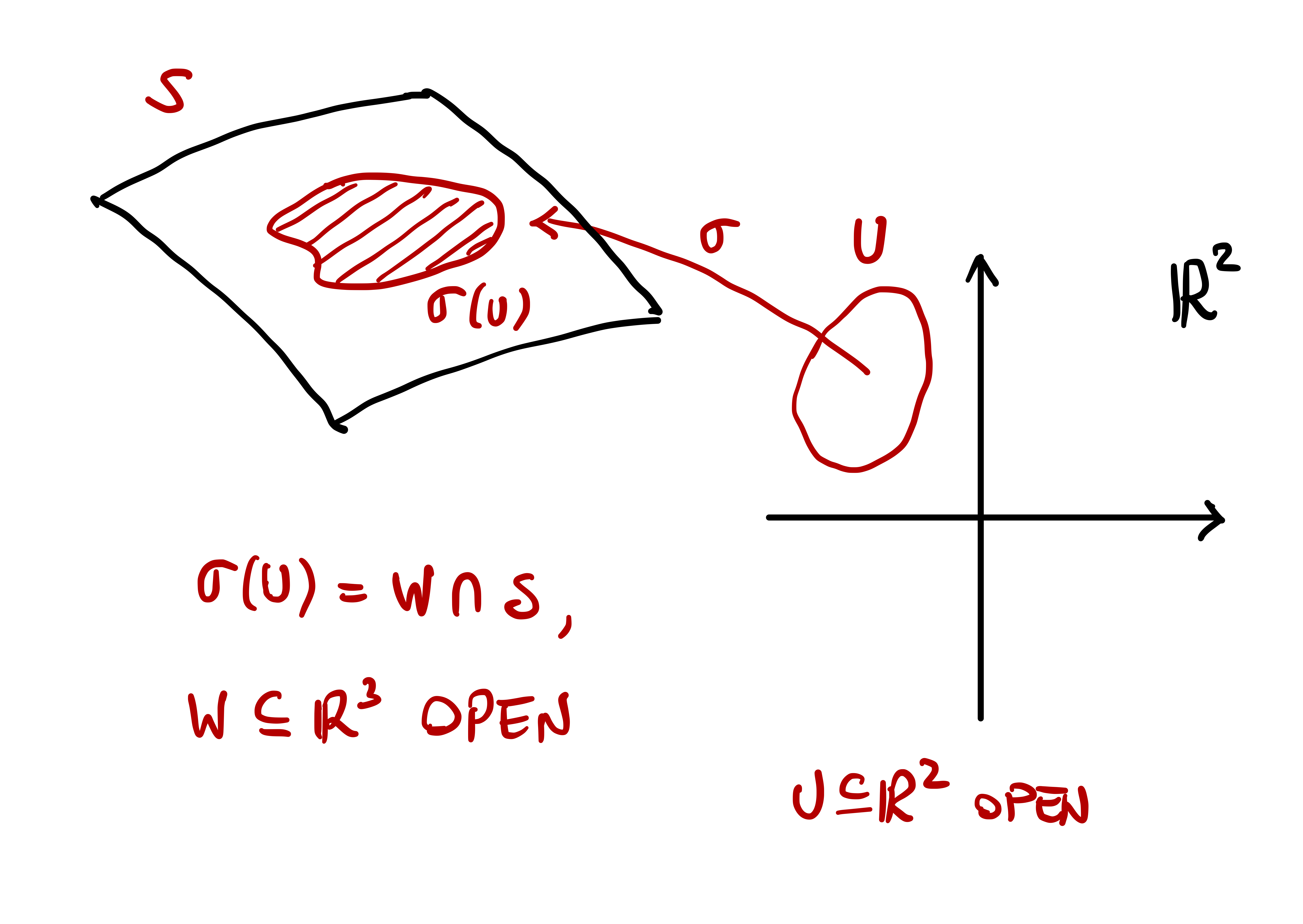
Notation
Points in \(U\) will be denoted with the pair \((u,v)\).
Partial derivatives of a chart \({\pmb{\sigma}}= {\pmb{\sigma}}(u,v)\) will be denoted by \[ {\pmb{\sigma}}_u := \frac{\partial {\pmb{\sigma}}}{\partial u} \,, \quad {\pmb{\sigma}}_v := \frac{\partial {\pmb{\sigma}}}{\partial v} \,. \] Similar notations are adopted for higher order derivatives, e.g., \[\begin{align*} {\pmb{\sigma}}_{uu} & := \frac{\partial^2 {\pmb{\sigma}}}{\partial u^2} \,, & {\pmb{\sigma}}_{uv} & := \frac{\partial^2 {\pmb{\sigma}}}{\partial u \partial v} \,, \\ {\pmb{\sigma}}_{vu} & := \frac{\partial^2 {\pmb{\sigma}}}{\partial v \partial u } \,, & {\pmb{\sigma}}_{vv} & := \frac{\partial^2 {\pmb{\sigma}}}{\partial v^2 } \,, \\ \end{align*}\]
Components of \({\pmb{\sigma}}\) will be denoted by \[ {\pmb{\sigma}}= (\sigma^1, \sigma^2, \sigma^3) = (x,y,z) \,. \]
An atlas of a surface is a collection of charts which cover the whole surface:
Definition 44: Atlas of a surface
Example 45: 2D Plane in \(\mathbb{R}^3\)
- \(\mathbf{p},\mathbf{q} \in \mathbb{R}^3\) be orthonormal, and orthogonal to \(\mathbf{w}\).
- \(\mathbf{a} \in {\pmb{\pi}}\) be any point in the plane.
This construction is represented in Figure 4.2. Let \(\mathbf{x}\in {\pmb{\pi}}\). Then \(\mathbf{x}-\mathbf{a}\) satisfies \[ (\mathbf{x}- \mathbf{a}) \cdot \mathbf{w}= 0 \,. \] Hence, the vector \(\mathbf{x}- \mathbf{a}\) is orthogonal to \(\mathbf{w}\), meaning it can be written as linear combination of the vectors \(\mathbf{p}\) and \(\mathbf{q}\): \[ \mathbf{x}- \mathbf{a} = u \mathbf{p}+ v \mathbf{q} \,, \] for some coefficients \(u,v \in \mathbb{R}\). Therefore the plane \({\pmb{\pi}}\) can be equivalently represented as \[ {\pmb{\pi}}= \{ \mathbf{a} + u \mathbf{p}+ v \mathbf{q} \, \colon \,u,v \in \mathbb{R}\} \,. \] The above suggests to define the chart \({\pmb{\sigma}}\colon \mathbb{R}^2 \to {\pmb{\pi}}\) by \[ {\pmb{\sigma}}(u,v):= \mathbf{a} + u \mathbf{p}+ v \mathbf{q} \,. \] Then \({\pmb{\sigma}}\) is a chart for \({\pmb{\pi}}\), and \[ \mathcal{A} = \{{\pmb{\sigma}}\} \] is an atlas, implying that \({\pmb{\pi}}\) is a surface.
Proof. Check that \({\pmb{\sigma}}\) is a chart:
- \({\pmb{\sigma}}\) is smooth.
- \(\mathbb{R}^2\) is obviously open.
- \({\pmb{\sigma}}(\mathbb{R}^2)\) is open in \({\pmb{\pi}}\) for the subspace topology, since \({\pmb{\sigma}}(\mathbb{R}^2) = {\pmb{\pi}}\), and \({\pmb{\pi}}\) is open in the subspace topology.
- Suppose \(\mathbf{x}= {\pmb{\sigma}}(u,v)\). Then \[ (\mathbf{x}- \mathbf{a}) \cdot \mathbf{p}= u \,, \quad (\mathbf{x}- \mathbf{a}) \cdot \mathbf{q} = v \,, \] given that \(\mathbf{p}\) and \(\mathbf{q}\) are orthonormal.
- The above shows that the inverse of \({\pmb{\sigma}}\) is \({\pmb{\sigma}}^{-1} \colon {\pmb{\pi}}\to \mathbb{R}^2\) given by \[ {\pmb{\sigma}}^{-1} (\mathbf{x}) = ( (\mathbf{x}- \mathbf{a}) \cdot \mathbf{p}, (\mathbf{x}- \mathbf{a}) \cdot \mathbf{q} ) \,. \] Clearly, \({\pmb{\sigma}}^{-1}\) is continuous.
- Thus, \({\pmb{\sigma}}\) is a homeomorphism between \(\mathbb{R}^2\) and \({\pmb{\pi}}\).
- Therefore \({\pmb{\sigma}}\) is a chart for \({\pmb{\pi}}\). Since
Notice that \[ {\pmb{\sigma}}(\mathbb{R}^2) = {\pmb{\pi}}\,, \] and therefore \(\mathcal{A} = \{{\pmb{\sigma}}\}\) is an atlas for \({\pmb{\pi}}\), showing that \({\pmb{\pi}}\) is a surface.
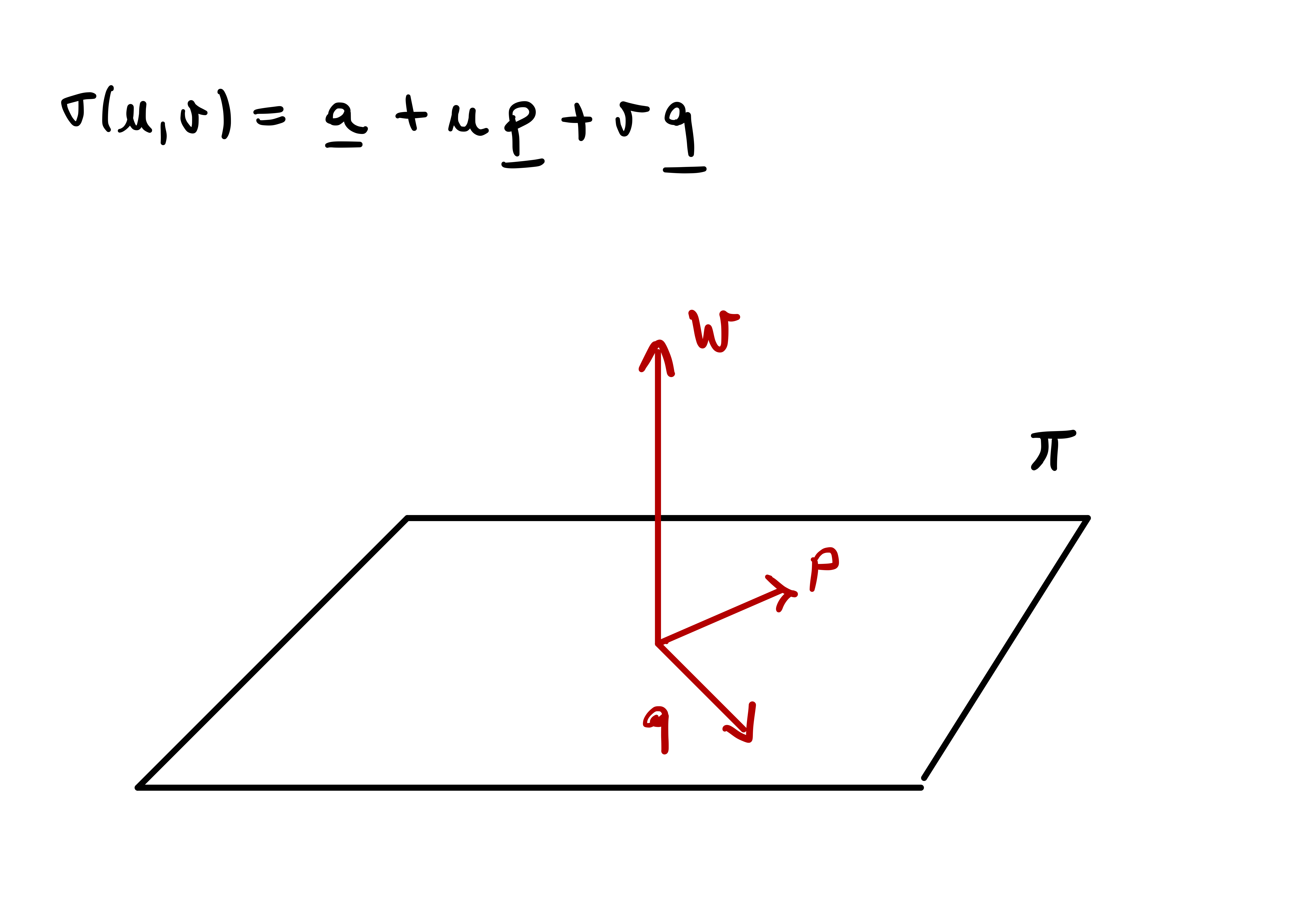
Example 46: Unit cylinder
Consider the infinite unit cylinder \[ \mathcal{S}= \{ (x,y,z) \in \mathbb{R}^3 \, \colon \,x^2 + y^2 = 1 \} \,. \] Define the map \[ {\pmb{\sigma}}\colon \mathbb{R}^2 \to \mathbb{R}^3 \,, \quad {\pmb{\sigma}}(u,v):= (\cos(u),\sin(u),v) \,. \] Setting \(V := [0,2\pi) \times \mathbb{R}\), we notice that \[ {\pmb{\sigma}}(V) = \mathcal{S}\,. \] Moreover \({\pmb{\sigma}}\colon V \to \mathcal{S}\) is clearly bijective, with inverse \[ {\pmb{\sigma}}^{-1}(x,y,z) = (\theta,z) \,, \] with \(\theta\) the angle formed by the vector \(\mathbf{p}= (x,y)\) with the \(x\)-axis. However, \(V\) is not open in \(\mathbb{R}^2\), and therefore \({\pmb{\sigma}}\) cannot be a chart. To overcome this issue, let us cover \(V\) with two open sets: For example, \[ U_1 := \left( 0,\frac{ 3 \pi}{2} \right) \times \mathbb{R}\,, \quad \left( \pi,\frac{ 5 \pi}{2} \right) \times \mathbb{R}\,, \] so that \[ V = U_1 \cup U_2 \,, \] with \(U_1\) and \(U_2\) open. We can now define two charts \[ {\pmb{\sigma}}_1 \colon U_1 \to \mathcal{S}\,, \quad {\pmb{\sigma}}_2 \colon U_2 \to \mathcal{S}\,, \] by restricting \({\pmb{\sigma}}\): \[ {\pmb{\sigma}}_1 := {\pmb{\sigma}}|_{U_1} \,, \quad {\pmb{\sigma}}_2 := {\pmb{\sigma}}|_{U_2} \,. \] The images of the two charts \({\pmb{\sigma}}_1\) and \({\pmb{\sigma}}_2\) are shown in Figure 4.3. We have that \(\mathcal{S}\) is a surface with the atlas \[ \mathcal{A} = \{ {\pmb{\sigma}}_1, {\pmb{\sigma}}_2\} \,. \]
Check:
- \({\pmb{\sigma}}_i\) is smooth, since \({\pmb{\sigma}}\) is smooth.
- \(U_i\) is clearly open in \(\mathbb{R}^2\).
- One can check that \({\pmb{\sigma}}_i(U_i)\) is open in \(\mathcal{S}\).
- \({\pmb{\sigma}}_i\) is clearly invertible from \(U_i\) to \({\pmb{\sigma}}_i(U_i)\), and the inverse is continuous.
- Thus, \({\pmb{\sigma}}_i\) is a homeomorphism between \(U_i\) and \({\pmb{\sigma}}(U_i)\).
- \(\mathcal{A} = \{{\pmb{\sigma}}_1 , {\pmb{\sigma}}_2\}\) is an atlas for \(\mathcal{S}\), since \[ \mathcal{S}= {\pmb{\sigma}}_1(U_1) \cup {\pmb{\sigma}}_2(U_2) \,. \]
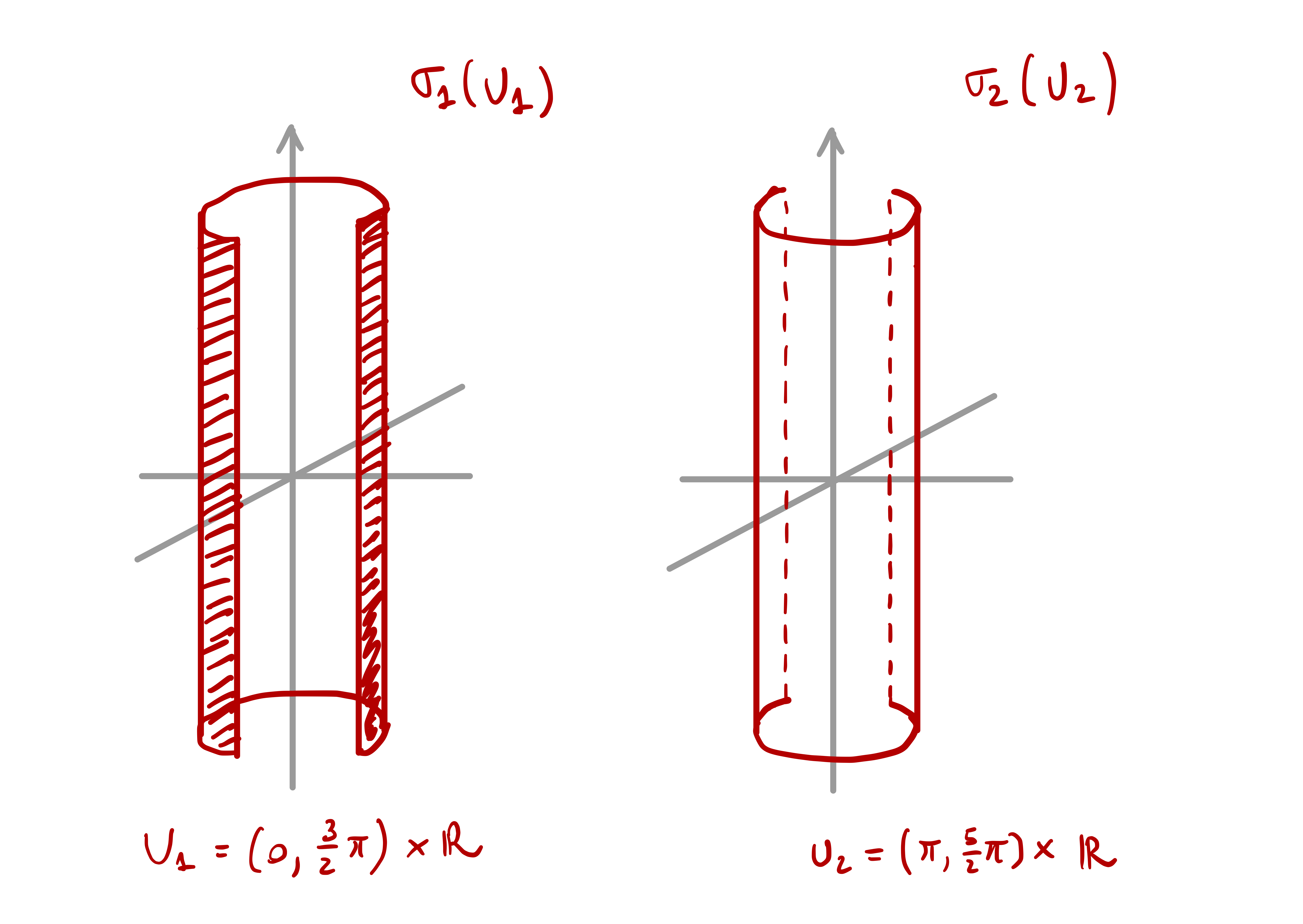
Example 47: Graph of a function
Let \(U \subseteq \mathbb{R}^2\) be open and \(f \colon U \to \mathbb{R}\) be smooth. The graph of \(f\) is the set \[ \Gamma_f := \left\{ (u,v,f(u,v)) \, \colon \,(u,v) \in U \right\} \,. \] \(\Gamma_f\) is a surface with atlas given by \[ \mathcal{A} = \{ {\pmb{\sigma}}\} \] where \({\pmb{\sigma}}\colon U \to \Gamma_f\) is \[ {\pmb{\sigma}}(u,v):=(u,v,f(u,v)) \,. \]
Proof. Let us check that \(\Gamma_f\) is a surface:
- \({\pmb{\sigma}}\) is smooth since \(f\) is smooth.
- \(U\) is open in \(\mathbb{R}^2\) by assumption.
- \({\pmb{\sigma}}(U) = \Gamma_f\), and therefore \({\pmb{\sigma}}(U)\) is open in \(\Gamma_f\).
- The inverse of \({\pmb{\sigma}}\) is given by \({{\pmb{\sigma}}}^{-1} \colon \Gamma_f \to U\) defined as \[ {{\pmb{\sigma}}}^{-1}(u,v,f(u,v)) := (u,v) \,. \] Clearly \({{\pmb{\sigma}}}^{-1}\) is continuous.
- Therefore \({\pmb{\sigma}}\) is a homeomorphism of \(U\) into \(\Gamma_f\).
- \(\mathcal{A}=\{{\pmb{\sigma}}\}\) is an atlas for \(\Gamma_f\), since \[ \Gamma_f = {\pmb{\sigma}}(U) \,. \]
Let us conclude the section with an example of a set which is not a surface.
Example 48: Circular cone
To see that \(\mathcal{S}\) is not a surface, suppose there exists an atlas \(\{{\pmb{\sigma}}_i\}\) of \(\mathcal{S}\) \[ {\pmb{\sigma}}_i \colon U_i \to {\pmb{\sigma}}_i(U_i) \subseteq \mathcal{S}\,. \] In particular there exists a chart \({\pmb{\sigma}}\) such that \[ {\pmb{0}}\in {\pmb{\sigma}}(U) \,. \] Let \(\mathbf{x}_0 \in U\) be the point such that \[ {\pmb{\sigma}}(\mathbf{x}_0) = {\pmb{0}}\,. \] Since \(U\) is open in \(\mathbb{R}^2\), there exists \(\varepsilon>0\) such that \(B_{\varepsilon}(\mathbf{x}_0) \subseteq U\). Since \({\pmb{\sigma}}\) is a homeomorphism, we deduce that \[ {\pmb{\sigma}}(B_{\varepsilon}(\mathbf{x}_0)) \] is open in \(\mathcal{S}\). Hence there exists an open set \(W\) in \(\mathbb{R}^3\) such that \[ {\pmb{\sigma}}(B_{\varepsilon}(\mathbf{x}_0)) = {\pmb{\sigma}}(U) \cap W \,. \] As \({\pmb{0}}\in {\pmb{\sigma}}(B_{\varepsilon}(\mathbf{x}_0))\), we conclude that \({\pmb{0}}\in W\). Since \(W\) is open in \(\mathbb{R}^3\), there exists \(\delta > 0\) such that \[ B_{\delta} ({\pmb{0}}) \subseteq W \,. \] In particular, we deduce that \[ {\pmb{\sigma}}(U) \cap B_{\delta} ({\pmb{0}}) \subseteq {\pmb{\sigma}}(U) \cap W = {\pmb{\sigma}}(B_{\varepsilon}(\mathbf{x}_0)) \,. \] The ball \(B_{\delta} ({\pmb{0}})\) intersects both \(\mathcal{S}^-\) and \(\mathcal{S}^+\), with \[ \mathcal{S}^- := \mathcal{S}\cap \{ z < 0 \} \,, \quad \mathcal{S}^+ := \mathcal{S}\cap \{ z > 0 \} \,. \] Therefore \({\pmb{\sigma}}(B_{\varepsilon}(\mathbf{x}_0))\) intersects both \(\mathcal{S}^-\) and \(\mathcal{S}^+\). This implies that the set \[ V := {\pmb{\sigma}}(B_{\varepsilon}(\mathbf{x}_0)) \smallsetminus \{{\pmb{0}}\} \] is disconnected, with disconnection given by \[ V = ( V \cap \mathcal{S}^- ) \cup (V \cap \mathcal{S}^+) \,. \] However, \(V\) is homeomorphic to \[ B_{\varepsilon} (\mathbf{x}_0) \smallsetminus \{ \mathbf{x}_0 \} \,, \] which is instead connected. We have obtained a contradiction, and therefore \(\mathcal{S}\) is not a surface.
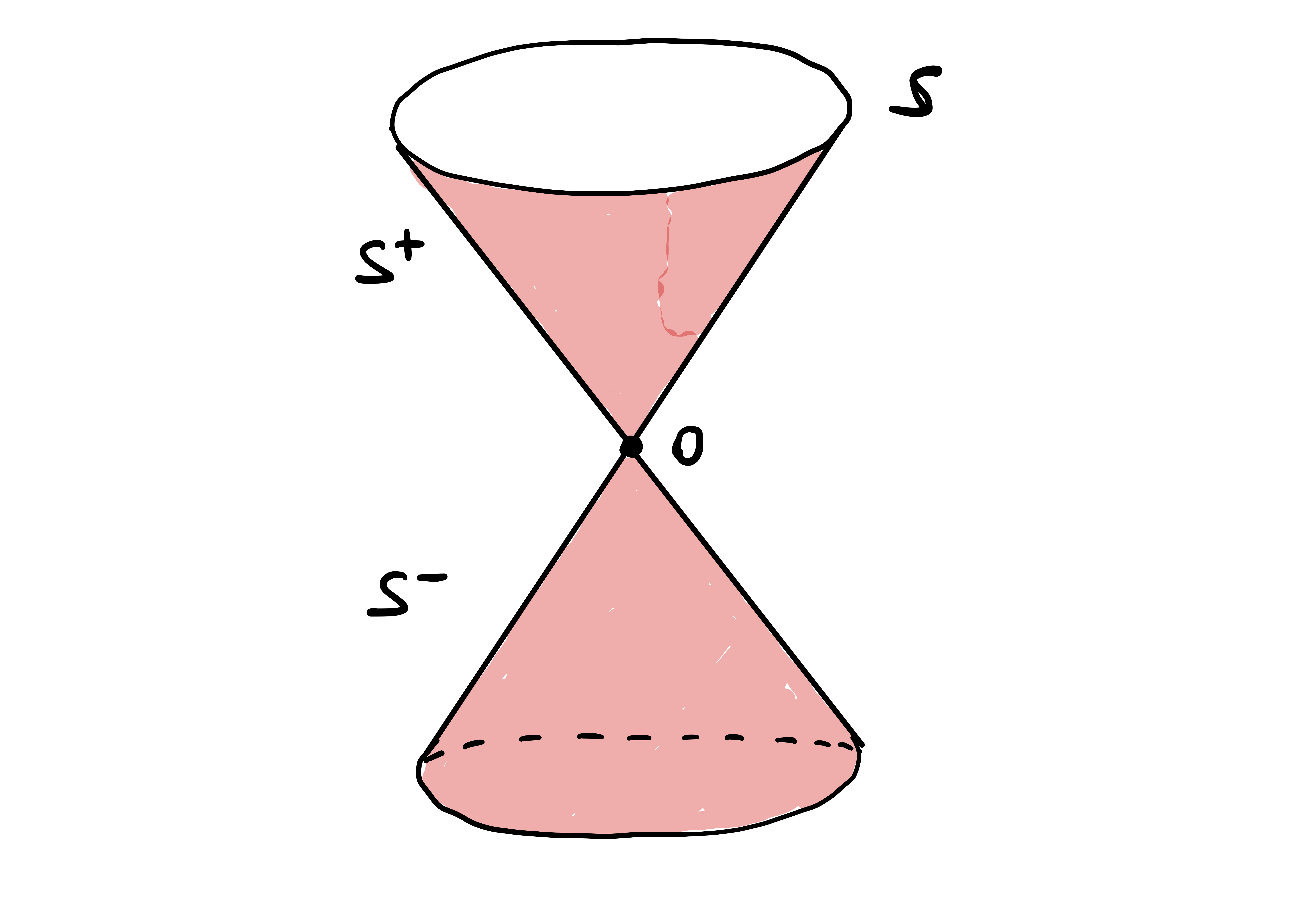
4.3 Regular Surfaces
We have defined a regular curve to be a map \({\pmb{\gamma}}\colon (a,b) \to \mathbb{R}^n\) such that \[ \left\| \dot{{\pmb{\gamma}}}(t) \right\| \neq 0 \,, \quad \forall \, t \in (a,b) \,. \] Regularity allowed us to reparametrize by arc-length and define the Frenet frame, curvature and torsion. We then proved that curvature and torsion completely characterize \({\pmb{\gamma}}\), up to rigid motions.
We want to do something similar for surfaces: We look for a condition that eventually will allow us to define the tangent plane to the surface. Specifically, we require that the partial derivatives \({\pmb{\sigma}}_u\) and \({\pmb{\sigma}}_v\) of a chart \({\pmb{\sigma}}\) are linearly independent. In this case \({\pmb{\sigma}}\) is called a regular chart. In details:
Definition 49: Regular Chart
We are now ready to define regular surfaces.
Definition 50: Regular surface
Let \(\mathcal{S}\) be a surface. We say that:
- \(\mathcal{A}\) is a regular atlas if any \({\pmb{\sigma}}\) in \(\mathcal{A}\) is regular.
- \(\mathcal{S}\) is a regular surface if it admits a regular atlas.
Before making some examples, we highlight give some equivalent methods for checking the regularity condition.
Theorem 51: Characterization of regular charts
Let \({\pmb{\sigma}}\colon U \to \mathbb{R}^3\) with \(U \subseteq \mathbb{R}^2\) open. They are equivalent:
- \({\pmb{\sigma}}\) is a regular chart.
- \(d_{\mathbf{x}} {\pmb{\sigma}}\colon \mathbb{R}^2 \to \mathbb{R}^3\) is injective for all \(\mathbf{x}\in U\).
- The Jacobian matrix \(J {\pmb{\sigma}}\) has rank \(2\) for all \((u,v) \in U\).
- \({\pmb{\sigma}}_u \times {\pmb{\sigma}}_v \neq 0\) for all \((u,v) \in U\).
Proof
By the properties of vector product, we have that \[ {\pmb{\sigma}}_u \times {\pmb{\sigma}}_v \neq 0 \, \quad \, \forall \, (u,v) \in U \] if and only if \({\pmb{\sigma}}_u\) and \({\pmb{\sigma}}_v\) are linearly independent for all \((u,v) \in U\).
Part 2. Equivalence of Point 2 and Point 3.
The differential \(d_{\mathbf{x}}{\pmb{\sigma}}\colon \mathbb{R}^2 \to \mathbb{R}^3\) is represented in matrix form by the Jacobian \[ J{\pmb{\sigma}}(u,v) = \left( \begin{array}{ccc} \sigma^1_{u} & \sigma^1_{v} \\ \sigma^2_{u} & \sigma^2_{v} \\ \sigma^3_{u} & \sigma^3_{v} \\ \end{array} \right) \,. \] By standard linear algebra results, \(J{\pmb{\sigma}}\) has rank 2 if and only if \(d{\pmb{\sigma}}\) is injective.
Part 3. Equivalence of Point 1 and Point 3.
A \(3 \times 2\) matrix has rank 2 if and only if its columns are linearly independent. Since the columns of \(J{\pmb{\sigma}}\) are \({\pmb{\sigma}}_u\) and \({\pmb{\sigma}}_v\), we conclude that \({\pmb{\sigma}}_u\) and \({\pmb{\sigma}}_v\) are linearly independent.
Example 52: 2D Plane in \(\mathbb{R}^3\)
Solution. We have \({{\pmb{\sigma}}}_{u}= \mathbf{p}, {\pmb{\sigma}}_v = \mathbf{q}\). Since \(\mathbf{p}\) and \(\mathbf{q}\) are orthonormal, we conclude that \({{\pmb{\sigma}}}_{u}\) and \({{\pmb{\sigma}}}_{v}\) are linearly independent and \({\pmb{\sigma}}\) is regular. \({\pmb{\pi}}\) is a regular surface because \({\pmb{\sigma}}\) is a regular chart.
Example 53: Unit cylinder
Solution. The map \({\pmb{\sigma}}\) is regular because \[\begin{align*} {\pmb{\sigma}}_u = (-\sin(u),\cos(u),0) \,, \quad {\pmb{\sigma}}_v = (0,0,1) \,, \end{align*}\] are linearly independent, since the last components of \({{\pmb{\sigma}}}_{u}\) and \({{\pmb{\sigma}}}_{v}\) are \(0\) and \(1\). Therefore, also \({\pmb{\sigma}}_1\) and \({\pmb{\sigma}}_2\) are regular charts, being restrictions of \({\pmb{\sigma}}\). Thus, \(\mathcal{A}\) is a regular atlas and \(\mathcal{S}\) a regular surface.
The infinite cylinder can also be parametrized using a single chart, as shown in the next Example.
Example 54: Unit cylinder: Single chart atlas
Proof: Left as an exercise.
Example 55: Graph of a function
Solution. The Jacobian matrix of \({\pmb{\sigma}}\) is \[ J{\pmb{\sigma}}(u,v) = \left( \begin{array}{ccc} 1 & 0 \\ 0 & 1 \\ f_u & f_v \\ \end{array} \right) \,. \] \(J{\pmb{\sigma}}\) has rank 2, because the first minor is the \(2 \times 2\) identity matrix. Therefore, \({\pmb{\sigma}}\) is regular. This implies \(\mathcal{A}\) is a regular atlas, and \(\mathcal{S}\) is a regular surface.
We now want to consider the sphere \[ \mathbb{S}^2 := \{ (x,y,z) \in \mathbb{R}^3 \, \colon \, x^2 + y^2 + z^2 = 1 \} \,. \] In order to prove that \(\mathbb{S}^2\) is a regular surface, we need to introduce spherical coordinates.
Definition 56: Spherical coordinates
Check: It is clear that \(z = \rho \sin(\varphi)\). To compute \(x\) and \(y\), we note that the segment joining \({\pmb{0}}\) to \(\mathbf{q}\) has length \[ L = \rho \cos(\varphi) \,. \] Therefore we get \[\begin{align*} x & = L \cos (\theta) = \rho \cos(\theta) \cos (\varphi) \\ y & = L \sin (\theta) = \rho \sin(\theta) \cos (\varphi) \end{align*}\] concluding.
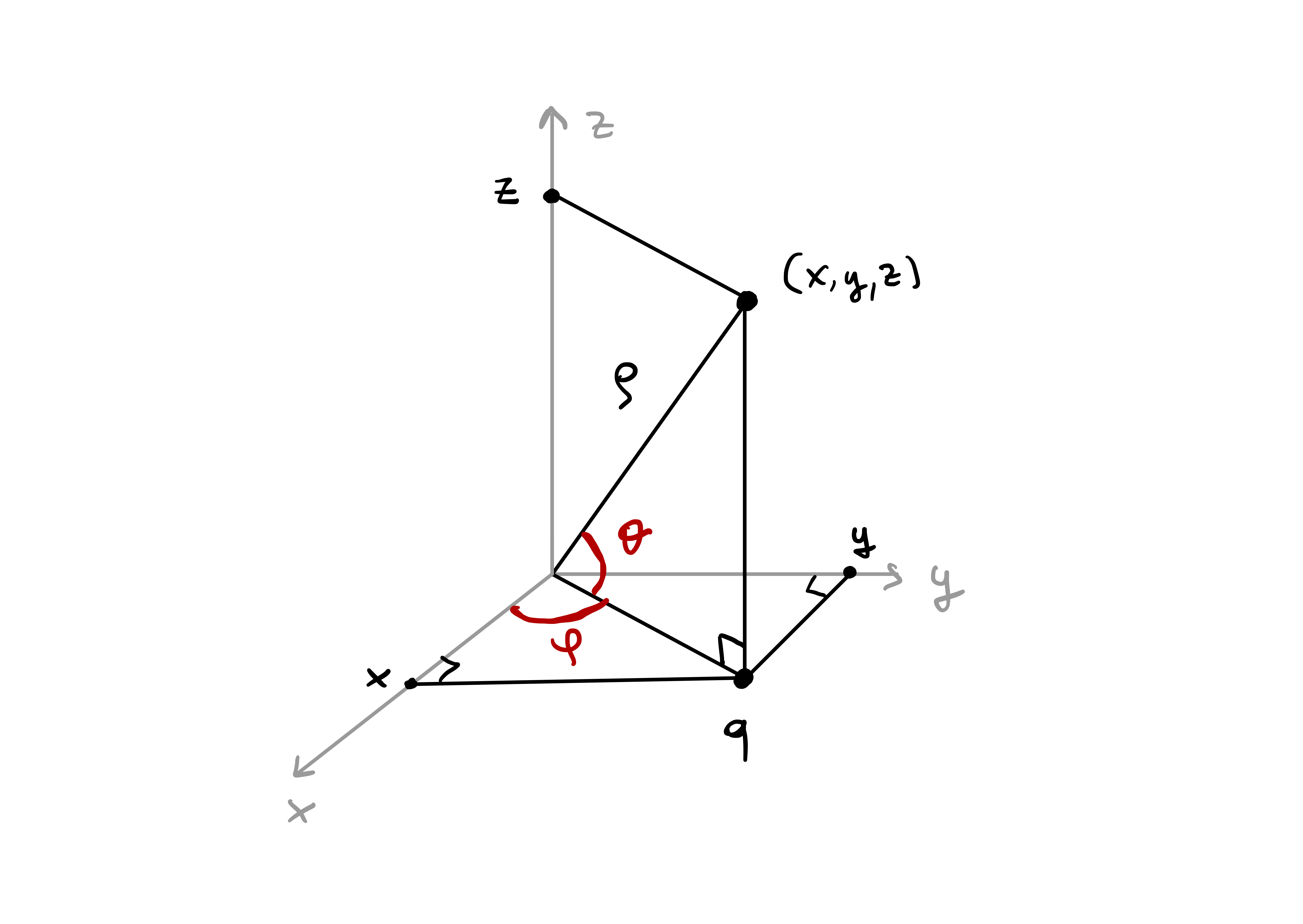
Example 57: Unit sphere in spherical coordinates
The Equator Line corresponds to the angle \(\varphi= 0\), that is, \[ \mbox{Equator Line } = \mathbb{S}^2 \cap \{z = 0 \} \,. \]
The Greenwich meridian corresponds to the angle \(\theta = 0\). Hence: \[ \mbox{Greenwich } = \left\{ (\cos(\varphi) , 0 , \sin (\varphi)) \,, \,\, \varphi\in \left( -\frac{\pi}{2} , \frac{\pi}{2} \right) \right\} \,. \]
The Date Line is the meridian opposite to the Greenwich one. This corresponds to \(\theta = \pi\), and is parametrized by: \[ \mbox{Date Line } = \left\{ (- \cos(\varphi) , 0 , \sin (\varphi)) \,, \,\, \varphi\in \left( -\frac{\pi}{2} , \frac{\pi}{2} \right) \right\} \,. \]
The North Pole and South Pole have coordinates \[ N = (0,0,1) \,, \quad S = (0,0,-1) \,. \]
The Northern Hemisphere is the top-half of \(\mathbb{S}^2\), that is, \[ \mbox{Northern Hemisphere } = \mathbb{S}^2 \cap \{ z \geq 0 \} \,. \]
The Southern Hemisphere is the bottom-half of \(\mathbb{S}^2\), that is, \[ \mbox{Southern Hemisphere } = \mathbb{S}^2 \cap \{ z \leq 0 \} \,. \]
Notice that the angles \[ \theta = \pi \,, \quad \varphi= \pm \frac{\pi}{2} \] are excluded in the definition of \(U\). Therefore the parametrization \({\pmb{\sigma}}\) misses the Date Line, as well as the North and South Poles, see the left picture in Figure 4.7. In formulas: \[\begin{align*} {\pmb{\sigma}}(U) & = \mathbb{S}^2 \smallsetminus \{\mbox{Date Line, North Pole, South Pole}\} \\ & = \mathbb{S}^2 \smallsetminus \{ (x,0,z) \in \mathbb{R}^3 \, \colon \, x \leq 0 \} \,. \end{align*}\] Since \({\pmb{\sigma}}(U) \neq \mathbb{S}^2\), the chart \({\pmb{\sigma}}\) does not form an atlas. We need a second chart. An option is to define \(\widetilde{{\pmb{\sigma}}} \colon U \to \mathbb{R}^3\) by \[ \widetilde{{\pmb{\sigma}}} := ( - \cos (\theta)\cos(\varphi) , -\sin(\varphi) , - \sin(\theta) \cos (\varphi) ) \,. \] Notice that \(\widetilde{{\pmb{\sigma}}}\) is obtained by rotating \({\pmb{\sigma}}\) by \(\pi\) about the \(z\)-axis, and by \(\pi/2\) about the \(y\)-axis, see the right picture in Figure 4.7. Thus, \[ \widetilde{{\pmb{\sigma}}} (U) = \mathbb{S}^2 \smallsetminus \{ (x,y,0) \in \mathbb{R}^3 \, \colon \,x \geq 0 \} \,. \] In particular, we have shown that \[ \mathbb{S}^2 = {\pmb{\sigma}}(U) \cup \widetilde{{\pmb{\sigma}}}(U) \,. \]
Question. Show that \[ \mathcal{A} := \{ {\pmb{\sigma}}, \widetilde{{\pmb{\sigma}}} \} \] is a regular atlas for \(\mathbb{S}^2\).
Solution. Check that \({\pmb{\sigma}}\) and \(\widetilde{{\pmb{\sigma}}}\) are charts:
- \({\pmb{\sigma}}\) is smooth.
- \(U\) is open in \(\mathbb{R}^2\).
- Moreover \[ {\pmb{\sigma}}(U) = \mathbb{S}^2 \smallsetminus \{ (x,0,z) \in \mathbb{R}^3 \, \colon \,x \leq 0 \} \,. \] This is clearly an open set in \(\mathbb{S}^2\).
- The spherical coordinates on the sphere are invertible. Therefore \({\pmb{\sigma}}\) is invertible, with continuous inverse.
- Thus, \({\pmb{\sigma}}\) is a homeomorphism from \(U\) into \({\pmb{\sigma}}(U)\).
- This shows \({\pmb{\sigma}}\) is a chart of \(\mathbb{S}^2\).
- Since \(\widetilde{{\pmb{\sigma}}}\) is obtained from \({\pmb{\sigma}}\) by composing two rotations, we conclude that also \(\widetilde{{\pmb{\sigma}}}\) is a chart.
Show that \({\pmb{\sigma}}\) is a regular chart: \[\begin{align*} {\pmb{\sigma}}_{\theta} & = (-\sin(\theta) \cos(\varphi), \cos(\theta) \cos(\varphi), 0 ) \\ {\pmb{\sigma}}_{\varphi} & = ( - \cos(\theta) \sin(\varphi), -\sin(\theta) \sin(\varphi), \cos(\varphi) ) \,. \end{align*}\] Since \((\theta,\varphi)\in U\), we have \(\varphi\in ( -\pi/2, \pi/2 )\). Therefore, the last component of \({\pmb{\sigma}}_\varphi\) is non-zero, i.e., \[ \cos(\varphi) \neq 0 \,, \quad \forall \, \varphi\in \left( -\frac{\pi}{2},\frac{\pi}{2} \right) \,. \] Since the last component of \({\pmb{\sigma}}_\theta\) is \(0\), we conclude that \({\pmb{\sigma}}_\theta\) and \({\pmb{\sigma}}_{\varphi}\) are linearly independent for all \((\theta,\varphi) \in U\). Therefore \({\pmb{\sigma}}\) is regular. Alternatively, we could have computed: \[ {\pmb{\sigma}}_{\theta} \times {\pmb{\sigma}}_{\varphi} = ( \cos(\theta) \cos^2(\varphi), \sin(\theta) \cos^2(\varphi), \cos(\varphi)\sin(\varphi) ) \,, \] from which \[ \left\| {\pmb{\sigma}}_{\theta} \times {\pmb{\sigma}}_{\varphi} \right\| = |\cos (\varphi)| \, . \] Since \((\theta,\varphi)\in U\), we have \(\varphi\in ( -\pi/2, \pi/2 )\), and so \[ \left\| {\pmb{\sigma}}_{\theta} \times {\pmb{\sigma}}_{\varphi} \right\| = \cos (\varphi) \neq 0 \,. \] Thus \({\pmb{\sigma}}_{\theta}\) and \({\pmb{\sigma}}_{\varphi}\) are linearly independent, and \({\pmb{\sigma}}\) is regular.
Since \(\widetilde{{\pmb{\sigma}}}\) is obtained from \({\pmb{\sigma}}\) by applying two rotations, it follows that \(\widetilde{{\pmb{\sigma}}}\) is regular. Therefore \[ \mathcal{A} = \{ {\pmb{\sigma}}, \widetilde{{\pmb{\sigma}}}\} \] is a regular atlas for \(\mathbb{S}^2\).


In alternative, the sphere can be parametrized in Cartesian coordinates.
Example 58: Unit sphere in Cartesian coordinates
Question. Define the following collection of charts on the sphere \(\mathbb{S}^2\) \[ \mathcal{A} = \{ {\pmb{\sigma}}_i \}_{i=1}^6 \,, \] where \({\pmb{\sigma}}_i\) is defined as follows: Let \[ U:= \{ (u,v) \in \mathbb{R}^2 \colon u^2 + v^2 < 1 \} \] be the unit open ball in \(\mathbb{R}^2\), and define \({\pmb{\sigma}}_i \colon U \to \mathbb{R}^3\) by \[\begin{align*} {\pmb{\sigma}}_1 (u,v) & = \left(u,v,\sqrt{1-u^2-v^2} \right) \\ {\pmb{\sigma}}_2 (u,v) & = \left(u,v,-\sqrt{1-u^2-v^2} \right) \\ {\pmb{\sigma}}_3 (u,v) & = \left(u,\sqrt{1-u^2-v^2},v \right) \\ {\pmb{\sigma}}_4 (u,v) & = \left(u, -\sqrt{1-u^2-v^2}, v \right) \\ {\pmb{\sigma}}_5 (u,v) & = \left(\sqrt{1-u^2-v^2} , u ,v \right) \\ {\pmb{\sigma}}_6 (u,v) & = \left(-\sqrt{1-u^2-v^2}, u,v, \right) \\ \end{align*}\] Prove that \(\mathcal{A}\) is a regular atlas.
Solution. Let us check that \(\mathbb{S}^2\) is a surface:
- \({\pmb{\sigma}}_1\) is smooth, since in \(U\) we have \(u^2+v^2<1\).
- \(U\) is open, being the open ball of radius \(1\) in \(\mathbb{R}^2\).
- \({\pmb{\sigma}}_1(U)\) is clearly open in \(\mathbb{S}^2\): This is because \({\pmb{\sigma}}_1(U)\) coincides with the Northern Hemisphere, with the Equator Line removed.
- The inverse of \({\pmb{\sigma}}_1\) is given by \({\pmb{\sigma}}^{-1} \colon {\pmb{\sigma}}_1(U) \to U\) defined by \[ {\pmb{\sigma}}^{-1}(u,v,\sqrt{1-u^2-v^2}) := (u,v) \,. \]
- \({\pmb{\sigma}}^{-1}\) is continuous, and thus \({\pmb{\sigma}}_1\) is a homeomorphism of \(U\) with \({\pmb{\sigma}}_1(U)\).
- With similar arguments, we can see that all the maps \({\pmb{\sigma}}_i\) are charts.
- Note that \({\pmb{\sigma}}_1\) charts the Northern Hemisphere (excluding the Equator), while \({\pmb{\sigma}}_2\) charts the Southern Hemisphere (excluding the Equator). Thus, \[ {\pmb{\sigma}}_1(U) \cup {\pmb{\sigma}}_2(U) = \mathbb{S}^2 \smallsetminus \{z = 0 \} \,. \] By including the other 4 charts \({\pmb{\sigma}}_3,{\pmb{\sigma}}_4,{\pmb{\sigma}}_5,{\pmb{\sigma}}_6\), we can cover the whole sphere, that is, \[ \mathbb{S}^2 = \bigcup_{i=1}^6 {\pmb{\sigma}}_i(U) \,. \] This shows that \(\mathcal{A} = \{ {\pmb{\sigma}}_i\}_{i=1}^6\) is an atlas for \(\mathbb{S}^2\).
Let us now check that \(\mathbb{S}^2\) is a regular surface:
- The first chart \({\pmb{\sigma}}_1\) has derivatives \[ ({\pmb{\sigma}}_1)_u = (1,0,f_u) \,, \quad ({\pmb{\sigma}}_1)_v = (0,1,f_v) \,, \] where \(f_u,f_v\) are the partial derivatives of \[ f(u,v):=\sqrt{1-u^2-v^2} \,. \] Therefore, the Jacobian matrix of \({\pmb{\sigma}}_1\) is \[ J{\pmb{\sigma}}_1 (u,v) = \left( \begin{array}{ccc} 1 & 0 \\ 0 & 1 \\ f_u & f_v \\ \end{array} \right) \,. \] The first minor of \(J{\pmb{\sigma}}_1\) is the identity matrix, and therefore \(J{\pmb{\sigma}}\) has rank 2, showing that \(({\pmb{\sigma}}_1)_u\) and \(({\pmb{\sigma}}_2)_v\) are linearly independent. Hence \({\pmb{\sigma}}_1\) is regular.
- Clearly, \(J{\pmb{\sigma}}_i\) has rank 2 for each of the charts \({\pmb{\sigma}}_i\). Therefore \({\pmb{\sigma}}_i\) is regular.
- We conclude that \(\mathcal{A}\) is a regular atlas, making \(\mathbb{S}^2\) a regular surface.
Let us conclude the section with the example of a non-regular surface.
Example 59: A non-regular chart
Solution. We have \[ {\pmb{\sigma}}_v = (0,2v,3v^2) \,, \qquad {\pmb{\sigma}}_v(u,0) = (0,0,0) \,. \] \({\pmb{\sigma}}\) is not regular because \({\pmb{\sigma}}_u\) and \({\pmb{\sigma}}_v\) are linearly dependent along the line \(L = \{ (u,0) \, \colon \,u \in \mathbb{R}\}\).
Looking at Figure Figure 4.8, it is clear that \(\mathcal{S}\) is not regular, since \(\mathcal{S}\) has a cusp along the line \({\pmb{\sigma}}(L)\).
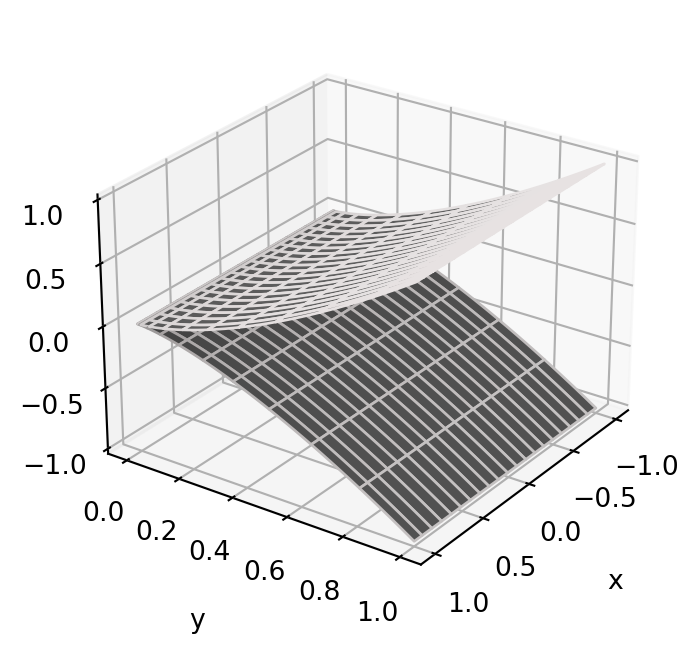
4.4 Reparametrizations
We have already considered reparametrizations when we studied curves. In a similar way, one can reparametrize surface charts.
Definition 60: Reparametrization
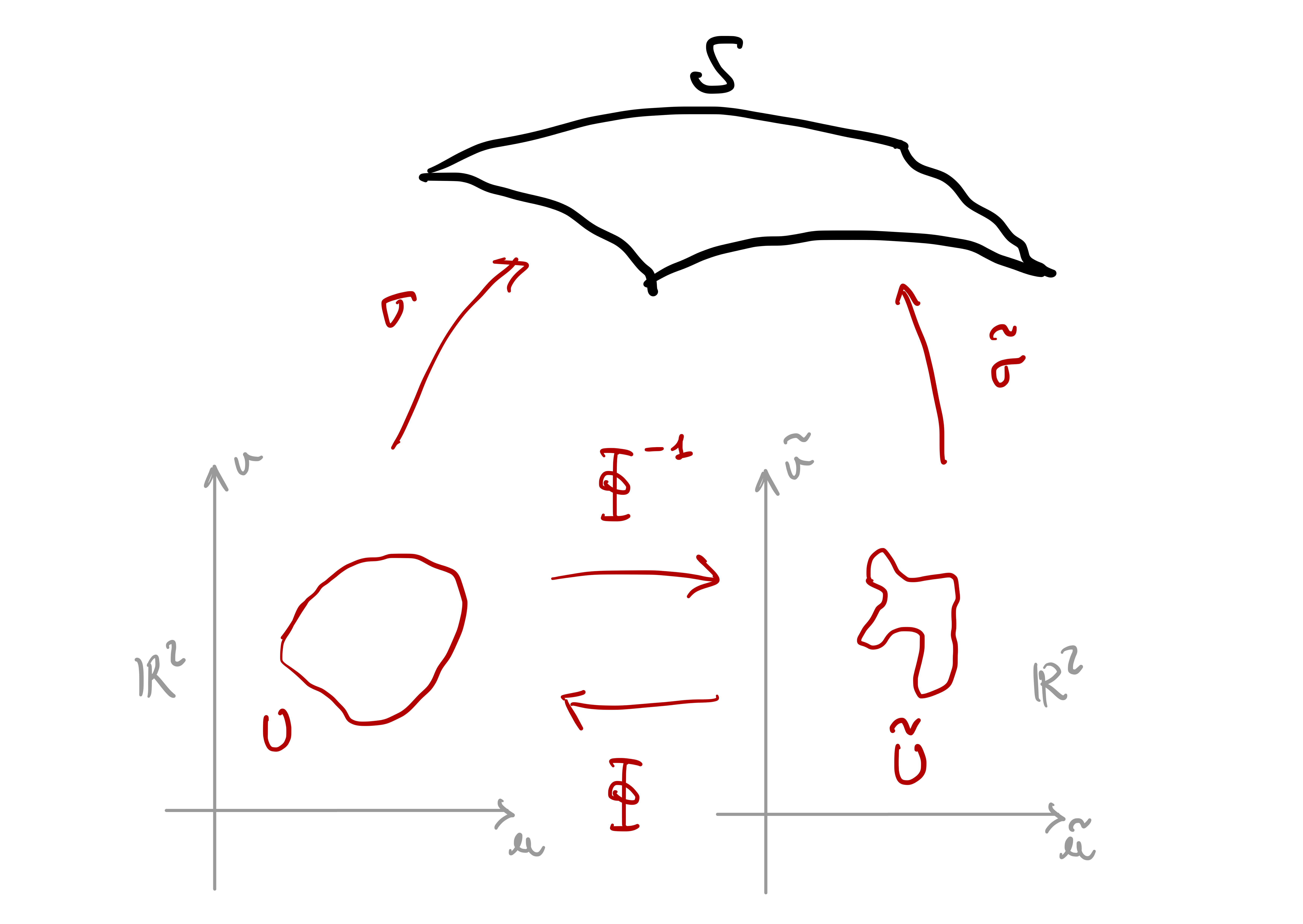
We will show that reparametrizations of regular charts are regular. To prove this, first we need to recall the chain rule for vector valued functions of several variables.
Remark 61: Chain rule
The chain rule states that \[ J \tilde{f} (\tilde u, \tilde v) = Jf ( \Phi (\tilde u, \tilde v) ) \, J\Phi (\tilde u, \tilde v) \,. \] By carrying out the matrix multiplication on the right hand sinde of the above identity, we obtain the chain rule in vectorial form: \[\begin{align*} \tilde{f}_{\tilde{u}} (\tilde{u}, \tilde{v}) & = f_u ( \Phi(\tilde{u}, \tilde{v}) ) \Phi_{\tilde{u}}^1 (\tilde{u}, \tilde{v}) + f_v ( \Phi(\tilde{u}, \tilde{v}) ) \Phi_{\tilde{u}}^2 (\tilde{u}, \tilde{v}) \\ \tilde{f}_{\tilde{v}} (\tilde{u}, \tilde{v}) & = f_u ( \Phi(\tilde{u}, \tilde{v}) ) \Phi_{\tilde{v}}^1 (\tilde{u}, \tilde{v}) + f_v ( \Phi(\tilde{u}, \tilde{v}) ) \Phi_{\tilde{v}}^2 (\tilde{u}, \tilde{v}) \end{align*}\] The above expressions are quite cumbersome. This motivates the introduction of more compact notations for reparametrizations and chain rule. Specifically, we denote the components of the diffeomorphism \(\Phi\) by \[\begin{align*} \Phi^1 \quad & \leadsto \quad (\tilde u, \tilde v) \mapsto u (\tilde u, \tilde v) \\ \Phi^2 \quad & \leadsto \quad (\tilde u, \tilde v) \mapsto v (\tilde u, \tilde v) \end{align*}\] Accordingly, the Jacobian of \(\Phi\) is denoted by: \[ J \Phi = \left( \begin{array}{cc} {\Phi}^1_{\tilde u} & {\Phi}^1_{\tilde v} \\ {\Phi}^2_{\tilde u} & {\Phi}^2_{\tilde v} \end{array} \right) \quad \leadsto \quad \left( \begin{array}{cc} \dfrac{\partial u}{\partial \tilde u} & \dfrac{\partial u}{\partial \tilde v} \\ \dfrac{\partial v}{\partial \tilde u} & \dfrac{\partial v}{\partial \tilde v} \end{array} \right) \,. \] Hence, the chain rule in vectorial form reads \[\begin{align*} \tilde{f}_{\tilde{u}} & = f_u \frac{\partial u}{\partial \tilde{u}} + f_v \frac{\partial v}{\partial \tilde{u}} \\ \tilde{f}_{\tilde{v}} & = f_u \, \frac{\partial u}{\partial \tilde{v}} + f_v \frac{\partial v}{\partial \tilde{v}} \end{align*}\]
We will now prove that the reparametrization of a regular chart is regular.
Theorem 62: Reparametrizations of regular charts are regular
Proof
4.5 Transition maps
Suppose that a surface \(\mathcal{S}\) has atlas given by \(\mathcal{A} = \{ {\pmb{\sigma}}_i \}_{i \in I}\). By definition of atlas, it holds that \[ \mathcal{S}= \bigcup_{i \in I} {\pmb{\sigma}}_i (U_i) \,. \] As the images \({\pmb{\sigma}}_i (U_i)\) are open in \(\mathcal{S}\), and cover the whole surface, in general it will happen that two (or more) images will overlap, i.e., \[ I := {\pmb{\sigma}}_i(U_i) \cap {\pmb{\sigma}}_j(U_j) \neq \emptyset \,, \] for some \(i \neq j\). It is natural to ask whether the charts \({\pmb{\sigma}}_i\) and \({\pmb{\sigma}}_j\) are reparametrizations of each other on the overlapping region \(I\), see Figure 4.9. This is indeed the case, see Theorem 65 below. Such reparametrization is called a transition map.
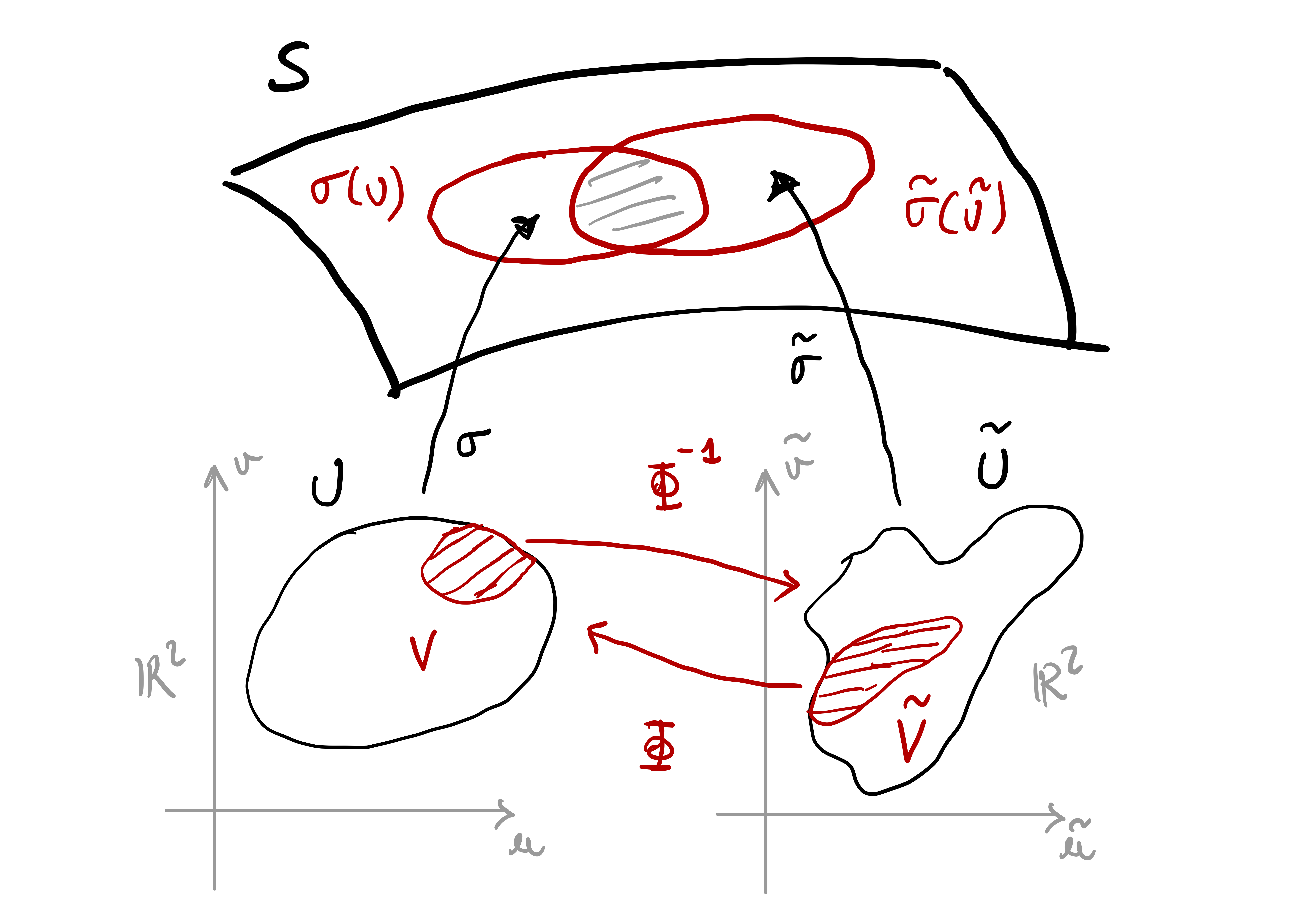
Definition 63: Transition map
The following theorem states that the transition maps between regular charts are diffeomorphisms. The proof is somewhat technical and relies on the Implicit Function Theorem. A similar argument will be used for Lemma 80 in Section 4.7. We have chosen to omit the proof here, but interested readers can refer to page 117 of (Pressley 2010) for details.
Theorem 64
The immediate consequence of Theorem 64 is that transition maps are reparametrizations. To fix notations, let us state this fact precisely.
Theorem 65: Transition maps are reparametrizations
Example 66: Reparametrization of \(\mathbb{S}^2\)
Spherical coordinates: The sphere, excluding the Date Line and the Poles, is charted by \[ {\pmb{\sigma}}(\theta,\varphi) = ( \cos(\theta) \cos(\varphi), \sin(\theta) \cos(\varphi), \sin(\varphi) ) \,, \] defined over the set \[ U = \left\{ (\theta,\varphi) \in \mathbb{R}^2 \, \colon \, \theta \in (-\pi,\pi) \,, \,\, \varphi\in \left( -\frac{\pi}{2},\frac{\pi}{2} \right) \right\} \,. \]
Cartesian coordinates: The Northen Hemisphere is charted by \[ \widetilde{{\pmb{\sigma}}}(u,v) = (u,v, \sqrt{1 - u^2 - v^2 }) \,, \] defined over the set \[ \widetilde{U} = \{ (u,v) \in \mathbb{R}^2 \, \colon \, u^2 + v^2 < 1 \} \,. \]
The intersection of the images \[ I = {\pmb{\sigma}}(U) \cap \widetilde{{\pmb{\sigma}}} (\widetilde{U}) \] is non-empty. Indeed, the two charts overlap across the Northern Hemisphere, excluding the Date Line and North Pole. Define the open sets \[ V := {\pmb{\sigma}}^{-1} (I) \,, \quad \widetilde{V} := \widetilde{{\pmb{\sigma}}}^{-1} (I) \,, \] and the transition map \[ \Phi \colon \widetilde{V} \to V \,, \quad \Phi:= {\pmb{\sigma}}^{-1} \circ \widetilde{{\pmb{\sigma}}} \,. \] Since \({\pmb{\sigma}}\) and \(\widetilde{{\pmb{\sigma}}}\) are regular, Theorem 65 guarantees that \(\Phi\) is a reparametrization map. Therefore \({\pmb{\sigma}}\) and \(\widetilde{{\pmb{\sigma}}}\) are reparametrization of each other, with \[ \widetilde{{\pmb{\sigma}}} = {\pmb{\sigma}}\circ \Phi \,. \] Conclusion: the two parametrizations \({\pmb{\sigma}}\) and \(\widetilde{{\pmb{\sigma}}}\) of \(\mathbb{S}^2\) are interchangeable!
Important
This observation has a significant consequence:
It allows us to define a property of any regular surface by using charts, as long as we ensure that the definition is independent of reparametrization and, therefore, of the specific chart chosen.
4.6 Functions between surfaces
We aim to define the concept of a smooth function \[ f \colon \mathcal{S}_1 \to \mathcal{S}_2 \,, \] where \(\mathcal{S}_1\) and \(\mathcal{S}_2\) are regular surfaces. Up to this point, we only know how to define smooth functions from \(\mathbb{R}^n\) to \(\mathbb{R}^m\). The idea is to use surface charts to extend this definition of smoothness to functions between surfaces, see Figure 4.10.
Definition 67: Smooth functions between surfaces
Let \(\mathcal{S}_1\) and \(\mathcal{S}_2\) be regular surfaces and \(f \colon \mathcal{S}_1 \to \mathcal{S}_2\) a map.
\(f\) is smooth at \(\mathbf{p}\in \mathcal{S}_1\), if there exist charts \[ {\pmb{\sigma}}_i \colon U_i \to \mathcal{S}_i \,\, \text{such that} \,\, \mathbf{p}\in {\pmb{\sigma}}_1(U_1)\,, \, f(\mathbf{p}) \in {\pmb{\sigma}}_2(U_2) \,, \] and that the following map is smooth \[ \Psi \colon U_1 \to U_2 \,, \quad \Psi = {\pmb{\sigma}}_2^{-1} \circ f \circ {\pmb{\sigma}}_1 \,. \]
\(f\) is smooth, if it is smooth for each \(\mathbf{p}\in \mathcal{S}_1\).
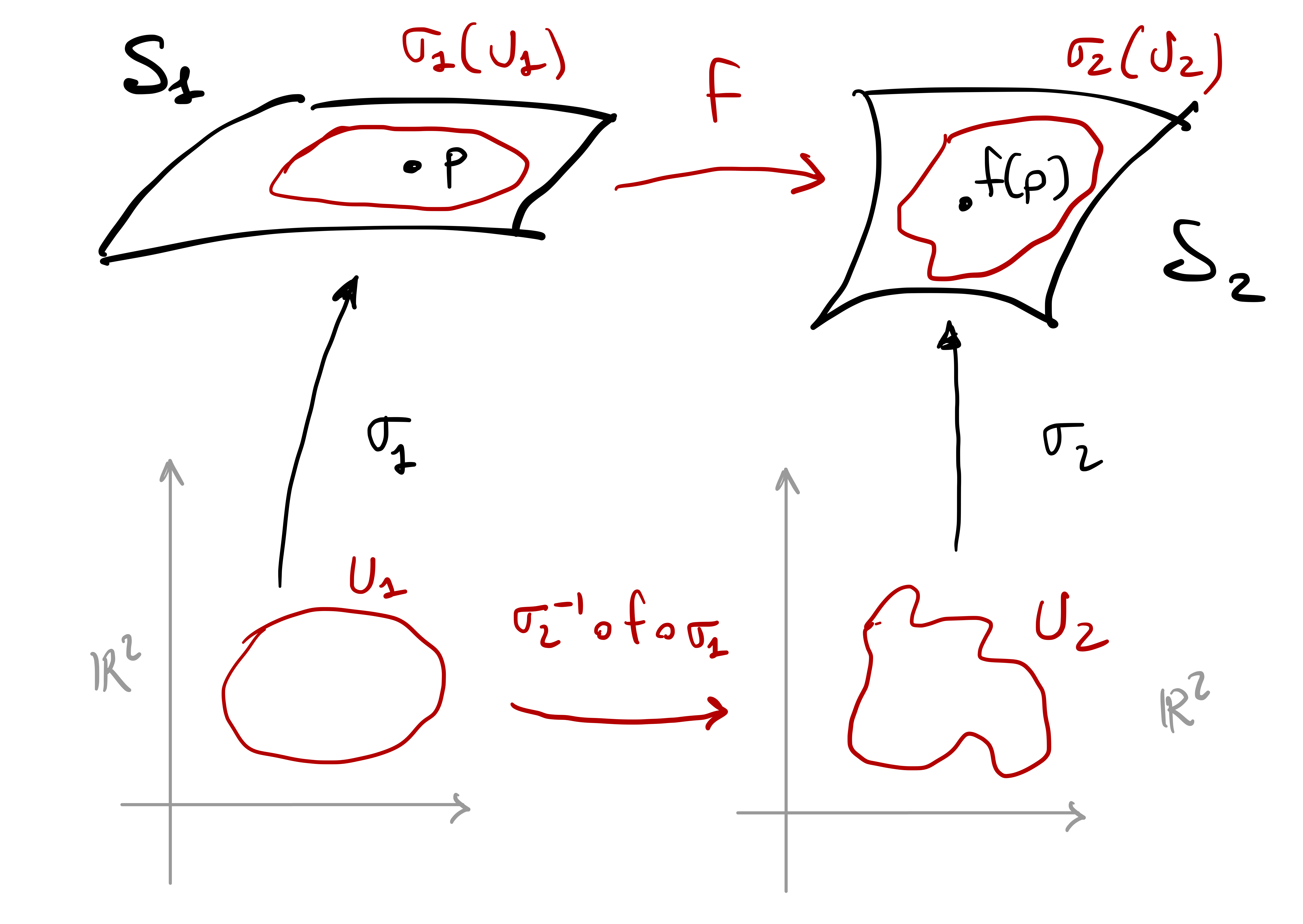
Remark 68
Definition 67 makes sense because \({\pmb{\sigma}}_2^{-1}\) exists.
The map \({\pmb{\sigma}}_2^{-1} \circ f \circ {\pmb{\sigma}}_1\) is only defined for the points \(\mathbf{x}\in U_1\) such that \[ f ( {\pmb{\sigma}}_1 (\mathbf{x}) ) \in {\pmb{\sigma}}_2 (U_2) \,. \]
The function \({\pmb{\sigma}}_2^{-1} \circ f \circ {\pmb{\sigma}}_1\) maps from \(\mathbb{R}^2\) into \(\mathbb{R}^2\), therefore smoothness is intended in the classical sense.
Definition 67 is well-posed: Smoothness of \(f\) does not depend on the specific choice of charts \({\pmb{\sigma}}_1\) and \({\pmb{\sigma}}_2\).
Indeed, suppose that \(\widetilde{{\pmb{\sigma}}}_{i} \colon \widetilde{U}_i \to {\mathcal{S}}_i\) are charts such that \[ \mathbf{p}\in \widetilde{{\pmb{\sigma}}}_1( \widetilde{U}_1) \,, \quad f(\mathbf{p}) \in \widetilde{{\pmb{\sigma}}}_2(\widetilde{U}_2) \,. \] In particular we have \[ {\pmb{\sigma}}_i(U_i) \cap \widetilde{{\pmb{\sigma}}}_i (\widetilde{U}_i) \neq \emptyset \,. \] As \(\mathcal{S}_1\) and \(\mathcal{S}_2\) are regular surfaces, by Theorem 64 there exist open sets \[ V_i \subseteq U_i \,, \qquad \widetilde{V}_i \subseteq \widetilde{U}_i \,, \] and reparametrization maps \[ \Phi_i \colon \widetilde{V}_i \to V_i \,, \qquad \widetilde{{\pmb{\sigma}}}_i = {\pmb{\sigma}}_i \circ \Phi_i \,. \] Hence \[\begin{align*} \widetilde{{\pmb{\sigma}}}_2^{-1} \circ f \circ \widetilde{{\pmb{\sigma}}}_1 & = \widetilde{{\pmb{\sigma}}}_2^{-1} \circ ( {\pmb{\sigma}}_2 \circ {\pmb{\sigma}}_2^{-1} ) \circ f \circ ( {\pmb{\sigma}}_1 \circ {\pmb{\sigma}}_1^{-1} ) \circ \widetilde{{\pmb{\sigma}}}_1 \\ & = ( \widetilde{{\pmb{\sigma}}}_2^{-1} \circ {\pmb{\sigma}}_2 ) \circ ( {\pmb{\sigma}}_2^{-1} \circ f \circ {\pmb{\sigma}}_1 ) \circ ({\pmb{\sigma}}_1^{-1} \circ \widetilde{{\pmb{\sigma}}}_1 ) \\ & = \Phi_2^{-1} \circ ( {\pmb{\sigma}}_2^{-1} \circ f \circ {\pmb{\sigma}}_1 ) \circ \Phi_1 \,. \end{align*}\] Since \(\Phi_1\), \(\Phi_2^{-1}\) and \({\pmb{\sigma}}_2^{-1} \circ f \circ {\pmb{\sigma}}_1\) are smooth, we conclude that \[ \widetilde{{\pmb{\sigma}}}_2^{-1} \circ f \circ \widetilde{{\pmb{\sigma}}}_1 \] is smooth. Hence Definition 67 does not depend on the choice of charts.
Proposition 69
Proof
The inverse function of a chart is a differentiable.
Proposition 70: Inverse of a regular chart is smooth
Proof
\({\pmb{\sigma}}^{-1}\) exists, as \({\pmb{\sigma}}\) is required to be a homeomorphism;
\({\pmb{\sigma}}(U)\) can be regarded as a surface, being an open subset of the surface \(\mathcal{S}\).
Let \(\mathbf{p}\in {\pmb{\sigma}}(U)\) and \(\widetilde{{\pmb{\sigma}}}\colon \widetilde{U}\to \mathcal{S}\) be a regular chart at \(\mathbf{p}\), that is, \[ p \in \widetilde{{\pmb{\sigma}}}(\widetilde{U}) \,. \] In order to prove that \({\pmb{\sigma}}^{-1} \colon {\pmb{\sigma}}(U) \to \mathbb{R}^2\) is a differentiable map, we need to check that the map \[ {\pmb{\sigma}}^{-1} \circ \widetilde{{\pmb{\sigma}}} \] is differentiable (where it is defined). To this end, define the intersection \[ I := {\pmb{\sigma}}(U) \cap \widetilde{{\pmb{\sigma}}}(\widetilde{U})\,. \] Clearly \(I \neq \emptyset\), since \(\mathbf{p}\in I\). We can then define the open sets \[ V = {\pmb{\sigma}}^{-1}(I)\,, \quad \widetilde{V} = \widetilde{{\pmb{\sigma}}}^{-1}(I) \,, \] and the transition map \[ \Phi \colon \widetilde{V} \to V \,, \quad \Phi := {\pmb{\sigma}}^{-1} \circ \widetilde{{\pmb{\sigma}}}\,. \] By Theorem 64, the map \(\Phi\) is differentiable. As \(\Phi = {\pmb{\sigma}}^{-1} \circ \widetilde{{\pmb{\sigma}}}\), the proof is concluded.
The following Theorem gives a very useful sufficient condition to check differentiability.
Theorem 71
- \(V \subseteq \mathbb{R}^3\) is open, with \(\mathcal{S}_1 \subseteq V\),
- \(f \colon V \to \mathbb{R}^3\) is differentiable, with \(f(\mathcal{S}_1) \subseteq \mathcal{S}_2\).
The restriction \(f |_{\mathcal{S}_1} \colon \mathcal{S}_1 \to \mathcal{S}_2\) is a smooth map.
Proof
Example 72
Let \(\mathcal{S}\) be a regular surface.
Assume \(\mathcal{S}\) is symmetric relative to the \(\{z=0\}\) plane, that is, \[ (x, y, z) \in \mathcal{S}\quad \iff \quad (x, y,-z) \in \mathcal{S}\,. \] Then the map \(f \colon \mathcal{S}\to \mathcal{S}\), which takes \(p \in S\) into its symmetrical point, is differentiable. This is because \(f\) is the restriction to \(\mathcal{S}\) of the map \[ f\colon \mathbb{R}^3 \to \mathbb{R}^3, \qquad f(x, y, z)=(x, y,-z) \,, \] which is clearly differentiable.
Let \(\pi \colon \mathcal{S}\to \mathbb{R}^2\) be the map which takes each \(\mathbf{p}\in \mathcal{S}\) into its orthogonal projection over \[ \mathbb{R}^2 = \{ (x,y,0) \,\colon \, x,y \in \mathbb{R}\} \,. \] \(\pi\) is differentiable because restriction of the differentiable map \[ \pi \colon \mathbb{R}^3 \to \mathbb{R}^3 \,, \quad \pi (x,y,z) = (x,y,0) \,. \]
Let \(f \colon \mathbb{R}^3 \to \mathbb{R}^3\) be given by \[ f(x, y, z)=(x a, y b, z c) \,, \] where \(a, b\), and \(c\) are non-zero real numbers. Clearly, \(f\) is differentiable. Therefore, the restriction \(f|_{\mathbb{S}^2}\) is a differentiable map from the Sphere \[ \mathbb{S}^2 = \left\{(x, y, z) \in \mathbb{R}^3 \, \colon \, x^2+y^2+z^2=1\right\} \] into the Ellipsoid \[ \mathbb{E} = \left\{(x, y, z) \in \mathbb{R}^3 \, \colon \, \frac{x^2}{a^2}+\frac{y^2}{b^2}+\frac{z^2}{c^2}=1\right\} \,, \] because \(f(\mathbb{S}^2) \subseteq \mathbb{E}\).
Definition 73: Diffeomorphism of surfaces
Let \(\mathcal{S}_1\) and \(\mathcal{S}_2\) be regular surfaces.
\(f \colon \mathcal{S}_1 \to \mathcal{S}_2\) is a diffeomorphism, if \(f\) is smooth and admits smooth inverse.
\(\mathcal{S}_1\), \(\mathcal{S}_2\) are diffeomorphic if there exists \(f \colon \mathcal{S}_1 \to \mathcal{S}_2\) diffeomorphism.
The key ideas around diffeomorphisms are:
Two diffeomorphic surfaces are essentially the same.
It is easy to check that being diffeomorphic is an equivalence relation on the set of regular surfaces. Therefore, two diffeomorphic surfaces can be identified.
Two diffeomorphic surfaces have essentially the same charts, as shown in the next Proposition.
Proposition 74: Image of charts under diffeomorphisms
Proof
We conclude with the definition of local diffeomorphism between surfaces.
Definition 75: Local diffeomorphism
Let \(\mathcal{S}_1\) and \(\mathcal{S}_2\) be regular surfaces, and \(f \colon \mathcal{S}_1 \to \mathcal{S}_2\) smooth.
\(f\) is a local diffeomorphism at \(\mathbf{p}\in \mathcal{S}_1\) if:
- There exists An open set \(V \subseteq \mathcal{S}_1\) with \(\mathbf{p}\in V\);
- \(f(V) \subseteq \mathcal{S}_2\) is open;
- \(f \colon V \to f(V)\) is smooth between surfaces.
\(f\) is a local diffeomorphism in \(\mathcal{S}_1\), if it is a local diffeomorphism at each \(\mathbf{p}\in \mathcal{S}_1\).
\(\mathcal{S}_1\) is locally diffeomorphic to \(\mathcal{S}_2\), if for all \(\mathbf{p}\in \mathcal{S}_1\) there exists \(f\) local diffeomorphism at \(\mathbf{p}\).
Two remarks:
- The above definition is well-posed, since open subsets of surfaces are themselves surfaces.
- Being locally diffeomorphic is not an equivalence relation: \(\mathcal{S}_1\) locally diffeomorphic to \(\mathcal{S}_2\) does not imply that \(\mathcal{S}_2\) is locally diffeomorphic to \(\mathcal{S}_1\).
4.7 Tangent plane
The tangent vector to a curve \({\pmb{\gamma}}\colon \mathbb{R}\to \mathbb{R}^3\) at the point \({\pmb{\gamma}}(t)\) is just \(\dot{{\pmb{\gamma}}}(t)\), the derivative of the curve at \(t\). Tangent vectors to a surface \(\mathcal{S}\) can be defined as the tangent vectors of curves \({\pmb{\gamma}}\colon \mathbb{R}\to \mathcal{S}\) with values in \(\mathcal{S}\), see Figure 4.11.
To simplify statements, we make the following assumption.
Assumption 76
Definition 77: Tangent vectors and tangent plane
Let \(\mathcal{S}\) be a surface and \(\mathbf{p}\in \mathcal{S}\).
\(\mathbf{v}\in \mathbb{R}^3\) is a tangent vector to \(\mathcal{S}\) at \(\mathbf{p}\), if there exists a smooth curve \({\pmb{\gamma}}\colon (-\varepsilon,\varepsilon) \to \mathbb{R}^3\) such that \[ {\pmb{\gamma}}(-\varepsilon, \varepsilon) \subseteq \mathcal{S}\,, \quad {\pmb{\gamma}}(0) = \mathbf{p}\,, \quad \mathbf{v}= \dot{{\pmb{\gamma}}}(0) \,. \]
The tangent plane of \(\mathcal{S}\) at \(\mathbf{p}\) is the set \[ T_{\mathbf{p}} \mathcal{S}:= \{ \mathbf{v}\in \mathbb{R}^3 \, \colon \,\mathbf{v}\, \mbox{ tangent vector of } \, \mathcal{S}\, \mbox{ at } \, \mathbf{p}\} \,. \]
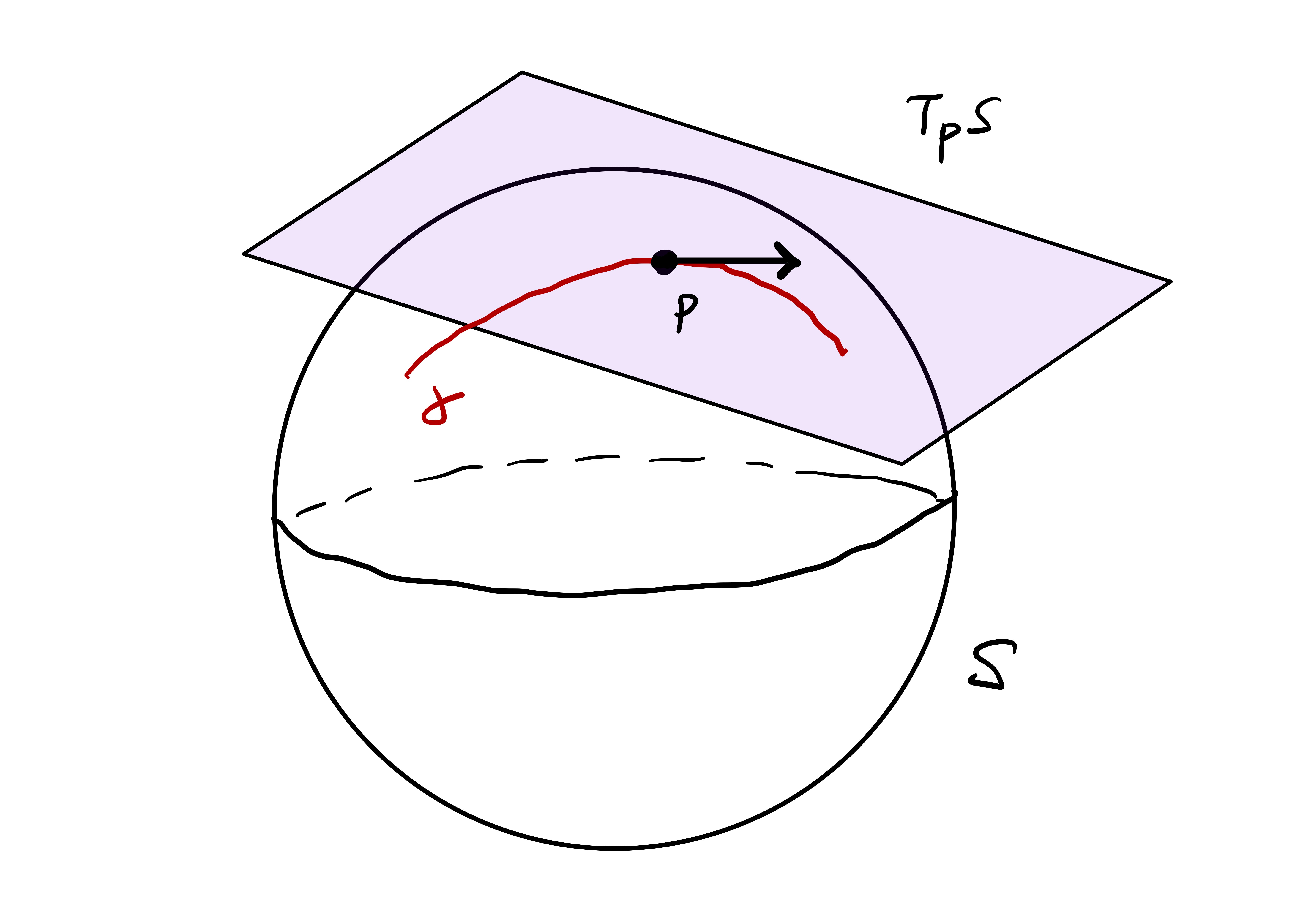
Let us start with the most basic example: We want to compute the tangent plane to an open set in \(\mathbb{R}^2\).
Example 78
Proof. Suppose first that \(\mathbf{v}\in T_{\mathbf{p}} U\). By definition of tangent vector, there exists a smooth curve \[ \gamma \colon (-\varepsilon,\varepsilon) \to U \] such that \[ {\pmb{\gamma}}(0) = \mathbf{p}\, \qquad \dot{{\pmb{\gamma}}}(0)=\mathbf{v}\,. \] Since \(U \subseteq \mathbb{R}^2\), it follows that \({\pmb{\gamma}}\) is a plane curve, so that \[ \mathbf{v}= \dot{{\pmb{\gamma}}}(0) \in \mathbb{R}^2 \,. \] Conversely, let \(\mathbf{v}\in \mathbb{R}^2\). Since \(\mathbf{p}\in U\), and \(U\) is open, there exists \(\varepsilon>0\) such that \(B_{\varepsilon}(\mathbf{p}) \subseteq U\). Define the curve \[ {\pmb{\gamma}}\colon (-\varepsilon,\varepsilon) \to \mathbb{R}^3 \,, \quad {\pmb{\gamma}}(t):= \mathbf{p}+ t \mathbf{v}\,. \] By construction \[ {\pmb{\gamma}}(-\varepsilon,\varepsilon) \subseteq B_{\varepsilon} (\mathbf{p}) \subseteq U \,, \quad {\pmb{\gamma}}(0) = \mathbf{p}\,, \quad \dot{{\pmb{\gamma}}}(0)= \mathbf{v}\,, \] showing that \(\mathbf{v}\in T_{\mathbf{p}} U\).
In the above example, we have seen that \[ T_{\mathbf{p}} U = \mathbb{R}^2 \] for any open set \(U \subseteq \mathbb{R}^2\). In general, if \(\mathcal{S}\) is a regular surface, then \(T_{\mathbf{p}} \mathcal{S}\) is a vector space isomorphic to \(\mathbb{R}^2\), in symbols \[ T_{\mathbf{p}} \mathcal{S}\simeq \mathbb{R}^2 \,. \] This means that there exists a map \[ \Phi \colon T_{\mathbf{p}} \mathcal{S}\to \mathbb{R}^2 \] which is an isomorphism of vector spaces, i.e., \(\Phi\) is invertible and linear: \[ \Phi(\lambda \mathbf{v}+ \mu \mathbf{w}) = \lambda \Phi(\lambda) + \mu \Phi( \mathbf{w}) \,, \] for all \(\mathbf{v}, \mathbf{w}\in T_{\mathbf{p}}\mathcal{S}\) and \(\lambda, \mu \in \mathbb{R}\).
To prove this result, we need a Lemma concerning curves with values on surfaces: The lemma says that when \(\mathcal{S}\) is regular, all the smooth curves \({\pmb{\gamma}}\colon (-\varepsilon,\varepsilon) \to \mathbb{R}^3\) with values in \(\mathcal{S}\), are of the form \[ {\pmb{\gamma}}(t) = {\pmb{\sigma}}(u(t),v(t)) \,, \quad \forall \, t \in (-\varepsilon,\varepsilon)\,, \] for a pair of smooth functions \(u,v \colon (-\varepsilon,\varepsilon) \to \mathbb{R}\).
Lemma 79: Curves with values on surfaces
Proof
To visualize the geometric ideas of this part of the proof, see Figure 4.12. Let \(\mathbf{p}\) in \(\mathcal{S}={\pmb{\sigma}}(U)\), and assume given a smooth curve \({\pmb{\gamma}}\colon (-\varepsilon,\varepsilon) \to \mathbb{R}^3\) such that \({\pmb{\gamma}}(0) = \mathbf{p}\) and \[
{\pmb{\gamma}}(t) \in \mathcal{S}\,, \quad \forall \, t \in (-\varepsilon,\varepsilon) \,.
\] Denote the coordinates of the chart \({\pmb{\sigma}}\colon U \to \mathbb{R}^3\) by \[
{\pmb{\sigma}}(u,v) = (f(u,v), g(u,v), h(u, v)) \,.
\] The Jacobian of \({\pmb{\sigma}}\) is \[
J{\pmb{\sigma}}=
\left(
\begin{array}{cc}
f_u & f_v \\
g_u & g_v \\
h_u & h_v \\
\end{array}
\right) \,.
\] Since \({\pmb{\sigma}}\) is regular, by definition \(J{\pmb{\sigma}}\) has rank-2 at \((u_0,v_0)\). This means that at least one of the 3 minors \[
\left(
\begin{array}{cc}
f_u & f_v \\
g_u & g_v
\end{array}
\right) \,, \quad
\left(
\begin{array}{cc}
f_u & f_v \\
h_u & h_v \\
\end{array}
\right) \,, \quad
\left(
\begin{array}{cc}
g_u & g_v \\
h_u & h_v \\
\end{array}
\right) \,.
\] is invertible. WLOG, assume the first is invertible (the proof in case the other two are invertible is similar). Define the map
\[
F \colon U \subseteq \mathbb{R}^2 \to \mathbb{R}^2 \,, \qquad F(u,v) := ( f(u,v), g(u,v) ) \,.
\] The Jacobian of \(F\) is \[
JF =
\left(
\begin{array}{cc}
f_u & f_v \\
g_u & g_v
\end{array}
\right) \,,
\] which is invertible at \((u_0,v_0)\) by assumption. Hence, by the Inverse Function Theorem 39, there exist
- \(U_0 \subseteq U\) open set, with \((u_0,v_0) \in U_0\),
- \(V \subseteq \mathbb{R}^2\) open set, with \(F(u_0,v_0) \in V\),
such that \[ F \colon U_0 \to V \] is a diffeomorphism. In particular, the inverse function \[ F^{-1} \colon V \to U_0 \] is smooth. Define the projection map \[ \pi \colon \mathbb{R}^3 \to \mathbb{R}^2 \,, \quad \pi(x,y,z) = (x,y) \,, \] and notice that, by construction, \[ F = \pi \circ {\pmb{\sigma}}\,. \] The composition \[ \pi \circ {\pmb{\gamma}}\colon (\varepsilon,\varepsilon) \to \mathbb{R}^2 \] is smooth, and such that \[\begin{align*} (\pi \circ {\pmb{\gamma}}) (0) & = \pi ({\pmb{\gamma}}(0)) \\ & = \pi (\mathbf{p}) \\ & = \pi ( {\pmb{\sigma}}(u_0,v_0) ) \\ & = F(u_0,v_0) \,. \end{align*}\] Since \(F(u_0,v_0) \in V\), with \(V\) open in \(\mathbb{R}^2\), and since \(\pi \circ {\pmb{\gamma}}\) is continuous, there exists \(\varepsilon_0 \in (0,\varepsilon]\) such that \[ (\pi \circ {\pmb{\gamma}})(t) \in V \,, \quad \forall \, t \in (-\varepsilon_0,\varepsilon_0) \,. \] Since \(F^{-1}\) maps \(V\) into \(U_0\), it is well-defined the composition \[ {\pmb{\eta}}\colon (-\varepsilon_0, \varepsilon_0) \to U_0 \,, \qquad {\pmb{\eta}}:= F^{-1} \circ \pi \circ {\pmb{\gamma}}\,. \] Notice that \({\pmb{\eta}}\) is smooth, since \(F^{-1}, \pi\) and \({\pmb{\gamma}}\) are smooth. In particular, the componenents of \({\pmb{\eta}}\) are two smooth functions \[ u,v \colon (-\varepsilon_0,\varepsilon_0) \to \mathbb{R}\,, \] such that \[ (u(t),v(t)) = (F^{-1} \circ \pi \circ {\pmb{\gamma}})(t) \,, \quad \forall \, t \in (-\varepsilon_0,\varepsilon_0) \,. \tag{4.3}\] We are now ready to conclude:
Recalling that \(F = \pi \circ {\pmb{\sigma}}\), and that \({\pmb{\sigma}}\) is invertible, we infer that \[ F = \pi \circ {\pmb{\sigma}}\,\, \implies \,\, F \circ {\pmb{\sigma}}^{-1} = \pi \,\, \implies \,\, {\pmb{\sigma}}^{-1} = F^{-1} \circ \pi \,. \] Hence, we can substitute \(F^{-1} \circ \pi = {\pmb{\sigma}}^{-1}\) in (4.3), and obtain \[ (u(t),v(t)) = (F^{-1} \circ \pi \circ {\pmb{\gamma}})(t) = ({\pmb{\sigma}}^{-1} \circ {\pmb{\gamma}})(t) \,. \] Applying \({\pmb{\sigma}}\) to both sides gives the desired equation \[ {\pmb{\gamma}}(t) = {\pmb{\sigma}}(u(t),v(t)) \,, \quad \forall \, t \in (-\varepsilon_0,\varepsilon_0) \,. \]
We have computed that \[ (\pi \circ {\pmb{\gamma}})(0) = F(u_0,v_0) \,. \] In particular, substituting \(t = 0\) in (4.3) gives, \[\begin{align*} (u(0),v(0)) & = (F^{-1} \circ \pi \circ {\pmb{\gamma}})(0) \\ & = F^{-1} ((\pi \circ {\pmb{\gamma}})(0) ) \\ & = F^{-1}(F(u_0,v_0)) \\ & = (u_0,v_0) \,, \end{align*}\] showing that \[ u(0) = u_0 \,, \qquad v(0) = v_0 \,. \]
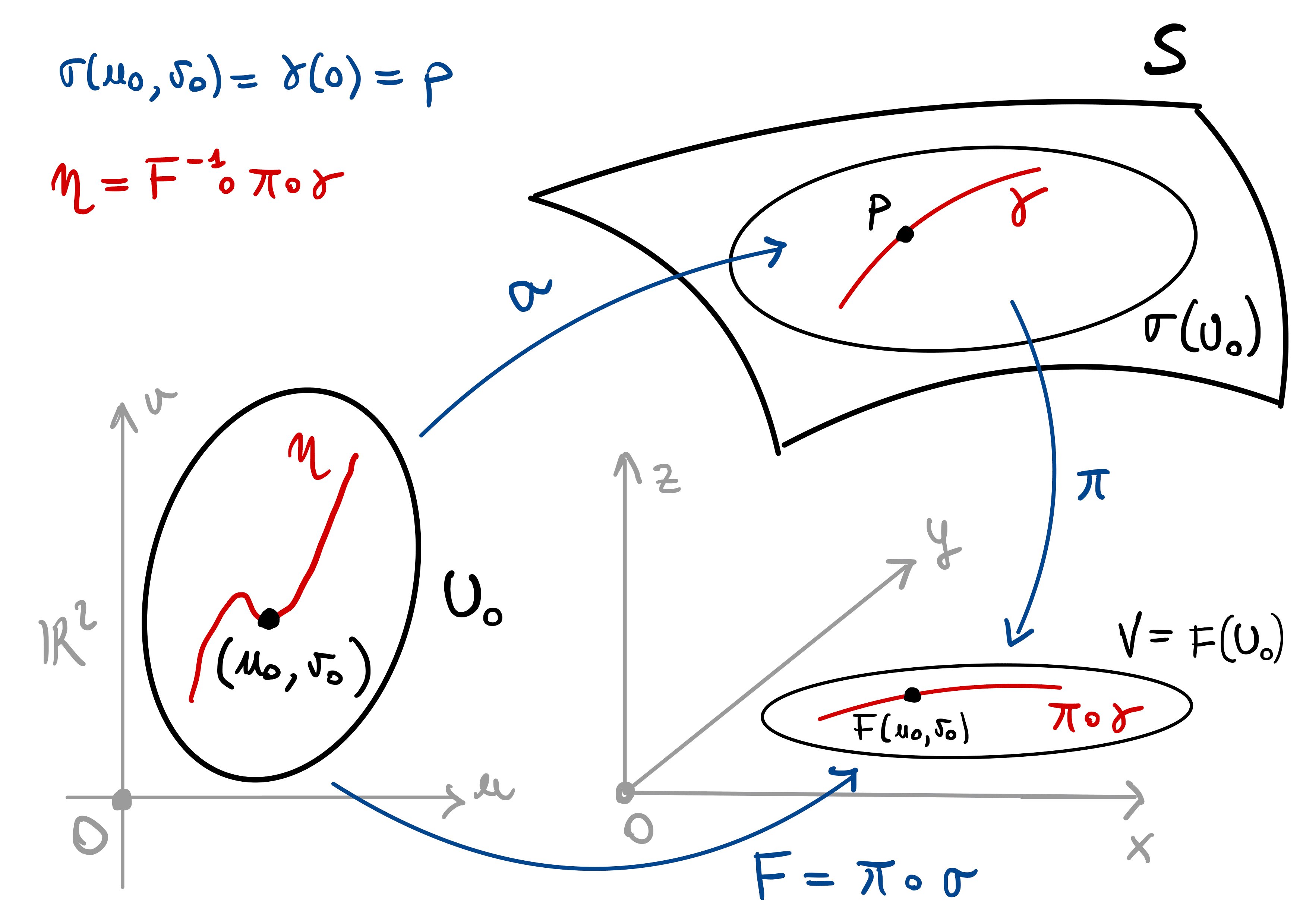
We are now ready to characterize \(T_{\mathbf{p}} \mathcal{S}\) when \(\mathcal{S}\) is a regular surface.
Theorem 80: Characterization of Tangent Plane
Proof
Let \({\pmb{\sigma}}\colon U \to \mathcal{S}\) be a regular chart.
First, suppose \(\mathbf{v}\in T_{\mathbf{p}} \mathcal{S}\). By definition of tangent plane, there exists a smooth curve \({\pmb{\gamma}}\colon (-\varepsilon,\varepsilon) \to \mathcal{S}\) such that \[ {\pmb{\gamma}}(0) = \mathbf{p}\,, \quad \dot{{\pmb{\gamma}}}(0) = \mathbf{v}\,. \] By Lemma 80, there exist \(\varepsilon_0 \in (0,\varepsilon]\) and smooth functions \[ u , v \colon (-\varepsilon_0,\varepsilon_0) \to \mathbb{R}\,,\quad u(0)=u_0 \,, \quad v(0) = v_0 \,, \] such that \[ {\pmb{\gamma}}(t) = {\pmb{\sigma}}( u(t), v(t) ) \,, \quad \forall \, t \in (-\varepsilon_0,\varepsilon_0) \,. \] Therefore, by chain rule, \[ \dot{{\pmb{\gamma}}}(t) = {\pmb{\sigma}}_u ( u(t),v(t) ) \, \dot{u}(t) + {\pmb{\sigma}}_v ( u(t),v(t) ) \, \dot{v}(t) \,. \] Evaluating the above at \(t=0\) yields \[\begin{align*} \mathbf{v}& = \dot{{\pmb{\gamma}}}(0) \\ & = {\pmb{\sigma}}_u ( u(0),v(0) ) \, \dot{u}(0) + {\pmb{\sigma}}_v ( u(0),v(0) ) \, \dot{v}(0) \\ & = {\pmb{\sigma}}_u ( u_0,v_0 ) \, \dot{u}(0) + {\pmb{\sigma}}_v ( u_0,v_0 ) \, \dot{v}(0) \,, \end{align*}\] which shows \[ \mathbf{v}\in \operatorname{span} \{ {\pmb{\sigma}}_u (u_0,v_0), {\pmb{\sigma}}_v(u_0,v_0) \} \,. \]
Conversely, suppose that \[ \mathbf{v}\in \operatorname{span} \{ {\pmb{\sigma}}_u (u_0,v_0), {\pmb{\sigma}}_v(u_0,v_0) \} \,. \] Then, there exist \(\lambda,\mu \in \mathbb{R}\) such that \[ \mathbf{v}= \lambda {\pmb{\sigma}}_u (u_0,v_0) + \mu {\pmb{\sigma}}_v (u_0,v_0) \,. \] The map \(s \colon \mathbb{R}\to \mathbb{R}^2\) defined by \[ s(t) := (u_0 + \lambda t, v_0 + \mu t) \,. \] is continuous, being \(s\) is the line through \((u_0,v_0)\) in the direction \((\lambda,\mu)\). Moreover, \[ s(0) = (u_0,v_0) \in U \,. \] Since \(U\) is open in \(\mathbb{R}^2\), there exists \(R>0\) such that \[ B_R(s(0)) = B_{R}( (u_0,v_0) ) \subseteq U \,. \] In particualar, by continuity of \(s\), there exists \(\varepsilon>0\) such that \[ |t-0| < \varepsilon\quad \implies \quad |s(t)-s(0)| < R \,, \] which implies \[ s(t) = (u_0 + \lambda t, v_0 + \mu t) \in U \,,\quad \forall \, t \in (-\varepsilon,\varepsilon) \,. \] Therefore, it is well-defined the curve \[ {\pmb{\gamma}}\colon (-\varepsilon,\varepsilon) \to {\pmb{\sigma}}(U) \subseteq \mathcal{S}\,, \qquad {\pmb{\gamma}}:= {\pmb{\sigma}}\circ s \,. \] Write down the definition of \({\pmb{\gamma}}\) explicitly: \[ {\pmb{\gamma}}(t) = {\pmb{\sigma}}(u_0 + \lambda t, v_0 + \mu t) \,. \] By chain rule \[ \dot{{\pmb{\gamma}}}(t) = {\pmb{\sigma}}_u (u_0+ \lambda t , v_0+ \mu t ) \lambda + {\pmb{\sigma}}_v (u_0+ \lambda t , v_0+ \mu t ) \mu \,, \] and therefore \[ \dot{{\pmb{\gamma}}}(0) = {\pmb{\sigma}}_u (u_0 , v_0 ) \lambda + {\pmb{\sigma}}_v (u_0 ,v_0) \mu = \mathbf{v}\,. \] This proves that \(\mathbf{v}\in T_{\mathbf{p}} \mathcal{S}\), ending the proof.
Remark 81
Proof
Remark 82
To see this, take the curve \({\pmb{\gamma}}(t) \equiv \mathbf{p}\). Then \({\pmb{\gamma}}(0) = \mathbf{p}\) and \(\dot{{\pmb{\gamma}}}(0) = {\pmb{0}}\), showing that \({\pmb{0}}\in T_{\mathbf{p}} \mathcal{S}\).
Therefore \(T_{\mathbf{p}} \mathcal{S}\) is a plane through the origin, no matter where the point \(\mathbf{p}\in \mathcal{S}\) is located. In pictures, such as Figure 4.11, we draw the tangent plane as if it was touching the surfaces at the point \(\mathbf{p}\), and still denote it by \(T_{\mathbf{p}}\mathcal{S}\). This is a slight abuse of notation: to be precise, the plane drawn is \[ \mathbf{p}+ T_{\mathbf{p}} \mathcal{S}\,, \] which is the affine tangent plane through \(\mathbf{p}\in \mathcal{S}\).
We can easily compute cartesian equations for the tangent plane.
Theorem 83: Equation of tangent plane
Proof
Remark 84: Equation of affine tangent plane
Proof
Example 85: Calculation of tangent plane
Question. For \(u \in (0,2\pi)\), \(v < 1\), let \(\mathcal{S}\) charted by \[ {\pmb{\sigma}}(u,v) = \left( \sqrt{1-v} \cos(u) , \sqrt{1-v} \sin(u), v \right) \,. \]
Prove that \({\pmb{\sigma}}\) charts the paraboloid \(x^2 + y^2 - z = 1\).
Prove that \({\pmb{\sigma}}\) is regular and compute \(\mathbf{n}= {{\pmb{\sigma}}}_{u}\times {{\pmb{\sigma}}}_{v}\).
Give a basis for \(T_{\mathbf{p}} \mathcal{S}\) at \(\mathbf{p}= (\sqrt2/2, \sqrt2/2, 0)\).
Compute the cartesian equation of \(T_{\mathbf{p}} \mathcal{S}\).
Solution.
Denote \({\pmb{\sigma}}(u,v) = (x,y,z)\). We have \[\begin{align*} x^2 + y^2 & = \left( \sqrt{1-v} \cos(u) \right)^2 + \left( \sqrt{1-v} \sin(u) \right)^2 \\ & = 1 - v = 1 - z \,. \end{align*}\]
We compute \(\mathbf{n}= {{\pmb{\sigma}}}_{u}\times {{\pmb{\sigma}}}_{v}\) and show that \({\pmb{\sigma}}\) is regular: \[\begin{align*} & {\pmb{\sigma}}_u = \left( - \sqrt{1-v} \sin(u) , \sqrt{1-v} \cos(u), 0 \right) \\ & {\pmb{\sigma}}_v = \left( - \frac{1}{2} (1-v)^{-1/2} \cos(u) , -\frac{1}{2} (1-v)^{-1/2} \sin(u), 1 \right) \\ & \mathbf{n}= {\pmb{\sigma}}_u \times {\pmb{\sigma}}_v = \left( \sqrt{1-v} \cos(u) , \sqrt{1-v} \sin(u), \frac12 \right) \neq {\pmb{0}} \end{align*}\]
Notice that \({\pmb{\sigma}}\left( \pi/4, 0 \right) = \mathbf{p}\). A basis for \(T_{\mathbf{p}} \mathcal{S}\) is \[\begin{align*} {\pmb{\sigma}}_u \left( \frac{\pi}{4}, 0 \right) & = \left( - \frac{\sqrt{2}}{2} , \frac{\sqrt{2}}{2} , 0 \right)\,, \\ {\pmb{\sigma}}_v \left( \frac{\pi}{4}, 0 \right) & = \left( - \frac{\sqrt{2}}{4} , - \frac{\sqrt{2}}{4} , 1 \right) \,. \end{align*}\]
Using the calculation for \(\mathbf{n}\) in Point 2, we find \[ \mathbf{n}\left( \frac{\pi}{4}, 0 \right) = \left( \frac{\sqrt 2}{2}, \frac{\sqrt 2}{2} , -\frac{1}{2} \right) \,. \] The equation for \(T_{\mathbf{p}} \mathcal{S}\) is \(\mathbf{x}\cdot \mathbf{n}= 0\), which reads \[ \sqrt{2} \, x + \sqrt{2} \, y - z = 0 \,. \]
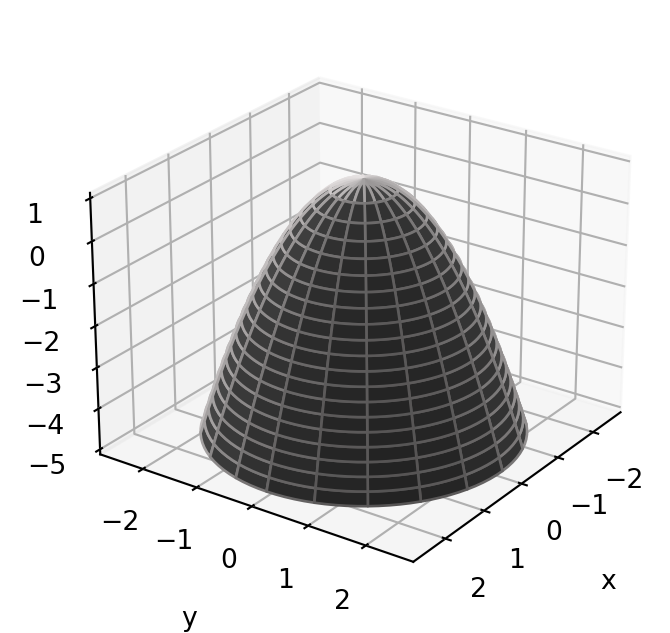
Remark 86: Tangent plane and derivations
The basic idea is as follows: If \(U \subseteq \mathbb{R}^2\) is open and \(\mathbf{p}\in U\), then \(T_{\mathbf{p}} U = \mathbb{R}^2\). We can associate to any point \(\mathbf{v}\in T_{\mathbf{p}} U\) a directional derivative acting on smooth functions \(f \colon U \to \mathbb{R}\): \[ \mathbf{v}= (v_1,v_2) \mapsto \left. \frac{\partial }{\partial v} \right|_p = v_1 \, \left. \frac{\partial }{\partial x_1} \right|_p + v_2 \, \left. \frac{\partial }{\partial x_2} \right|_p \] The above directional derivative is called a derivation.
The point is that derivations do not need to be defined through vectors, but can be defined as follows: \(D\) is a derivation if
- \(D \colon C^{\infty}(U) \to \mathbb{R}\) is a linear operator, where \(C^{\infty}(U)\) is the set of smooth functions \(f \colon U \to \mathbb{R}\),
- \(D\) satisfies the Leibnitz rule \[ D(fg) = f(\mathbf{p}) D(g) + g(\mathbf{p}) D(f) \,, \quad \forall \, f,g \in C^{\infty}(U) \,. \]
The tangent plane at p can then be defined as \[ T_{\mathbf{p}} U = \{ D \, \mbox{ derivation at } \mathbf{p}\} \,. \] Therefore \[ T_{\mathbf{p}} U \subseteq (C^{\infty}(U))^* \,, \] the dual space of smooth functions.
It is possible to do such construction directly on \(\mathcal{S}\), by introducing the concepts of:
- germ of a function
- algebra of derivations, acting on germs
An in depth discussion can be found in Chapter 3.4 of (Abate, Marco and Tovena, Francesca 2011).
4.8 Unit normal and orientability
Let \(\mathcal{S}\) be a regular surface and \(\mathbf{p}\in \mathcal{S}\). The tangent plane \(T_{\mathbf{p}} \mathcal{S}\) passes through the origin. Therefore \(T_{\mathbf{p}} \mathcal{S}\) is completely determined by giving a unit vector \(\mathbf{N}\) perpendicular to it: \[ T_{\mathbf{p}} \mathcal{S}= \{ \mathbf{x}\in \mathbb{R}^3 \, \colon \,\mathbf{x}\cdot \mathbf{N}= 0 \} \,. \] We will also write \[ \mathbf{N}\perp T_{\mathbf{p}} \mathcal{S}\,, \] to denote that \(\mathbf{N}\) is perpendicular to \(T_{\mathbf{p}} \mathcal{S}\). Clearly, also \(-\mathbf{N}\) is a unit vector, and \[ (- \mathbf{N}) \perp T_{\mathbf{p}} \mathcal{S}\,. \]
Question 87
There is no right answer to the above question. One way to proceed is the following.
Remark 88
There is however an issue: \(\mathbf{N}_{{\pmb{\sigma}}}\) is not independent on the choice of chart \({\pmb{\sigma}}\). Indeed, suppose that \(\widetilde{{\pmb{\sigma}}} \colon \widetilde{U} \to \mathbb{R}^3\) is a reparametrization of \({\pmb{\sigma}}\), that is, \[ \widetilde{{\pmb{\sigma}}} = {\pmb{\sigma}}\circ \Phi \,, \] with \(\Phi \colon \widetilde{U} \to U\) diffeomorphism. As stated in Thorem 62, we have \[ \widetilde{{\pmb{\sigma}}}_{\tilde{u}} \times \widetilde{{\pmb{\sigma}}}_{\tilde{v}} = \det J\Phi \, ( {\pmb{\sigma}}_u \times {\pmb{\sigma}}_v )\,. \] Hence \[ \mathbf{N}_{\widetilde{{\pmb{\sigma}}}} = \frac{ \widetilde{{\pmb{\sigma}}}_{\tilde{u}} \times \widetilde{{\pmb{\sigma}}}_{\tilde{v}} }{\left\| \widetilde{{\pmb{\sigma}}}_{\tilde{u}} \times \widetilde{{\pmb{\sigma}}}_{\tilde{v}} \right\|} = \frac{\det J\Phi}{|\det J\Phi|} \frac{{\pmb{\sigma}}_u \times {\pmb{\sigma}}_v}{\left\| {\pmb{\sigma}}_u \times {\pmb{\sigma}}_v \right\|} = \pm \mathbf{N}_{{\pmb{\sigma}}} \,. \] Therefore the sign on the right hand side depends on the sign of the Jacobian determinant of the transition map \(\Phi\).
The above remark motivates the following definitions.
Definition 89: Standard unit normal of a chart
Definition 90: Charts with same orientation
Let \(\mathcal{S}\) be a regular surface and \({\pmb{\sigma}}\colon U \to \mathbb{R}^3\), \(\widetilde{{\pmb{\sigma}}} \colon \widetilde{U} \to \mathbb{R}^3\) regular charts such that \[ {\pmb{\sigma}}(U) \cap \widetilde{{\pmb{\sigma}}} (\widetilde{U}) \neq \emptyset \,. \] Denote by \(\Phi\) the transition map between \(\widetilde{{\pmb{\sigma}}}\) and \({\pmb{\sigma}}\). We say that:
\({\pmb{\sigma}}\) and \(\widetilde{{\pmb{\sigma}}}\) determine the same orientation if \[ \det J \Phi > 0 \,. \]
\({\pmb{\sigma}}\) and \(\widetilde{{\pmb{\sigma}}}\) determine the opposite orientations if \[ \det J \Phi < 0 \,. \]
Example 91: Orientation of the plane
If a surface can be covered by charts with the same orientation, it is called orientable.
Definition 92: Orientable surface
Let \(\mathcal{S}\) be a regular surface. Then:
Let \[ \mathcal{A} = \{ {\pmb{\sigma}}_i \colon U_i \to \mathcal{S}\}_{i \in I} \] be an atlas for \(\mathcal{S}\). We say that \(\mathcal{A}\) is oriented, if the following property holds: \[ {\pmb{\sigma}}_i (U_i) \cap {\pmb{\sigma}}_j (U_j) \neq \emptyset \quad \implies \quad \det J \Phi > 0 \,, \] where \(\Phi\) is the transition map between \({\pmb{\sigma}}_i\) and \({\pmb{\sigma}}_j\).
\(\mathcal{S}\) is orientable if there exists an oriented atlas \(\mathcal{A}\).
If an oriented atlas \(\mathcal{A}\) is assigned, we say that \(\mathcal{S}\) is oriented by \(\mathcal{A}\).
Warning: Orientability is a global property
Example 93: Möbius band
Example 94
Check: This is because we have only one chart. Therefore any transition map \(\Phi\) will be the identity, so that \(\det J \Phi = 1 > 0\).
Remark 95
Definition 96: Unit normal of a surface
Warning
Proposition 97
Let \(\mathcal{S}\) be a regular surface. They are equivalent:
\(\mathcal{S}\) is orientable.
There exists a unit normal \(\mathbf{N}\colon \mathcal{S}\to \mathbb{R}^3\).
The proof follows from the above discussion. For a self-contained proof, we refer the reader to Proposition 4.3.7 in (Abate, Marco and Tovena, Francesca 2011).
In view of Propostion 97, for an oriented surface there is a natural choice of unit normal, which we call standard unit normal of \(\mathcal{S}\).
Definition 98: Standard unit normal of a surface
Notation
Example 99: Calculation of \(\mathbf{N}\)
Solution. The standard unit normal to \({\pmb{\sigma}}\) is \[\begin{align*} & {\pmb{\sigma}}_{u} =\left(e^{u}, 1,0\right) \,, \,\, {\pmb{\sigma}}_{v} =(0,1,1) \,, & & \left\| {\pmb{\sigma}}_u \times {\pmb{\sigma}}_v \right\| = \sqrt{1+2 e^{2 u}}\\ & {\pmb{\sigma}}_{u} \times {\pmb{\sigma}}_{v} = \left(1,-e^{u}, e^{u}\right) & & \mathbf{N}_{{\pmb{\sigma}}} = \frac{\left(1,-e^{u}, e^{u}\right)}{\sqrt{1+2 e^{2 u}}} \end{align*}\]
4.9 Differential of smooth functions
Let \(f \colon U \to V\) with \(U,V \subseteq \mathbb{R}^2\) open. Suppose \(f\) is smooth. By definition, the differential of \(f\) at \(\mathbf{p}\in U\) is a linear map \[ d_{\mathbf{p}}f \colon \mathbb{R}^2 \to \mathbb{R}^2 \] which approximates \(f\) locally at \(\mathbf{p}\). We have seen in Example 78 that \[ T_{\mathbf{p}} U = \mathbb{R}^2 \,. \] Therefore we can interpret \(d_{\mathbf{p}}f\) as a map between tangent planes: \[ d_{\mathbf{p}}f \colon T_{\mathbf{p}} U \to T_{\mathbf{p}} U \,. \] This reasoning suggests how to define the differential of a smooth map between surfaces: If \(f \colon \mathcal{S}\to \widetilde{\mathcal{S}}\) is smooth, we could define its differential at \(\mathbf{p}\in \mathcal{S}\) as a linear map \[ d_{\mathbf{p}}f \colon T_{\mathbf{p}} \mathcal{S}\to T_{f(\mathbf{p})} \widetilde{\mathcal{S}} \,. \] How is the above map defined explicitly? To answer this question, we need a Lemma.
Lemma 100
Proof
Lemma 100 justifies the following definition of differential.
Definition 101: Differential of smooth function
We need to show that Definition 100 is well-posed, i.e., that \(d_{\mathbf{p}} f (\mathbf{v})\) depends only on \(\mathbf{p}\), \(f\), \(\mathbf{v}\): This is because there are infinitely many curves \({\pmb{\gamma}}\) such that \[ {\pmb{\gamma}}(0) = \mathbf{p}\,, \qquad \dot{{\pmb{\gamma}}}(0) = \mathbf{v}\,. \] Therefore, a priori, \(d_{\mathbf{p}} f (\mathbf{v})\) could depend on which curve is chosen. This is however, not the case, as shown in the next Proposition. We will also show that the map \(df_{\mathbf{p}}\) is linear, and compute its matrix.
Theorem 102: Matrix of \(d_{\mathbf{p}}f\)
Let \(\mathcal{S},\widetilde{\mathcal{S}}\) be regular surfaces, and \(f \colon \mathcal{S}\to \widetilde{\mathcal{S}}\) smooth.
\(d_{\mathbf{p}}f (\mathbf{v})\) depends only on \(f, \mathbf{p},\mathbf{v}\) (and not on \({\pmb{\gamma}}\)).
\(d_{\mathbf{p}} f\) is linear, that is, for all \(\mathbf{v},\mathbf{w}\in T_{\mathbf{p}} \mathcal{S}\) and \(\lambda,\mu \in \mathbb{R}\) \[ d_{\mathbf{p}}f (\lambda \mathbf{v}+ \mu \mathbf{w}) = \lambda d_{\mathbf{p}}f (\mathbf{v}) + \mu d_{\mathbf{p}}f (\mathbf{w}) \,. \]
Let \({\pmb{\sigma}}\colon U \to \mathcal{S}\), \(\widetilde{{\pmb{\sigma}}} \colon \widetilde{U} \to \widetilde{\mathcal{S}}\) be regular charts at \(\mathbf{p}\), \(f(\mathbf{p})\). Let \(\alpha\) and \(\beta\) be the components of \(\Psi = \widetilde{{\pmb{\sigma}}}^{-1} \circ f \circ {\pmb{\sigma}}\), so that \[ \widetilde{{\pmb{\sigma}}} ( \alpha(u,v) , \beta(u,v) ) = f({\pmb{\sigma}}(u,v)) \,, \quad \forall \, (u,v) \in U \,. \] The matrix of \(d_{\mathbf{p}}f\) with respect to the basis \[ \{ {\pmb{\sigma}}_u , {\pmb{\sigma}}_v \} \,\, \mbox{ on } \,\, T_{\mathbf{p}} \mathcal{S}\,, \quad \{ \widetilde{{\pmb{\sigma}}}_{\tilde{u}} , \widetilde{{\pmb{\sigma}}}_{\tilde{v}} \} \,\, \mbox{ on } \,\, T_{f(\mathbf{p})} \widetilde{\mathcal{S}} \,, \] is given by the Jacobian of the map \(\Psi\), that is, \[ J\Psi = \left( \begin{array}{cc} \alpha_u & \alpha_v \\ \beta_u & \beta_v \\ \end{array} \right) \,. \]
Point 3 in the above Theorem says that:
Let \(f \colon \mathcal{S}\to \widetilde{\mathcal{S}}\) be a smooth function between surfaces. Consider local charts \({\pmb{\sigma}}\) at \(\mathbf{p}\), and \(\widetilde{{\pmb{\sigma}}}\) at \(f(\mathbf{p})\). By definition of smooth map, the real map \[ \Psi \colon \mathbb{R}^2 \to \mathbb{R}^2 \,, \qquad \Psi := \widetilde{{\pmb{\sigma}}}^{-1} \circ f \circ {\pmb{\sigma}} \] is smooth.
The matrix of the differential \(d_{\mathbf{p}}f\) with respect to the basis \[ \{ {\pmb{\sigma}}_u , {\pmb{\sigma}}_v \} \,\, \mbox{ on } \,\, T_{\mathbf{p}} \mathcal{S}\,, \quad \{ \widetilde{{\pmb{\sigma}}}_{\tilde{u}} , \widetilde{{\pmb{\sigma}}}_{\tilde{v}} \} \,\, \mbox{ on } \,\, T_{f(\mathbf{p})} \widetilde{\mathcal{S}} \,, \] is just the Jacobian of \(\Psi\).
Proof
Let \(\mathbf{p}\in \mathcal{S}\). In order to prove the thesis, we need compute \(d_{\mathbf{p}} f\). To this end, let \({\pmb{\sigma}}\colon U \to \mathcal{S}\) be a chart at \(\mathbf{p}\). Denote \[ (u_0,v_0) = {\pmb{\sigma}}^{-1}(\mathbf{p}) \,. \] Let \(\widetilde{{\pmb{\sigma}}} \colon \widetilde{U} \to \widetilde{\mathcal{S}}\) a chart at \(f(\mathbf{p})\). Since \(f\) is smooth, the map \[ \Psi \colon U \to \widetilde{U} \,, \quad \Psi := \widetilde{{\pmb{\sigma}}}^{-1} \circ f \circ {\pmb{\sigma}} \] is smooth. Denote by \[ (u,v) \mapsto ( \alpha(u,v), \beta(u,v) ) \] the smooth components of \(\Psi\). By definition of \(\Psi\) it holds \[ \widetilde{{\pmb{\sigma}}} ( \alpha(u,v) , \beta(u,v) ) = f({\pmb{\sigma}}(u,v)) \,, \quad \forall \, (u,v) \in U \,. \tag{4.4}\] Let \(\mathbf{v}\in T_{\mathbf{p}} \mathcal{S}\) and denote by \((\lambda,\mu)\) the components of \(\mathbf{v}\) with respect to the basis \(\{{{\pmb{\sigma}}}_{u},{{\pmb{\sigma}}}_{v}\}\) of \(T_{\mathbf{p}} \mathcal{S}\), that is, \[ \mathbf{v}= \lambda {\pmb{\sigma}}_u + \mu {\pmb{\sigma}}_v \,. \] Define the scalar functions \[ u(t):= u_0 +\lambda t \,, \quad v(t):= v_0 +\mu t \,. \] Since \(U\) is open in \(\mathbb{R}^2\), and \((u_0,v_0) \in U\), there exists a sufficiently small \(\varepsilon>0\) such that \[ (u(t), v(t)) \in U \,, \quad \forall \, t \in (-\varepsilon,\varepsilon) \,. \] In particular, it is well defined the curve \[ {\pmb{\gamma}}\colon (-\varepsilon,\varepsilon) \to \mathcal{S}\,, \quad {\pmb{\gamma}}(t) := {\pmb{\sigma}}(u(t), v(t)) \,. \] It is immediate to check that \[ {\pmb{\gamma}}(0) = {\pmb{\sigma}}(u_0, v_0) = \mathbf{p}\,, \quad \dot{{\pmb{\gamma}}}(0) = \lambda {{\pmb{\sigma}}}_{u}+\mu {{\pmb{\sigma}}}_{v}= \mathbf{v}\,. \] By definition of \({\pmb{\gamma}}\), and by (4.4), we have \[\begin{align*} (f \circ {\pmb{\gamma}})(t) & = f({\pmb{\gamma}}(t)) \\ & = f( {\pmb{\sigma}}(u(t), v(t)) ) \\ & = \widetilde{{\pmb{\sigma}}} ( \alpha(u(t),v(t)), \beta(u(t),v(t)) ) \,. \end{align*}\] By chain rule we obtain \[\begin{align*} (f \circ {\pmb{\gamma}})'(t) & = \widetilde{{\pmb{\sigma}}}_{\tilde{u}} \frac{d}{dt} \left[ \alpha(u(t),v(t)) \right] + \widetilde{{\pmb{\sigma}}}_{\tilde{v}} \frac{d}{dt} \left[ \beta(u(t),v(t)) \right] \\ & = \widetilde{{\pmb{\sigma}}}_{\tilde{u}} \left[ \alpha_u \dot{u}(t) + \alpha_v \dot{v}(t) \right] + \widetilde{{\pmb{\sigma}}}_{\tilde{v}} \left[ \beta_u \dot{u}(t) + \beta_v \dot{v}(t) \right] \,. \end{align*}\] Noting that \[ \dot{u}(0) = \lambda \,, \qquad \dot{v}(0) = \mu \,, \] we get \[ (f \circ {\pmb{\gamma}})'(0) = \widetilde{{\pmb{\sigma}}}_{\tilde{u}} \left[ \lambda \alpha_u + \mu \alpha_v \right] + \widetilde{{\pmb{\sigma}}}_{\tilde{v}} \left[ \lambda \beta_u + \mu \beta_v \right] \,. \] As, by definition of differential, \[ d_{\mathbf{p}} f (\mathbf{v}) = ( f \circ {\pmb{\gamma}})' (0)\,, \] we have obtained \[ d_{\mathbf{p}} f (\mathbf{v}) = \widetilde{{\pmb{\sigma}}}_{\tilde{u}} [ \lambda \alpha_u + \mu \alpha_v ] + \widetilde{{\pmb{\sigma}}}_{\tilde{v}} [ \lambda \beta_u + \mu \beta_v] \tag{4.5}\] We can now prove the 3 points stated in the Proposition:
The RHS of (4.5) depends only on \(\lambda,\mu\) (the components of \(\mathbf{v}\)), \(f\) (via the components \(\alpha,\beta\) of \(\Psi\)), and the point \(\mathbf{p}\). In particular \(d_{\mathbf{p}}f(\mathbf{v})\) does not depend on the choice of \({\pmb{\gamma}}\), and the definition is well-posed.
The RHS of (4.5) is linear in the components \(\lambda,\mu\) of \(\mathbf{v}\). In particular \(d_{\mathbf{p}}f(\mathbf{v})\) is linear in \(\mathbf{v}\).
The coordinates of \({{\pmb{\sigma}}}_{u}\) with respect to the basis \(\{{{\pmb{\sigma}}}_{u},{{\pmb{\sigma}}}_{v}\}\) of \(T_{\mathbf{p}} \mathcal{S}\) are \[ (\lambda,\mu) = (1,0)\,. \] Using (4.5), we get \[ d_{\mathbf{p}}f({{\pmb{\sigma}}}_{u}) = \widetilde{{\pmb{\sigma}}}_{\tilde{u}}\alpha_u + \widetilde{{\pmb{\sigma}}}_{\tilde{v}} \beta_u \] Similarly, the coordinates of \({{\pmb{\sigma}}}_{v}\) with respect to the basis \(\{{{\pmb{\sigma}}}_{u},{{\pmb{\sigma}}}_{v}\}\) of \(T_{\mathbf{p}} \mathcal{S}\) are \[ (\lambda,\mu) = (0,1) \,. \] Therefore \[ d_{\mathbf{p}}f({{\pmb{\sigma}}}_{v}) = \widetilde{{\pmb{\sigma}}}_{\tilde{u}}\alpha_v + \widetilde{{\pmb{\sigma}}}_{\tilde{v}} \beta_v \] This shows that the matrix of the linear application \(d_{\mathbf{p}}f\) with respect to the basis \(\{{{\pmb{\sigma}}}_{u},{{\pmb{\sigma}}}_{v}\}\) on \(T_{\mathbf{p}} \mathcal{S}\), and the basis \(\{\widetilde{{\pmb{\sigma}}}_{\tilde{u}} , \widetilde{{\pmb{\sigma}}}_{\tilde{v}}\}\) on \(T_{f(\mathbf{p})} \widetilde{\mathcal{S}}\), is given by \[ \left( \begin{array}{cc} \alpha_u & \alpha_v \\ \beta_u & \beta_v \\ \end{array} \right) = J\Psi \,. \]
Given the above discussion, we have 2 ways of computing the differential of a smooth function \[ f \colon \mathcal{S}\to \widetilde{\mathcal{S}} \]
- By using the definition: Let \(\mathbf{v}\in T_{\mathbf{p}} \mathcal{S}\) and let \({\pmb{\gamma}}\) be a curve on \(\mathcal{S}\) such that \[
{\pmb{\gamma}}(0) = \mathbf{p}\,, \quad \dot{{\pmb{\gamma}}}(0) = \mathbf{v}\,.
\] Then \[
d_{\mathbf{p}} f (\mathbf{v}) = (f \circ {\pmb{\gamma}})'(0)\,.
\] Method to construct \({\pmb{\gamma}}\): Following the proof of Theorem 102, one can proceed as follows:
- Find \({\pmb{\sigma}}\colon U \to \mathcal{S}\) chart of \(\mathcal{S}\) at \(\mathbf{p}\).
- Compute \[ T_{\mathbf{p}} \mathcal{S}= \operatorname{span} \{ {{\pmb{\sigma}}}_{u},{{\pmb{\sigma}}}_{v}\} \,. \]
- For \(\mathbf{v}\in T_{\mathbf{p}} \mathcal{S}\), compute \(\lambda,\mu\) such that \[ \mathbf{v}= \lambda {{\pmb{\sigma}}}_{u}+ \mu {{\pmb{\sigma}}}_{v}\,. \]
- Compute \((u_0,v_0) = {\pmb{\sigma}}^{-1}(\mathbf{p})\).
- Define the curve \[ {\pmb{\gamma}}(t) = {\pmb{\sigma}}( u_0 + \lambda t, v_0 + \mu t ) \,. \] Such curve satisfies \[ {\pmb{\gamma}}(0) = \mathbf{p}\,, \qquad \dot{{\pmb{\gamma}}}(0) = \mathbf{v}\,. \]
- Compute \[ d_{\mathbf{p}} f (\mathbf{v}) = (f \circ {\pmb{\gamma}})'(0)\,. \]
- By using the matrix representation: Let \(\mathbf{v}\in T_{\mathbf{p}} \mathcal{S}\)
- Find \({\pmb{\sigma}}\colon U \to \mathcal{S}\) chart of \(\mathcal{S}\) at \(\mathbf{p}\).
- Find \(\widetilde{{\pmb{\sigma}}}\colon \widetilde{U}\to \widetilde{\mathcal{S}}\) chart of \(\widetilde{\mathcal{S}}\) at \(f(\mathbf{p})\).
- Compute the components \(\alpha,\beta\) of the function \[ \widetilde{{\pmb{\sigma}}}^{-1} \circ f \circ {\pmb{\sigma}}\colon U \to \widetilde{U}\,. \]
- The matrix of \(d_{\mathbf{p}}f\) with respect to the basis \(\{{\pmb{\sigma}}_u,{\pmb{\sigma}}_v\}\) on \(T_{\mathbf{p}} \mathcal{S}\), and the basis \(\{{\widetilde{{\pmb{\sigma}}}}_{u},{\widetilde{{\pmb{\sigma}}}}_{v}\}\) on \(T_{\mathbf{p}} \widetilde{\mathcal{S}}\), is given by \[ d_{\mathbf{p}} f = J\Psi = \left( \begin{array}{cc} \alpha_u & \alpha_v \\ \beta_u & \beta_v \\ \end{array} \right) \,. \]
- Compute \(\lambda,\mu\) such that \[ \mathbf{v}= \lambda {{\pmb{\sigma}}}_{u}+ \mu {{\pmb{\sigma}}}_{v}\,. \]
- Compute \[ d_{\mathbf{p}} f (\mathbf{v}) = \tilde{\lambda} {\widetilde{{\pmb{\sigma}}}}_{u}+ \tilde{\mu} {\widetilde{{\pmb{\sigma}}}}_{v} \] where the coefficients \(\tilde{\lambda}\) and \(\tilde{\mu}\) are \[ \left( \begin{array}{c} \tilde{\lambda} \\ \tilde{\mu} \\ \end{array} \right) = \left( \begin{array}{cc} \alpha_u & \alpha_v \\ \beta_u & \beta_v \\ \end{array} \right) \left( \begin{array}{c} \lambda \\ \mu \\ \end{array} \right) \,. \]
Let us give example calculations for both methods.
Example 103: Computing \(d_{\mathbf{p}}f\) using the definition
Question. Consider the plane \(\mathcal{S}= \{z=0\}\), the unit cylinder \(\widetilde{\mathcal{S}} = \{ x^2 + y^2 = 1 \}\), and the map \[ f \colon S \to \widetilde{\mathcal{S}} \,, \qquad f(x,y,0) = (\cos x , \sin x, y) \,. \]
- Compute \(T_{\mathbf{p}}\mathcal{S}\).
- Compute \(d_{\mathbf{p}}f\) at \(\mathbf{p}= (u_0,v_0,0)\) and \(\mathbf{v}= (\lambda,\mu,0)\).
Solution.
A chart for \(\mathcal{S}\) is given by \({\pmb{\sigma}}(u,v) = (u,v,0)\). Hence, \[ {\pmb{\sigma}}_u = (1,0,0) \,, \quad {\pmb{\sigma}}_v = (0,1,0) \,, \] and the tangent space is \[ T_{\mathbf{p}} \mathcal{S}= \operatorname{span} \{ {\pmb{\sigma}}_u,{\pmb{\sigma}}_v \} = \{ (\lambda,\mu,0) \, \colon \, \lambda,\mu \in \mathbb{R}\} \,. \]
Define the curve \({\pmb{\gamma}}\colon (-\varepsilon,\varepsilon) \to \mathcal{S}\) by setting \[ {\pmb{\gamma}}(t) := {\pmb{\sigma}}(u_0 + t \lambda, v_0 + t \mu ) = (u_0 + t \lambda, v_0 + t \mu, 0)\,. \] Note that \({\pmb{\gamma}}(0) = \mathbf{p}\) and \(\dot{{\pmb{\gamma}}}(0) = \mathbf{v}= (\lambda,\mu,0)\). Therefore, the differential is given by \[\begin{align*} & (f \circ {\pmb{\gamma}}) (t) = ( \cos(u_0 + t \lambda), \sin(u_0 + t \lambda),v_0 + t \mu ) \,,\\ & (f \circ {\pmb{\gamma}})' (t) = (- \lambda \sin (u_0 + t\lambda), \lambda \cos (u_0 + t \lambda), \mu) \,, \\ & d_{\mathbf{p}} f (\mathbf{v}) = (f \circ {\pmb{\gamma}})' (0) = (- \lambda \sin (u_0), \lambda \cos (u_0), \mu) \,. \end{align*}\]
Example 104: Computing the matrix of \(d_{\mathbf{p}}f\)
Solution. Note that \(\widetilde{{\pmb{\sigma}}}^{-1} (u,v,0) =(u,v)\). Hence, \[\begin{align*} \Psi(u,v) & = \widetilde{{\pmb{\sigma}}}^{-1} \left( f({\pmb{\sigma}}(u,v)) \right) = \widetilde{{\pmb{\sigma}}}^{-1} \left( f(\cos u, \sin u, v ) \right) \\ & = \widetilde{{\pmb{\sigma}}}^{-1} \left( \sin (u), \cos (u) v, 0 \right) = \left( \sin (u), \cos (u) v \right) \,. \end{align*}\] The components of \(\Psi\) are \[ \alpha(u,v) = \sin(u)\,, \quad \beta (u,v) = \cos (u) v \,. \] The matrix of \(d_{\mathbf{p}}f\) is hence \[ J\Psi = \left( \begin{array}{cc} \alpha_u & \alpha_v \\ \beta_u & \beta_v \\ \end{array} \right) = \left( \begin{array}{cc} \cos (u) & 0 \\ -\sin (u) v & \cos(u) \\ \end{array} \right) \,. \]
The differential satisfies the following useful properties.
Proposition 105
The following hold:
If \(\mathcal{S}\) is a regular surface and \(\mathbf{p}\in \mathcal{S}\), the differential at \(\mathbf{p}\) of the identity map \[ I \colon \mathcal{S}\to \mathcal{S}\,, \quad I(\mathbf{x}):=\mathbf{x}\,, \] is the identity map \[ I \colon T_{\mathbf{p}} (\mathcal{S}) \to T_{\mathbf{p}} (\mathcal{S}) \,, \quad I(\mathbf{v}):=\mathbf{v}\,. \]
If \(\mathcal{S}_1\), \(\mathcal{S}_2\) and \(\mathcal{S}_3\) are regular surfaces and \[ f \colon \mathcal{S}_1 \to \mathcal{S}_2 \,, \quad g \colon \mathcal{S}_2 \to \mathcal{S}_3 \,, \] are smooth maps, then \[ d_{\mathbf{p}} ( g \circ f ) = d_{f(\mathbf{p})} g \circ d_{\mathbf{p}} f \,, \quad \forall \mathbf{p}\in T_{\mathbf{p}} \mathcal{S}_1 \,. \]
If \(\mathcal{S}_1\), \(\mathcal{S}_2\) are regular surfaces and \[ f \colon \mathcal{S}_1 \to \mathcal{S}_2 \,, \] is a diffeomorphism, then the differential \[ d_{\mathbf{p}} \colon T_{\mathbf{p}} \mathcal{S}_1 \to T_{f(\mathbf{p})} \mathcal{S}_2 \] is invertible for all \(\mathbf{p}\in \mathcal{S}_1\).
For a proof see Proposition 4.4.5 in (Pressley 2010). The above Proposition says that the differential of diffeomorphism is invertible. The converse statement is true locally.
Theorem 106
Let \(\mathcal{S}_1\), \(\mathcal{S}_2\) be regular surfaces and \(f \colon \mathcal{S}_1 \to \mathcal{S}_2\) smooth. They are equivalent:
- \(f\) is a local diffeomorphism at \(\mathbf{p}\).
- The differential \(d_{\mathbf{p}} f \colon T_{\mathbf{p}} \mathcal{S}_1 \to T_{f(\mathbf{p})} \mathcal{S}_2\) is invertible at \(\mathbf{p}\).
The proof is based on the Inverse Function Theorem 39, see Proposition 4.4.6 in (Pressley 2010).
4.10 Examples of Surfaces
In this section we discuss a few families of surfaces:
- Level surfaces
- Quadrics
- Rules surfaces
- Surfaces of revolution
4.10.1 Level surfaces
Level surfaces are described as the set of zeros of scalar functions.
Definition 107: Level surface
We now give a result concerning regularity of level surfaces. The proof, rather technical, is based on the Implicit Function Theorem. It can be found in Proposition 3.1.25 of (Abate, Marco and Tovena, Francesca 2011). We decide to omit it.
Theorem 108: Regularity of level surfaces
We saw that the circular cone \[ \mathcal{S}:= \{ (x,y,z) \in \mathbb{R}^3 \, \colon \,x^2 + y^2 = z^2 \} \] is not a surface. However, the positive sheet \[ \mathcal{S}^+ := \{ (x,y,z) \in \mathbb{R}^3 \, \colon \,x^2 + y^2 = z^2 \,, \, z>0 \} \,. \] is a regular surface, see Figure 4.14, with regular atlas given by \(\mathcal{A} = \{{\pmb{\sigma}}\}\), where \[ {\pmb{\sigma}}\colon \mathbb{R}^2 \to \mathbb{R}^3 \,, \quad {\pmb{\sigma}}(u,v) = (u,v,\sqrt{u^2 + v^2}) \,. \] We can also show that \(\mathcal{S}^+\) is a regular surface by using Theorem 107.
Example 109: Circular cone
Solution. Define the open set \(V \subset \mathbb{R}^3\) and \(f \colon V \to \mathbb{R}\) by \[ V = \{ (x,y,z) \in \mathbb{R}^3 \, \colon \,z > 0 \} \,, \quad f(x,y,z) = x^2 + y^2 - z^2 \,. \] \(\mathcal{S}\) is a regular surface, since \(\mathcal{S}= \mathcal{S}_f\) and \[ \nabla f (x,y,z) = ( 2x, 2y, -2z ) \neq {\pmb{0}}\,, \quad \forall \, (x,y,z) \in V \,. \]
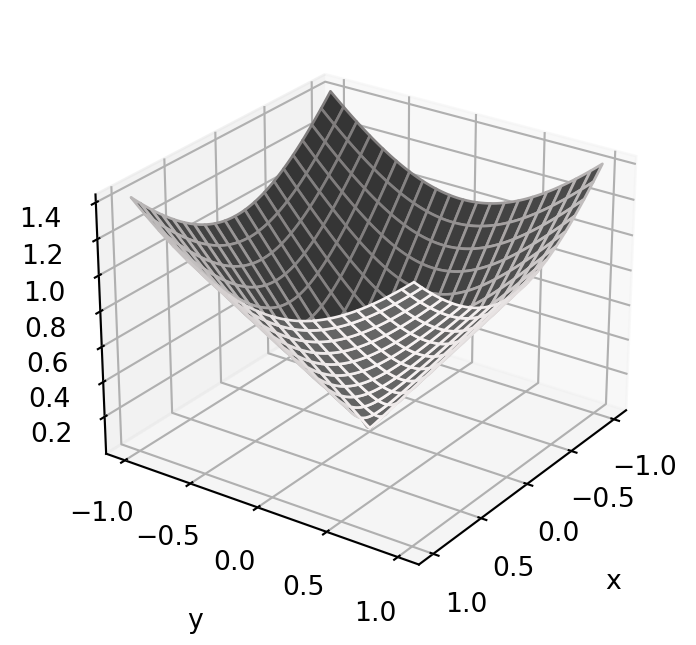
Let us give a characterization of the tangent plane to level surfaces.
Theorem 110: Tangent plane of level surfaces
Let \(f \colon V \to \mathbb{R}\) be smooth, with \(V \subseteq \mathbb{R}^3\) open. Assume \[ \nabla f (x,y,z) \neq {\pmb{0}}\,, \quad \forall \, (x,y,z) \in V \,. \] Let \(\mathbf{p}\in \mathcal{S}_f\). Then \(\nabla f(\mathbf{p}) \perp T_{\mathbf{p}} \mathcal{S}_f\), and
The cartesian equation of \(T_{\mathbf{p}} \mathcal{S}_f\) is given by \[ \nabla f (\mathbf{p}) \cdot \mathbf{x}= 0 \,, \quad \forall \, \mathbf{x}\in \mathbb{R}^3\,, \]
The cartesian equation for \(\mathbf{p}+ T_{\mathbf{p}} \mathcal{S}_f\) is given by \[ \nabla f(\mathbf{p}) \cdot (\mathbf{x}- \mathbf{p}) = 0 \,, \quad \forall \, \mathbf{x}\in \mathbb{R}^3\,. \]
Proof
Example 111: Unit cylinder
Question. Consider the unit cylinder \(\mathcal{S}= \{ x^2 + y^2 = 1 \}\).
- Prove that \(\mathcal{S}\) is a regular surface.
- Find the equation of \(T_{\mathbf{p}} \mathcal{S}\) at \(\mathbf{p}= \left( \sqrt{2}/2,\sqrt{2}/2,5 \right)\).
Solution.
Define the open set \(V \subseteq \mathbb{R}^3\) and \(f \colon V \to \mathbb{R}\) by \[ V = \mathbb{R}^3 \smallsetminus \{ (0,0,z) \, \colon \,z \in \mathbb{R}\} \,, \quad f(x,y,z) := x^2 + y^2 -1 \,. \] \(\mathcal{S}\) is a regular surface, since \(\mathcal{S}= \mathcal{S}_f\) and \[ \nabla f (x,y,z) = ( 2x, 2y, 0 ) \neq {\pmb{0}}\,, \quad \forall \, (x,y,z) \in V \,. \]
Using the expression for \(\nabla f\) in Point 1, we get \[ \nabla f (\mathbf{p}) = \nabla f \left( \frac{\sqrt{2}}{2},\frac{\sqrt{2}}{2},5 \right) = (\sqrt{2},\sqrt{2},0) \,. \] The equation for \(T_{\mathbf{p}} \mathcal{S}\) is \[ \nabla f (\mathbf{p}) \cdot \mathbf{x}= 0 \,\, \iff \,\, x + y = 0 \,. \]
4.10.2 Quadrics
Quadrics are special level surfaces \[ S_f = \left\{ (x,y,z) \in \mathbb{R}^3 \, \colon \,f(x,y,z) = 0 \right\} \,, \] where \[\begin{align*} f(x,y,z) = & a_1 x^2 + a_2 y^2 + a_3 z^2 + 2a_4 xy + 2a_5 xz + 2a_6 yz + \\ & + b_1 x + b_2 y + b_3 z + c \,, \end{align*}\] for some coefficients \(a_i,b_i,c \in \mathbb{R}\). Let \[ A = \left( \begin{array}{ccc} a_1 & a_4 & a_6 \\ a_4 & a_2 & a_5 \\ a_6 & a_5 & a_3 \end{array} \right) \in \mathbb{R}^{3 \times 3} \,, \] and \[ \mathbf{x}= (x,y,z)^T \,, \quad \mathbf{b} = (b_1,b_2,b_3)^T \,. \] Then \(f\) can be represented by the quadratic form \[ f(\mathbf{x}) = \mathbf{x}^T A \mathbf{x}+ \mathbf{b} \cdot \mathbf{x}+ c \,. \] The expression \(f=0\) is called a quadric equation.
As stated in the following Theorem, there are \(14\) quadrics in total. Out of these:
- 9 are interesting surfaces,
- 3 are planes,
- 1 is a line,
- 1 is a point.
Theorem 112
Ellipsoid: \(\dfrac{x^2}{p^2} + \dfrac{y^2}{q^2} + \dfrac{z^2}{r^2} = 1\).
Hyperboloid of one sheet: \(\dfrac{x^2}{p^2} + \dfrac{y^2}{q^2} - \dfrac{z^2}{r^2} = 1\)
Hyperboloid of two sheets: \(\dfrac{x^2}{p^2} - \dfrac{y^2}{q^2} - \dfrac{z^2}{r^2} = 1\)
Elliptic Paraboloid: \(\dfrac{x^2}{p^2} + \dfrac{y^2}{q^2} = z\)
Hyperbolic Paraboloid: \(\dfrac{x^2}{p^2} - \dfrac{y^2}{q^2} = z\)
Quadric Cone: \(\dfrac{x^2}{p^2} + \dfrac{y^2}{q^2} - \dfrac{z^2}{r^2} = 0\)
Elliptic Cylinder: \(\dfrac{x^2}{p^2} + \dfrac{y^2}{q^2} = 1\)
Hyperbolic Cylinder: \(\dfrac{x^2}{p^2} - \dfrac{y^2}{q^2} = 1\)
Parabolic Cylinder: \(\dfrac{x^2}{p^2} = y\)
Plane: \(x = 0\)
Two parallel planes: \(x^2 = p^2\)
Two intersecting planes: \(\dfrac{x^2}{p^2} - \dfrac{y^2}{q^2} = 0\)
Straight line: \(\dfrac{x^2}{p^2} + \dfrac{y^2}{q^2} = 0\)
Single point: \(\dfrac{x^2}{p^2} + \dfrac{y^2}{q^2} + \dfrac{z^2}{r^2} = 0\)
We refer to Figure 4.15, Figure 4.16, Figure 4.17, Figure 4.18, Figure 4.19, Figure 4.20 for illustrations.
The proof of Theorem 112 follows (quite tediously) by diagonalizing the symmetric matrix \(A\), and by studying the eigenvalues, see Theorem 5.5.2 in (Pressley 2010).
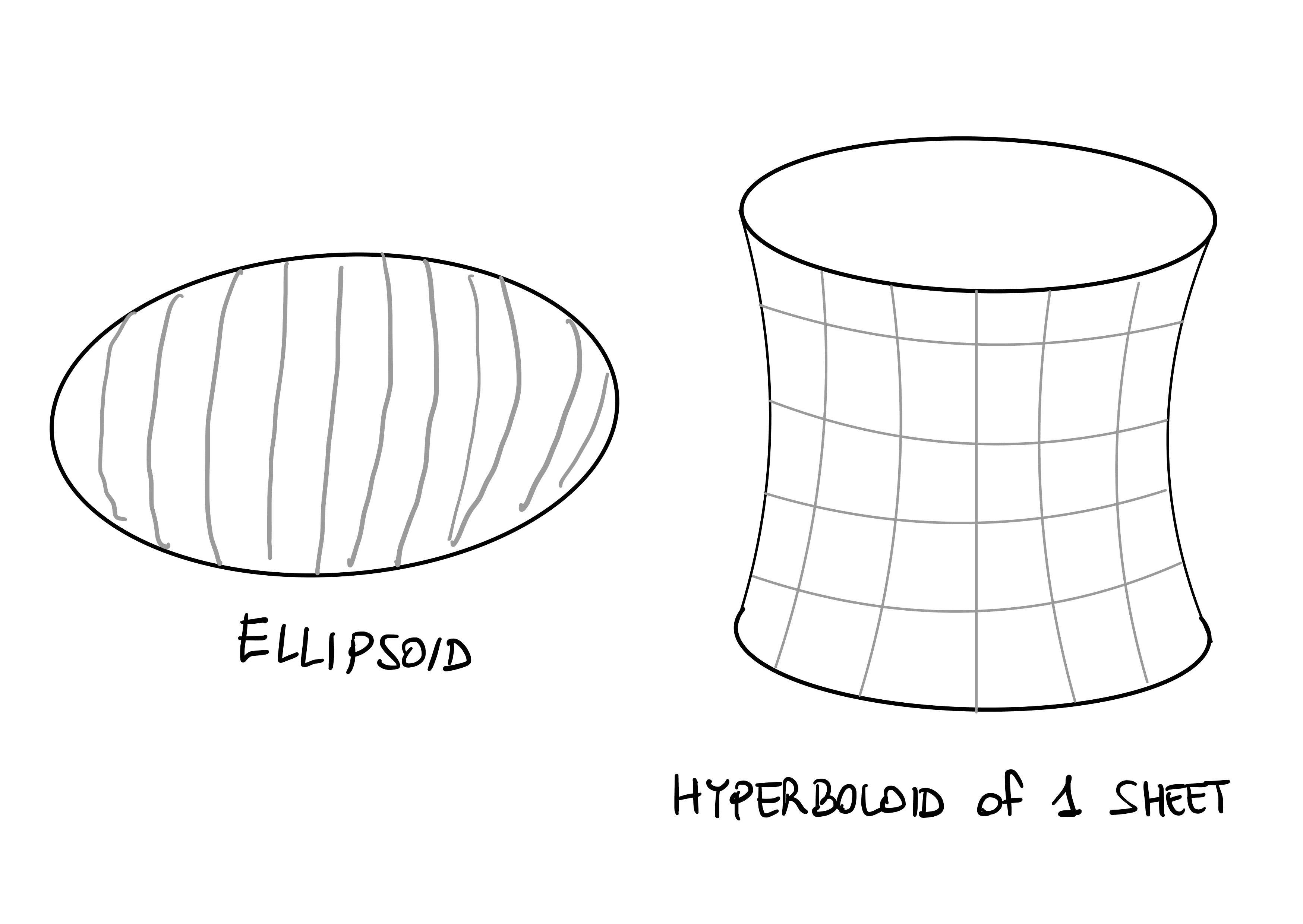
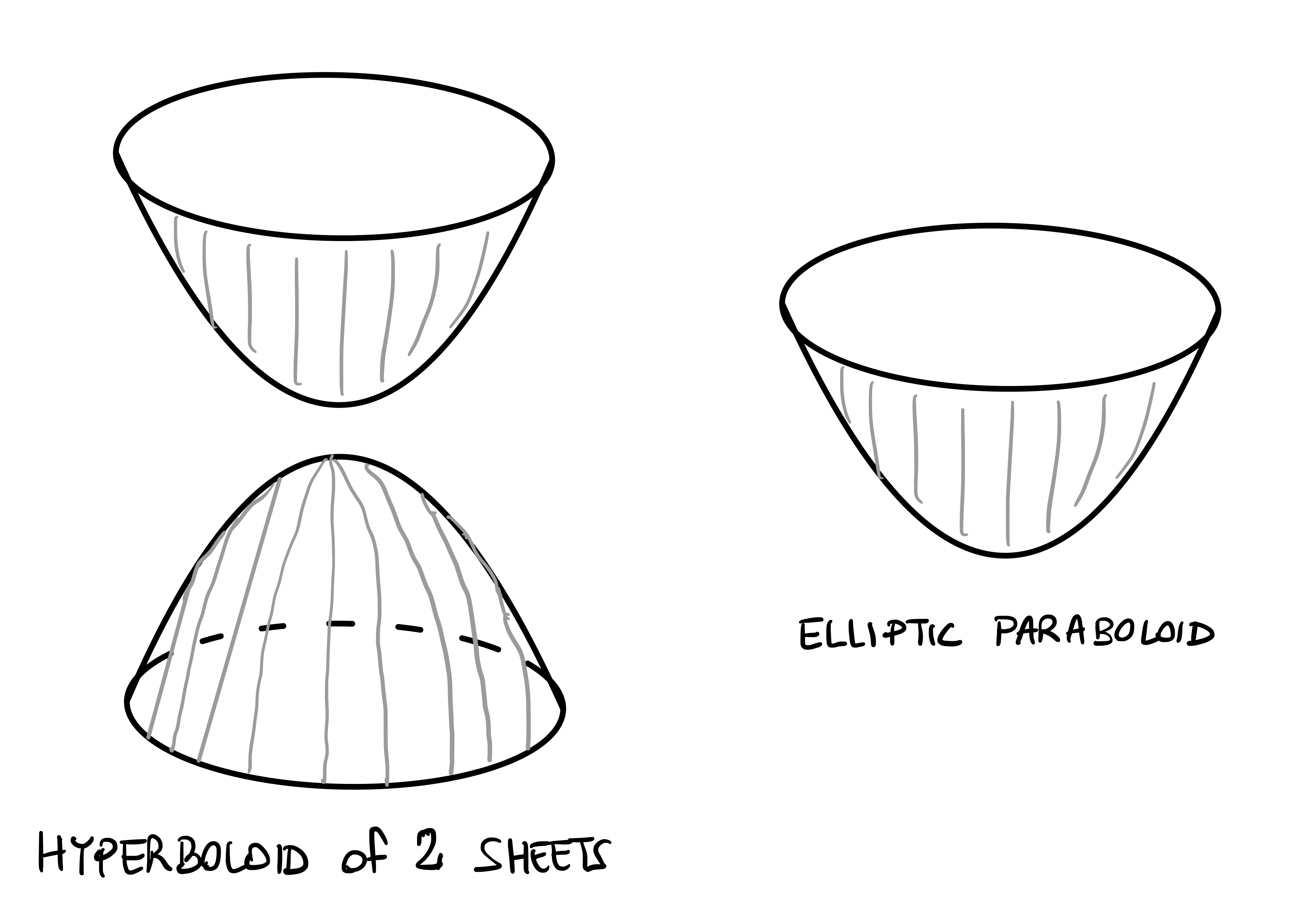
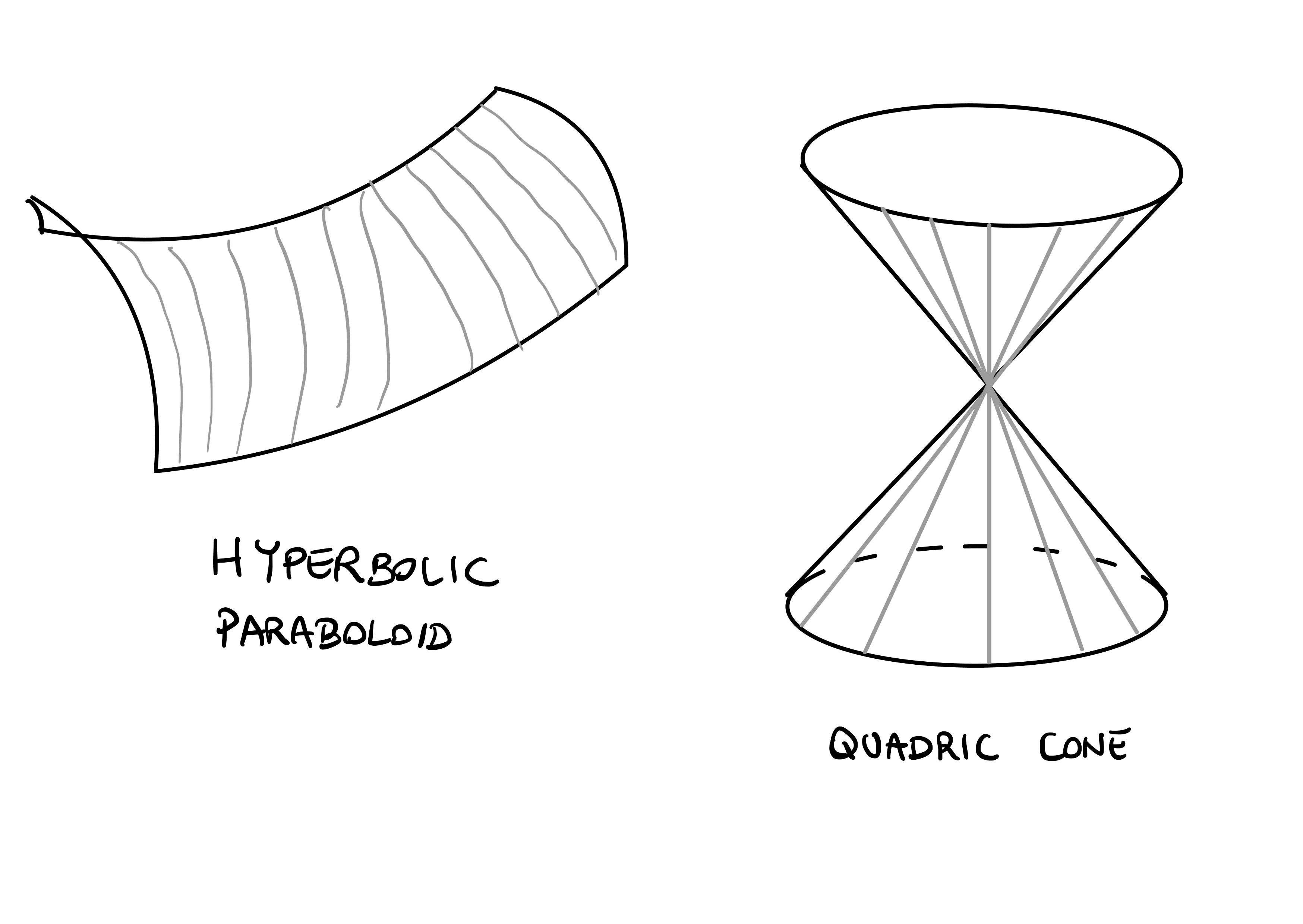
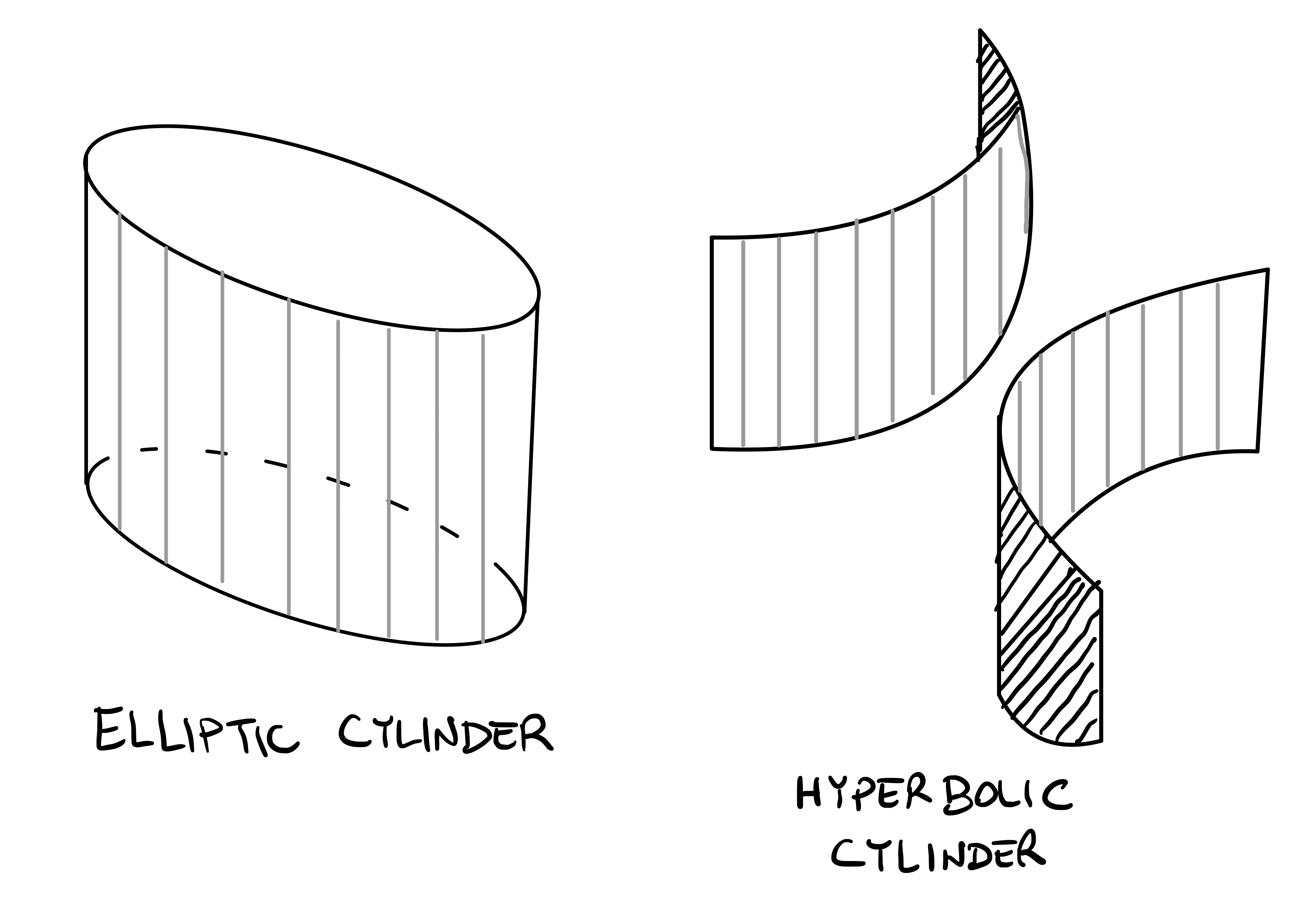
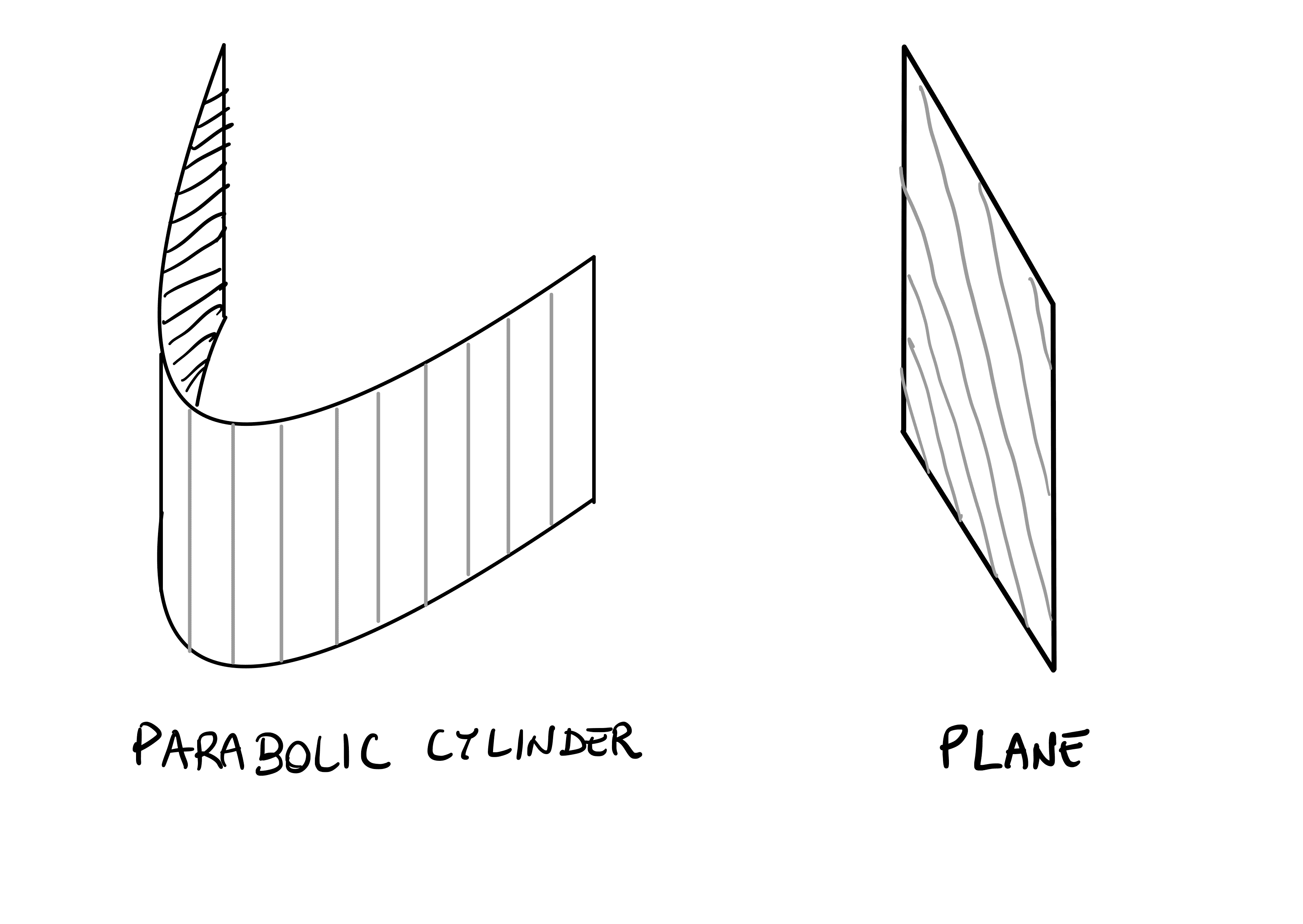
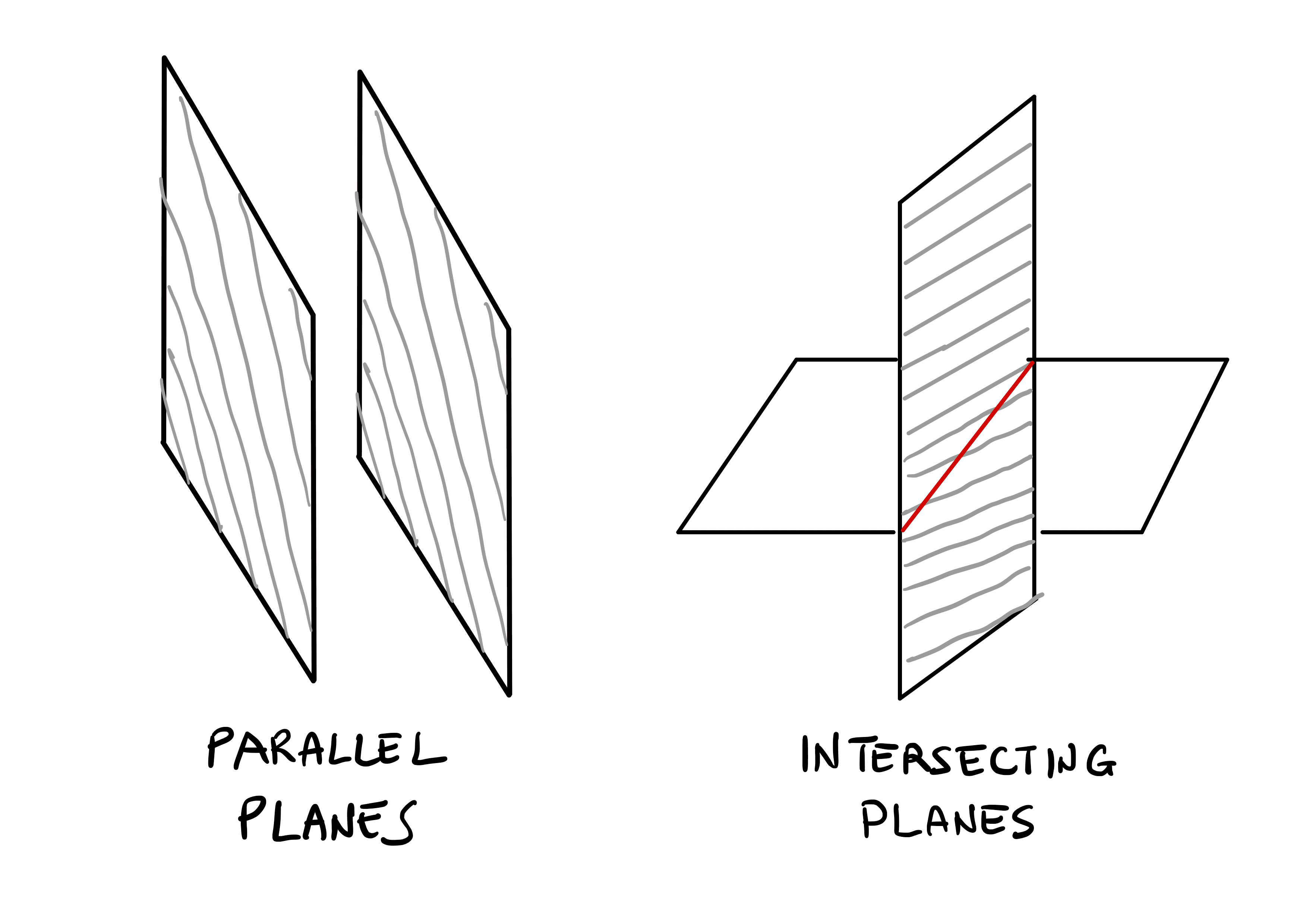
Example 113
Example 114
4.10.3 Ruled surfaces
A ruled surface, is a surface obtained as union of straight lines, called the rulings of the surface. By using curves, ruled surfaces can be defined in the following way.
Definition 115: Ruled surface
\({\pmb{\gamma}}\) is the base curve and the lines \(v \mapsto v \mathbf{a}(u)\) the rulings.
Theorem 116: Regularity of ruled surfaces
Proof
The same base curve can yield multiple ruled surfaces, depending on the choice of rulings. For example, if \({\pmb{\gamma}}\) is a circle, \[ {\pmb{\gamma}}(u) = (\cos(u), \sin(u), 0) \,, \] we can obtain both the unit cylinder, and the Möbius band.
Example 117: Unit Cylinder is ruled surface
Solution. The unit cylinder \(\mathcal{S}\) is charted by \[\begin{align*} & {\pmb{\sigma}}(u,v) = (\cos(u), \sin(u),v ) = {\pmb{\gamma}}(u) + v \mathbf{a}(u) \\ & {\pmb{\gamma}}(u) = (\cos(u), \sin(u),0 ) \,, \quad \mathbf{a} = (0,0,1) \end{align*}\] \(\mathcal{S}\) is a ruled surface, since the vectors \[ \dot{{\pmb{\gamma}}}= (-\sin(u), \cos(u), 0 ) \,, \quad \mathbf{a} = (0,0,1) \] are orthogonal, and hence linearly independent.
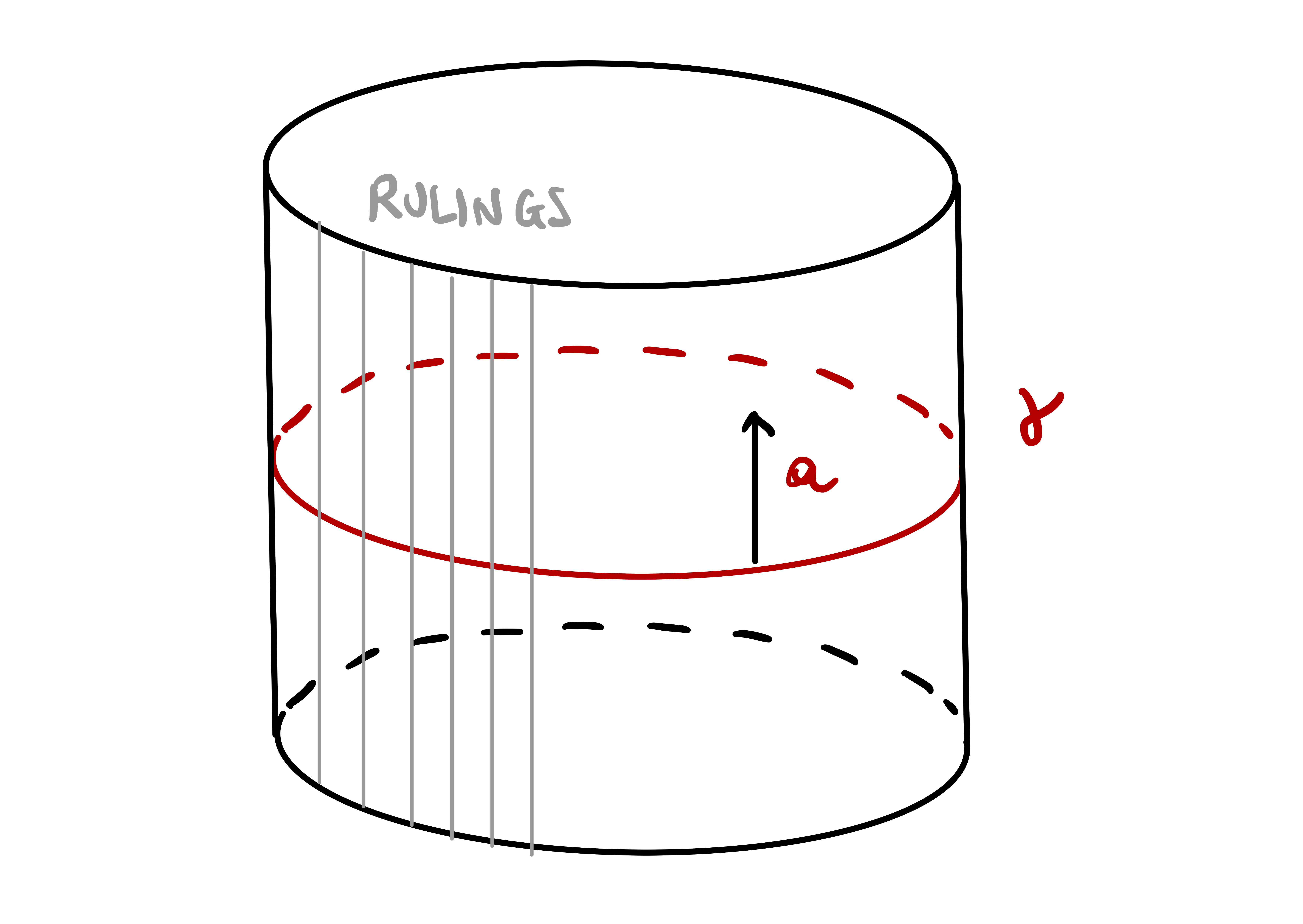
Example 118: Möbius band
Question. The Möbius band is a ruled surface with chart \[ {\pmb{\sigma}}= {\pmb{\gamma}}(u) + v \mathbf{a}(u) \,, \quad u \in (0,2\pi), \, v \in \left( -\frac12, \frac12 \right) \,, \] where \[ {\pmb{\gamma}}(u) = (\cos(u), \sin(u), 0) \] is the unit circle, and \[ \mathbf{a} = \left( -\sin \left( \frac{u}{2} \right) \cos(u), -\sin \left( \frac{u}{2} \right) \sin(u), \cos \left( \frac{u}{2} \right) \right) \] is a vector which does a half rotation while going around the unit circle \({\pmb{\gamma}}\). In particular \[ {\pmb{\sigma}}(u,v) = \left( \left[ 1 - v \sin \left( \frac{u}{2} \right) \right] \cos(u), \left[ 1 - v \sin \left( \frac{u}{2} \right) \right] \sin(u), v \cos \left( \frac{u}{2} \right) \right) \,. \]
- Compute the standard unit normal to \({\pmb{\sigma}}\).
- Prove that \(\mathcal{S}\) is non orientable.
Solution.
From the formula for \({\pmb{\sigma}}\), it is easy to compute that \[ {{\pmb{\sigma}}}_{u}\times {{\pmb{\sigma}}}_{v}= \left( - \cos(u) \cos \left( \frac{u}{2} \right), - \sin(u) \cos \left( \frac{u}{2} \right) , - \sin \left( \frac{u}{2} \right) \right) \,. \] It is also immediate to check that \(\left\| {{\pmb{\sigma}}}_{u}\times {{\pmb{\sigma}}}_{v} \right\| = 1\), and therefore the principal unit normal of \({\pmb{\sigma}}\) is \[ \mathbf{N}_{{\pmb{\sigma}}} = {\pmb{\sigma}}_u \times {{\pmb{\sigma}}}_{v}\,. \]
Suppose by contradiction that \(\mathcal{S}\) is orientable. This means there exists a globally defined principal unit normal vector \[ \mathbf{N}\colon \mathcal{S}\to \mathbb{R}^3 \,. \] By definition of principal normal, we have \[ \mathbf{N}\circ {\pmb{\sigma}}= \mathbf{N}_{{\pmb{\sigma}}} \,. \] Consider the point \(\mathbf{p}= (1,0,0)\) on \(\mathcal{S}\). Notice that, by continuity, \(\mathbf{p}\) can be obtained via \({\pmb{\sigma}}\) through the limits \[ \mathbf{p}= \lim_{u \to 0^+} {\pmb{\sigma}}(u,0) = \lim_{u \to 2\pi^-} {\pmb{\sigma}}(u,0) \,. \] Since \(\mathbf{N}\) is continuous, the above implies \[ \mathbf{N}(\mathbf{p}) = \lim_{u \to 0^+} \mathbf{N}\circ {\pmb{\sigma}}(u,0) = \lim_{u \to 2\pi^-} \mathbf{N}\circ {\pmb{\sigma}}(u,0) \,. \tag{4.6}\] However, by direct calculation: \[\begin{align*} \lim_{u \to 0^+} \mathbf{N}\circ {\pmb{\sigma}}(u,0) & = \lim_{u \to 0^+} \mathbf{N}_{{\pmb{\sigma}}} (u,0) = (-1,0,0) \\ \lim_{u \to 2\pi^-} \mathbf{N}\circ {\pmb{\sigma}}(u,0) & = \lim_{u \to 2\pi^-} \mathbf{N}_{{\pmb{\sigma}}} (u,0) = (1,0,0) \end{align*}\] This clearly contradicts (4.6). Therefore \(\mathbf{N}\) cannot exist, and \(\mathcal{S}\) is not orientable.
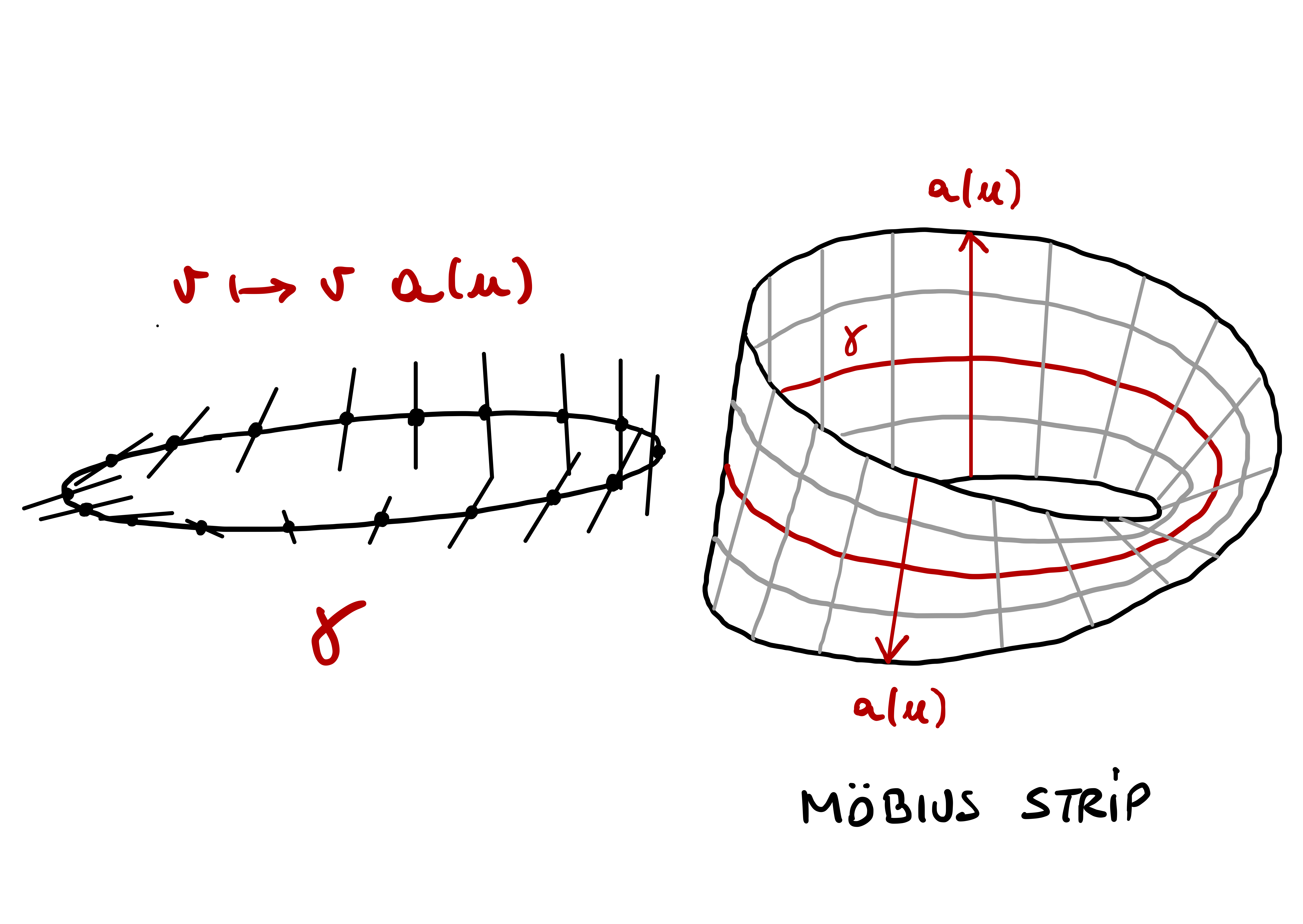
Example 119: A ruled surface
Solution. We can rearrange \[ x^{2}+10 x y+16 x^{2}-z =0 \, \iff \, (x+8 y)(x+2 y) = z \,. \] Let \(u=x+8 y\) and \(v=x+2 y\). Therefore \(u v=z\) and \[ u-v =6 y \, \implies \, y=\frac{u-v}{6} \, \implies \, x =u-8 y =\frac{4 v-u}{3} \,. \] It follows that if \((x, y, z) \in S\) then \[ \begin{aligned} (x, y, z) & =\left(\frac{4 v-u}{3}, \frac{u-v}{6}, u v\right) \\ & =\left(-\frac{u}{3}, \frac{u}{6}, 0\right)+v\left(\frac{4}{3},-\frac{1}{6}, u\right) = {\pmb{\gamma}}(u) + v \mathbf{a}(u) \,. \end{aligned} \] When \(u \neq 0\), the vectors \[ \mathbf{a}(u) =\left(\frac{4}{3},-\frac{1}{6}, u\right) \,, \quad \dot{{\pmb{\gamma}}}(u) = \left(-\frac13,\frac16,0 \right) \,, \] are linearly independent, as the last component of \(\dot{{\pmb{\gamma}}}(u)\) is \(0\). Also \(\mathbf{a}(0)\) and \(\dot{{\pmb{\gamma}}}(0)\) are linearly independent. Thus, \(\mathcal{S}\) is a ruled surface.
4.10.4 Surfaces of Revolution
Surfaces of revolution are obtained by rotating a curve about the \(z\)-axis.
Definition 120: Surface of revolution
Theorem 121: Regularity of surfaces of revolution
Proof
Example 122: Catenoid is surface of revolution
Solution. Note that \(f>0\). \(\mathcal{S}\) is regular because \({\pmb{\gamma}}\) is regular, as \[ \dot{{\pmb{\gamma}}}= \left( \sinh (v), 0 , 1 \right) \,, \quad \left\| \dot{{\pmb{\gamma}}} \right\|^2 = 1+ \sinh(v)^2 \geq 1 \,. \]
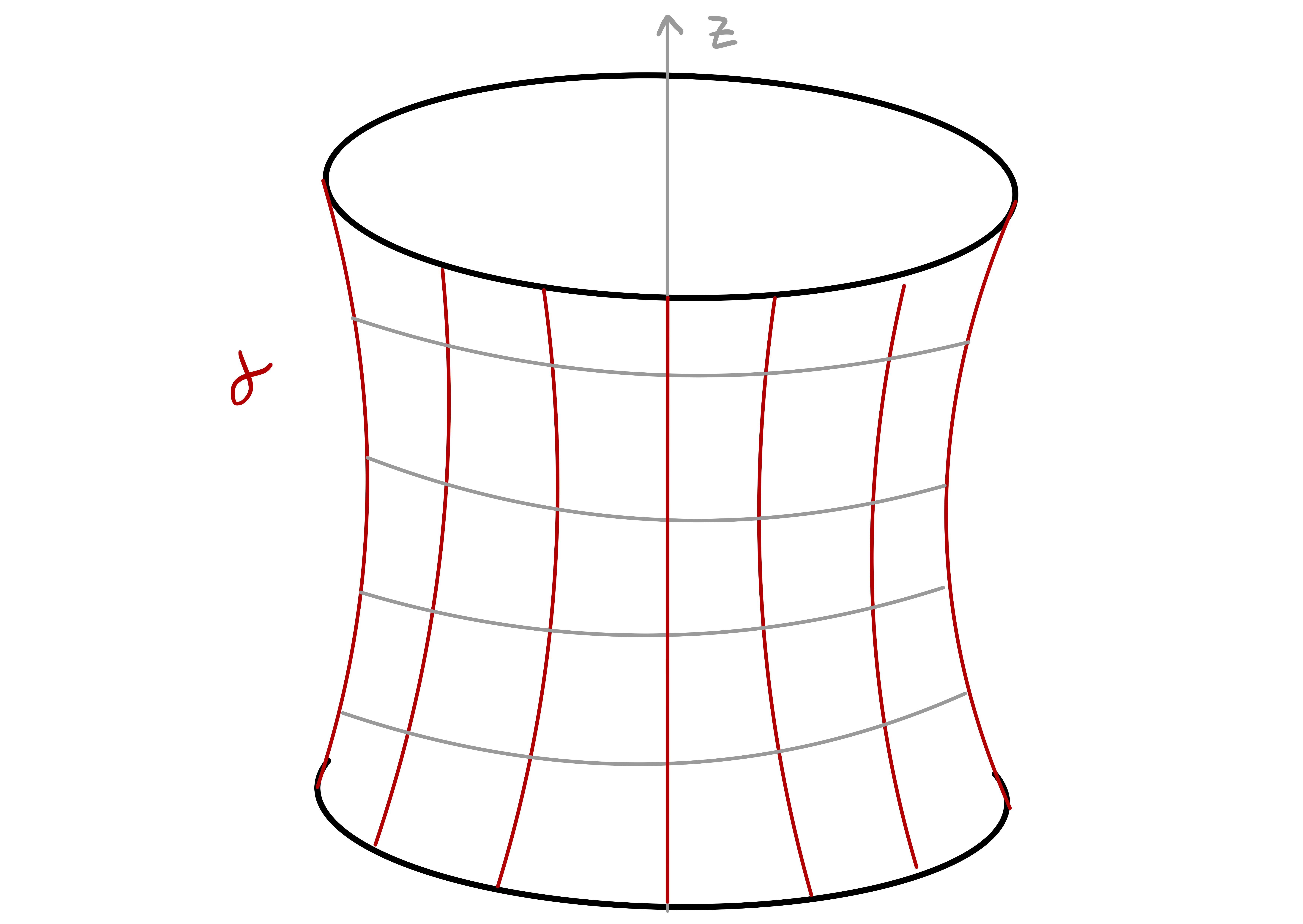
4.11 First fundamental form
In this section we introduce the first fundamental form of a surface. This will allow us to compute:
- Angle between tangent vectors
- Lengths of tangent vectors
- Area of surface regions
Let \(\mathcal{S}\) be a surface and consider two points \(\mathbf{p}, \mathbf{q} \in \mathcal{S}\). The euclidean distance between \(\mathbf{p}\) and \(\mathbf{q}\) is \[ \left\| \mathbf{p}- \mathbf{q} \right\| \,. \] However, this measures the length of the straight segment which connects \(\mathbf{p}\) to \(\mathbf{q}\), that is, the planar distance between \(\mathbf{p}\) and \(\mathbf{q}\). We are interested in measuring the distance of \(\mathbf{p}\) and \(\mathbf{q}\) on \(\mathcal{S}\). A way to measure such distance is the following: Suppose \[ {\pmb{\gamma}}\colon (a,b) \to \mathcal{S} \] is a smooth curve such that \[ {\pmb{\gamma}}(a) = \mathbf{p}\,, \quad {\pmb{\gamma}}(b) = \mathbf{q} \,. \] The distance between \(\mathbf{p}\) and \(\mathbf{q}\) on \(\mathcal{S}\) could be defined as the length of \({\pmb{\gamma}}\), i.e., \[ \int_{a}^{b} \left\| \dot{{\pmb{\gamma}}}(t) \right\| \, dt \,. \] Since \({\pmb{\gamma}}(t) \in \mathcal{S}\), by definition of tangent plane, we have \[ \dot{{\pmb{\gamma}}}(t) \in T_{\mathbf{p}} S \,, \quad \mathbf{p}:= {\pmb{\gamma}}(t) \,. \] Therefore, computing \(\left\| \dot{{\pmb{\gamma}}}(t) \right\|\) is equivalent to computing the length of tangent vectors to \(\mathcal{S}\). This motivates the definition of first fundamental form.
Definition 123: First fundamental form (FFF)
Three observations:
The first fundamental form of \(\mathcal{S}\) at \(\mathbf{p}\) is the map obtained by restricting the scalar product of \(\mathbb{R}^3\) to \(T_{\mathbf{p}} \mathcal{S}\).
Note that \[ I_{\mathbf{p}} (\mathbf{v},\mathbf{v}) = \| \mathbf{v}\|^2 \,, \] so that \(I_{\mathbf{p}}\) can be used to compute the length of tangent vectors.
The definition of \(I_{\mathbf{p}}\) does not depend on a chosen chart, since \(T_{\mathbf{p}}\mathcal{S}\) can be defined without using charts.
To use the first fundamental form in practice, we need to express \(I_{\mathbf{p}}\) in terms of local charts. To this end, we first define:
- The coordinates functions \(du\) and \(dv\) on \(T_{\mathbf{p}} \mathcal{S}\),
- The first fundamental form of a chart.
Definition 124: Coordinate functions on tangent plane
Definition 125: FFF of a chart
We usually omit the dependence on \(\mathbf{v}\) in (?eq-fff-chart), and just write \[ \mathscr{F}_1 = E \, du^2 + 2F \, du \, dv + G \, dv^2 \,. \] We are now ready to write \(I_{\mathbf{p}}\) with respect to the basis \(\{{\pmb{\sigma}}_u,{\pmb{\sigma}}_v\}\) of \(T_{\mathbf{p}} \mathcal{S}\).
Theorem 126: Matrix of FFF
Proof
Remark 127: Linear algebra interpretation
Notation
Example 128: FFF of Unit cylinder
Solution. We have \[\begin{align*} & {\pmb{\sigma}}_u = (-\sin(u),\cos(u), 0 ) & \, & F = {\pmb{\sigma}}_u \cdot {\pmb{\sigma}}_v = 0 \\ & {\pmb{\sigma}}_v = (0,0,1) & \, & G = {\pmb{\sigma}}_v \cdot {\pmb{\sigma}}_v = 1 \\ & E = {\pmb{\sigma}}_u \cdot {\pmb{\sigma}}_u = 1 & \, & \mathscr{F}_1 = du^2 + dv^2 \end{align*}\]
Warning
Proposition 129: FFF and reparametrizations
Let \({\pmb{\sigma}}\colon U \to \mathbb{R}^3\) be regular, and \(\widetilde{{\pmb{\sigma}}} \colon \widetilde{U} \to \mathbb{R}^3\) a reparametrization, with \(\widetilde{{\pmb{\sigma}}} = {\pmb{\sigma}}\circ \Phi\) and \(\Phi \colon \widetilde{U} \to U\) diffeomorphism.
The matrices \(\mathscr{F}_1\) and \(\widetilde{\mathscr{F}}_1\) of the FFF of \({\pmb{\sigma}}\) and \(\widetilde{{\pmb{\sigma}}}\) are related by \[ {\widetilde{\mathscr{F}}}_1 = (J \Phi)^T \, \mathscr{F}_1 \, J \Phi \,, \quad \mathscr{F}_1 = \left( \begin{array}{cc} E & F \\ F & G \end{array} \right) \,, \quad \widetilde{\mathscr{F}}_1 = \left( \begin{array}{cc} \widetilde{E} & \widetilde{F} \\ \widetilde{F} & \widetilde{G} \end{array} \right) \,. \]
The linear maps \(du, dv\) and \(d\tilde{u}, d\tilde{v}\) are related by \[ \begin{aligned} du & = \frac{\partial u}{\partial \tilde{u}} \, d\tilde{u} + \frac{\partial u}{\partial \tilde{v}} \, d\tilde{v} \\ dv & = \frac{\partial v}{\partial \tilde{u}} \, d\tilde{u} + \frac{\partial v}{\partial \tilde{v}} \, d\tilde{v} \end{aligned} \]
Proof
Example 130: FFF of Plane
Question. Let \(\mathbf{a}, \mathbf{p}, \mathbf{q} \in \mathbb{R}^3\), with \(\mathbf{p}\), \(\mathbf{q}\) orthonormal. The plane in cartesian and polar coordinates is charted by, respectively, \[\begin{align*} & {\pmb{\sigma}}(u,v) = \mathbf{a} + u \mathbf{p}+ v \mathbf{q} \,, \quad (u,v) \in \mathbb{R}^2 \,, \\ & \widetilde{{\pmb{\sigma}}}(\rho,\theta) = \mathbf{a} + \rho \cos(\theta) \mathbf{p}+ \rho \sin(\theta) \mathbf{q} \,, \quad \rho>0 , \, \theta \in (0,2\pi) \,. \end{align*}\]
Show that the FFF of \({\pmb{\sigma}}\) and \(\widetilde{{\pmb{\sigma}}}\) are \[ \mathscr{F}_1 = du^2 + dv^2 \,, \qquad {\widetilde{\mathscr{F}}}_1 = d\rho^2 + \rho^2 d\theta^2 \,. \]
Let \(\Phi\) be the change of variables from polar to cartesian coordinates. Show that \[ {\widetilde{\mathscr{F}}}_1 = (J \Phi)^T \, {\mathscr{F}}_1 \, J \Phi \,. \]
Solution.
Using that \(\mathbf{p}\) and \(\mathbf{q}\) are orthonormal, \[\begin{align*} & {\pmb{\sigma}}_u = \mathbf{p}\,, && \widetilde{{\pmb{\sigma}}}_{\rho} = \cos(\theta)\mathbf{p}+ \sin(\theta) \mathbf{q} \\ & {\pmb{\sigma}}_v = \mathbf{q} & \, & \widetilde{{\pmb{\sigma}}}_{\theta} = - \rho \sin(\theta) \mathbf{p}+ \rho \cos(\theta) \mathbf{q} \\ & E = {\pmb{\sigma}}_u \cdot {\pmb{\sigma}}_u = 1 & \, & \widetilde{E}= \widetilde{{\pmb{\sigma}}}_{\rho} \cdot \widetilde{{\pmb{\sigma}}}_{\rho} = 1 \\ & F = {\pmb{\sigma}}_u \cdot {\pmb{\sigma}}_v = 0 & \, & \widetilde{F}= \widetilde{{\pmb{\sigma}}}_{\rho} \cdot \widetilde{{\pmb{\sigma}}}_{\theta} = 0 \\ & G = {\pmb{\sigma}}_v \cdot {\pmb{\sigma}}_v = 1 & \, & \widetilde{G}= \widetilde{{\pmb{\sigma}}}_{\theta} \cdot \widetilde{{\pmb{\sigma}}}_{\theta} = r^2 \\ & \mathscr{F}_1 = du^2 + dv^2 & \, & {\widetilde{\mathscr{F}}}_1 = d{\rho}^2 + {\rho}^2 d\theta^2 \end{align*}\]
We have \(\Phi({\rho},\theta) = ( {\rho} \cos(\theta), {\rho} \sin (\theta) )\). Then \[\begin{align*} (J \Phi)^T & \, \mathscr{F}_1 J \Phi = (J \Phi)^T \, J \Phi \\ & = \left( \begin{array}{cc} \cos(\theta) & \sin(\theta) \\ -\rho \sin(\theta) & \rho \cos(\theta) \end{array} \right) \left( \begin{array}{cc} \cos(\theta) & - \rho \sin(\theta) \\ \sin(\theta) & \rho \cos(\theta) \end{array} \right) \\ &= \left( \begin{array}{cc} 1 & 0 \\ 0 & \rho^2 \end{array} \right) = \widetilde{\mathscr{F}}_1 \,. \end{align*}\]
Remark 131
Remark 132
Example 133
Solution. We compute \[ \begin{aligned} & {{\pmb{\sigma}}}_{u}=(1,1,2 u) & \,& F ={{\pmb{\sigma}}}_{u}\cdot {{\pmb{\sigma}}}_{v}= 4 u v \\ & {{\pmb{\sigma}}}_{v}=(-1,1,2 v) &\,& G = {{\pmb{\sigma}}}_{v}\cdot {{\pmb{\sigma}}}_{v}= 2\left(1+2 v^{2}\right) \\ & E = {{\pmb{\sigma}}}_{u}\cdot {{\pmb{\sigma}}}_{v}= 2\left(1+2 u^{2}\right) &\,& \mathscr{F}_{1} = 2\left(\begin{array}{cc} 1+2 u^{2} & 2 u v \\ 2 u v & 1+2 v^{2} \end{array}\right) \,. \end{aligned} \]
4.11.1 Length of curves
The first fundamental form allows to compute the length of curves with values on surfaces.
Proposition 134: Length of curves and FFF
Proof
Example 135: Curves on the Cone
Question. Consider the cone with chart \[ {\pmb{\sigma}}(u,v)=(\cos(u) v, \sin (u) v, v) \,, \quad u \in (0,2\pi),\, v > 0 \,. \]
Compute the first fundamental form of \({\pmb{\sigma}}\).
Compute the length of \({\pmb{\gamma}}(t)= {\pmb{\sigma}}(t,t)\) for \(t \in (\pi/2,\pi)\).
Solution.
The first fundamental form of \({\pmb{\sigma}}\) is \[\begin{align*} & {\pmb{\sigma}}_u = (- \sin(u)v, \cos(u)v,0) &\,& F = {\pmb{\sigma}}_u \cdot {\pmb{\sigma}}_v = 0 \\ & {\pmb{\sigma}}_v = (\cos(u), \sin (u), 1) &\,& G = {\pmb{\sigma}}_v \cdot {\pmb{\sigma}}_v = 2 \\ & E = {\pmb{\sigma}}_u \cdot {\pmb{\sigma}}_u = v^2 & \, & \mathscr{F}_1 = v^2 \, du^2 + 2 \, dv^2 \end{align*}\]
\({\pmb{\gamma}}(t) = {\pmb{\sigma}}(u(t),v(t))\) with \(u(t) = t\) and \(v(t) = t\). Then \[\begin{align*} & \dot u = 1\,, \,\, \dot v = 1 & & F(u(t),v(t)) = F(t,t) = 0 \\ & E(u(t),v(t)) = E(t,t) = t^2 & & G(u(t),v(t)) = G(t,t) = 2 \end{align*}\] The length of \({\pmb{\gamma}}\) between \(\pi/2\) and \(\pi\) is \[ \int_{\pi/2}^{\pi} \left\| \dot{{\pmb{\gamma}}}(t) \right\| \, dt = \int_{\pi/2}^{\pi} \sqrt{ t^2 + 2 } \, dt \,. \]
4.11.2 Isometries
Isometries are an important class of maps between surfaces: They are smooth maps which preserve the first fundamental form.
Definition 136: Local Isometry and Isometry
Let \(\mathcal{S}\) and \(\widetilde{\mathcal{S}}\) be regular and \(f \colon \mathcal{S}\to \widetilde{\mathcal{S}}\) smooth. We say that:
\(f\) is a local isometry, if for all \(\mathbf{p}\in \mathcal{S}\) \[ \mathbf{v}\cdot \mathbf{w}= d_{\mathbf{p}}f (\mathbf{v}) \cdot d_{\mathbf{p}}f (\mathbf{w}) \,, \quad \forall \, \mathbf{v}, \mathbf{w}\in T_{\mathbf{p}} \mathcal{S}\,. \] In this case, \(\mathcal{S}\) and \(\widetilde{\mathcal{S}}\) are said to be locally isometric.
\(f\) is an isometry if:
- \(f\) is a local isometry;
- \(f\) is a diffeomorphism of \(\mathcal{S}\) into \(\widetilde{\mathcal{S}}\).
In this case, \(\mathcal{S}\) and \(\widetilde{\mathcal{S}}\) are said to be isometric.
Recall that the first fundamental form of \(\mathcal{S}\) is defined by \[ I_{\mathbf{p}} (\mathbf{v}, \mathbf{w}) = \mathbf{v}\cdot \mathbf{w}\,, \quad \mathbf{v}, \mathbf{w}\in T_{\mathbf{p}} \mathcal{S}\,. \] Therefore, condition (?eq-loc-iso) reads \[ I_{\mathbf{p}} (\mathbf{v},\mathbf{w}) = I_{\mathbf{p}} (d_{\mathbf{p}}f(\mathbf{v}), d_{\mathbf{p}}f(\mathbf{w})) \,, \quad \forall \, \mathbf{v}, \mathbf{w}\in T_{\mathbf{p}} \mathcal{S}\,. \] In this sense, we see that local isometries preserve the first fundamental form.
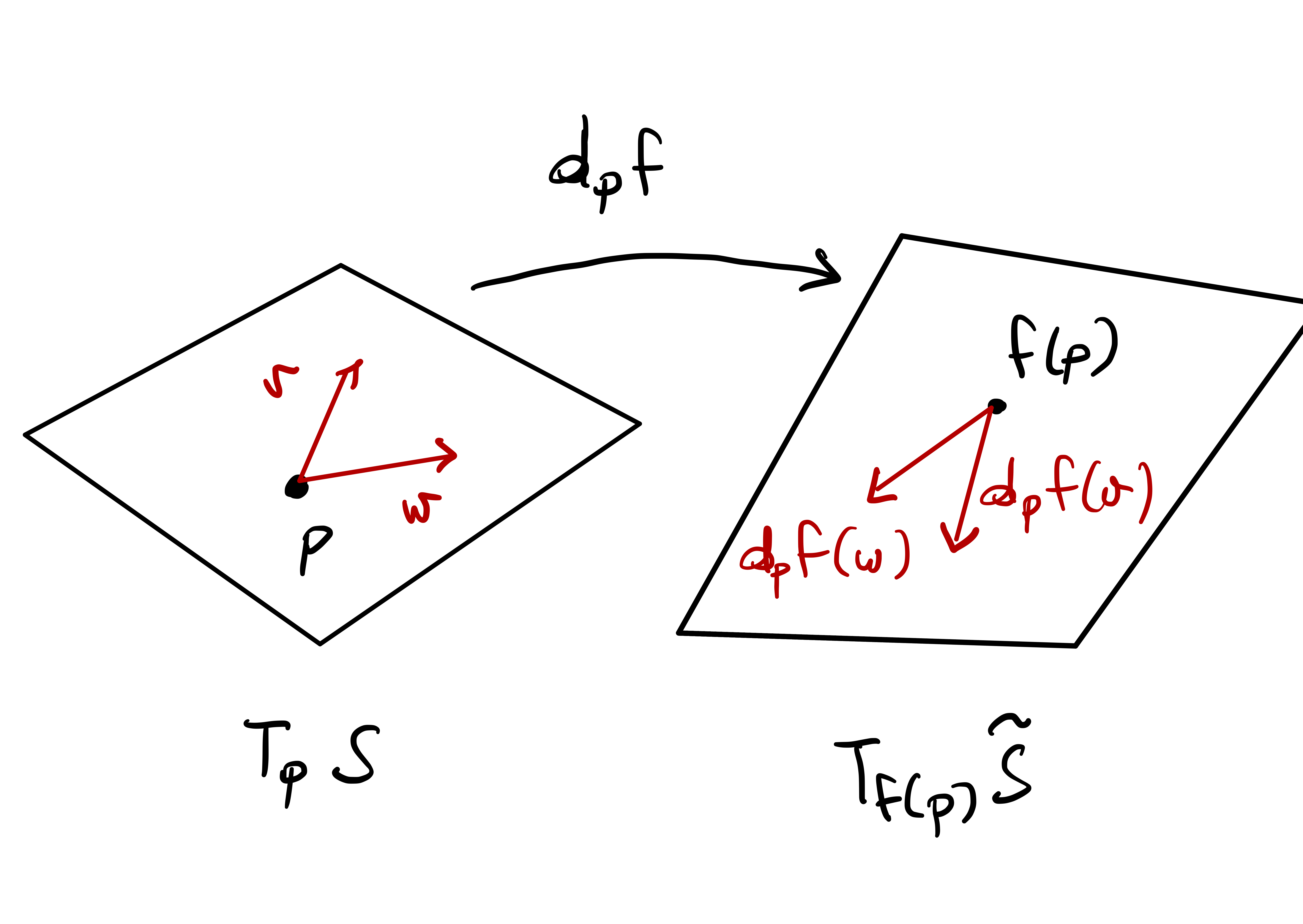
Remark 137
Proof. The thesis follows immediately from the elementary identity \[ \mathbf{v}\cdot \mathbf{w}= \frac12 \left( (\mathbf{v}+ \mathbf{w}) \cdot (\mathbf{v}+ \mathbf{w}) - \mathbf{v}\cdot \mathbf{v}- \mathbf{w}\cdot \mathbf{w}\right) \,, \] which holds for all \(\mathbf{v}, \mathbf{w}\in T_{\mathbf{p}} \mathcal{S}\) (and more in general in arbitrary vector spaces with inner product).
Local isometries are automatically local diffeomorphisms.
Proposition 138
Proof
Remark 139
- Isometries are local isometries,
- Local isometries are not isometries
This is because, in general, local diffeomorphisms are not global diffeomorphisms, see Example 25.
Local isometries preserve the length of curves, as shown in the following Proposition.
Theorem 140: Local isometries preserve lengths
Let \(\mathcal{S}, \widetilde{\mathcal{S}}\) be regular surfaces, \(f \colon \mathcal{S}\to \widetilde{\mathcal{S}}\) smooth. Equivalently:
- \(f\) is a local isometry.
- Let \({\pmb{\gamma}}\) be a curve on \(\mathcal{S}\) and define the curve \(\widetilde{{\pmb{\gamma}}}= f \circ {\pmb{\gamma}}\) on \(\widetilde{\mathcal{S}}\). Then \({\pmb{\gamma}}\) and \(\widetilde{{\pmb{\gamma}}}\) have the same length.
Proof
Part 2. We need to prove that \(f\) is a local isometry. By Remark 137, it is sufficient to show that \[ d_{\mathbf{p}}f (\mathbf{v}) \cdot d_{\mathbf{p}}f (\mathbf{v}) = \mathbf{v}\cdot \mathbf{v}\,, \quad \forall \, \mathbf{v}\in T_{\mathbf{p}}(\mathcal{S}) \,. \tag{4.7}\] Therefore, let \(\mathbf{v}\in T_{\mathbf{p}} \mathcal{S}\) be arbitrary. By definition of tangent plane, there exists a curve \({\pmb{\gamma}}\colon (-\varepsilon,\varepsilon) \to \mathcal{S}\) such that \[ {\pmb{\gamma}}(0) = \mathbf{p}\,, \quad \dot{{\pmb{\gamma}}}(0) = \mathbf{v}\,. \] Define the curve \[ \widetilde{{\pmb{\gamma}}}\colon (-\varepsilon,\varepsilon) \to \widetilde{\mathcal{S}} \,, \qquad \widetilde{{\pmb{\gamma}}}:= f \circ {\pmb{\gamma}}\,. \] By assumption, \({\pmb{\gamma}}\) and \(\widetilde{{\pmb{\gamma}}}\) have the same length, that is, \[ \int_{-\varepsilon}^{\varepsilon} \sqrt{ \dot{\widetilde{{\pmb{\gamma}}}}(t) \cdot \dot{\widetilde{{\pmb{\gamma}}}}(t) }\, dt = \int_{-\varepsilon}^{\varepsilon} \sqrt{ \dot{{\pmb{\gamma}}}(t) \cdot \dot{{\pmb{\gamma}}}(t) }\, dt \,. \] Since the above equality is true for each \(\varepsilon>0\), and the functions being integrated are continuous, we infer \[ \dot{\widetilde{{\pmb{\gamma}}}}(0) \cdot \dot{\widetilde{{\pmb{\gamma}}}}(0) = \dot{{\pmb{\gamma}}}(0) \cdot \dot{{\pmb{\gamma}}}(0) \,. \] Recall that by definition of differential we have \[ d_{\mathbf{p}}f (\mathbf{v}) = \dot{\widetilde{{\pmb{\gamma}}}}(0) \,. \] Therefore \[\begin{align*} d_{\mathbf{p}}f (\mathbf{v}) \cdot d_{\mathbf{p}}f (\mathbf{v}) & = \dot{\widetilde{{\pmb{\gamma}}}}(0) \cdot \dot{\widetilde{{\pmb{\gamma}}}}(0) \\ & = \dot{{\pmb{\gamma}}}(0) \cdot \dot{{\pmb{\gamma}}}(0) \\ & = \mathbf{v}\cdot \mathbf{v}\,. \end{align*}\] As \(\mathbf{v}\) was arbitrary, we conclude (4.7).
By definition, local isometries preserve the first fundamental form. The next Theorem gives a practical method to check if a map is a local isometry.
Theorem 141: Local isometries preserve FFF
Let \(\mathcal{S}, \widetilde{\mathcal{S}}\) be regular surfaces, \(f \colon \mathcal{S}\to \widetilde{\mathcal{S}}\) smooth. Equivalently:
- \(f\) is a local isometry.
- Let \({\pmb{\sigma}}\colon U \to \mathcal{S}\) be regular chart of \(\mathcal{S}\), and define a chart of \(\widetilde{\mathcal{S}}\) as \(\widetilde{{\pmb{\sigma}}} \colon U \to \widetilde{\mathcal{S}}\), with \(\widetilde{{\pmb{\sigma}}} = f \circ {\pmb{\sigma}}\). Then \({\pmb{\sigma}}\) and \(\widetilde{{\pmb{\sigma}}}\) have the same FFF \[ E = \widetilde{E} \,, \quad F = \widetilde{F} \,, \quad G = \widetilde{G} \,. \]
Note: \(E,F,G\) and \(\widetilde{E},\widetilde{F},\widetilde{G}\) are defined on the same set \(U\). Therefore, equality is intended pointwise.
Proof
Part 2. Define \(\widetilde{{\pmb{\sigma}}} = f \circ {\pmb{\sigma}}\) and suppose that \({\pmb{\sigma}}\) and \(\widetilde{{\pmb{\sigma}}}\) have the same first fundamental form. In particular they hold \[\begin{align*} {\pmb{\sigma}}_u \cdot {\pmb{\sigma}}_u & = \widetilde{{\pmb{\sigma}}}_u \cdot \widetilde{{\pmb{\sigma}}}_u \\ {\pmb{\sigma}}_u \cdot {\pmb{\sigma}}_v & = \widetilde{{\pmb{\sigma}}}_u \cdot \widetilde{{\pmb{\sigma}}}_v \\ {\pmb{\sigma}}_v \cdot {\pmb{\sigma}}_v & = \widetilde{{\pmb{\sigma}}}_v \cdot \widetilde{{\pmb{\sigma}}}_v \end{align*}\] As discussed above, since \(\widetilde{{\pmb{\sigma}}} = f \circ {\pmb{\sigma}}\), by Theorem 102 we get \[ d_{\mathbf{p}} f({\pmb{\sigma}}_u) = \widetilde{{\pmb{\sigma}}}_u \,, \quad d_{\mathbf{p}} f({\pmb{\sigma}}_v) = \widetilde{{\pmb{\sigma}}}_v \,. \] Let \(\mathbf{v}\in T_{\mathbf{p}} \mathcal{S}\). Since \(\{{\pmb{\sigma}}_u,{\pmb{\sigma}}_v\}\) is a basis for \(T_{\mathbf{p}} \mathcal{S}\), we get \[ \mathbf{v}= \lambda {\pmb{\sigma}}_u + \mu {\pmb{\sigma}}_v \] for some \(\lambda,\mu \in \mathbb{R}\). Therefore \[\begin{align*} d_{\mathbf{p}} f (\mathbf{v}) & = d_{\mathbf{p}} f(\lambda {\pmb{\sigma}}_u + \mu {\pmb{\sigma}}_v ) \\ & = \lambda \, d_{\mathbf{p}} f ({\pmb{\sigma}}_u) + \mu \, d_{\mathbf{p}} f ({\pmb{\sigma}}_v)\\ & = \lambda \widetilde{{\pmb{\sigma}}}_u + \mu \widetilde{{\pmb{\sigma}}}_v \,. \end{align*}\] Hence \[\begin{align*} \mathbf{v}\cdot \mathbf{v}& = ( \lambda {\pmb{\sigma}}_u + \mu {\pmb{\sigma}}_v ) \cdot (\lambda {\pmb{\sigma}}_u + \mu {\pmb{\sigma}}_v) \\ & = \lambda^2 ({\pmb{\sigma}}_u \cdot {\pmb{\sigma}}_u) + 2 \lambda\mu ({\pmb{\sigma}}_u \cdot {\pmb{\sigma}}_v) + \mu^2 ({\pmb{\sigma}}_v \cdot {\pmb{\sigma}}_v) \\ & = \lambda^2 ( \widetilde{{\pmb{\sigma}}}_u \cdot \widetilde{{\pmb{\sigma}}}_u) + 2\lambda \mu ( \widetilde{{\pmb{\sigma}}}_u \cdot \widetilde{{\pmb{\sigma}}}_v) + \mu^2 ( \widetilde{{\pmb{\sigma}}}_v \cdot \widetilde{{\pmb{\sigma}}}_v) \\ & = (\lambda \widetilde{{\pmb{\sigma}}}_u + \mu \widetilde{{\pmb{\sigma}}}_v) \cdot (\lambda \widetilde{{\pmb{\sigma}}}_u + \mu \widetilde{{\pmb{\sigma}}}_v) \\ & = d_{\mathbf{p}} f (\mathbf{v}) \cdot d_{\mathbf{p}} f (\mathbf{v}) \,, \end{align*}\] showing that \[ \mathbf{v}\cdot \mathbf{v}= d_{\mathbf{p}} f (\mathbf{v}) \cdot d_{\mathbf{p}} f (\mathbf{v}) \,, \quad \forall \, \mathbf{v}\in T_{\mathbf{p}} \mathcal{S}\,. \] By Remark 137 we conclude that \(f\) is a local isometry.
Remark 142
To see this, suppose we can verify Condition 2 on the chart \({\pmb{\sigma}}\colon U \to \mathcal{S}\), that is, suppose we have proven \[ \widetilde{\mathscr{F}}_1 = \mathscr{F}_1 \,, \tag{4.8}\] where \(\widetilde{\mathscr{F}}_1\) is the first fundamental form of \(\widetilde{{\pmb{\sigma}}} = f \circ {\pmb{\sigma}}\). Assume that \(\hat{{\pmb{\sigma}}} \colon \hat{U} \to \mathcal{S}\) is another chart of \(\mathcal{S}\). By Remark 129, the fundamental forms of \(\hat{{\pmb{\sigma}}}\) and \({\pmb{\sigma}}\) are related by \[ \hat{\mathscr{F}}_1 = (J\Phi)^T \mathscr{F}_1 J\Phi \tag{4.9}\] where \(\Phi\) is the transition map \(\Phi \colon \hat{U} \to U\) such that \[ \hat{{\pmb{\sigma}}} = {\pmb{\sigma}}\circ \Phi \,. \] Applying \(f\) to \(\hat{{\pmb{\sigma}}}\) gives \[ {\pmb{\sigma}}^{\dagger} := f \circ \hat{{\pmb{\sigma}}} = f \circ {\pmb{\sigma}}\circ \Phi = \widetilde{{\pmb{\sigma}}} \circ \Phi \,, \] showing that \({\pmb{\sigma}}^{\dagger}\) is a reparametrization of \(\widetilde{{\pmb{\sigma}}}\) with transition map \(\Phi\). Therefore, by Proposition 129, the fundamental forms of \({\pmb{\sigma}}^{\dagger}\) and \(\widetilde{{\pmb{\sigma}}}\) are related by \[ \mathscr{F}^\dagger_1 = (J\Phi)^T \widetilde{\mathscr{F}}_1 J\Phi \] Recalling (4.8) and (4.9), we get \[\begin{align*} \mathscr{F}^\dagger_1 & = (J\Phi)^T \widetilde{\mathscr{F}}_1 J\Phi \\ & = (J\Phi)^T \mathscr{F}_1 J\Phi \\ & = \hat{\mathscr{F}}_1 \,. \end{align*}\] We have therefore proven that \(\hat{{\pmb{\sigma}}}\) and \({\pmb{\sigma}}^\dagger = f \circ \hat{{\pmb{\sigma}}}\) have the same first fundamental form. Thus \(\hat{{\pmb{\sigma}}}\) satisfies Condition 2 in Theorem 141.
Sometimes, we wish to determine if two surfaces \(\mathcal{S}\) and \(\widetilde{\mathcal{S}}\) are locally isometric, but it is not clear how to construct a map \[ f \colon \mathcal{S}\to \widetilde{\mathcal{S}}\,. \] As an alternative, we can shift the problem of finding \(f\), to the problem of finding suitable charts \({\pmb{\sigma}}\) of \(\mathcal{S}\), and \(\widetilde{{\pmb{\sigma}}}\) of \(\widetilde{\mathcal{S}}\), such that \({\pmb{\sigma}}\) and \(\widetilde{{\pmb{\sigma}}}\) have the same first fundamntal form. This is detailed in the next Theorem.
Theorem 143: Sufficient condition for local isometry
Let \(\mathcal{S}, \widetilde{\mathcal{S}}\) be regular surfaces, with charts \({\pmb{\sigma}}\colon U \to \mathcal{S}\) and \(\widetilde{{\pmb{\sigma}}}\colon U \to \widetilde{\mathcal{S}}\). Assume that \({\pmb{\sigma}}\) and \(\widetilde{{\pmb{\sigma}}}\) have the same FFF. We have
- The surfaces \({\pmb{\sigma}}(U)\) and \(\widetilde{\mathcal{S}}\) are locally isometric.
- A local isometry is given by \[ f \colon {\pmb{\sigma}}(U) \to \widetilde{\mathcal{S}}\,, \qquad f = \widetilde{{\pmb{\sigma}}}\circ {\pmb{\sigma}}^{-1} \,. \]
Note: \({\pmb{\sigma}}\) and \(\widetilde{{\pmb{\sigma}}}\) are defined on the same open set \(U\). Therefore, \(E,F,G\) and \(\widetilde{E},\widetilde{F},\widetilde{G}\) are defined on \(U\), and the equality is intended pointwise.
Proof
Example 144: Plane and Cylinder are locally isometric
Solution. The plane \(\mathcal{S}\) is charted by \[ {\pmb{\sigma}}(u,v) = (0,u,v) \,, \quad u,v \in \mathbb{R}\,. \] We already know that \({\pmb{\sigma}}\) is regular, with FFF coefficients \[ E = 1 \,, \,\, F = 0 \,, \,\, G = 1 \quad \implies \quad \mathscr{F}_1 = du^2 + dv^2 \,. \] Define \(\widetilde{{\pmb{\sigma}}}= f \circ {\pmb{\sigma}}\). Therefore, \[ \widetilde{{\pmb{\sigma}}}(u,v) = f(0,u,v) = (\cos(u),\sin(u),v) \,. \] The FFF of \(\widetilde{{\pmb{\sigma}}}\) is \[\begin{align*} & {\widetilde{{\pmb{\sigma}}}}_{u}= ( -\sin(u),\cos(u),0 ) & \, & \widetilde{F}= {\widetilde{{\pmb{\sigma}}}}_{u}\cdot {\widetilde{{\pmb{\sigma}}}}_{v}= 0 \\ & {\widetilde{{\pmb{\sigma}}}}_{v}= (0,0,1) & \, & \widetilde{G}= {\widetilde{{\pmb{\sigma}}}}_{v}\cdot {\widetilde{{\pmb{\sigma}}}}_{v}= 1\\ & \widetilde{E}= {\widetilde{{\pmb{\sigma}}}}_{u}\cdot {\widetilde{{\pmb{\sigma}}}}_{u}= 1 & \, & \widetilde{\mathscr{F}}_1 = du^2 + dv^2 \end{align*}\] Thus, \({\pmb{\sigma}}\) and \(\widetilde{{\pmb{\sigma}}}\) have the same FFF. Since \(\mathcal{A} = \{{\pmb{\sigma}}\}\) is an atlas for \(\mathcal{S}\), by Theorem 143 we conclude that \(f\) is a local isometry of \(\mathcal{S}\) into \(\widetilde{\mathcal{S}}\).
Example 145: Plane and Cylinder are not isometric
Consider again the plane \[ \mathcal{S}= \{ (x,y,z) \in \mathbb{R}^3 \, \colon \, x = 0 \} \,, \] and the unit cylinder \[ \widetilde{\mathcal{S}}= \{ (x,y,z) \in \mathbb{R}^3 \, \colon \, x^2 + y^2 = 1 \} \,. \] We have seen in Example 143 that \(\mathcal{S}\) and \(\widetilde{\mathcal{S}}\) are locally isometric. However, \(\mathcal{S}\) and \(\widetilde{\mathcal{S}}\) are not isometric.
Proof. The surfaces \(\mathcal{S}\) and \(\widetilde{\mathcal{S}}\) are nor homeomorphic, and therefore they cannot be isometric (and hence diffeomorphic). We cannot rigorously prove this claim with our current knowledge of topology. However, to give some intuition, here is a sketch of the argument, see Figure 4.24:
- Any simple closed curve \({\pmb{\gamma}}\) in the plane \(\mathcal{S}\) can be shrunk continuously into a point without leaving \(\mathcal{S}\). In this case we say that \(\mathcal{S}\) is simply connected.
- If \(\mathcal{S}\) and \(\widetilde{\mathcal{S}}\) were to be homeomorphic, then \(\widetilde{\mathcal{S}}\) would be simply connected.
- However, a parallel \({\pmb{\gamma}}\) of the Cylinder \(\widetilde{\mathcal{S}}\) cannot be shrunk continuously into a point without leaving the Cylinder. Thus, \(\widetilde{\mathcal{S}}\) is not simply connected.
- Hence, the Plane and the Cylinder cannot be homeomorphic.
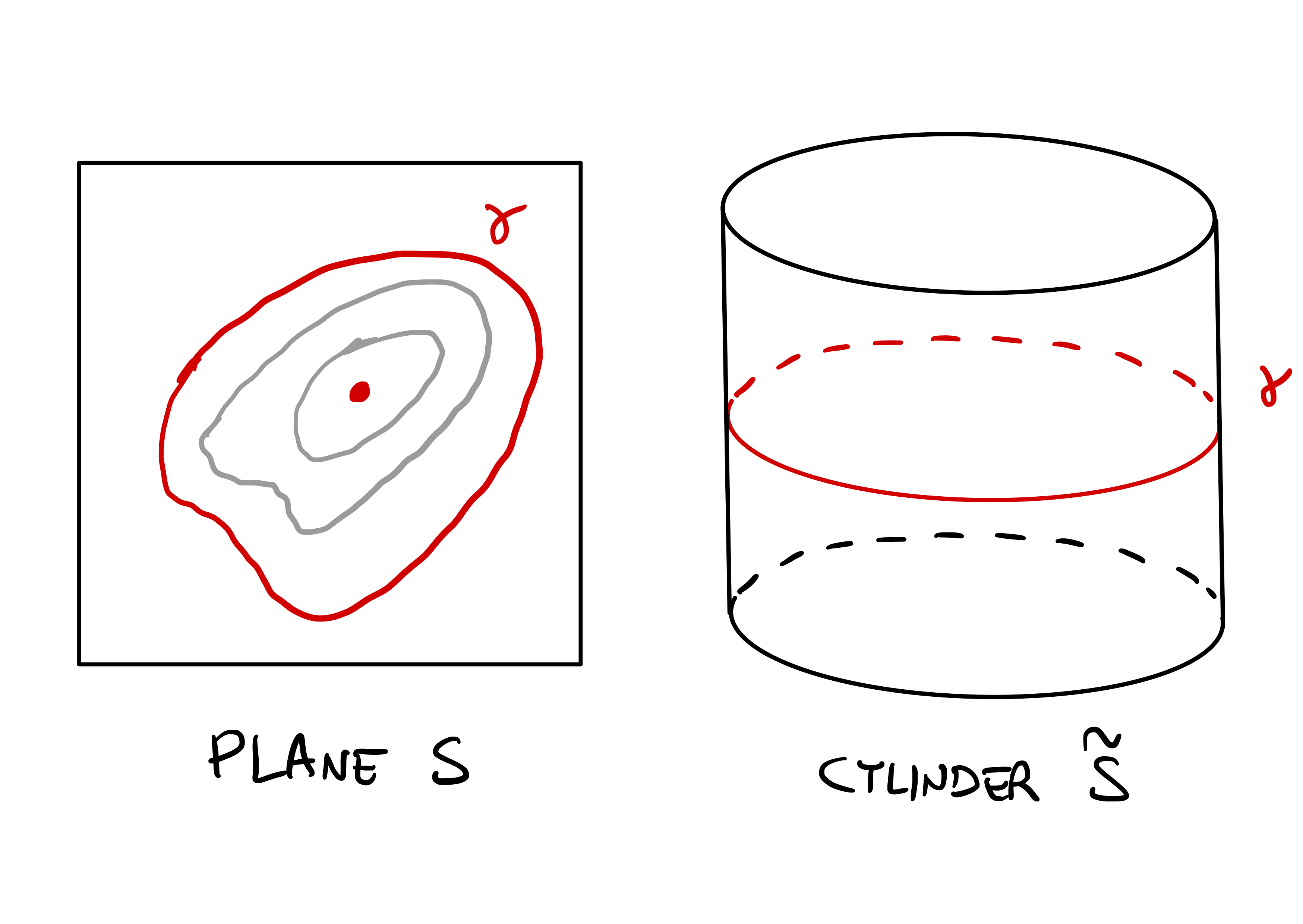
Example 146: Plane and Cone are locally isometric
Question. Consider the cone without tip \[ \mathcal{S}= \{ (x,y,z) \in \mathbb{R}^3 \, \colon \, x^2 + y^2 = z^2 \,, \,\, z > 0 \} \,, \] and the plane \(\widetilde{\mathcal{S}}= \{ z = 0 \}\).
Compute the FFF of the chart of the Cone \[\begin{align*} & {\pmb{\sigma}}\colon U \to \mathcal{S}\,, \qquad {\pmb{\sigma}}(\rho,\theta) = (\rho \cos(\theta), \rho \sin(\theta), \rho ) \,, \\ & U = \left\{ (\rho,\theta) \in \mathbb{R}^2 \, \colon \, \rho > 0 , \, \theta \in (0,2\pi) \right\} \,. \end{align*}\]
Compute the FFF of the chart of the plane \[ \widetilde{{\pmb{\sigma}}}\colon U \to \widetilde{\mathcal{S}}\,, \qquad \widetilde{{\pmb{\sigma}}}(\rho,\theta) = (a\rho \cos(b\theta), a\rho \sin(b\theta), 0 ) \,, \] where \(a>0\) and \(b \in (0,1]\) are constants.
Prove that \(f = \widetilde{{\pmb{\sigma}}}\circ {\pmb{\sigma}}^{-1}\) is a local isometry between \(\mathcal{S}\) and \(\widetilde{\mathcal{S}}\), for suitable coefficients \(a,b\).
Solution.
As seen in Example 138, the coefficients of the FFF of \({\pmb{\sigma}}\) are \[ E = 2 \,, \qquad F = 0 \,, \qquad G = \rho^2 \,. \]
Note that \(\widetilde{{\pmb{\sigma}}}\) is well defined for all \((\rho,\theta) \in U\), as \[ \theta \in (0,2\pi), \quad b \in (0,1] \quad \implies \quad b \theta \in (0,2\pi) \,. \] The coefficients of the FFF of \(\widetilde{{\pmb{\sigma}}}\) are \[\begin{align*} & {\widetilde{{\pmb{\sigma}}}}_{\rho} = a \ ( \cos(b\theta), \sin(b\theta), 0 ) && \widetilde{F}= {\widetilde{{\pmb{\sigma}}}}_{\rho} \cdot {\widetilde{{\pmb{\sigma}}}}_{\theta} = 0\\ & {\widetilde{{\pmb{\sigma}}}}_{\theta} = ab \rho \ ( - \sin(b \theta), \cos(b\theta), 0 ) && \widetilde{G}= {\widetilde{{\pmb{\sigma}}}}_{\theta} \cdot {\widetilde{{\pmb{\sigma}}}}_{\theta} = a^2b^2 \rho^2 \\ & \widetilde{E}= {\widetilde{{\pmb{\sigma}}}}_{\rho} \cdot {\widetilde{{\pmb{\sigma}}}}_{\rho} = a^2 \end{align*}\]
Imposing that \(\widetilde{E}= E\), \(\widetilde{F}= F\) and \(\widetilde{G}= G\), we obtain \[ a^2 = 2 , \,\, a^2b^2 = 1 \quad \implies \quad a = \sqrt{2} \,, \,\, b = \frac{1}{\sqrt{2}} \,. \] Note that \(a>0\) and \(0<b<1\), showing that \(a,b\) are admissible. Hence, for \(a = \sqrt{2}\) and \(b = 1/\sqrt{2}\), the charts \({\pmb{\sigma}}\) and \(\widetilde{{\pmb{\sigma}}}\) have the same FFF. By Theorem 141, we conclude that \(\mathcal{S}\) and \(\widetilde{\mathcal{S}}\) are locally isometric, with local isometry given by \(f = \widetilde{{\pmb{\sigma}}}\circ {\pmb{\sigma}}^{-1}\).
4.11.3 Angles on surfaces
We want to define the notion of angle between tangent vectors.
Definition 147: Angle between tangent vectors
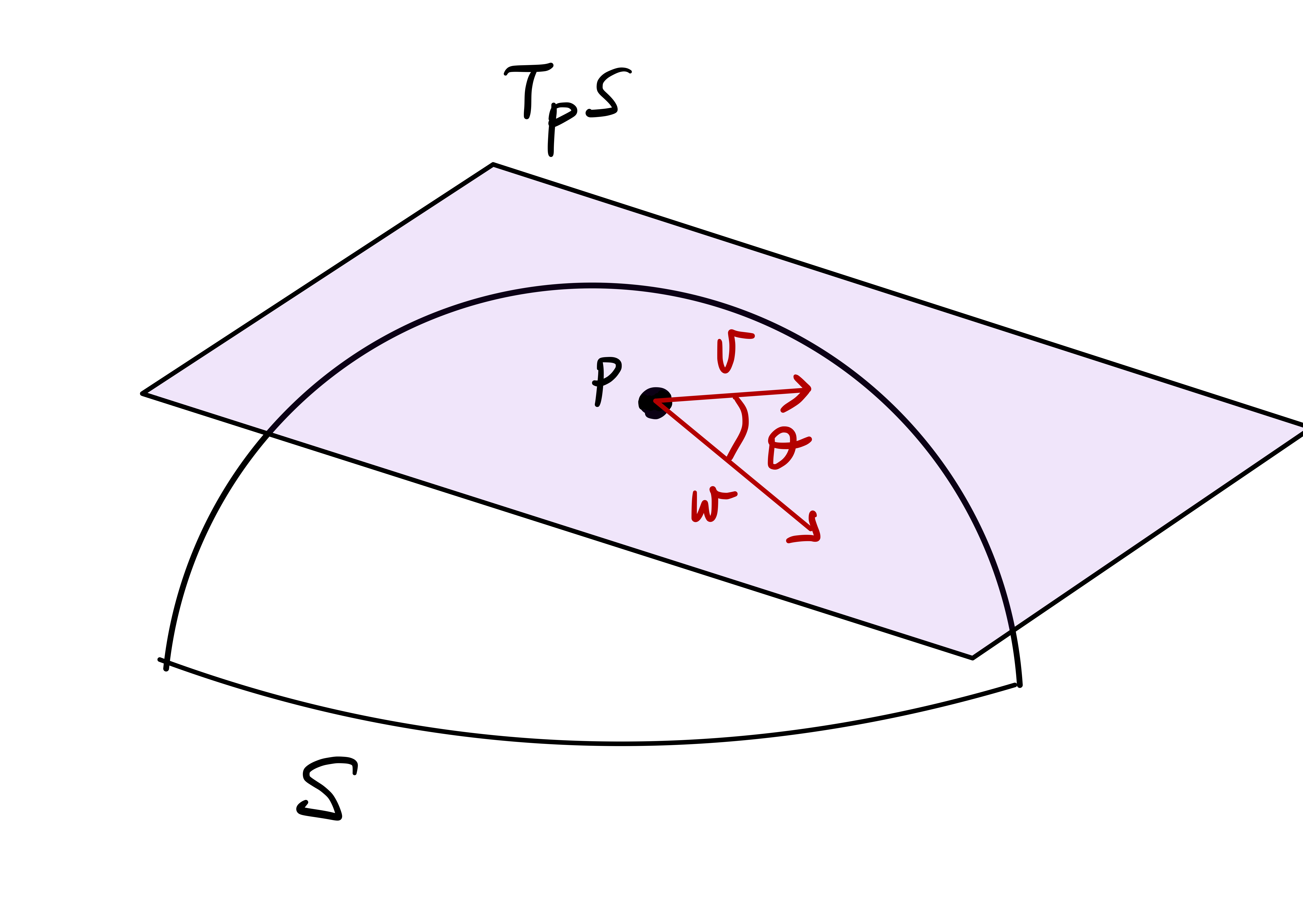
The angle between tangent vectors can be computed in terms of local charts.
Proposition 148
Proof
4.11.4 Angles between curves
Since tangent vectors are derivatives of curves with values in \(\mathcal{S}\), it also makes sense to define the angle between two intersecting curves.
Definition 149: Angle between curves
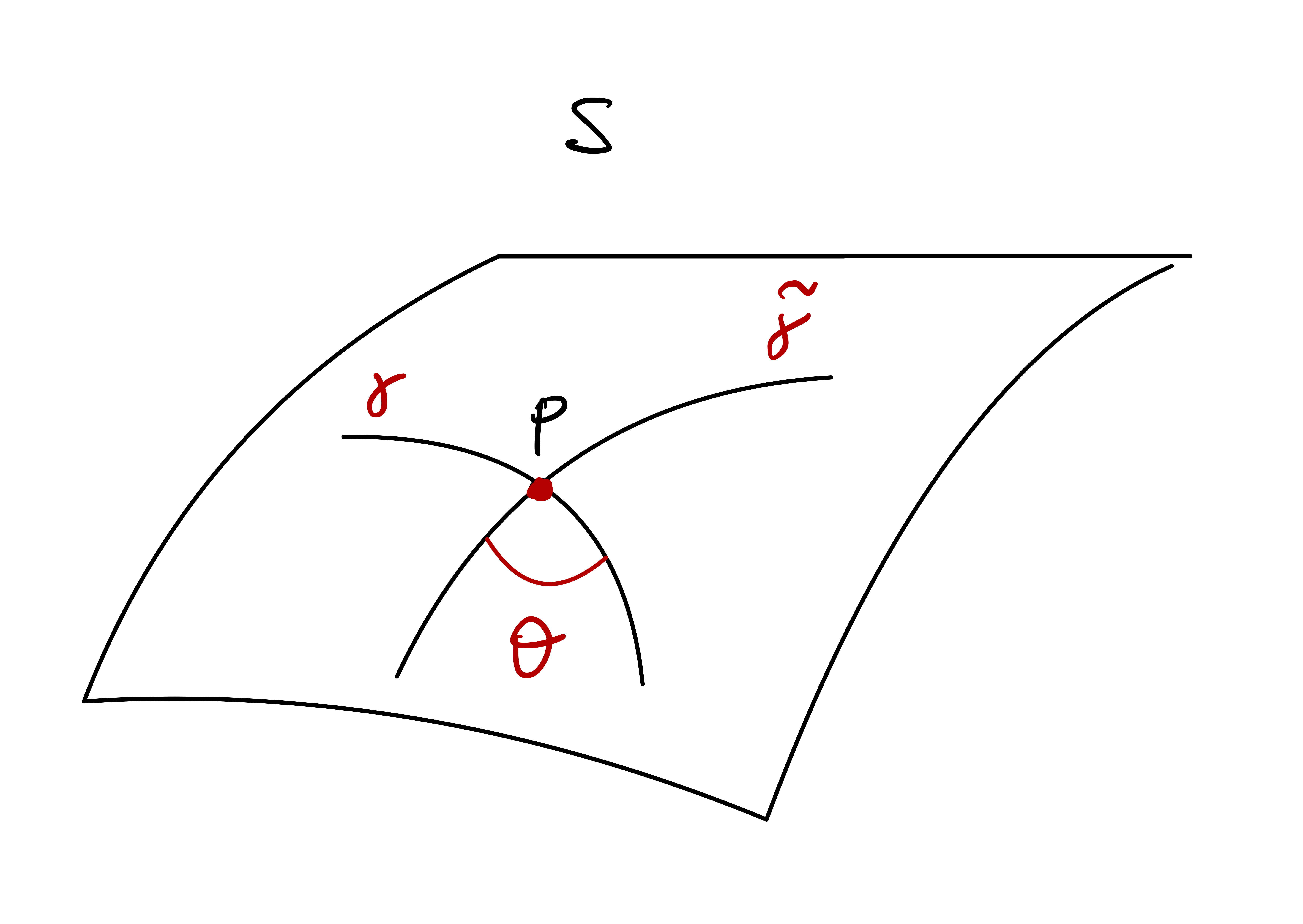
Theorem 150: Angle between curves and FFF
Proof
Example 151: Calculation of angle between curves
Question. Let \(S\) be a surface charted by \[ {\pmb{\sigma}}(u, v) = \left(u, v, e^{u v}\right) \,. \]
- Calculate the FFF of \({\pmb{\sigma}}\).
- Calculate \(\cos (\theta)\), where \(\theta\) is the angle between the two curves \[\begin{align*} {\pmb{\gamma}}(t) & ={\pmb{\sigma}}(u(t), v(t)), \quad u(t)=t,\, v(t)=t \,, \\ \widetilde{{\pmb{\gamma}}}(t) & = {\pmb{\sigma}}( \tilde{u}(t),\tilde{v}(t) ) \,, \quad \tilde{u}(t) = 1 , \, \tilde{v}(t) = t \,. \end{align*}\]
Solution.
The coefficients of the FFF are \[\begin{align*} & {\pmb{\sigma}}_u = \left(1,0, e^{u v} v\right) &\,& F(u,v) = e^{2 u v} u v \\ & {\pmb{\sigma}}_v=\left(0,1, e^{u v} u\right) & \, & G(u,v) = 1+e^{2 u v} u^2 \\ & E(u,v) =1+e^{2 u v} v^2 \end{align*}\]
\({\pmb{\gamma}}\) and \(\widetilde{{\pmb{\gamma}}}\) intersect at \({\pmb{\gamma}}(1)=\widetilde{{\pmb{\gamma}}}(1)={\pmb{\sigma}}(1,1)\). We compute \[\begin{align*} & \dot{u}(1) = 1 &\,& E(1,1) = 1+e^2 \\ & \dot{v}(1)=1 &\,& F(1,1) =e^2 \\ & \dot{\tilde{u}}(1)=0 &\,& G(1,1) =1+e^2 \\ & \dot{\tilde{v}}(1) = 1 \end{align*}\] Therefore, the angle \(\theta\) satisfies \[ \cos (\theta) =\frac{1+2 e^2}{\sqrt{2+4 e^2} \sqrt{1+e^2}}=\sqrt{\frac{1+2 e^2}{2+2 e^2}} \,. \]
4.11.5 Conformal maps
Local isometries are maps which preserve the scalar product between tangent vectors. We want to consider maps which preserve the angle between tangent vectors. These will be called conformal maps.
Definition 152: Conformal map
- \(\theta\) is the angle between \(\mathbf{v}\) and \(\mathbf{w}\),
- \(\widetilde{\theta}\) is the angle between \(d_{\mathbf{p}} f(\mathbf{v})\) and \(d_{\mathbf{p}} f(\mathbf{w})\).
In this case, we say that \(\mathcal{S}\) and \(\widetilde{\mathcal{S}}\) are conformal.
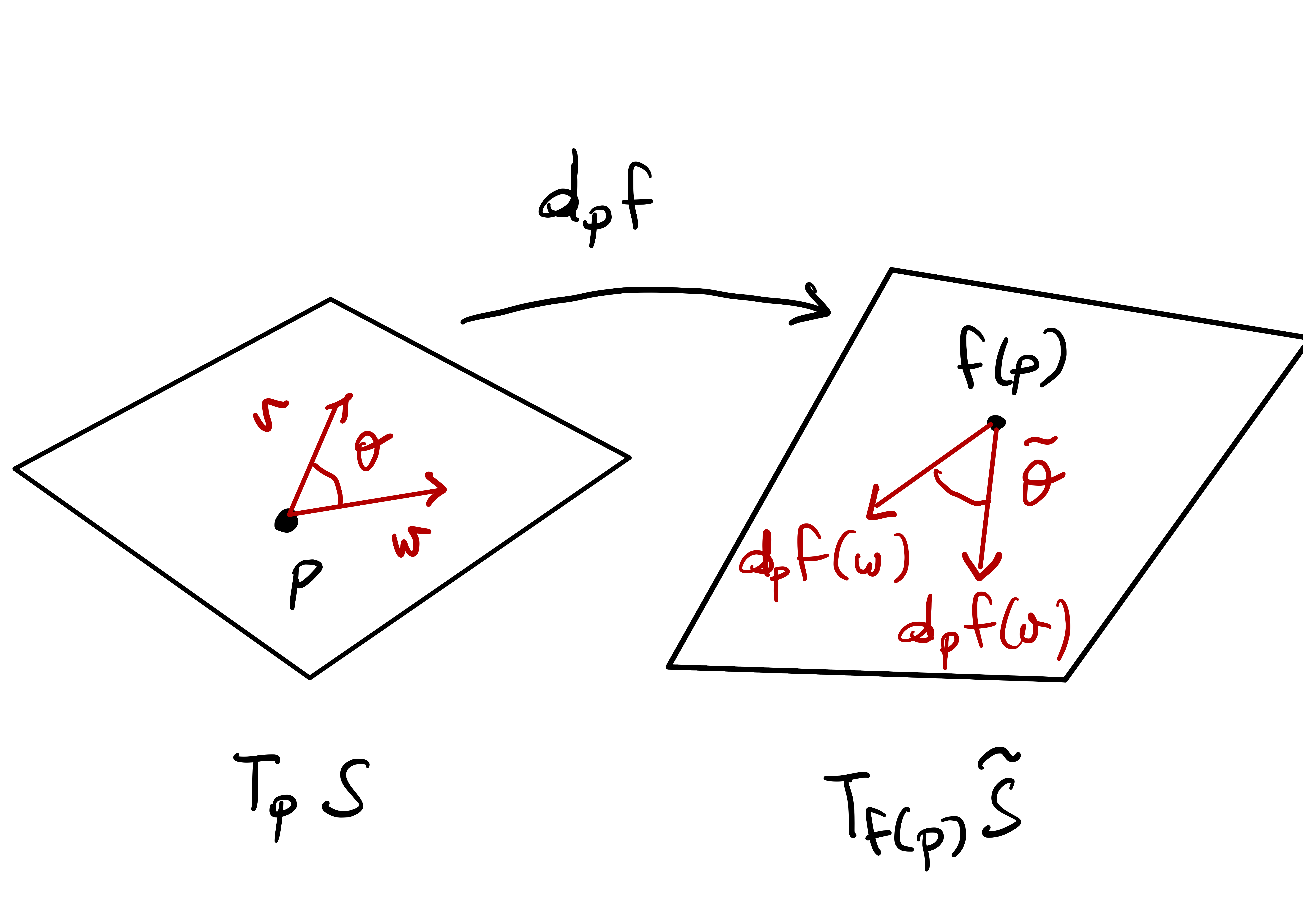
Notation
Remark 153
Proof. Follows immediately by the definition of angle between vectors.
Proposition 154
Proof
Therefore, every local isometry is a conformal map. The converse is false, as we will show in Example 158 below. Before giving the example, let us provide a characterization of conformal maps in terms of the first fundamental form.
Theorem 155
Let \(\mathcal{S}\) and \(\widetilde{\mathcal{S}}\) be regular surfaces and \(f \colon \mathcal{S}\to \widetilde{\mathcal{S}}\) a local diffeomorphism. They are equivalent:
- \(f\) is a conformal map.
- There exists a function \(\lambda \colon \mathcal{S}\to \mathbb{R}\) such that \[ \left\langle \mathbf{v},\mathbf{w} \right\rangle_f = \lambda (\mathbf{p}) \, \left\langle \mathbf{v},\mathbf{w} \right\rangle \,, \quad \forall \, \mathbf{v},\mathbf{w}\in T_{\mathbf{p}} \mathcal{S}\,. \]
Proof
Step 2. Suppose that there exists a function \(\lambda \colon \mathcal{S}\to \mathbb{R}\) such that \[ \left\langle \mathbf{v},\mathbf{w} \right\rangle_f = \lambda (\mathbf{p}) \, \left\langle \mathbf{v},\mathbf{w} \right\rangle \,, \quad \forall \, \mathbf{v},\mathbf{w}\in T_{\mathbf{p}} \mathcal{S}\,. \] In particular, we have \[ \| \mathbf{v}\|_f = \sqrt{\lambda(\mathbf{p})} \| \mathbf{v}\| \,, \quad \forall \, \mathbf{v}\in T_{\mathbf{p}} \mathcal{S}\,. \] Then \[ \frac{\left\langle \mathbf{v},\mathbf{w} \right\rangle_f}{ \| \mathbf{v}\|_f \| \mathbf{w}\|_f } = \frac{\lambda (\mathbf{p}) \, \left\langle \mathbf{v},\mathbf{w} \right\rangle}{ \sqrt{\lambda(\mathbf{p})} \| \mathbf{v}\| \sqrt{\lambda(\mathbf{p})} \| \mathbf{w}\| } = \frac{\left\langle \mathbf{v},\mathbf{w} \right\rangle}{ \| \mathbf{v}\| \| \mathbf{w}\| } \,, \] showing that \(f\) is a conformal map.
The following result gives a practical necessary and sufficient condition to check if a map is conformal.
Theorem 156: Conformal maps and FFF
Let \(\mathcal{S}\), \(\widetilde{\mathcal{S}}\) be regular surfaces, \(f \colon \mathcal{S}\to \widetilde{\mathcal{S}}\) a local diffeomorphism. Equivalently:
\(f\) is a conformal map.
Let \({\pmb{\sigma}}\colon U \to \mathcal{S}\) be regular chart of \(\mathcal{S}\), and define a chart of \(\widetilde{\mathcal{S}}\) as \(\widetilde{{\pmb{\sigma}}} \colon U \to \widetilde{\mathcal{S}}\), with \(\widetilde{{\pmb{\sigma}}} = f \circ {\pmb{\sigma}}\). Then the FFF of \({\pmb{\sigma}}\) and \(\widetilde{{\pmb{\sigma}}}\) satisfy \[ \widetilde{\mathscr{F}}_1 = \lambda (u,v) \mathscr{F}_1 \,, \quad \forall \, (u,v) \in U \,, \] for some smooth map \(\lambda \colon U \to \mathbb{R}\).
Theorem 156 can be easily proven by using Theorem 155, and by adapting the argument in the proof of Theorem 141. We omit the proof.
Remark 157
Proof. This can be seen by adapting the argument found in Remark 142.
The following result gives a sufficient condition to prove that two regular surfaces are conformal.
Theorem 158: Sufficient condition for conformality
Let \(\mathcal{S}, \widetilde{\mathcal{S}}\) be regular surfaces, with charts \({\pmb{\sigma}}\colon U \to \mathcal{S}\) and \(\widetilde{{\pmb{\sigma}}}\colon U \to \widetilde{\mathcal{S}}\). Assume that \(\widetilde{\mathscr{F}}_1 = \lambda \mathscr{F}_1\) for some \(\lambda \colon U \to \mathbb{R}\). We have
- The surfaces \({\pmb{\sigma}}(U)\) and \(\widetilde{\mathcal{S}}\) are conformal.
- A conformal map is given by \[ f \colon {\pmb{\sigma}}(U) \to \widetilde{\mathcal{S}}\,, \qquad f = \widetilde{{\pmb{\sigma}}}\circ {\pmb{\sigma}}^{-1} \,. \]
The proof follows by adapting the argument in the proof of Theorem 143, and by applying Theorem 156. This is left as an exercise.
Example 159: Stereographic Projection
Question. Consider the unit sphere \(\mathbb{S}^2 = \{x^2 + y^2 + z^2 = 1 \}\) and define the surface \[ \mathcal{S}= \mathbb{S}^2 \smallsetminus \{N\} \,, \quad N = (0,0,1) \,. \] Consider the plane \(\widetilde{\mathcal{S}}= \{z = 0\}\). The plane \(\widetilde{\mathcal{S}}\) slices through the equator of the sphere. Let \(P=(x,y,z)\) be any point on \(\mathbb{S}^2\), except the North Pole \(N\). The line joining \(N\) to \(P\) intersects the plane \(\widetilde{\mathcal{S}}\) at the point \(P'\), see Figure 4.25. The point \(P'\) defines the Stereographic Projection map, which is easily computed to be: \[ f \colon \mathcal{S}\to \widetilde{\mathcal{S}}\,, \quad f(x,y,z) = \left( \frac{x}{1-z},\frac{y}{1-z},0 \right) \,. \] Prove that:
- \(f\) is a conformal map.
- \(f\) is not a local isometry.
Note: In particular, the Sphere and the Plane are conformal.
Solution. It is easy to prove that \(f^{-1} = {\pmb{\sigma}}\), with \[ {\pmb{\sigma}}(u,v) =\left( \frac{2u}{u^2+v^2+1}, \frac{2v}{u^2+v^2+1} , 1-\frac{2}{u^2+v^2+1}\right) \,. \] It is straightforward to compute that the FFF of \({\pmb{\sigma}}\) is \[ \mathscr{F}_1 = \lambda(u,v) (du^2 + dv^2) \,, \quad \lambda(u,v) = \frac{4}{(u^2+v^2+1)^2} \,. \] Let \(\widetilde{{\pmb{\sigma}}}= f \circ {\pmb{\sigma}}\). Since \({\pmb{\sigma}}= f^{-1}\), we have that \[ \widetilde{{\pmb{\sigma}}}(u,v) = (u,v,0) \,. \] As already computed, the FFF of \(\widetilde{{\pmb{\sigma}}}\) is \[ {\widetilde{\mathscr{F}}}_1 = du^2 + dv^2 \,. \] We can now conclude:
We have that \[ {\widetilde{\mathscr{F}}}_1 = \frac{1}{\lambda} {\mathscr{F}}_1 \,. \] Since \(\mathcal{A} = \{{\pmb{\sigma}}\}\) is an atlas for \(\mathcal{S}\), by Theorem 156 we conclude that \(f\) is a conformal map.
Since \({\lambda}\) is not always equal to \(1\), we have that \[ {\widetilde{\mathscr{F}}}_1 \neq {\mathscr{F}}_1 \,. \] Therefore, by Theorem 141, we conclude that \(f\) cannot be a local isometry.
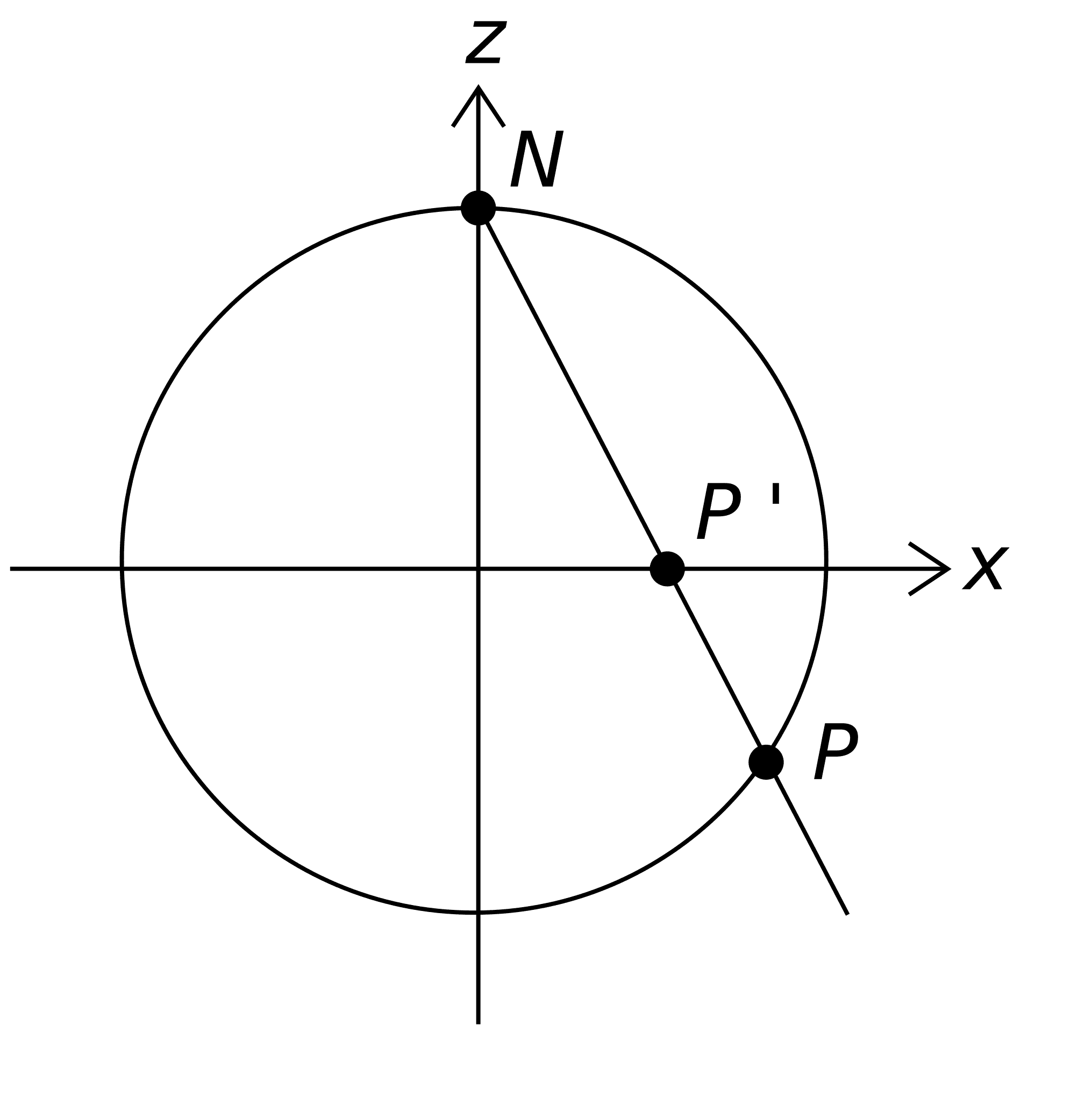
4.11.6 Conformal parametrizations
In the previous section we defined conformal maps between surfaces \[ f \colon \mathcal{S}\to \widetilde{\mathcal{S}}\,. \] It is also useful to define conformal parametrizations.
Definition 160: Conformal parametrization
The above definition is motivated by the following result, stating that \(\mathcal{S}\) admits a conformal parametrization if and only if \(\mathcal{S}\) is conformal to a plane.
Theorem 161
Let \({\pmb{\sigma}}\colon U \to \mathbb{R}^3\) be regular. Let \({\pmb{\pi}}\) be the plane \(\{z=0\}\). They are equivalent:
\({\pmb{\sigma}}\) is a conformal parametrization.
The map \(f \colon {\pmb{\pi}}\to {\pmb{\sigma}}(U)\) defined by \[ f(u,v,0) = {\pmb{\sigma}}(u,v) \] is conformal.
Proof
As an immediate consequence, we have the following Theorem.
Theorem 162: Conformal parametrizations preserve angles
It turns out that all regular surfaces admit an atlas formed by conformal charts.
Theorem 163
The proof of this result is quite technical, see for example the paper (Chern, Shiing-shen 1955), which can be read here. The proof in not constructive, and it involeves showing the existence of solutions to a certain PDE. If \(\mathcal{S}\) is a minimial surface, existence of isothermal coordinates is easier to prove, see for example Theorem 12.4.1 in (Pressley 2010).
We have already seen examples of conformal parametrization for the Cylinder:
Example 164: Unit cylinder
Solution. We have already computed that the FFF of \({\pmb{\sigma}}\) is \[ \mathscr{F}_1 = du^2 + dv^2 \,. \] Therefore \({\pmb{\sigma}}\) is a conformal parametrization, with \(\lambda = 1\).
An important application of conformal parametrizations is in cartography.
Remark 165: Drawing World Maps
- preserve angles and shapes;
- preserve areas.
We know that angles are preserved if \({\pmb{\sigma}}^{-1}\) is a conformal map, and \({\pmb{\sigma}}\) a conformal parametrization. Below we discuss two conformal maps of \(\mathbb{S}^2\):
- Stereographic Projection,
- Mercator Projection.
In the next sections we will also discuss an equiareal map of of \(\mathbb{S}^2\), i.e., a map which preserves areas. This will be called
- Lambert Cylindrical Projection.
We will also see that it is not possible for a map \({\pmb{\sigma}}\) to both preserve angles and areas. This is because \({\pmb{\sigma}}\) would be both conformal and equiareal, and hence an isometry of the sphere into the plane. However, isometries between sphere and plane cannot exist.
Example 166: Stereographic Projection
Note. Let \(V = {\pmb{\sigma}}(U)\). In this case \[ V = \mathbb{S}^2 \smallsetminus \{ (1,0,0)\} \,. \] In particular, the inverse \[ {\pmb{\sigma}}^{-1} \colon V \subseteq \mathbb{S}^2 \to \mathbb{R}^2 \] is a conformal map. This is known as the Stereographic Projection, see Figure 4.26 and Figure 4.27.
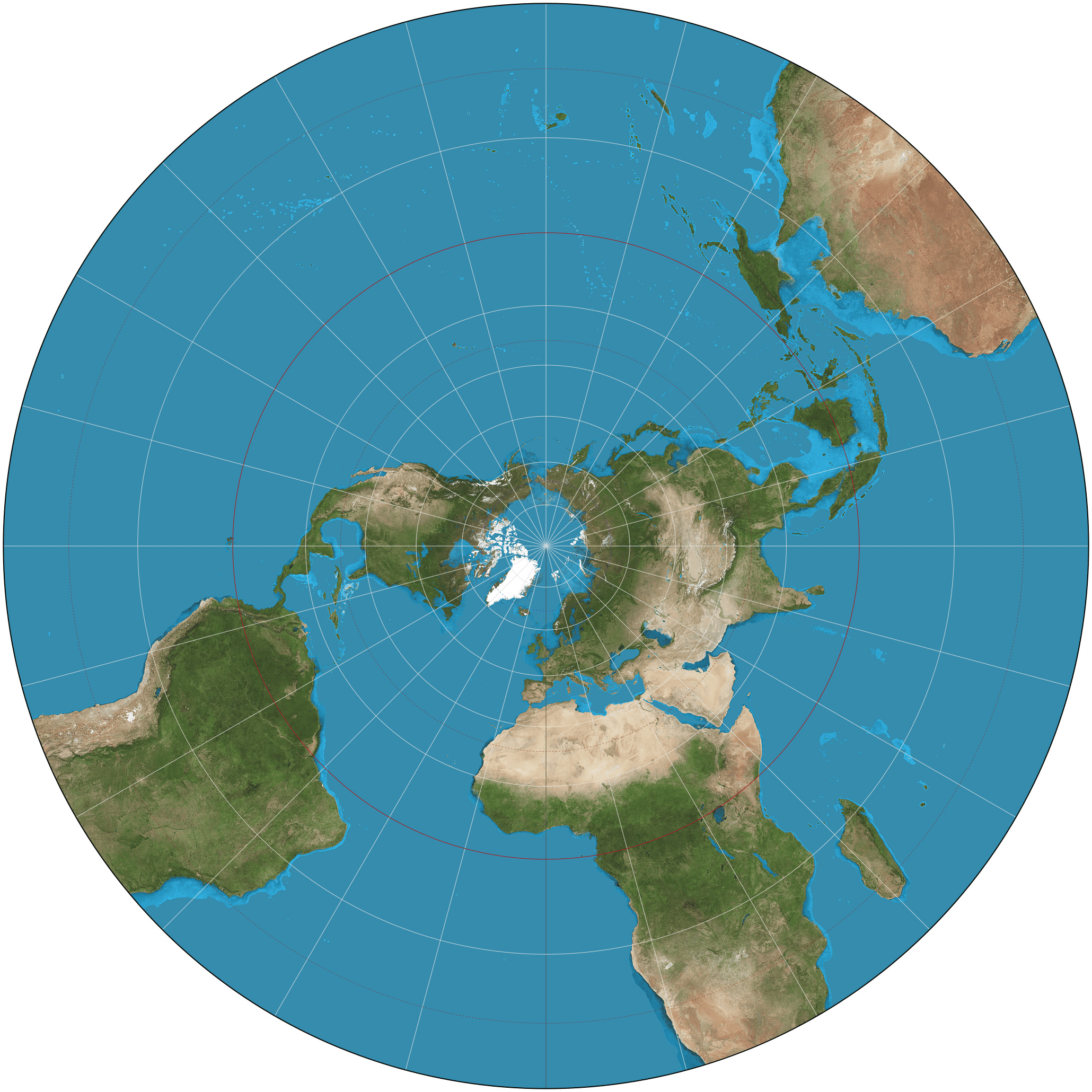
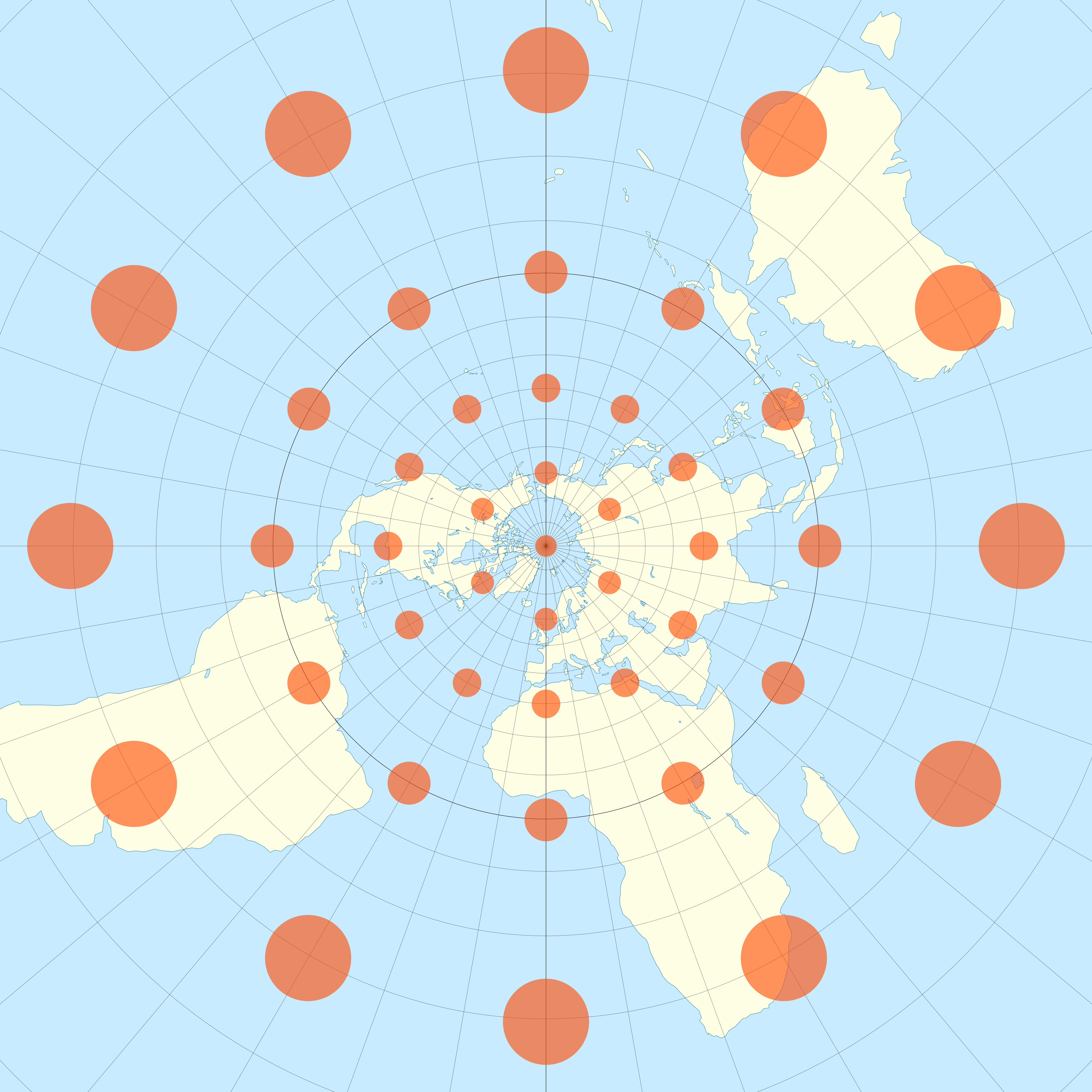
Example 167: Mercator projection
Note. Let \(V = {\pmb{\sigma}}(U)\). In particular, the inverse \[ {\pmb{\sigma}}^{-1} \colon V \subseteq \mathbb{S}^2 \to \mathbb{R}^2 \] is a conformal map. This is known as the Mercator Projection, see Figure 4.28 and Figure 4.29.
Solution. Recall the identities \({\mathop{\mathrm{sech}}}^2 (v) + {\tanh}^2 (v) = 1\) and \[\begin{align*} & \mathop{\mathrm{sech}}(v)' = - \mathop{\mathrm{sech}}(v) \tanh (v) \,, \qquad \tanh (v)' = {\mathop{\mathrm{sech}}}^2 (v) \,. \end{align*}\] The chart \({\pmb{\sigma}}\) is a conformal parametrization because the FFF is \[\begin{align*} & \widetilde{{\pmb{\sigma}}}_u = \mathop{\mathrm{sech}}(v) \, ( -\sin(u) , \cos(u), 0 ) \\ & \widetilde{{\pmb{\sigma}}}_v = \mathop{\mathrm{sech}}(v) \, ( -\cos(v) \tanh(v) , -\sin(u) \tanh(v) , \mathop{\mathrm{sech}}(v) ) \\ & \widetilde{E} = \widetilde{{\pmb{\sigma}}}_u \cdot \widetilde{{\pmb{\sigma}}}_u = {\mathop{\mathrm{sech}}}^2(v) (\cos^2(u) + \sin^2(u)) = {\mathop{\mathrm{sech}}}^2(v) \\ & \widetilde{F} = \widetilde{{\pmb{\sigma}}}_u \cdot \widetilde{{\pmb{\sigma}}}_v = 0 \\ & \widetilde{G} = \widetilde{{\pmb{\sigma}}}_v \cdot \widetilde{{\pmb{\sigma}}}_v = {\mathop{\mathrm{sech}}}^2(v) ({\tanh}^2(v) + {\mathop{\mathrm{sech}}}^2(v)) = {\mathop{\mathrm{sech}}}^2(v) \\ & {\mathscr{F}}_1 = {\mathop{\mathrm{sech}}}^2(v) \, \left( du^2 + dv^2 \right) \,. \end{align*}\]
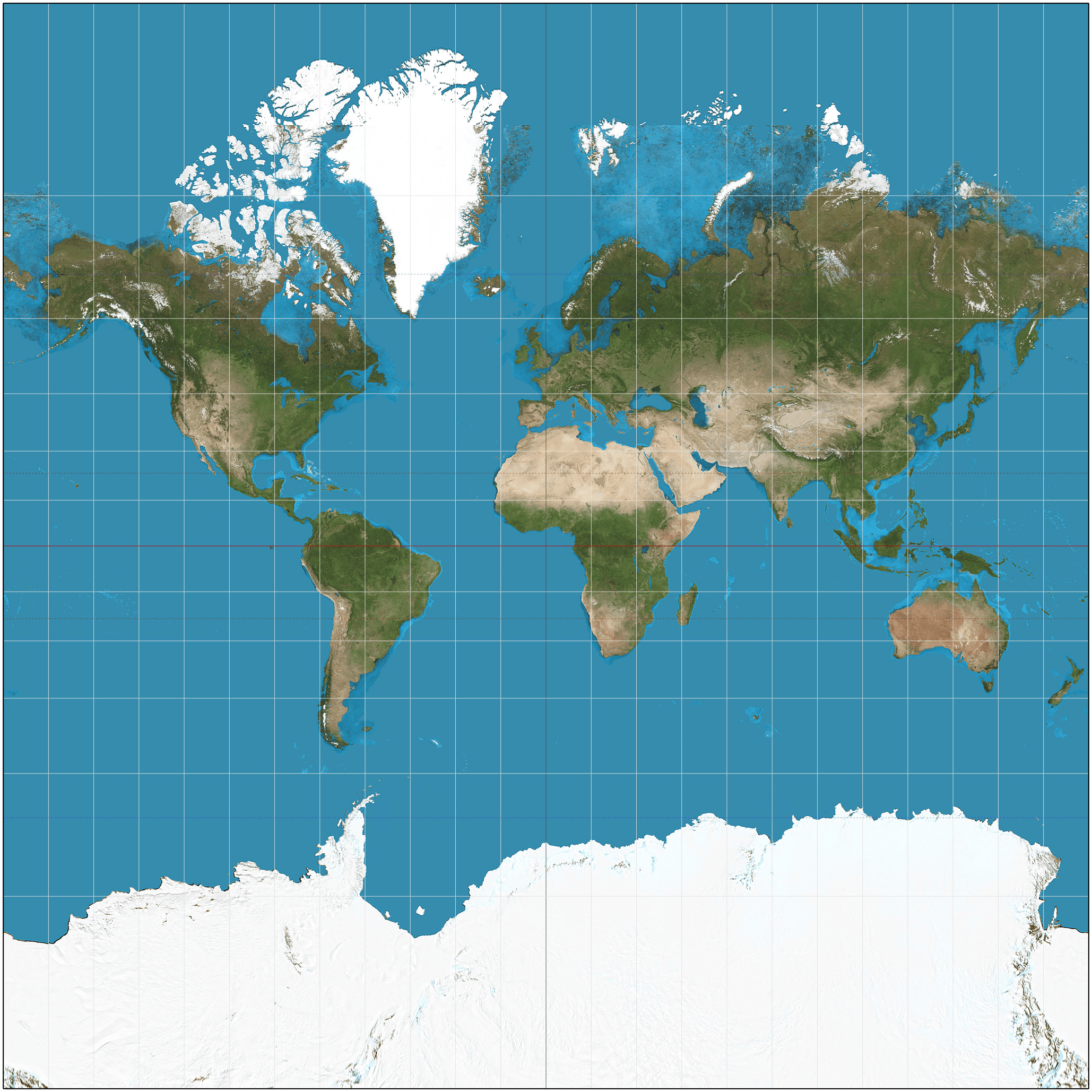
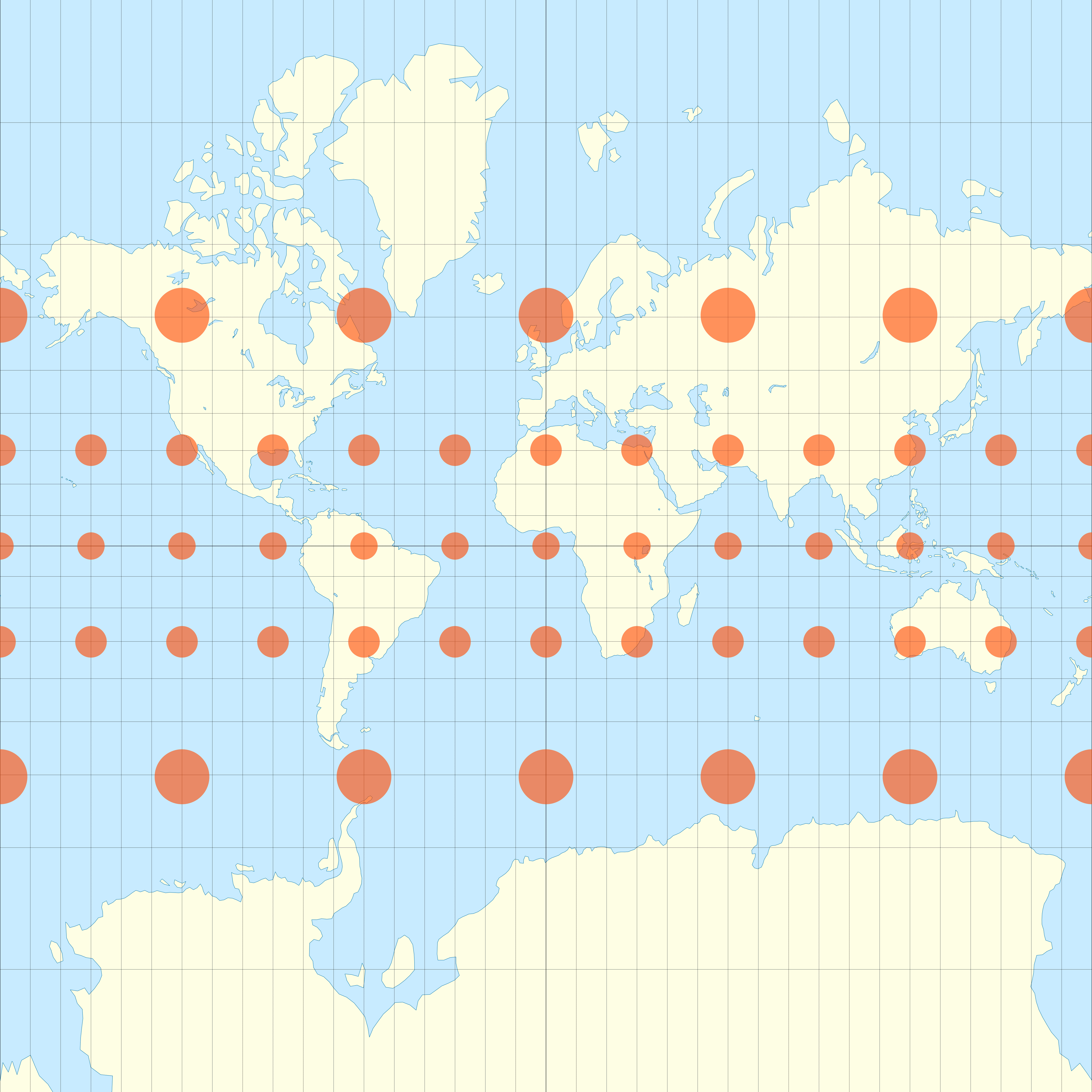
4.11.7 Areas
Suppose given a regular surface \(\mathcal{S}\), with chart \({\pmb{\sigma}}\colon U \to \mathbb{R}^3\). Given \(R \subseteq U\), consider the region \[ {\pmb{\sigma}}(R) \subseteq \mathcal{S}\,. \] If \({\pmb{\sigma}}(R)\) is sufficiently small, it can be approximated by a small portion of the tangent plane \(T_{\mathbf{p}} \mathcal{S}\), namely, by the parallelogram spanned by \({\pmb{\sigma}}_u\) and \({\pmb{\sigma}}_v\), see Figure 4.30. By the properties of vector product, the area of such parallelogram is \(\left\| {{\pmb{\sigma}}}_{u}\times {{\pmb{\sigma}}}_{v} \right\|\). Therefore, the area \(A_{{\pmb{\sigma}}}(R)\) of \({\pmb{\sigma}}(R)\) is approximated by \[ A_{{\pmb{\sigma}}}(R) \approx \left\| {{\pmb{\sigma}}}_{u}\times {{\pmb{\sigma}}}_{v} \right\| \,. \] It can be shown that the area of any region \({\pmb{\sigma}}(R)\) is obtained by integrating \(\left\| {{\pmb{\sigma}}}_{u}\times {{\pmb{\sigma}}}_{v} \right\|\) on \(R\), see Theorem 4.2.5 in (Abate, Marco and Tovena, Francesca 2011). Specifically, \[ A_{{\pmb{\sigma}}}(R) = \int_{R} \left\| {{\pmb{\sigma}}}_{u}\times {{\pmb{\sigma}}}_{v} \right\| \, dudv \,. \tag{4.13}\] The proof of such result is similar to the one we did for showing that the length of a curve is given by \[ L({\pmb{\gamma}}) = \int_{a}^b \left\| \dot{{\pmb{\gamma}}}(u) \right\| \, du \,, \] where \(L({\pmb{\gamma}})\) is defined as \[ L({\pmb{\gamma}}) = \lim_{\varepsilon\to 0} L({\pmb{\gamma}}_\varepsilon) \,, \] where \(L({\pmb{\gamma}}_{\varepsilon})\) is the length of a piecewise linear approximation \({\pmb{\gamma}}_{\varepsilon}\) of \({\pmb{\gamma}}\). To obtain (4.13), one can approximate \({\pmb{\sigma}}(R)\) with a piecewise affine mesh \({\pmb{\sigma}}(R_{\varepsilon})\), and then define \[ A_{{\pmb{\sigma}}}(R) = \lim_{\varepsilon\to 0} A_{{\pmb{\sigma}}}(R_{\varepsilon}) \,. \] Making this argument precise requires a lot of effort. Instead, we just take (4.13) as the definition of area.
Definition 168
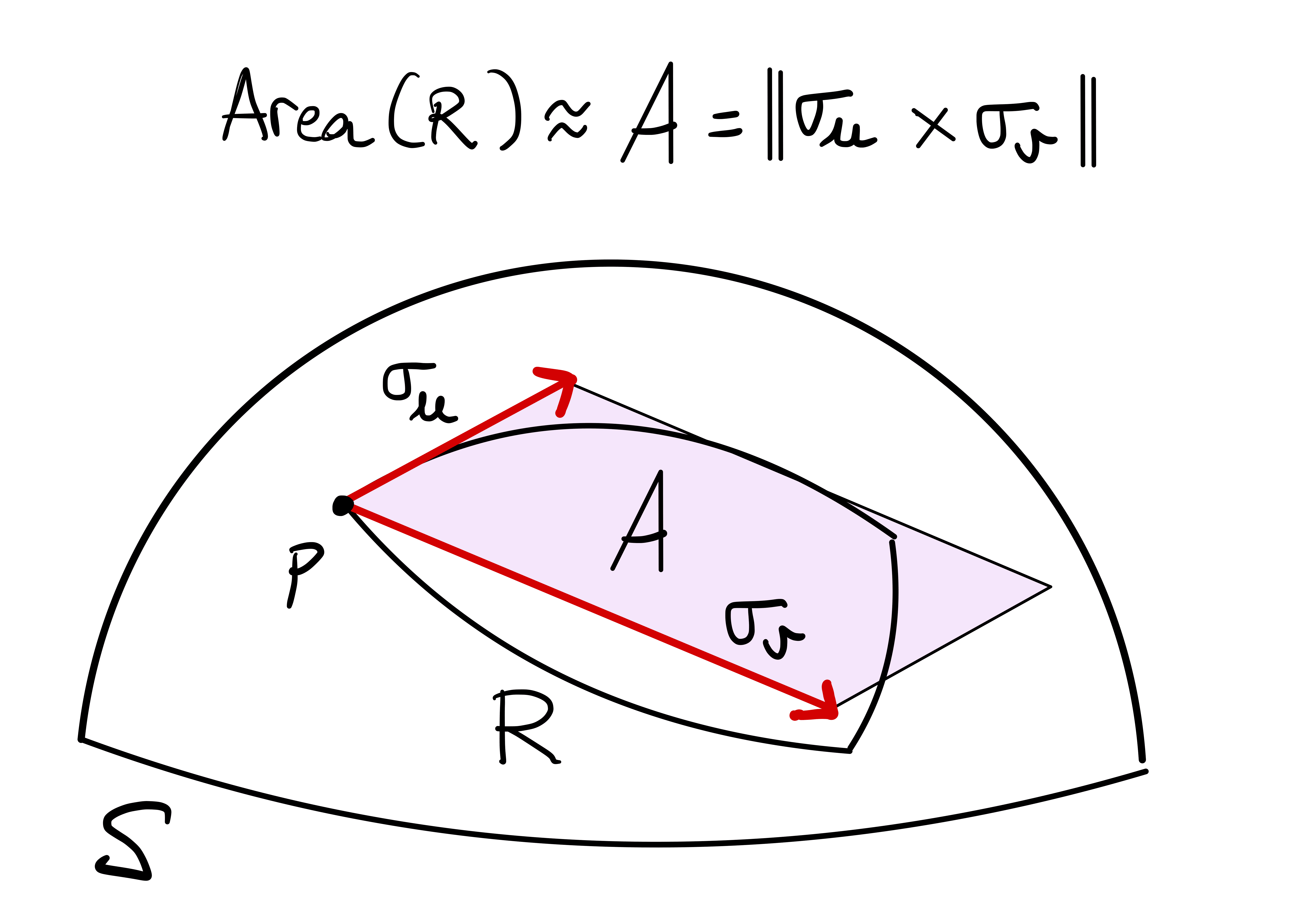
Theorem 169
Proof
It is easy to check that the definition of \(A_{{\pmb{\sigma}}}\) does not depend on the choice of \({\pmb{\sigma}}\), see Proposition 6.4.3 in (Pressley 2010).
Example 170
Solution. The paraboloid \(\mathcal{S}\) is charted by \[ {\pmb{\sigma}}(u,v) = (u,v, u^2 + v^2 ) \,, \] for \(u,v \in \mathbb{R}\). We compute the first fundamental form of \({\pmb{\sigma}}\): \[\begin{align*} & {{\pmb{\sigma}}}_{u}= (1,0,2u) &\,& F = {{\pmb{\sigma}}}_{u}\cdot {{\pmb{\sigma}}}_{v}= 4uv \\ & {{\pmb{\sigma}}}_{v}= (0,1,2v) &\,& G = {{\pmb{\sigma}}}_{u}\cdot {{\pmb{\sigma}}}_{u}= 1 + 4v^2 \\ & E = {{\pmb{\sigma}}}_{u}\cdot {{\pmb{\sigma}}}_{u}= 1 + 4u^2 &\,& EG - F^2 = 1 + 4(u^2 + v^2) \end{align*}\] The region \(\mathcal{S}\cap \{z \leq 1\}\) corresponds to \({\pmb{\sigma}}(R)\), with \[ R = \{ (u,v) \in \mathbb{R}^2 \, \colon \, u^2 + v^2 \leq 1 \} \,. \] The area of \({\pmb{\sigma}}(R)\) is then \[\begin{align*} A_{{\pmb{\sigma}}} (R) & = \int_{R} \sqrt{EG-F^2} \, dudv = \int_{R} \sqrt{1 + 4(u^2 + v^2)} \, dudv \\ & = \int_{0}^1\int_{0}^{2\pi} \sqrt{1 + 4r^2} \, \rho \, d\rho \, d\theta = \frac{\pi}{6} (5^{3/2} - 1) \,, \end{align*}\] where the integral was computed using polar coordinates \[ u = \rho \cos(\theta)\,, \quad v = \rho \sin(\theta) \,. \]
4.11.8 Equiareal Maps
Definition 171
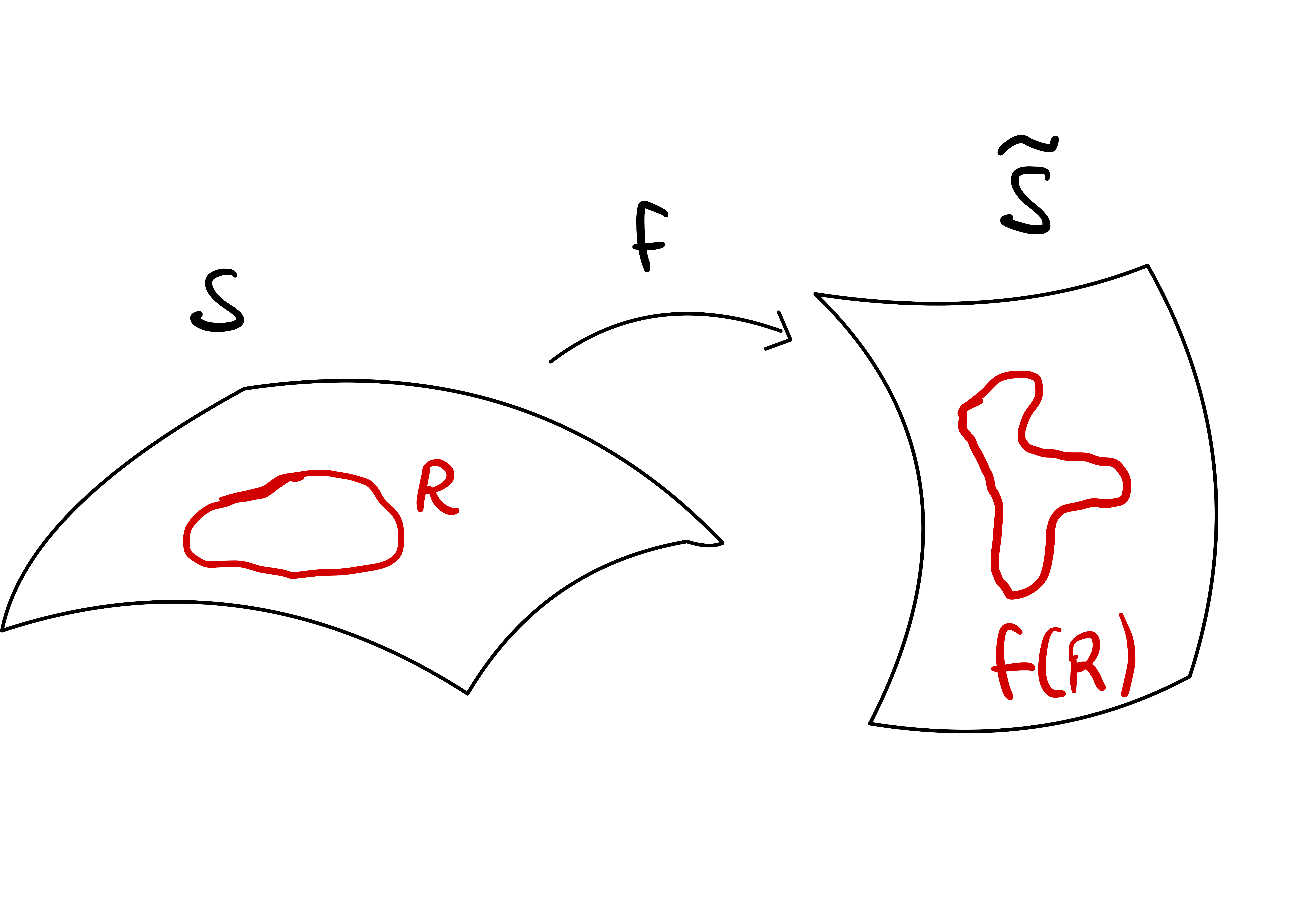
Theorem 172
Let \(\mathcal{S}\), \(\widetilde{\mathcal{S}}\) be regular surfaces, \(f \colon \mathcal{S}\to \widetilde{\mathcal{S}}\) a local diffeomorphism. Equivalently:
- \(f\) is an equiareal map.
- Let \({\pmb{\sigma}}\colon U \to \mathcal{S}\) be regular chart of \(\mathcal{S}\), and define a chart of \(\widetilde{\mathcal{S}}\) as \(\widetilde{{\pmb{\sigma}}} \colon U \to \widetilde{\mathcal{S}}\), with \(\widetilde{{\pmb{\sigma}}} = f \circ {\pmb{\sigma}}\). Then the FFF of \({\pmb{\sigma}}\) and \(\widetilde{{\pmb{\sigma}}}\) satisfy \[ EG - F^2 = \widetilde{E}\widetilde{G}- {\widetilde{F}}^2 \,. \]
Theorem 172 can be proven with arguments similar to the proof of Theorem 141. The proof is omitted.
As usual, we give a sufficient condition to prove that two regular surfaces are equiareal.
Theorem 173
Let \(\mathcal{S}, \widetilde{\mathcal{S}}\) be regular surfaces, with charts \({\pmb{\sigma}}\colon U \to \mathcal{S}\) and \(\widetilde{{\pmb{\sigma}}}\colon U \to \widetilde{\mathcal{S}}\). Assume that \[ EG - F^2 = \widetilde{E}\widetilde{G}- {\widetilde{F}}^2 \,, \] We have
- The surfaces \({\pmb{\sigma}}(U)\) and \(\widetilde{\mathcal{S}}\) are equiareal.
- An equiareal map is given by \[ f \colon {\pmb{\sigma}}(U) \to \widetilde{\mathcal{S}}\,, \qquad f = \widetilde{{\pmb{\sigma}}}\circ {\pmb{\sigma}}^{-1} \,. \]
The proof follows by adapting the argument in the proof of Theorem 143, and by applying Theorem 172. This is left as an exercise.
Example 174: Archimedes map
- Prove that \(f\) is a diffeomorphism.
- Prove that \(f\) is equiareal.
Solution. Note that \(f \in \widetilde{\mathcal{S}}\) because \[ {\left[ \frac{x}{(x^2 + y^2)^{1/2}} \right]}^2 +{\left[ \frac{y}{(x^2 + y^2)^{1/2}} \right]}^2 = 1 \,. \] Therefore \(f\) is well-defined. In order to chart \(\mathcal{S}\), introduce \[\begin{align*} & {\pmb{\sigma}}(u,v) = (\cos(u)\cos(v), \sin(u) \cos(v), \sin(v)) \\ & U_1 = \left\{ (u,v) \in \mathbb{R}^2 \, \colon \, u \in (-\pi,\pi), \, v \in \left( -\pi/2, \pi/2 \right) \right\} \\ & U_2 = \left\{ (u,v) \in \mathbb{R}^2 \, \colon \, u \in (0,2\pi), \, v \in \left( -\pi/2, \pi/2 \right) \right\} \\ & {\pmb{\sigma}}_1 = {\pmb{\sigma}}|_{U_1} \,, \qquad {\pmb{\sigma}}_2 = {\pmb{\sigma}}|_{U_2} \,. \end{align*}\] Note that \[\begin{align*} & {\pmb{\sigma}}(U_1) = \mathbb{S}^2 \smallsetminus \{ \text{Date Line}, (0,0,\pm 1) \} \,, \\ & {\pmb{\sigma}}(U_2) = \mathbb{S}^2 \smallsetminus \{ \text{Greenwich Meridian}, (0,0,\pm 1) \} \,, \end{align*}\] Therefore \(\mathcal{A} = \{ {\pmb{\sigma}}_1, {\pmb{\sigma}}_2\}\) is an atlas for \(\mathcal{S}\). Denote the components of \({\pmb{\sigma}}\) by \[ x = \cos(u)\cos(v) \,, \quad y = \sin(u)\cos(v) \,,\quad z = \sin(v) \,. \] We have that \[ (x^2 + y^2)^{1/2} = |\cos(v)| = \cos(v) \,, \] where we used that \(\cos(v)>0\), since \(v \in (-\pi/2,\pi/2)\) when \((u,v) \in U_1\) or \((u,v) \in U_2\). Thus, the chart \(\widetilde{{\pmb{\sigma}}}= f \circ {\pmb{\sigma}}\) is \[\begin{align*} \widetilde{{\pmb{\sigma}}}(u,v) & = f ({\pmb{\sigma}}(u,v)) \\ & = \left( \frac{x}{(x^2 + y^2)^{1/2}}, \frac{y}{(x^2 + y^2)^{1/2}} , z \right) \\ & = \left( \frac{\cos(u)\cos(v)}{\cos(v)}, \frac{\sin(u)\cos(v)}{\cos(v)}, \sin(v) \right) \\ & = ( \cos(u), \sin(u), \sin(v) ) \,. \end{align*}\] It is clear that \(\widetilde{{\pmb{\sigma}}}\) charts the part of the unit cylinder between the planes \(\{z=-1\}\) and \(\{z=1\}\), when \(u \in [0,2\pi]\) and \(v \in (-\pi/2,\pi/2)\). Therefore, the charts \[ \widetilde{A} = \{ \widetilde{{\pmb{\sigma}}}_1, \widetilde{{\pmb{\sigma}}}_2, \} \,, \quad \widetilde{{\pmb{\sigma}}}_1, = \widetilde{{\pmb{\sigma}}}|_{U_1} \,, \quad \widetilde{{\pmb{\sigma}}}_2 = \widetilde{{\pmb{\sigma}}}|_{U_2}, \] form an atlas for the surface \(\widetilde{\mathcal{S}}\cap \{-1 < z < 1\}\).
For \(i=1,2\) define the map \[ \Psi_i \colon U_i \to U_i \,, \qquad \Psi_i = {\widetilde{{\pmb{\sigma}}}}^{-1} \circ f \circ {\pmb{\sigma}}\,. \] Since \(\widetilde{{\pmb{\sigma}}}= f \circ {\pmb{\sigma}}\), we have that \(\Psi\) is the identity \[ \Psi (u,v) = (u,v) \,. \] Therefore \(\Psi\) is smooth, with smooth inverse. By definition of smooth map between surfaces, this implies that both \(f\) and \(f^{-1}\) are smooth. Thus, \(f\) is a diffeomorphism between \(\mathcal{S}\) and \(\widetilde{\mathcal{S}}\cap \{ - 1 < z < 1\}\).
We compute the FFF of \({\pmb{\sigma}}\) \[\begin{align*} & {\pmb{\sigma}}_u = (-\sin(u)\cos(v), \cos(u)\cos(v),0) \\ & {\pmb{\sigma}}_v = (-\cos(u)\sin(v), -\sin(u)\sin(v), \cos(v)) \\ & E = {\pmb{\sigma}}_u \cdot {\pmb{\sigma}}_u = \cos^2(v) \\ & F = {\pmb{\sigma}}_u \cdot {\pmb{\sigma}}_v = 0\\ & G = {\pmb{\sigma}}_v \cdot {\pmb{\sigma}}_v = 1 \end{align*}\] The FFF of \(\widetilde{{\pmb{\sigma}}}\) is \[\begin{align*} & \widetilde{{\pmb{\sigma}}}_u = (-\sin(u), \cos(u),0) \\ & \widetilde{{\pmb{\sigma}}}_v = (0, 0, \cos(v)) \\ & \widetilde{E}= \widetilde{{\pmb{\sigma}}}_u \cdot \widetilde{{\pmb{\sigma}}}_u = 1 \\ & \widetilde{F}= \widetilde{{\pmb{\sigma}}}_u \cdot \widetilde{{\pmb{\sigma}}}_v = 0\\ & \widetilde{G}= \widetilde{{\pmb{\sigma}}}_v \cdot \widetilde{{\pmb{\sigma}}}_v = \cos^2(v) \end{align*}\] Therefore, we have that \({\pmb{\sigma}}\) and \(\widetilde{{\pmb{\sigma}}}= f \circ {\pmb{\sigma}}\) satisfy \[ EG-F^2 = \widetilde{E}\widetilde{G}- {\widetilde{F}}^2 = \cos^2(v) \,. \tag{4.14}\] Note that \({\pmb{\sigma}}_i\) is defined by restricting \({\pmb{\sigma}}\) to \(U_i\). Hence, \({\pmb{\sigma}}\) and \({\pmb{\sigma}}_i\) have the same FFF. Similarly, \(\widetilde{{\pmb{\sigma}}}_i := f \circ {\pmb{\sigma}}_i\) is just the restriction to \(U_i\) of \(\widetilde{{\pmb{\sigma}}}\). Therefore, \(\widetilde{{\pmb{\sigma}}}_i\) and \(\widetilde{{\pmb{\sigma}}}\) have the same FFF. We conclude that \(\widetilde{{\pmb{\sigma}}}_i\) and \(\widetilde{{\pmb{\sigma}}}_i = f \circ {\pmb{\sigma}}_i\) also satisfy (4.14). In particular, since \(\mathcal{A} = \{{\pmb{\sigma}}_1,{\pmb{\sigma}}_2\}\) is an Atlas for \(\mathcal{S}\), Theorem 172 implies that \(f\) is an equiareal map.
Derivation of the Archimedes map. The sphere \(\mathcal{S}\) is contained inside the cylinder \(\widetilde{\mathcal{S}}\), and the two surfaces touch along the circle \(x^2 + y^2 = 1\) in the \(\{z=0\}\) plane. Let \(P \in \mathbb{S}^2\), except for North or South Pole. Draw the line through \(P\) and the \(z\)-axis which is parallel to the plane \(\{z=0\}\). This line intersects the cylinder in 2 points. Denote by \(P'\) the intersection point which is closest to \(P\), see Figure 4.32. To write the projection map explicitly, denote the coordinates of \(P\) and \(P'\) by \[ P = (x,y,z) \,, \quad P' = (X,Y,Z) \,. \] Since the line through \(P\) and \(P'\) is parallel to the plane \(\{z=0\}\), we have \[ Z = z \,, \quad (X,Y) = \lambda (x,y) \] for some scalar \(\lambda\). Using that \(P'\) belongs to the cylinder, we get \[ 1 = X^2 + Y^2 = \lambda^2 (x^2 + y^2) \] from which we deduce that \[ \lambda = \pm \frac{1}{(x^2 + y^2)^{1/2}} \,. \] Therefore \[ X = \lambda x = \pm \frac{x}{(x^2 + y^2)^{1/2}} \,, \quad Y = \lambda y = \pm \frac{y}{(x^2 + y^2)^{1/2}} \,. \] Taking the \(+\) sign gives the point \[ P' = (X,Y,Z) = \left( \frac{x}{(x^2 + y^2)^{1/2}}, \frac{y}{(x^2 + y^2)^{1/2}} , z \right) \,. \] This defines the Archimedes map \(f \colon \mathcal{S}\to \widetilde{\mathcal{S}}\) \[ f(x,y,z) = \left( \frac{x}{(x^2 + y^2)^{1/2}}, \frac{y}{(x^2 + y^2)^{1/2}} , z \right) \,. \]
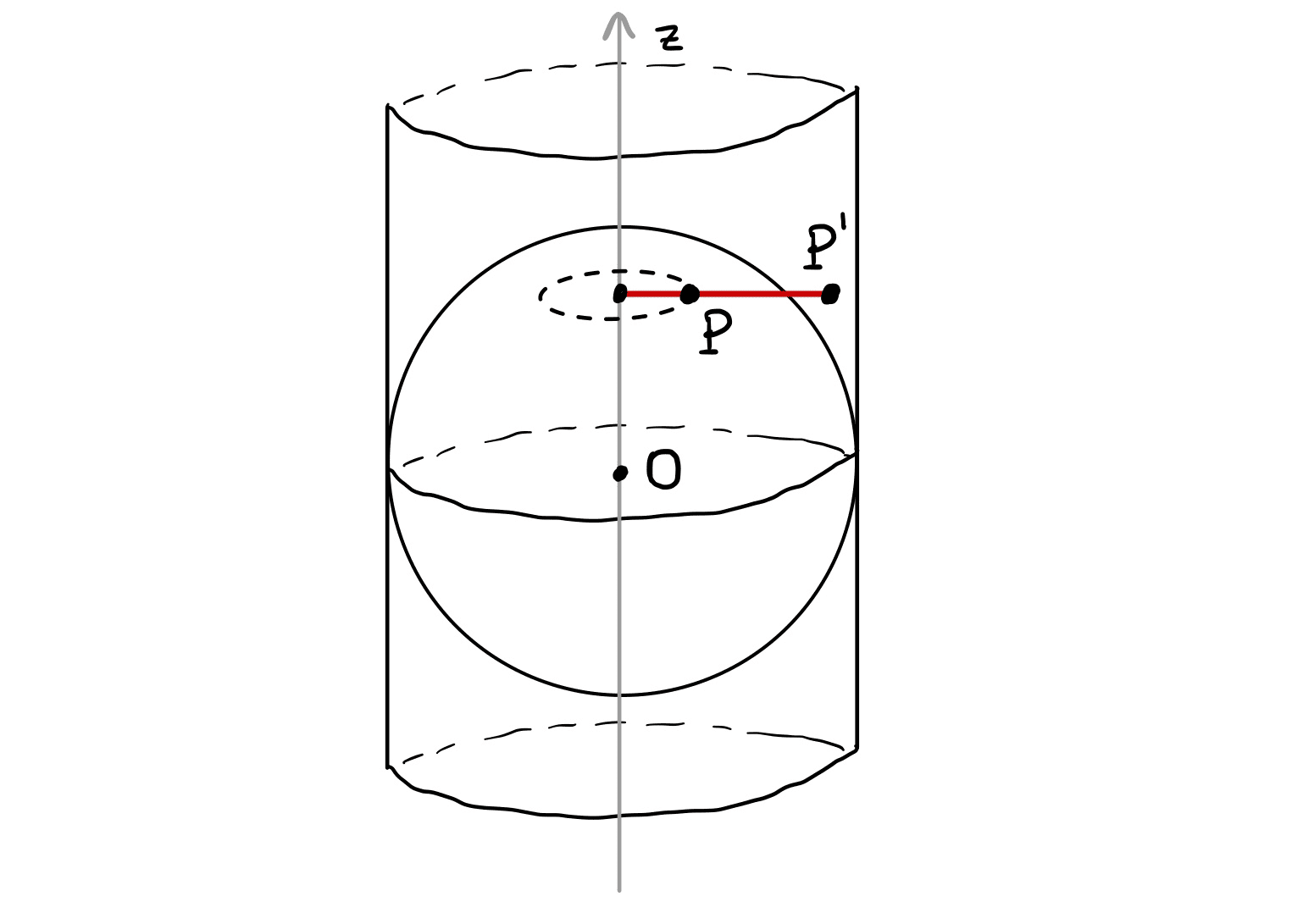
We conclude this section by clarifying the relationship between isometries, conformal and equiareal maps.
Theorem 175
Let \(f \colon \mathcal{S}\to \widetilde{\mathcal{S}}\) be a local diffeomorphism between surfaces. They are equivalent:
- \(f\) is a local isometry.
- \(f\) is conformal and equiareal.
Proof
Part 2. Assume \(f\) is conformal and equiareal. Let \({\pmb{\sigma}}\colon U \to \mathbb{R}^3\) be a chart of \(\mathcal{S}\), and define \(\widetilde{{\pmb{\sigma}}}= f \circ {\pmb{\sigma}}\). As \(f\) is conformal, by Thoerem 156 we have that \[ \widetilde{E}= \lambda E \,, \qquad \widetilde{F}= \lambda F \,, \qquad \widetilde{G}= \lambda G \,, \] for some smooth \(\lambda \colon U \to \mathbb{R}\). As \(f\) is equiareal, by Theorem 172 we have that \[ EG-F^2 = \widetilde{E}\widetilde{G}- {\widetilde{F}}^2 \,. \] In particular, we get \[ EG-F^2 = \widetilde{E}\widetilde{G}- {\widetilde{F}}^2 = (\lambda E)(\lambda F) - (\lambda G)^2 = \lambda^2 (EG-F^2) \,. \] Since \({\pmb{\sigma}}\) is a regular chart, we have \(EG-F^2>0\). Therefore, we obtain \(\lambda = \pm 1\), which implies \[ \widetilde{E}= \lambda E \,, \quad \lambda = \pm 1 \,. \] Note that \[ E = {{\pmb{\sigma}}}_{u}\cdot {{\pmb{\sigma}}}_{u}= \left\| {{\pmb{\sigma}}}_{u} \right\|^2 > 0 \,, \] being \({\pmb{\sigma}}\) regular (so that \({{\pmb{\sigma}}}_{u}\neq {\pmb{0}}\)). Similarly, as \(\widetilde{{\pmb{\sigma}}}\) is regular, we also have that \(\widetilde{E}> 0\). Therefore \(\lambda = 1\). In particular, we have shown that \(\mathscr{F}= \widetilde{\mathscr{F}}\), implying that \(f\) is a local isometry by Thoerem 141.
4.11.9 Equiareal parametrizations
In the previous section we defined equiareal maps between surfaces \[ f \colon \mathcal{S}\to \widetilde{\mathcal{S}}\,. \] It is also useful to define equiareal parametrizations.
Definition 176: Equiareal parametrization
The above definition is motivated by the following result, stating that \(\mathcal{S}\) admits an equiareal parametrization if and only if \(\mathcal{S}\) is equiareal to a plane.
Theorem 177
Let \({\pmb{\sigma}}\colon U \to \mathbb{R}^3\) be regular. Let \({\pmb{\pi}}\) be the plane \(\{z=0\}\). They are equivalent:
\({\pmb{\sigma}}\) is an equiareal parametrization.
The map \(f \colon {\pmb{\pi}}\to {\pmb{\sigma}}(U)\) defined by \[ f(u,v,0) = {\pmb{\sigma}}(u,v) \] is equiareal.
Proof
As an immediate consequence, we have the following Theorem.
Theorem 178
An important application of equiareal parametrization is in cartography: We would like to draw a map of the Earth which preserves areas. One such map is known as the Lambert cylindrical projection.
Example 179: Lambert cylindrical projection
Note: In particular, the inverse \[ {\pmb{\sigma}}^{-1} \colon \mathbb{S}^2 \to \mathbb{R}^2 \] is an equiareal map. This is known as the Lambert cylindrical projection, see Figure 4.33 and Figure 4.34.
Solution. We compute \[\begin{align*} & {{\pmb{\sigma}}}_{u}= \left( - \sin (u) \sqrt{1-v^2} , \cos(u) \sqrt{1-v^2} , 0 \right) \\ & {{\pmb{\sigma}}}_{v}= \left( -\cos (u) v (1-v^2)^{-1/2} , - \sin(u) v (1-v^2)^{-1/2} , 1 \right) \\ & E = {{\pmb{\sigma}}}_{u}\cdot {{\pmb{\sigma}}}_{u}= 1 - v^2 \\ & F = {{\pmb{\sigma}}}_{u}\cdot {{\pmb{\sigma}}}_{v}= 0 \\ & G = {{\pmb{\sigma}}}_{v}\cdot {{\pmb{\sigma}}}_{v}= 1 + \frac{v^2}{1-v^2} \end{align*}\] and therefore \[ EG - F^2 = (1 - v^2) \left( 1 + \frac{v^2}{1-v^2} \right) = 1 \,, \] showing that \({\pmb{\sigma}}\) is an equiareal parametrization of \(\mathbb{S}^2\).


Remark 180: Cartography
The Mercator projection is a conformal map of \(\mathbb{S}^2\) into the plane. Such projection preseves angles but distorts areas.
The Lambert cylindrical projection is an equiareal map of \(\mathbb{S}^2\) into the plane. Such projection preseves areas but distorts angles.
The following question is natural: Is there a projection \[ {\pmb{\sigma}}\colon \mathbb{S}^2 \to \mathbb{R}^2 \] which is both conformal and equiareal?
Answer: No. This is because \({\pmb{\sigma}}\) would be an isometry between \(\mathbb{S}^2\) and the plane \(\mathbb{R}^2\), see Theorem 175. This is impossible because:
- The Theorema Egregium (by Gauss - we will study it) tells us that isometric surfaces must have the same Gaussian curvature;
- However, the plane has zero Gaussian curvature, while the sphere has non-zero Gaussian curvature;
- Therefore the plane and the sphere cannot be isometric.
This means that we cannot draw a map of the Earth which preserves both angles and lengths.
4.11.10 Summary
Let \(\mathcal{S}\) be a regular surface and \({\pmb{\sigma}}\colon U \to \mathbb{R}^3\) a chart. We have introduced the first fundamental form of \(\mathcal{S}\) as the restriction of the euclidean scalar product to the tangent space: \[ I_{\mathbf{p}}(\mathbf{v},\mathbf{w}) = \mathbf{v}\cdot \mathbf{w}\,, \quad \forall \, \mathbf{v}, \mathbf{w}\in T_{\mathbf{p}} \mathcal{S} \] The first fundamental form of \({\pmb{\sigma}}\) is \[ {\mathscr{F}}_1 = E du^2 + 2F du dv+ G dv^2 \] where the coefficients are \[ E = {{\pmb{\sigma}}}_{u}\cdot {{\pmb{\sigma}}}_{u}\,, \quad F = {{\pmb{\sigma}}}_{u}\cdot {{\pmb{\sigma}}}_{v}\,, \quad G = {{\pmb{\sigma}}}_{v}\cdot {{\pmb{\sigma}}}_{v}\,. \] Given a chart \({\pmb{\sigma}}\), we have \[ I_{\mathbf{p}}(\mathbf{v},\mathbf{v}) = E du(\mathbf{v})^2 + 2F du(\mathbf{v}) dv(\mathbf{v}) + G dv(\mathbf{v})^2 \] Consider two curves \({\pmb{\gamma}}\) and \(\widetilde{{\pmb{\gamma}}}\) on the surface \({\pmb{\sigma}}(U)\), that is, \[ {\pmb{\gamma}}(t) = {\pmb{\sigma}}(u(t),v(t)) \,, \quad \widetilde{{\pmb{\gamma}}}(t) = {\pmb{\sigma}}(\tilde{u}(t),\tilde{v}(t)) \,. \] Moreover, consider a region \(R \subseteq U\). The first fundamental form allows to compute:
Length of curves: \[ L({\pmb{\gamma}}) = \int_a^b \sqrt{ E \dot{u}^2 + 2F \dot{u}\dot{v} + G \dot{v}^2 } \, dt \]
Angle \(\theta\) between \({\pmb{\gamma}}\) and \(\widetilde{{\pmb{\gamma}}}\) (at any intersection point): \[ \cos(\theta) = \frac{ E \dot u \dot{\tilde u} + F ( \dot u \dot{\tilde v}+ \dot{\tilde{u}} \dot v) + G \dot v \dot{\tilde v} }{ (E \dot{u}^2 + 2 F \dot u \dot v + G \dot{v}^2 )^{1/2} (E \dot{\tilde{u}}^2 + 2 F \dot{\tilde{u}} \dot{\tilde{v}} + G \dot{\tilde{v}}^2 )^{1/2} } \,. \]
Area \(A_{{\pmb{\sigma}}}(R)\) of the region \({\pmb{\sigma}}(R)\) \[ A_{{\pmb{\sigma}}}(R) = \int_R \sqrt{EG - F^2} \, du dv \,. \]
We have also introduced maps preserving certain quantities. Specfically, let \(\widetilde{\mathcal{S}}\) be another regular surface and \[ f \colon \mathcal{S}\to \widetilde{\mathcal{S}} \] a local diffeomorphism:
- \(f\) local isometry: Preserves scalar product of tangent vectors, and length of curves
- Length of \({\pmb{\gamma}}\) equals that of \(f \circ {\pmb{\gamma}}\) for any \({\pmb{\gamma}}\).
- \(f\) isometry \(\iff\) FFF of \({\pmb{\sigma}}\) and \(\widetilde{{\pmb{\sigma}}}= f \circ {\pmb{\sigma}}\) satisfy \[ E = \widetilde{E}, \quad F = \widetilde{F}, \quad G = \widetilde{G} \]
- \(f\) conformal map: Preserves the angle between tangent vectors, and between curves
- Angle between \({\pmb{\gamma}}\) and \(\widetilde{{\pmb{\gamma}}}\) is the same as the angle between \(f \circ {\pmb{\gamma}}\) and \(f \circ \widetilde{{\pmb{\gamma}}}\)
- \(f\) conformal \(\iff\) FFF of \({\pmb{\sigma}}\) and \(\widetilde{{\pmb{\sigma}}}= f \circ {\pmb{\sigma}}\) satisfy \[ E = \lambda \widetilde{E}, \quad F = \lambda \widetilde{F}, \quad G = \lambda \widetilde{G} \] for some function \(\lambda (u,v)\).
- Equiareal maps: They preserve areas of surface regions
- Area of \(\Omega \subseteq \mathcal{S}\) is the same as the area of \(f(\Omega)\).
- \(f\) equiareal \(\iff\) FFF of \({\pmb{\sigma}}\) and \(\widetilde{{\pmb{\sigma}}}= f \circ {\pmb{\sigma}}\) satisfy \[ EG - F^2 = \widetilde{E}\widetilde{G}- {\widetilde{F}}^2 \]
Moreover, they are equivalent:
- \(f\) is a local isometry,
- \(f\) is conformal and equiareal.
4.12 Second fudamental form
The first fundamental form allows to measure distances on a surface. However it does not give any information on how curved a surface is: For example, we saw that a plane and a cylinder have the same first fundamental form \[ \mathscr{F}_1 = du^2 + dv^2 \,. \] However the plane is flat, while the cylinder curves. We would like to find a measure of curvature which allows us to tell these two surfaces apart.
We can now start our discussion about curvature of surfaces. We can make a similar argument to the one we made for curves: If \({\pmb{\gamma}}\) is a unit-speed curve, the curvature of \({\pmb{\gamma}}\) is defined as \[ \kappa (t) = \left\| \ddot{{\pmb{\gamma}}}(t) \right\| \,. \] The quantity \(\kappa(t)\) gave us a measure of how much \({\pmb{\gamma}}\) is deviating from a straight line. Similarly, we would like to quantify how much a surface \(\mathcal{S}\) is deviating from the tangent plane \(T_{\mathbf{p}} \mathcal{S}\). Recall that \[ T_{\mathbf{p}} \mathcal{S}= \operatorname{span} \{ {\pmb{\sigma}}_u , {\pmb{\sigma}}_v \} \,, \] where \({\pmb{\sigma}}\) is a regular chart of \(\mathcal{S}\) at \(\mathbf{p}\). The standard unit normal of \({\pmb{\sigma}}\) is \[ \mathbf{N}= \frac{ {\pmb{\sigma}}_u \times {\pmb{\sigma}}_v }{ \left\| {\pmb{\sigma}}_u \times {\pmb{\sigma}}_v \right\| } \,, \] which is orthogonal to \(T_{\mathbf{p}} \mathcal{S}\). Let \((u_0,v_0) \in \mathbb{R}^2\) be the point such that \[ {\pmb{\sigma}}(u_0,v_0) = \mathbf{p}\,. \] As the scalar quantities \(\Delta u\) and \(\Delta v\) vary, the point \[ {\pmb{\sigma}}( u_0 + \Delta u , v_0 + \Delta v ) \in \mathcal{S} \] deviates from the tangent plane \(T_{\mathbf{p}} \mathcal{S}\). Since \(\mathbf{N}\) is orthogonal to \(T_{\mathbf{p}} \mathcal{S}\), the deviation is given by \[ \delta := \left[ {\pmb{\sigma}}( u_0 + \Delta u , v_0 + \Delta v ) - {\pmb{\sigma}}(u_0,v_0) \right] \cdot \mathbf{N}\,, \] as shown in Figure 4.35.
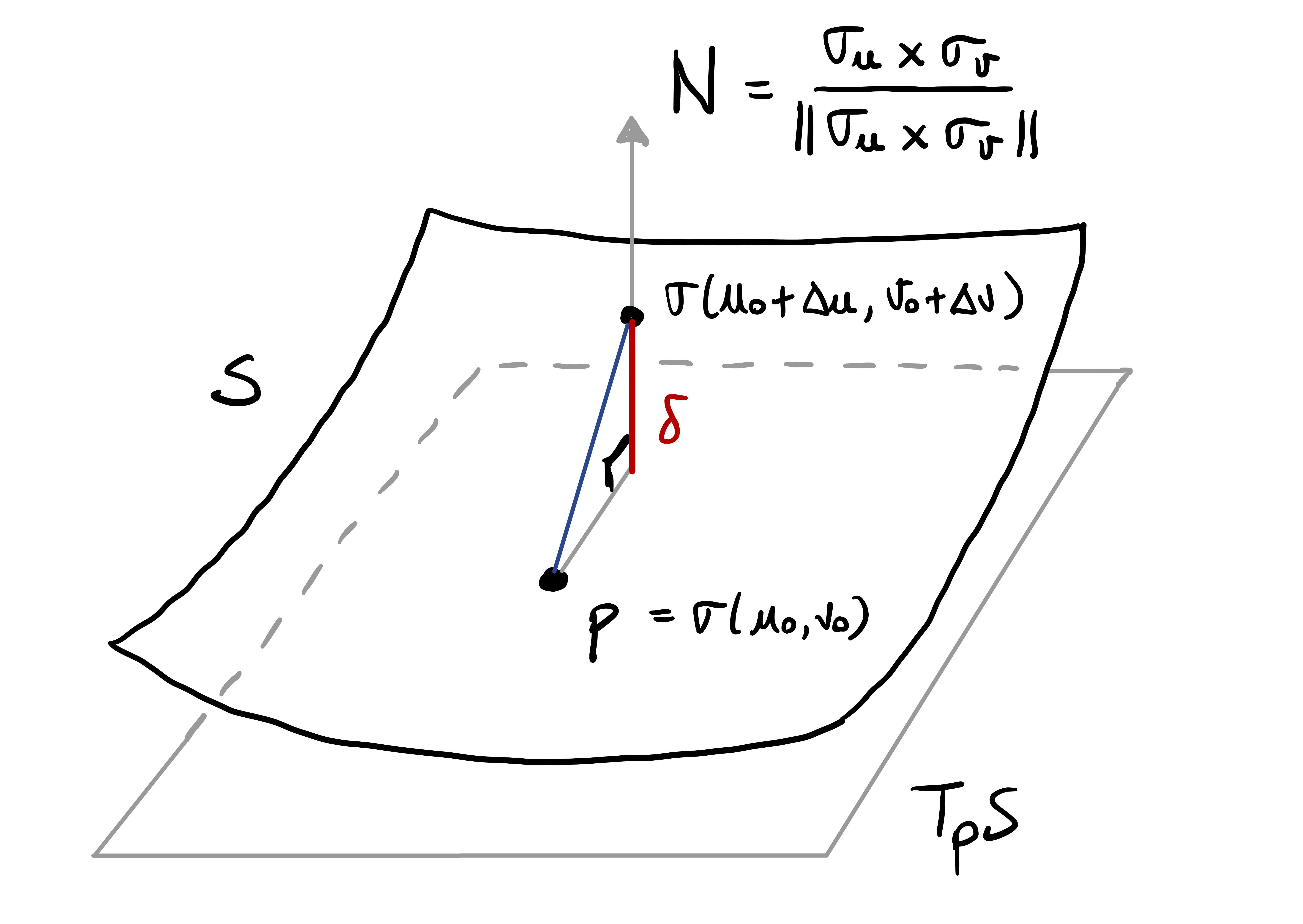
Using Taylor’s formula we get \[\begin{align*} {\pmb{\sigma}}(u_0 + \Delta u , v_0 + \Delta v) & = {\pmb{\sigma}}(u_0,v_0) + {\pmb{\sigma}}_u (u_0,v_0) \, \Delta u + {\pmb{\sigma}}_v (u_0,v_0) \, \Delta v \\ & \,\, + \frac12 \big( {\pmb{\sigma}}_{uu}(u_0,v_0) (\Delta u)^2 + 2 {\pmb{\sigma}}_{uv}(u_0,v_0) \Delta u \Delta v \\ & \,\, +{{\pmb{\sigma}}}_{vv}(u_0,v_0) (\Delta v)^2 \big) + R(\Delta u , \Delta v) \,, \end{align*}\] where \(R(\Delta u , \Delta v)\) is a remainder such that \[ \lim_{\Delta \to 0} \, \frac{R(\Delta u , \Delta v) }{\Delta } = 0 \,, \quad \Delta := (\Delta u)^2 + (\Delta v)^2 \,. \] Since \(\mathbf{N}\) is orthogonal to \({\pmb{\sigma}}_u\) and \({\pmb{\sigma}}_v\), if we multiply the above Taylor expansion by \(\mathbf{N}\), and ignore the remainder, we obtain \[ \delta = \frac12 \left( L (\Delta u)^2 + 2 M \Delta u \Delta v + N (\Delta v)^2 \right) \,, \] where we set \[ L := {\pmb{\sigma}}_{uu} \cdot \mathbf{N}\,, \quad M := {\pmb{\sigma}}_{uv} \cdot \mathbf{N}\,, \quad N := {\pmb{\sigma}}_{vv} \cdot \mathbf{N}\,. \] The expression \[ \mathscr{F}_2 := L \, du^2 + 2 M \,du dv + N \, dv^2 \] is called the second fundamental form of \(\mathcal{S}\). Therefore \(\mathscr{F}_2\) measures how much the surface \(\mathcal{S}\) deviates from being a plane. Let us make this definition precise.
Definition 181: Second fundamental form of a chart
Notation
Let us show that a plane and a cylinder have different second fundamental forms.
Example 182: SFF of Plane
Note: This reflects the intuition that a plane is flat, and therefore there is no curvature.
Solution. We have that \(\mathscr{F}_2 = 0\), since \[\begin{gather*} {\pmb{\sigma}}_u = \mathbf{p}\,, \quad {\pmb{\sigma}}_v = \mathbf{q} \,, \quad {\pmb{\sigma}}_{uu} = {\pmb{\sigma}}_{uv} = {\pmb{\sigma}}_{vv} = {\pmb{0}}\,, \\ L = {\pmb{\sigma}}_{uu} \cdot \mathbf{N}= 0 \,, \quad M = {\pmb{\sigma}}_{uv} \cdot \mathbf{N}= 0 \,, \quad N = {\pmb{\sigma}}_{vv} \cdot \mathbf{N}= 0 \,. \end{gather*}\]
Example 183: SFF of Unit cylinder
Note: This reflects the intuition that the cylinder curves only when moving in the \(u\)-direction. In such direction we are moving on a circle of radius \(1\), therefore we expect the curvature to be \(-1\).
Solution. We have \[\begin{align*} & {\pmb{\sigma}}_u = (-\sin(u),\cos(u), 0 ) &\,& \mathbf{N}= \frac{{\pmb{\sigma}}_u \times {\pmb{\sigma}}_v}{ \left\| {\pmb{\sigma}}_u \times {\pmb{\sigma}}_v \right\| } \\ & {\pmb{\sigma}}_v = (0,0,1) &\,& \, \quad = (\cos(u), \sin(u),0) \\ & {\pmb{\sigma}}_{uu} = (-\cos(u), - \sin(u), 0 ) &\,& L = {\pmb{\sigma}}_{uu} \cdot \mathbf{N}= - 1 \\ & {\pmb{\sigma}}_{uv} = {\pmb{\sigma}}_{vv} = {\pmb{0}} &\,& M = {\pmb{\sigma}}_{uv} \cdot \mathbf{N}= 0 \\ & {\pmb{\sigma}}_u \times {\pmb{\sigma}}_v = (\cos(u), \sin(u),0) &\,& N = {\pmb{\sigma}}_{vv} \cdot \mathbf{N}= 0 \\ & \left\| {\pmb{\sigma}}_u \times {\pmb{\sigma}}_v \right\| = 1 &\,&\mathscr{F}_2 = - du^2 \end{align*}\]
Remark 184
Remark 185: SFF and reparametrizations
Proof
4.12.1 Gauss and Weingarten maps
Another way to quantify how much a surface \(\mathcal{S}\) is curving is by examining the behavior of standard unit normal \(\mathbf{N}\). If \(\mathcal{S}\) is a plane spanned by vectors \(\mathbf{p}\) and \(\mathbf{q}\), then its standard unit normal is \[ \mathbf{N}= \frac{\mathbf{p}\times \mathbf{q}}{ \left\| \mathbf{p}\times \mathbf{q} \right\| } \,, \] which is constant across \(\mathcal{S}\). If \(\mathcal{S}\) is a general surface, measuring the variation of \(\mathbf{N}\) will tell us how much \(\mathcal{S}\) is deviating from being a plane. This is the idea behind the definition of the Gauss and Weingarten maps.
Remark 186
Definition 187: Gauss map
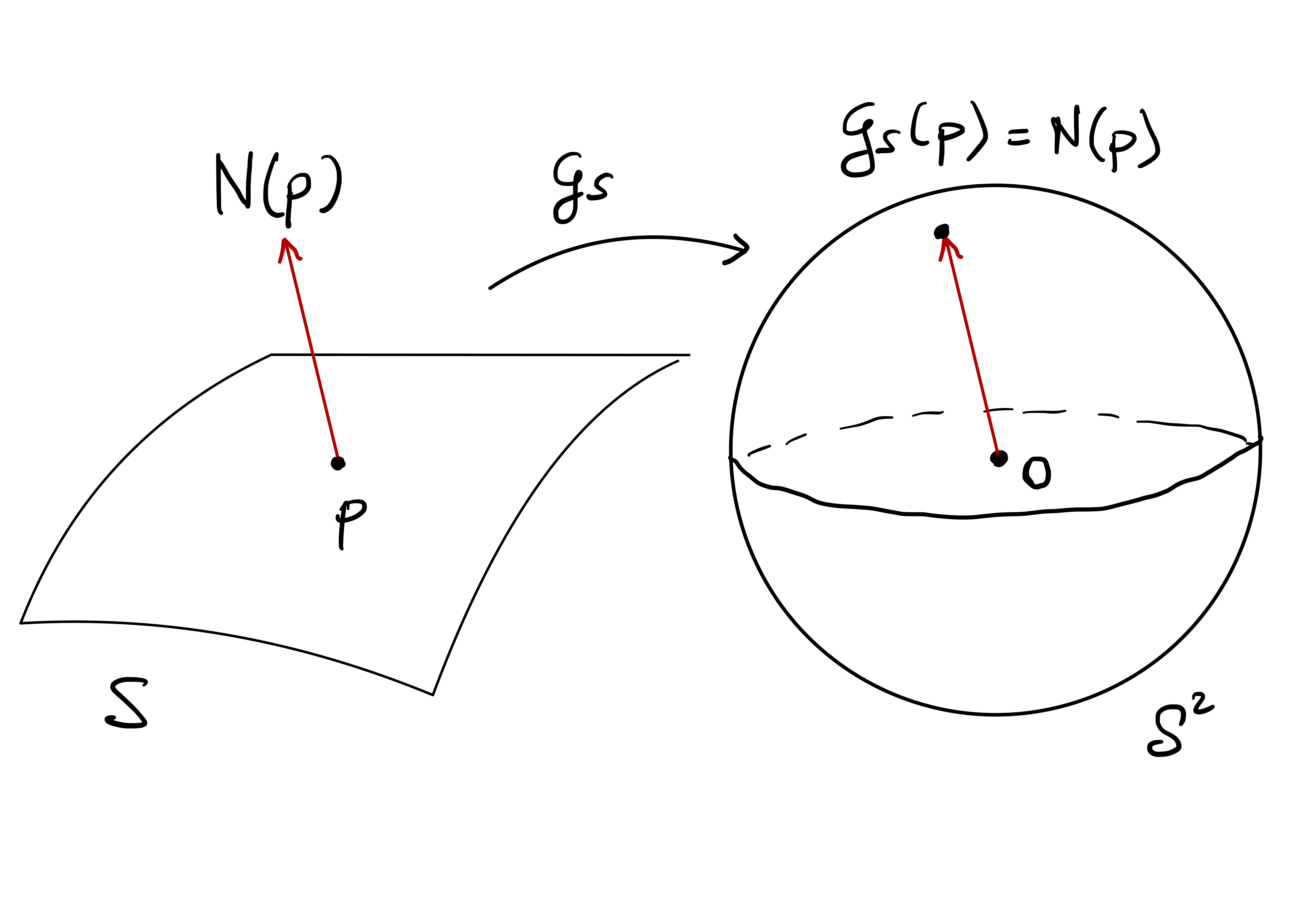
Remark 188
Example 189
Suppose \(\mathcal{S}\) is the unit sphere \(\mathbb{S}^2\). Then \({\mathcal{G}}_{\mathcal{S}} \colon \mathcal{S}\to \mathbb{S}^2\) is the identity, \[ {\mathcal{G}}_{\mathcal{S}} (\mathbf{p}) = \mathbf{p}\,, \] see Figure 4.36.
Let \(\mathbf{a} , \mathbf{v},\mathbf{w}\in \mathbb{R}^3\) with \(\mathbf{v}\) and \(\mathbf{w}\) linearly independent. Let \(\mathcal{S}\) be the plane \[ {\pmb{\sigma}}(u,v):= \mathbf{a} + \mathbf{v}u + \mathbf{\mathbf{w}} v \,, \quad \forall \, (u,v) \in \mathbb{R}^2 \,. \] The Gauss map of \(\mathcal{S}\) is constant: \[ \mathcal{G}_{\mathcal{S}} (\mathbf{p}) = \frac{ {\pmb{\sigma}}_u \times {\pmb{\sigma}}_v }{ \left\| {\pmb{\sigma}}_u \times {\pmb{\sigma}}_v \right\| } = \frac{ \mathbf{v}\times \mathbf{w}}{ \| \mathbf{v}\times \mathbf{w}\| } \,, \] for all \(\mathbf{p}\in \mathcal{S}\), see Figure 4.37.
Let \(\mathcal{S}\) be the unit cylinder \[ {\pmb{\sigma}}(u,v) = (\cos(u), \sin(u), v) \,, \quad (u,v) \in (0,2\pi) \times \mathbb{R}\,. \] We have already compute that the standard unit normal is \[ \mathbf{N}= \frac{ {\pmb{\sigma}}_u \times {\pmb{\sigma}}_v }{ \left\| {\pmb{\sigma}}_u \times {\pmb{\sigma}}_v \right\| } = (\cos(u), \sin(u), 0) \,. \] Therefore, the Gauss map of \(\mathcal{S}\) is \[ \mathcal{G}_{\mathcal{S}} (\mathbf{p}) = (\cos(u_0), \sin(u_0), 0) \,, \] where \((u_0,v_0)\) is such that \({\pmb{\sigma}}(u_0,v_0)=\mathbf{p}\). Note that \(\mathcal{G}_{\mathcal{S}}\) maps \(\mathcal{S}\) into the equator of \(\mathbb{S}^2\), see Figure 4.38.
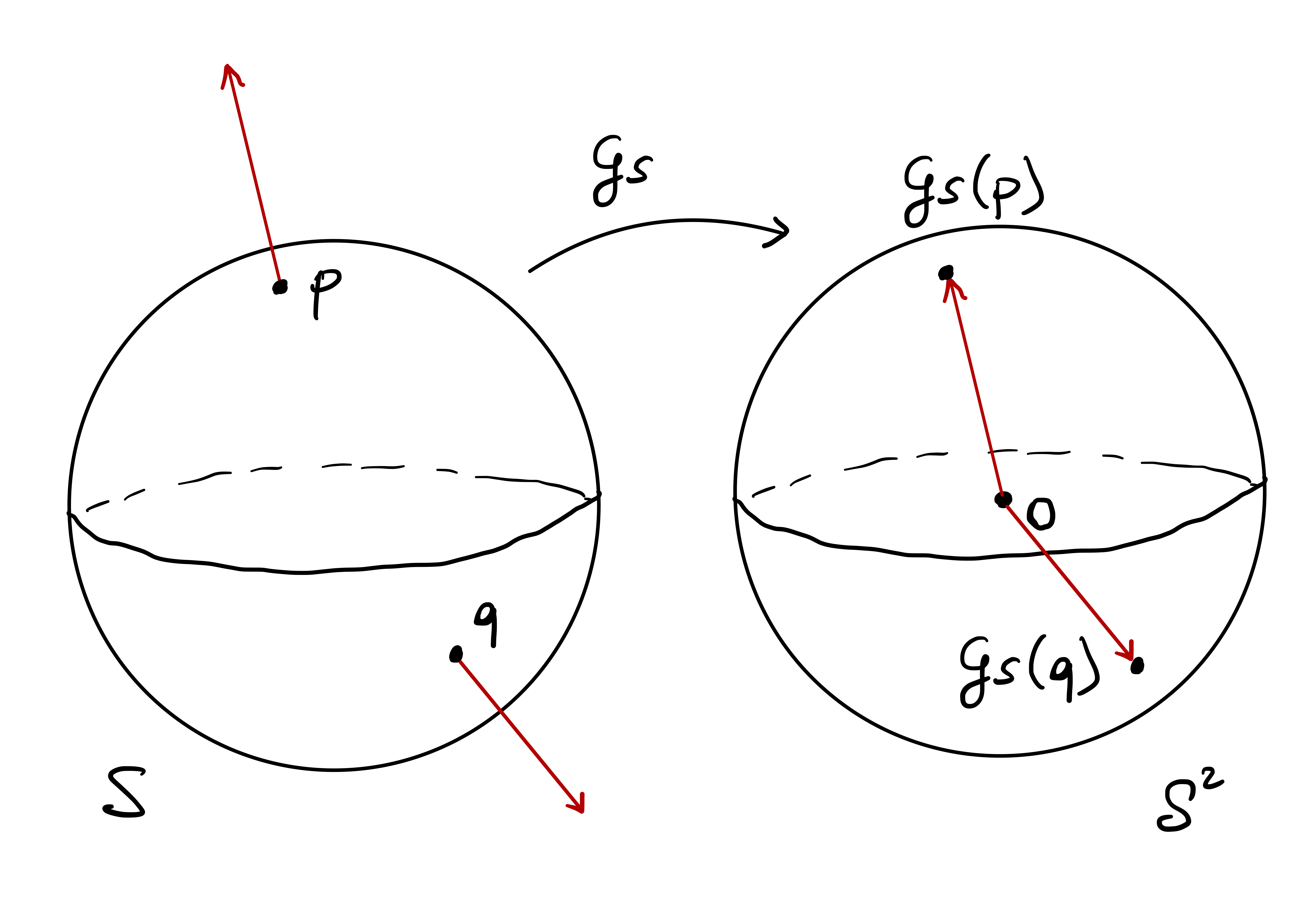
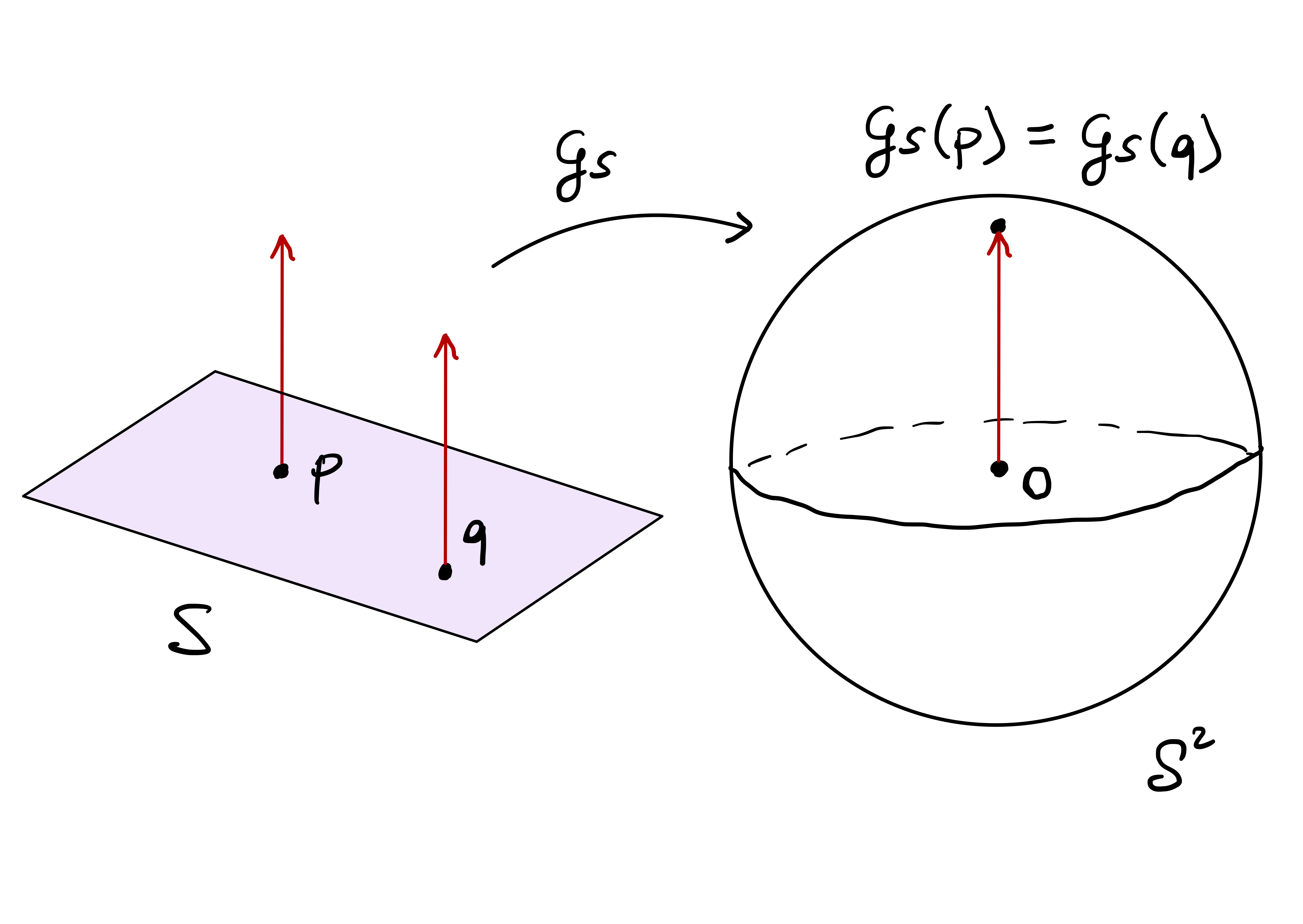
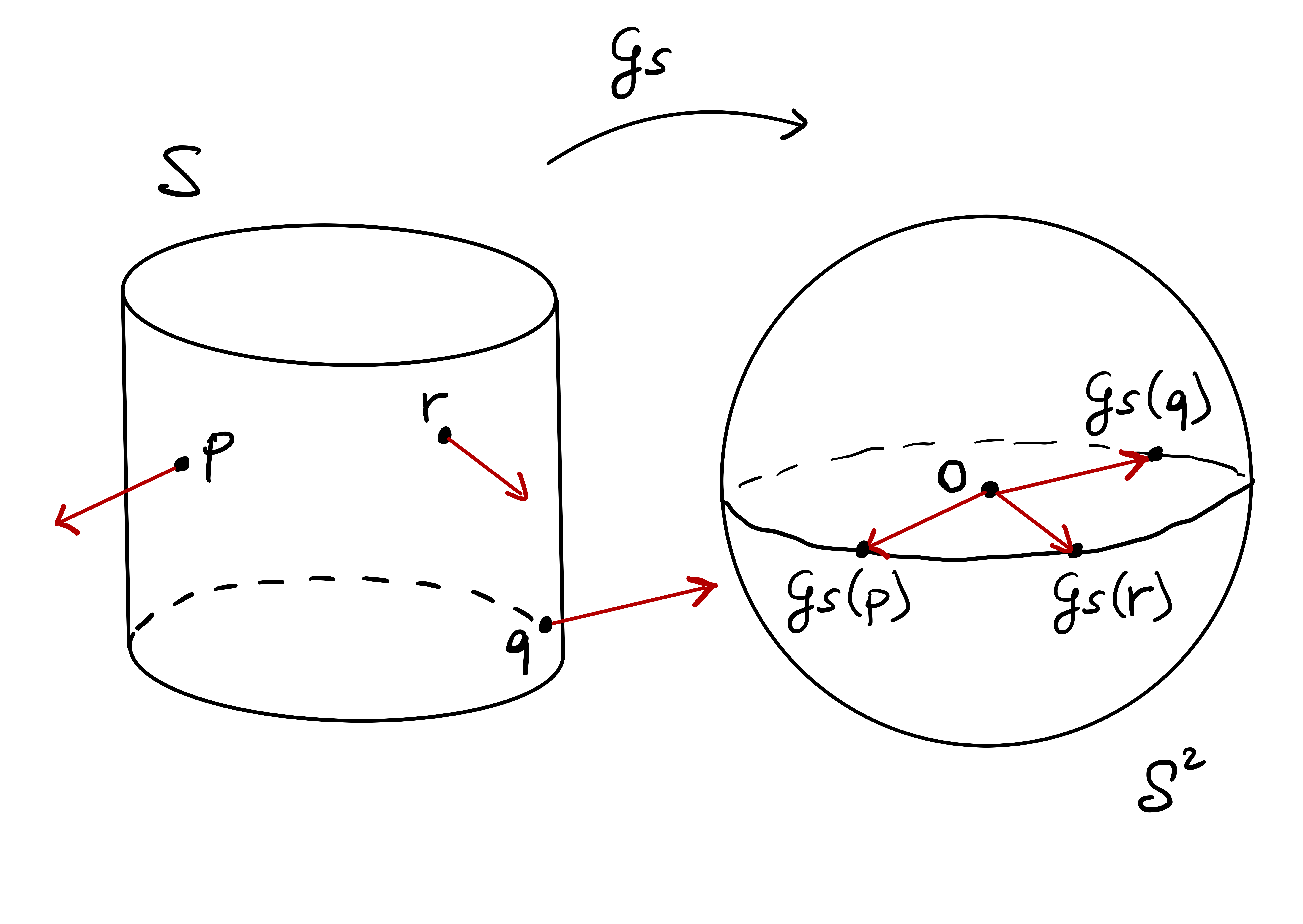
Remark 190
Proof. The tangent plane \(T_{{\mathcal{G}}_{\mathcal{S}}(\mathbf{p})} \mathbb{S}^2\) passes through the origin and \[ \mathcal{G}(\mathbf{p}) \perp T_{{\mathcal{G}}_{\mathcal{S}}(\mathbf{p})} \mathbb{S}^2 \,. \] By definition \(\mathcal{G}(\mathbf{p}) = \mathbf{N}(\mathbf{p})\), and thus \[ \mathbf{N}(\mathbf{p}) \perp T_{{\mathcal{G}}_{\mathcal{S}}(\mathbf{p})} \mathbb{S}^2 \,. \] Since by definition \[ \mathbf{N}(\mathbf{p}) \perp T_{\mathbf{p}} \mathcal{S}\,, \] we infer (4.15).
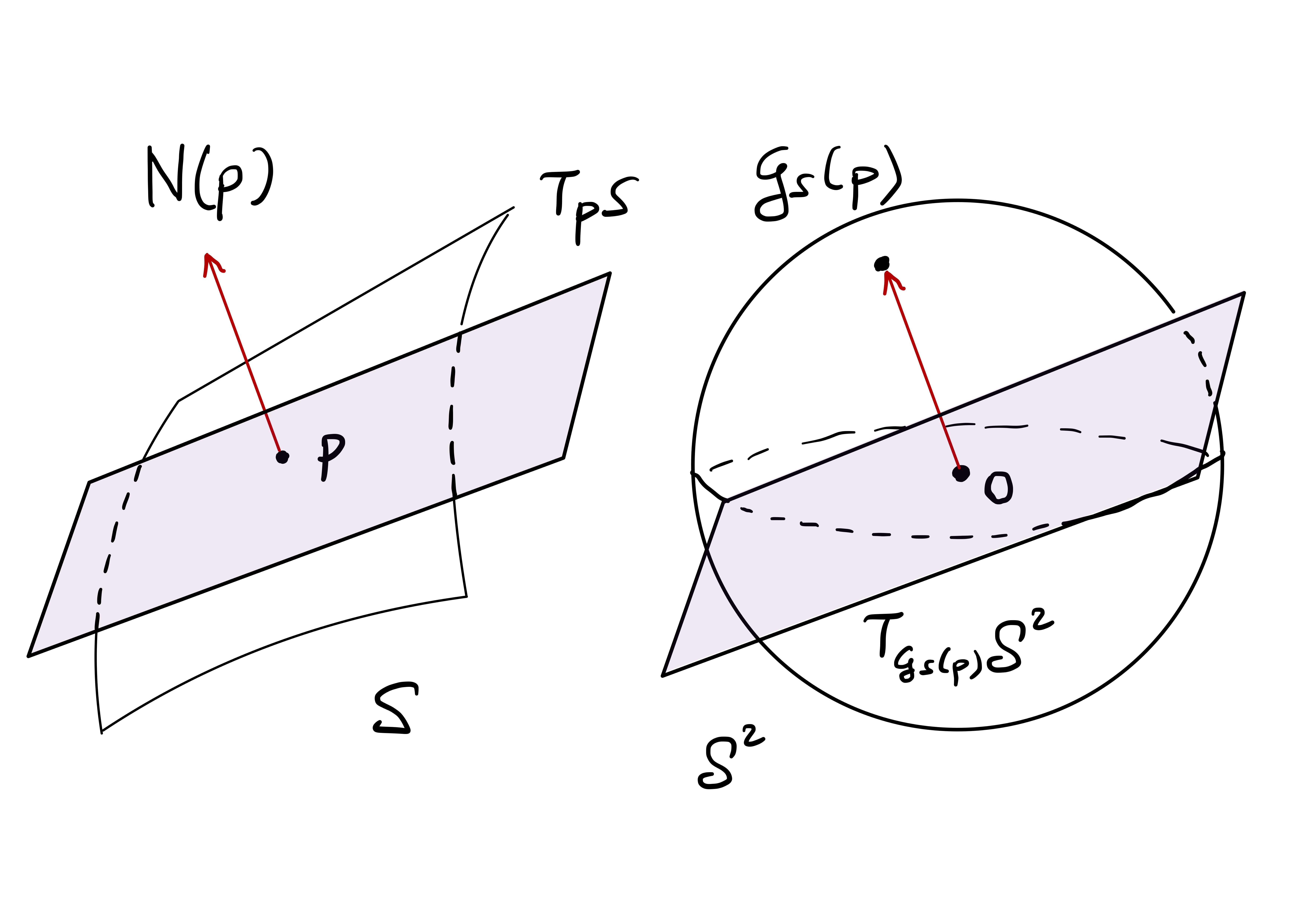
Definition 191: Weingarten map
Important
Remark 192
The Weingarten map allows us to define a bilnear form on \(T_{\mathbf{p}} \mathcal{S}\). We call such bilinear form the second fundamental form of \(\mathcal{S}\).
Definition 193: SFF of a surface
Remark 194
Check. \(\mathcal{W}_{\mathbf{p},\mathcal{S}}\) is linear, being the differential of a smooth map. Hence \(II_{\mathbf{p}}\) is bilinear, given that the scalar product is bilinear.
Remark 195: Matrix of the second fundamental form
Theorem 196: Matrix of the SFF
Let \({\pmb{\sigma}}\colon U \to \mathbb{R}^3\) be regular, \(\mathcal{S}= {\pmb{\sigma}}(U)\), and \(\mathbf{p}\in {\pmb{\sigma}}(U)\). Then
The second funamental form \(II_{\mathbf{p}}\) is a symmetric bilinear map.
It holds \[ II_{\mathbf{p}} (\mathbf{v},\mathbf{w}) = (du (\mathbf{v}), dv(\mathbf{v}) ) \, \left( \begin{array}{cc} L & M \\ M & N \end{array} \right) \, (du(\mathbf{w}) , dv(\mathbf{w}))^T \,, \] for all \(\mathbf{v},\mathbf{w}\in T_{\mathbf{p}} \mathcal{S}\).
\(\mathscr{F}_2\) is the quadratic form associated to \(II_{\mathbf{p}}\), that is, \[ \mathscr{F}_2 (\mathbf{v}) = {II}_{\mathbf{p}} (\mathbf{v},\mathbf{v}) \,, \quad \forall \, \mathbf{v}\in T_{\mathbf{p}} \mathcal{S}\,. \]
To prove Theorem 195 we use the following two Lemmas.
Lemma 197
Proof
Lemma 198
Proof
We can now prove Theorem 195
Proof: Proof of Theorem 195
4.12.2 Matrix of Weingarten map
The Weingarten map is a linear map \[ \mathcal{W}_{\mathbf{p},\mathcal{S}} \colon T_{\mathbf{p}} \mathcal{S}\to T_{\mathbf{p}} \mathcal{S}\,. \] We would like to find a formula to compute \(\mathcal{W}_{\mathbf{p},\mathcal{S}}\). This is easily done: Given a chart \({\pmb{\sigma}}\) at \(\mathbf{p}\), we have that \(\{{\pmb{\sigma}}_u,{\pmb{\sigma}}_v\}\) is a basis for the vector space \(T_{\mathbf{p}} \mathcal{S}\). Therefore, there exists a \(2 \times 2\) matrix \(\mathcal{W}\) which represents \(\mathcal{W}_{\mathbf{p},\mathcal{S}}\). It turns out that \[ \mathcal{W}= \mathscr{F}_1^{-1} \mathscr{F}_2 \,, \] where we recall that \[ \mathscr{F}_1 = \left( \begin{array}{cc} E & F \\ F & G \end{array} \right)\,, \quad \mathscr{F}_2 = \left( \begin{array}{cc} L & M \\ M & N \end{array} \right) \,, \] where \[\begin{align*} E & = {\pmb{\sigma}}_u \cdot {\pmb{\sigma}}_u \,, & F & = {\pmb{\sigma}}_u \cdot {\pmb{\sigma}}_v \, , & G & = {\pmb{\sigma}}_v \cdot {\pmb{\sigma}}_v \,, \\ L & = {\pmb{\sigma}}_{uu} \cdot \mathbf{N}\, , & M & = {\pmb{\sigma}}_{uv} \cdot \mathbf{N}\,, & N & = {\pmb{\sigma}}_{vv} \cdot \mathbf{N}\,, \end{align*}\] and \[ \mathbf{N}= \frac{ {\pmb{\sigma}}_u \times {\pmb{\sigma}}_v }{ \left\| {\pmb{\sigma}}_u \times {\pmb{\sigma}}_v \right\| } \,. \] Let us prove this claim.
Theorem 199: Matrix of Weingarten map
Proof
In particular the matrix \(\mathscr{F}_1\) is invertible, and thus \[ \mathcal{W}= \mathscr{F}_1^{-1} \mathscr{F}_2 \,, \] concluding the proof.
Remark 200: Matrix inverse
Notation
Example 201: Weingarten map of Helicoid
Solution. We compute all the derivatives of \({\pmb{\sigma}}\) \[\begin{align*} & {\pmb{\sigma}}_u = ( \cos(v), \sin(v), 0 ) &\,& {\pmb{\sigma}}_{uv} = (- \sin(v), \cos(v), 0 ) \\ & {\pmb{\sigma}}_v = ( - u \sin(v), u \cos(v), \lambda ) &\,& {\pmb{\sigma}}_{vv} = -u \, ( \cos(v), \sin(v), 0 ) \\ & {\pmb{\sigma}}_{uu} = ( 0, 0, 0 ) \end{align*}\] The FFF and its inverse are \[\begin{align*} & E = {\pmb{\sigma}}_u \cdot {\pmb{\sigma}}_u = 1 &\,& F = {\pmb{\sigma}}_u \cdot {\pmb{\sigma}}_v = 0 \\ & G = {\pmb{\sigma}}_v \cdot {\pmb{\sigma}}_v = u^2 + \lambda^2 \\ & \mathscr{F}_1 = \left( \begin{array}{cc} 1 & 0 \\ 0 & u^2 + \lambda^2 \end{array} \right) &\,& \mathscr{F}_1^{-1} = \left( \begin{array}{cc} 1 & 0 \\ 0 & \dfrac{1}{u^2 + \lambda^2} \end{array} \right) \,. \end{align*}\] The standard unit normal to \({\pmb{\sigma}}\) is \[\begin{align*} & {\pmb{\sigma}}_u \times {\pmb{\sigma}}_v = (\lambda \sin (v), - \lambda \cos(v), u) \\ & \left\| {\pmb{\sigma}}_u \times {\pmb{\sigma}}_v \right\| = \sqrt{u^2 + \lambda^2} \\ & \mathbf{N}= \frac{ {\pmb{\sigma}}_u \times {\pmb{\sigma}}_v }{ \left\| {\pmb{\sigma}}_u \times {\pmb{\sigma}}_v \right\| } = \frac{1}{\sqrt{u^2 + \lambda^2}} \, (\lambda \sin(v), -\lambda \cos(v), u) \,. \end{align*}\] The SFF of \({\pmb{\sigma}}\) is \[\begin{align*} L & = {\pmb{\sigma}}_{uu} \cdot \mathbf{N}= 0 \qquad \qquad M = {\pmb{\sigma}}_{uv} \cdot \mathbf{N}= - \frac{\lambda}{\sqrt{u^2 + \lambda^2}} \\ N & = {\pmb{\sigma}}_{vv} \cdot \mathbf{N}= 0 \\ \mathscr{F}_2 & = \left( \begin{array}{cc} 0 & - \dfrac{\lambda}{\sqrt{u^2 + \lambda^2}} \\ -\dfrac{\lambda}{\sqrt{u^2 + \lambda^2}} & 0 \end{array} \right) \,. \end{align*}\] Finally, the matrix of the Weingarten map is \[\begin{align*} \mathcal{W}= \mathscr{F}_1^{-1} \mathscr{F}_2 = \left( \begin{array}{cc} 0 & - \dfrac{\lambda}{(u^2 + \lambda^2)^{1/2}} \\ -\dfrac{\lambda}{(u^2 + \lambda^2)^{3/2}} & 0 \end{array} \right) \,. \end{align*}\]
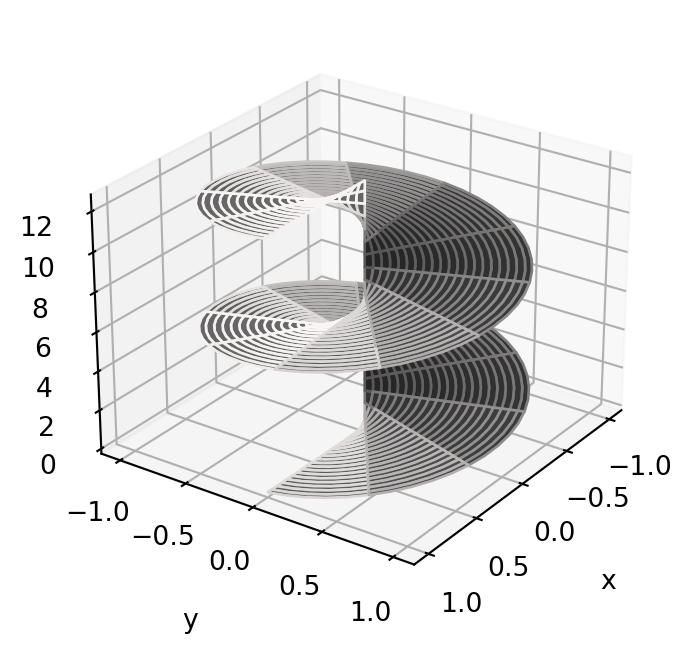
4.13 Curvatures
Curvatures of a surface \(\mathcal{S}\) are scalars associated to the Weingarten map \(\mathcal{W}_{\mathbf{p},\mathcal{S}}\). We will define:
- Gaussian curvature
- Mean curvature
- Principal curvatures
- Normal curvature
- Geodesic curvature
4.13.1 Gaussian and mean curvature
The Weingarten map of \(\mathcal{S}\) encodes the rate of change of the standard unit normal \(\mathbf{N}\). We use this map to produce scalar values, which we call curvatures. The first two curvatures that we consider are called Gaussian and mean curvatures.
Definition 202: Gaussian and mean curvature
Let \(\mathcal{S}\) be an orientable surface. Let \(\mathcal{W}\) be the matrix of the Weingarten map \(\mathcal{W}_{\mathbf{p},\mathcal{S}}\) of \(\mathcal{S}\) at \(\mathbf{p}\). We define:
The Gaussian curvature of \(\mathcal{S}\) at \(\mathbf{p}\) is \[ K := \det (\mathcal{W}) \,, \]
The mean curvature of \(\mathcal{S}\) at \(\mathbf{p}\) is \[ H := \frac12 \, \operatorname{Tr} (\mathcal{W}) \,, \]
Notation: Trace of a matrix
Remark 203
Check. The above is true by a general linear algebra result: The determinant and trace of a matrix are invariant under change of basis.
Since we have shown that the matrix of the Weingarten map is \[ \mathcal{W}= \mathscr{F}_1^{-1} \mathscr{F}_2 \,, \] we can express \(K\) and \(H\) in terms of the first and second fundamental forms.
Proposition 204: Formulas for \(K\) and \(H\)
Proof
Example 205: Curvatures of the Plane
Question. Let \(\mathbf{a}, \mathbf{p}, \mathbf{q} \in \mathbb{R}^3\), with \(\mathbf{p}\), \(\mathbf{q}\) orthonormal. Consider the plane charted by \[ {\pmb{\sigma}}(u,v) = \mathbf{a} + \mathbf{p}u + \mathbf{q} v \,. \]
- Compute the matrix of the Weingarten map of \({\pmb{\sigma}}\).
- Compute the Gaussian and mean curvatures of the plane.
Solution.
From Examples 129, 181, the FFF and SFF of \({\pmb{\sigma}}\) are \[ \mathscr{F}_1 = \left( \begin{array}{cc} 1 & 0 \\ 0 & 1 \end{array} \right) \,, \quad \mathscr{F}_2 = \left( \begin{array}{cc} 0 & 0 \\ 0 & 0 \end{array} \right) \,. \] Therefore the matrix of the Weingarten map is \[ \mathcal{W}= \mathscr{F}_1^{-1} \mathscr{F}_2 = \left( \begin{array}{cc} 0 & 0 \\ 0 & 0 \end{array} \right) \,. \]
The Gaussian and mean curvatures are \[ K = \det (\mathcal{W}) = 0 \,, \qquad H = \frac12 \, \operatorname{Tr} (\mathcal{W}) = 0 \,. \]
Example 206: Curvatures of the Unit cylinder
Question. Consider the unit cylinder \(\mathcal{S}\) charted by \[ {\pmb{\sigma}}(u,v) = (\cos(u), \sin(u), v) \,. \]
- Compute the matrix of the Weingarten map of \({\pmb{\sigma}}\).
- Compute the Gaussian and mean curvatures of \(\mathcal{S}\).
Solution.
From Examples 127, 187, the FFF and SFF of \({\pmb{\sigma}}\) are \[ \mathscr{F}_1 = \left( \begin{array}{cc} 1 & 0 \\ 0 & 1 \end{array} \right) \,, \quad \mathscr{F}_2 = \left( \begin{array}{cc} -1 & 0 \\ 0 & 0 \end{array} \right) \,. \] Therefore the matrix of the Weingarten map is \[ \mathcal{W}= \mathscr{F}_1^{-1} \mathscr{F}_2 = \left( \begin{array}{cc} -1 & 0 \\ 0 & 0 \end{array} \right) \,. \]
The Gaussian and mean curvatures are \[ K = \det (\mathcal{W}) = 0 \,, \qquad H = \frac12 \, \operatorname{Tr} (\mathcal{W}) = - \frac12 \,. \]
4.13.2 Principal curvatures
In order to define the principal curvatures, we need the notions of eigenvalue and eigenvector. For reader’s convenience, we recall them in the next Remark.
Remark 207: Eigenvalues and eigenvectors
Theorem 208: Eigenvalues of Weingarten map
Let \(\mathcal{S}\) be an orientable surface and \({\pmb{\sigma}}\) a regular chart at \(\mathbf{p}\). Let \(\mathcal{W}\) be the matrix of the Weingarten map \(\mathcal{W}_{\mathbf{p},\mathcal{S}}\) with respect to the basis \(\{{\pmb{\sigma}}_u,{\pmb{\sigma}}_v\}\) of \(T_{\mathbf{p}}\mathcal{S}\). Then
There exist scalars \(\kappa_1, \kappa_2 \in \mathbb{R}\) and an orthonormal basis \(\{\mathbf{t}_1,\mathbf{t}_2\}\) of \(T_{\mathbf{p}} \mathcal{S}\) such that \[ \mathcal{W}_{\mathbf{p},\mathcal{S}} (\mathbf{t}_1) = \kappa_1 \mathbf{t}_1 \,, \quad \mathcal{W}_{\mathbf{p},\mathcal{S}} (\mathbf{t}_2) = \kappa_2 \mathbf{t}_2 \,. \]
Let \(\lambda_1, \lambda_2, \mu_1, \mu_2 \in \mathbb{R}\) be such that \[ \mathbf{t}_1 = \lambda_1 {\pmb{\sigma}}_u + \mu_1 {\pmb{\sigma}}_v \,, \quad \mathbf{t}_2 = \lambda_2 {\pmb{\sigma}}_u + \mu_2 {\pmb{\sigma}}_v \,. \] Denote \(\mathbf{x}_1 = (\lambda_1,\mu_1)\) and \(\mathbf{x}_2 = (\lambda_2,\mu_2)\). Then \(\kappa_1,\kappa_2\) are eingenvalues of \(\mathcal{W}\) of eigenvectors \(\mathbf{x}_1\) and \(\mathbf{x}_2\) \[ \mathcal{W}\mathbf{x}_1 = \kappa_1 \mathbf{x}_1 \,, \quad \mathcal{W}\mathbf{x}_2 = \kappa_2 \mathbf{x}_2 \,. \] In particular, the matrix \(\mathcal{W}\) is diagonalizable, with \[ \mathcal{W}= P^{-1} D P , \quad D = \left( \begin{array}{cc} \kappa_1 & 0 \\ 0 & \kappa_2 \end{array} \right) \,, \quad P = \left( \begin{array}{cc} \lambda_1 & \lambda_2 \\ \mu_1 & \mu_2 \end{array} \right) \,. \]
Proof
Part 2. We have just proven that \[ \mathcal{W}_{\mathbf{p},\mathcal{S}} (\mathbf{t}_1) = \kappa_1 \mathbf{t}_1 \,, \quad \mathcal{W}_{\mathbf{p},\mathcal{S}} (\mathbf{t}_2) = \kappa_2 \mathbf{t}_2 \,. \] As \(\mathcal{W}\) is the matrix of \(\mathcal{W}_{\mathbf{p},\mathcal{S}}\) and \(\mathbf{x}_1\), \(\mathbf{x}_2\) are the coordinates of \(\mathbf{t}_1,\mathbf{t}_2\), we infer \[ \mathcal{W}\mathbf{x}_1 = \kappa_1 \mathbf{x}_1 \,, \quad \mathcal{W}\mathbf{x}_2 = \kappa_2 \mathbf{x}_2 \,, \] showing that \(\kappa_i\) is eigenvalue of \(\mathcal{W}\) with eigenvector \(\mathbf{x}_i\). In particular, it follows that \(\mathcal{W}\) is diagonal in the basis \(\{\mathbf{x}_1,\mathbf{x}_2\}\) of \(\mathbb{R}^2\). Therefore \(\mathcal{W}= P^{-1} D P\), with \(D\) and \(P\) as in the statement.
The principal curvatures are the eigenvalues of the matrix of the Weingarten map, and the principal vectors its eigenvectors.
Definition 209: Principal curvatures and vectors
Let \(\mathcal{S}\) be an orientable surface. Let \(\mathcal{W}_{\mathbf{p},\mathcal{S}}\) the Weingarten map of \(\mathcal{S}\) at \(\mathbf{p}\). We define:
The principal curvatures of \(\mathcal{S}\) at \(\mathbf{p}\) are the eigenvalues \(\kappa_1, \kappa_2\) of \(\mathcal{W}_{\mathbf{p},\mathcal{S}}\).
The principal vectors corresponding to \(\kappa_1\) and \(\kappa_2\) are the eigenvectors \(\mathbf{t_1}, \mathbf{t}_2\) of \(\mathcal{W}_{\mathbf{p},\mathcal{S}}\).
Theorem 207 gives an explicit way to compute the principal curvatures and vectors.
Remark 210: Computing principal curvatures and vectors
Let \({\pmb{\sigma}}\colon U \to \mathbb{R}^3\) be a regular chart and \(\mathcal{S}= {\pmb{\sigma}}(U)\).
Compute the FFF and SFF of \({\pmb{\sigma}}\), and the matrix of the Weingarten map \[ \mathcal{W}= \mathscr{F}_{1}^{-1} \mathscr{F}_2 \,. \]
Compute the eigenvalues of \(\mathcal{W}\), by solving for \(\lambda\) the equation \[ \det(\mathcal{W}- \lambda I) = 0 \,. \] The two solutions are the principal curvatures \(\kappa_1\) and \(\kappa_2\).
Find scalars \(\lambda\), \(\mu\) which solve the linear system \[ (\mathcal{W}- \kappa_i I) \left( \begin{array}{c} \lambda \\ \mu \end{array} \right) = 0 \,. \] The solution(s) gives the eigenvector(s) of \(\mathcal{W}\) \[ \mathbf{x}_i = (\lambda,\mu) \] corresponding to the eigenvalue \(\kappa_i\).
The principal vector(s) associated to \(\kappa_i\) is
\[ \mathbf{t}_i = \lambda {\pmb{\sigma}}_u + \mu {\pmb{\sigma}}_v \]
Remark 211: The case of \(\mathcal{W}\) diagonal
The principal curvatures are related to the Gaussian and mean curvatures.
Proposition 212: Relationships between curvatures
Proof
Part 2. The trace satisfies \[ \operatorname{Tr} \left( A B \right) = \operatorname{Tr} \left( BA \right) \,, \quad \forall \, A,B \in \mathbb{R}^{2 \times 2} \,. \] By definition of mean curvature and the above formula we get \[\begin{align*} H & = \frac12 \operatorname{Tr} (\mathcal{W}) \\ & = \frac12 \operatorname{Tr} \left( P^{-1} D P \right) \\ & = \frac12 \operatorname{Tr} \left( P P^{-1} D \right) \\ & = \frac12 \operatorname{Tr} \left( D \right) \\ & = \frac{1}{2} \left( \kappa_1 + \kappa_2 \right) \,. \end{align*}\]
Part 3. For any matrix \(A \in \mathbb{R}^{2 \times 2}\), we have \[\begin{align*} \det(A - \lambda I) & = \det \left( \begin{array}{cc} a - \lambda & b \\ c & d - \lambda \end{array} \right) \\ & = (a-\lambda)(d-\lambda) - bc \\ & = \lambda^2 - (a + d) \lambda + ad-bc \\ & = \lambda^2 - \operatorname{Tr}(A) \lambda + \det(\lambda) \,. \end{align*}\] If \(A = \mathcal{W}\), we obtain \[ \det (\mathcal{W}- \lambda I) = \lambda^2 - 2 H \lambda + K \,. \] Therefore, the principal curvatures are \[ \kappa_i = H \pm \sqrt{H^2 - K} \,. \]
Example 213: Principal curvatures of Unit Cylinder
Solution. By Example 210, the matrix of the Weingarten map is \[ \mathcal{W}= \left( \begin{array}{cc} -1 & 0 \\ 0 & 0 \end{array} \right) \,. \] Since \(\mathcal{W}\) is diagonal, the eigenvalues are the diagonal entries of \(\mathcal{W}\) and the eigenvectors are \[ \mathbf{x}_1 = (1,0), \quad \mathbf{x}_2 = (0,1) \,. \] Therefore, the principal curvatures and principal vectors are \[\begin{align*} & \kappa_1 = - 1 \,, \quad \kappa_2 = 0 \,,\\ & \mathbf{t}_1 = {\pmb{\sigma}}_u = (-\sin(u),\cos(v),0) \,,\\ & \mathbf{t}_2 = {\pmb{\sigma}}_v = (0,0,1)\,, \end{align*}\] as shown in Figure 4.41.
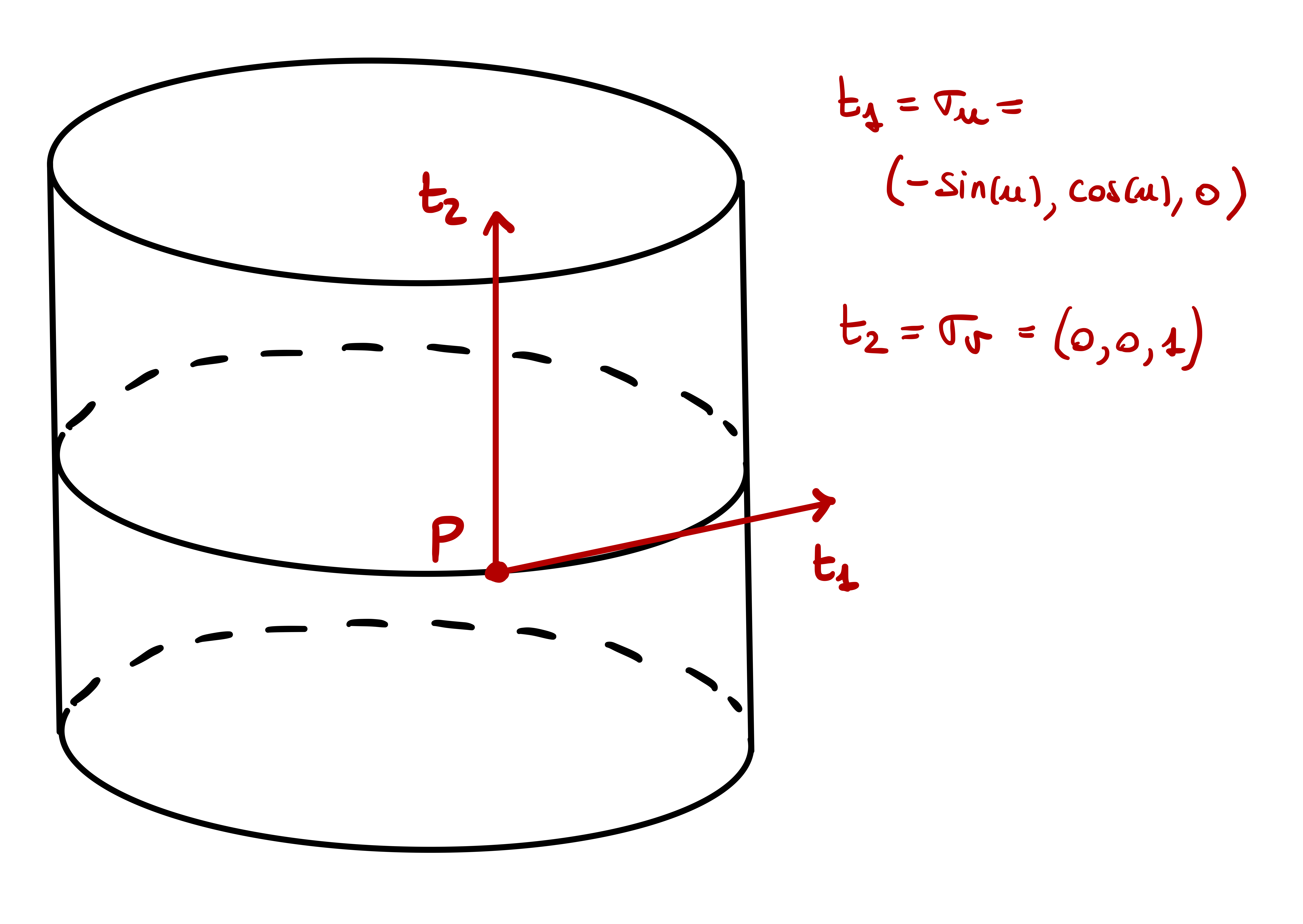
Example 214: Curvatures of Sphere
Solution. Compute the FFF of \({\pmb{\sigma}}\) \[\begin{align*} {\pmb{\sigma}}_u & = (-\sin(u)\cos(v), \cos(u)\cos(v),0) \\ {\pmb{\sigma}}_v & = (-\cos(u)\sin(v), -\sin(u)\sin(v), \cos(v)) \\ E & = {\pmb{\sigma}}_u \cdot {\pmb{\sigma}}_u = \cos^2(v) \\ F & = {\pmb{\sigma}}_u \cdot {\pmb{\sigma}}_v = 0\\ G & = {\pmb{\sigma}}_v \cdot {\pmb{\sigma}}_v = 1 \\ \mathscr{F}_1 & = \left( \begin{array}{cc} \cos^2(v) & 0 \\ 0 & 1 \end{array} \right) \,. \end{align*}\] Moreover \[\begin{align*} {\pmb{\sigma}}_u \times {\pmb{\sigma}}_v & = (\cos(u)\cos^2(v), \sin(u) \cos^2(v), \cos(v)\sin(v)) \\ \| {\pmb{\sigma}}_u \times {\pmb{\sigma}}_v \| & = |\cos(v)| = \cos(v) \,, \end{align*}\] where we used that \(\cos(v)>0\) since \(v \in (-\pi/2,\pi/2)\). Therefore, \[\begin{align*} \mathbf{N}& = (\cos(u) \cos(v), \sin(u)\cos(v), \sin(v) ) \\ {\pmb{\sigma}}_{uu} & = (-\cos(u)\cos(v), -\sin(u)\cos(v), 0 ) \\ {\pmb{\sigma}}_{uv} & = (\sin(u)\sin(v), -\cos(u)\sin(v), 0 ) \\ {\pmb{\sigma}}_{vv} & = (-\cos(u)\cos(v), -\sin(u)\cos(v), -\sin(v) ) \\ L & = {\pmb{\sigma}}_{uu} \cdot \mathbf{N}= \cos^{2}(v) \\ M & ={\pmb{\sigma}}_{uv} \cdot \mathbf{N}= 0 \\ N & = {\pmb{\sigma}}_{vv} \cdot \mathbf{N}= 1 \end{align*}\] Hence, the SFF and matrix of the Weingarten map are \[ \mathscr{F}_2 = \left( \begin{array}{cc} \cos^2(v) & 0 \\ 0 & 1 \end{array} \right) \,, \quad \mathcal{W}= \mathscr{F}_1^{-1} \mathscr{F}_2 = \left( \begin{array}{cc} 1 & 0 \\ 0 & 1 \end{array} \right) \,. \] Since \(\mathcal{W}\) is diagonal, the principal curvatures and vectors are \[ \kappa_1 = \kappa_2 = 1 \,, \quad \mathbf{t}_1 = {\pmb{\sigma}}_u \,, \quad \mathbf{t}_2 = {\pmb{\sigma}}_v \,. \] Finally, the mean and Gaussian curvatures are \[ H = \frac{\kappa_1 + \kappa_2}{2} = 1 \,, \quad K= \kappa_1 \kappa_2 = 1 \,. \]
Example 215: Curvatures of the Torus
4.13.3 Normal and geodesic curvatures
Let \(\mathcal{S}\) be a regular surface and consider all the curves \({\pmb{\gamma}}\) on \(\mathcal{S}\) passing through the point \(\mathbf{p}\in \mathcal{S}\). The shape of \(\mathcal{S}\) at \(\mathbf{p}\) influences the curvature of such curves.
Question 216
We start our analysis with the following Definition.
Definition 217: Darboux frame
Proposition 218: Darboux frame is orthonormal basis
Proof
Important
Proposition 219: Coefficients of \(\ddot{{\pmb{\gamma}}}\) in the Darboux frame
Proof
Part 2. Taking the scalar product of (4.17) with \(\mathbf{N}\) yields \[ \ddot{{\pmb{\gamma}}}\cdot \mathbf{N}= \kappa_n \left\| \mathbf{N} \right\|^2 + \kappa_g \left( \mathbf{N}\times \dot{{\pmb{\gamma}}}\right) \cdot \mathbf{N}= \kappa_n \,, \] where we used that \(\mathbf{N}\) and \(\mathbf{N}\times \dot{{\pmb{\gamma}}}\) are orthonormal vectors. Similarly, taking the scalar product of (4.17) with \(\mathbf{N}\times \dot{{\pmb{\gamma}}}\) yields the second equation in (4.18).
Part 3. By (4.17) we infer \[\begin{align*} \left\| \ddot{{\pmb{\gamma}}} \right\|^2 & = \kappa_n^2 \left\| \mathbf{N} \right\|^2 + 2 \kappa_n \kappa_g \mathbf{N}\cdot \left(\mathbf{N}\times \dot{{\pmb{\gamma}}}\right) + \kappa_g^2 \left\| \mathbf{N}\times \dot{{\pmb{\gamma}}} \right\|^2 \\ & = \kappa_n^2 + \kappa_g^2 \,, \end{align*}\] where we used that \(\mathbf{N}\) and \(\mathbf{N}\times \dot{{\pmb{\gamma}}}\) are orthonormal. Since \[ \kappa(t) = \left\| \ddot{{\pmb{\gamma}}}(t) \right\| \,, \] we conclude (4.19).
Part 4. Recalling that \[ \ddot{{\pmb{\gamma}}}= \kappa \mathbf{n}\,, \] from the first equation in (4.18) we obtain \[\begin{align*} \kappa_n & = \ddot{{\pmb{\gamma}}}\cdot \mathbf{N}\\ & = \kappa \mathbf{n}\cdot \mathbf{N}\\ & = \kappa \| \mathbf{n}\| \| \mathbf{N}\| \cos(\phi) \\ & = \kappa \cos(\phi) \,, \end{align*}\] where we used that \(\mathbf{n}\) and \(\mathbf{N}\) have unit norm. Hence, the first equation in (4.20) is established. By (4.19) we get \[\begin{align*} \kappa_g^2 & = \kappa^2 - \kappa_n^2 \\ & = \kappa^2 - \kappa^2 \cos^2(\phi) \\ & = \kappa^2 (1 - \cos^2(\phi)) \\ & = \kappa^2 \sin^2(\phi) \,, \end{align*}\] from which we obtain the second equation in (4.20).
The quantities \(\kappa_n\) and \(\kappa_g\) are the normal and geodesic curvatures of \({\pmb{\gamma}}\).
Definition 220: Normal and geodesic curvatures
Let \(\mathcal{S}\) be regular and \({\pmb{\gamma}}\colon (a,b) \to \mathcal{S}\) a unit-speed curve. Let \(\mathbf{N}\) bet the standard unit normal to \(\mathcal{S}\).
The normal curvature of \({\pmb{\gamma}}\) is \[ \kappa_n = \ddot{{\pmb{\gamma}}}\cdot \mathbf{N}\,, \]
The geodesic curvature of \({\pmb{\gamma}}\) is \[ \kappa_g = \ddot{{\pmb{\gamma}}}\cdot (\mathbf{N}\times \dot{{\pmb{\gamma}}}) \,. \]
In particular:
- The normal curvature is the curvature of \({\pmb{\gamma}}\) forced by being on the surface.
- The geodesic curvature is the residual curvature.
The normal curvature \(\kappa_n\) can be computed via the second fundamental form, as shown in the theorem below.
Theorem 221: Computing \(\kappa_n\) with SFF
Let \(\mathcal{S}\) be a regular surface and \({\pmb{\gamma}}\colon (a,b) \to \mathcal{S}\) a unit-speed curve. Denote \(\mathbf{p}:= {\pmb{\gamma}}(t)\). We have:
The normal curvature \(\kappa_n\) satisfies \[ \kappa_n = {II}_{\mathbf{p}} (\dot{{\pmb{\gamma}}}, \dot{{\pmb{\gamma}}}) \,. \]
Let \({\pmb{\sigma}}\) be a chart for \(\mathcal{S}\) at \(\mathbf{p}= {\pmb{\gamma}}(t)\). Then \[ {\pmb{\gamma}}(t)={\pmb{\sigma}}(u(t), v(t)) \] for some smooth functions \(u,v \colon (a,b) \to \mathbb{R}\), and \[ \kappa_{n}=L \dot{u}^{2}+2 M \dot{u} \dot{v}+N \dot{v}^{2} \,, \] where \(L,M,N\) are evaluated at \((u(t),v(t))\), and \(\dot{u},\dot{v}\) at \(t\).
Proof
Part 2. Let \({\pmb{\sigma}}\) be a chart at \(\mathbf{p}\) and \[ {\pmb{\gamma}}(t) = {\pmb{\sigma}}(u(t),v(t)) \,. \] Differentiating the above expression we get \[ \dot{{\pmb{\gamma}}}(t) = \dot{u} {\pmb{\sigma}}_u + \dot{v} {\pmb{\sigma}}_v \,. \] By definition of \(du\) and \(dv\), see Definition 121, we have \[ du(\dot{{\pmb{\gamma}}}(t)) = \dot{u}(t) \,, \quad dv(\dot{{\pmb{\gamma}}}(t)) = \dot{v}(t) \,. \] Therefore, using Part 1 and Theorem 195, we obtain \[\begin{align*} \kappa_n & = II_{\mathbf{p}} (\dot{{\pmb{\gamma}}}(t) , \dot{{\pmb{\gamma}}}(t) ) \\ & = L du(\dot{{\pmb{\gamma}}}(t))^2 + 2M du(\dot{{\pmb{\gamma}}}(t)) dv(\dot{{\pmb{\gamma}}}(t)) + N dv(\dot{{\pmb{\gamma}}}(t))^2 \\ & = L \dot{u}^{2}+2 M \dot{u} \dot{v}+N \dot{v}^{2} \,. \end{align*}\]
Example 222: Curves on the sphere
Solution. Let \({\pmb{\gamma}}(t)={\pmb{\sigma}}(u(t), v(t))\) be a unit-speed curve on \(\mathbb{S}^2\). Differentiating, we get Differentiating, we get \[\begin{align*} \dot{{\pmb{\gamma}}}(t) & = \frac{d}{dt} ( \cos(u(t)) \cos(v(t)), \sin(u(t)) \cos(v(t)), \sin(v(t)) ) \\ & = (-\dot{u} \sin (u) \cos (v)-\dot{v} \cos (u) \sin (v), \\ & \qquad \dot{u} \cos (u) \cos (v)- \dot{v} \sin (u) \sin (v),\\ & \qquad \dot{v} \cos (v)) \\ \| \dot{{\pmb{\gamma}}}(t) \|^2 & = \cos^{2}(v) \dot{u}^{2}+\dot{v}^{2} \,. \end{align*}\] Since \({\pmb{\gamma}}\) is unit-speed, we have \(\left\| \dot{{\pmb{\gamma}}} \right\| = 1\). Therefore, \[ \cos^{2}(v) \dot{u}^{2}+\dot{v}^{2} = 1 \,. \] By Example 214, the coefficients of the SFF of \({\pmb{\sigma}}\) are \[ L = \cos^{2}(v), \quad M = 0 , \quad N = 1\,. \] By Theorem 220, the normal curvature of \({\pmb{\gamma}}\) is \[\begin{align*} \kappa_{n} = L \dot{u}^{2}+2 M \dot{u} \dot{v}+N \dot{v}^{2} = \cos^{2}(v) \dot{u}^{2}+\dot{v}^{2} = 1 \,. \end{align*}\]
The normal curvature \(\kappa_n\) is related to the principal curvatures \(\kappa_1\) and \(\kappa_2\).
Theorem 223: Euler’s Theorem
Proof
As an immediate corollary of the Euler’s Theorem we get the next statement.
Corollary 224
Let \(\mathcal{S}\) be a regular surface and \(\kappa_1, \kappa_2\) its principal curvatures at \(\mathbf{p}\) with principal vectors \(\mathbf{t}_1,\mathbf{t}_2\). Then:
\(\kappa_{1}\) and \(\kappa_{2}\) are the minimum and maximum values of \(\kappa_{n}\), for all unit-speed curves on \(\mathcal{S}\) passing through \(\mathbf{p}\).
The directions of lowest and highest curvature on \(\mathcal{S}\) are given by \(\mathbf{t}_1\) and \(\mathbf{t}_2\).
In Example 222, we have shown by direct calculation that \[ \kappa_n = 1 \] for all unit-speed curves on the sphere. Thanks to Euler’s Theorem, we can obtain the same result in a quicker way.
Example 225: Curves on the sphere (again)
Solution. By Example 214, the principal curvatures of the unit sphere are \(\kappa_1 = \kappa_2 = 1\). By Euler’s Theorem, for any unit-speed curve \({\pmb{\gamma}}\) on the sphere we have \[ \kappa_n = \kappa_1 \cos^2(\theta) + \kappa_2 \sin^2(\theta) = \cos^2(\theta) + \sin^2(\theta) =1 \,. \]
We have only defined normal and geodesic curvatures for unit-speed curves. We now extend the definition to regular curves.
Definition 226: \(\kappa_n\) and \(\kappa_g\) for regular \({\pmb{\gamma}}\)
It is immediate to check that \(\kappa_n\) and \(\kappa_g\), as defined above, do not depend on the choice of unit-speed reparametrization. Therefore, \(\widetilde{{\pmb{\gamma}}}\) can be taken as the arc-length reparametrization of \({\pmb{\gamma}}\). The next Theorem gives practical formulas to compute \(\kappa_n\) and \(\kappa_g\).
Theorem 227: Formulas for \(\kappa_n\) and \(\kappa_g\)
Let \(\mathcal{S}\) be regular, and \({\pmb{\gamma}}\colon (a,b) \to \mathcal{S}\) a regular curve.
- The normal and geodesic curvatures of \({\pmb{\gamma}}\) are given by
\[ \kappa_n = \frac{\ddot{{\pmb{\gamma}}}\cdot \mathbf{N}}{\left\| \dot{{\pmb{\gamma}}} \right\|^2} \,, \qquad \kappa_g = \frac{ \ddot{{\pmb{\gamma}}}\cdot \left( \mathbf{N}\times \dot{{\pmb{\gamma}}}\right) }{\left\| \dot{{\pmb{\gamma}}} \right\|^3} \,. \]
Denote by \(\kappa\) the curvature of \({\pmb{\gamma}}\). It holds \[ \kappa^2 = \kappa_n^2 + \kappa_g^2 \,. \]
Let \({\pmb{\sigma}}\) be a chart for \(\mathcal{S}\) at \(\mathbf{p}= {\pmb{\gamma}}(t)\). Then \[ {\pmb{\gamma}}(t) = {\pmb{\sigma}}(u(t),v(t)) \] for some smooth functions \(u,v \colon (a,b) \to \mathbb{R}\), and \[ \kappa_n = \frac{II_{\mathbf{p}}(\dot{{\pmb{\gamma}}},\dot{{\pmb{\gamma}}})}{I_{\mathbf{p}}(\dot{{\pmb{\gamma}}},\dot{{\pmb{\gamma}}})} = \frac{L\dot{u}^2 + 2M \dot{u}\dot{v} + N \dot{v}^2}{E\dot{u}^2 + 2F \dot{u}\dot{v} + G \dot{v}^2} \,, \tag{4.25}\] with \(E,F,G,L,M,N\) evaluated at \((u(t),v(t))\), and \(\dot{u},\dot{v}\) at \(t\).
Proof
Part 2. Recall that the curvature of \({\pmb{\gamma}}\) is defined by \[ \kappa(t) = \widetilde{\kappa}(s(t)) \,, \] where \(\widetilde{\kappa}\) is the curvature of \(\widetilde{{\pmb{\gamma}}}\). By (4.19) we have that \[ \widetilde{\kappa}^2(s) = \widetilde{\kappa}^2_n(s) + \widetilde{\kappa}^2_g(s)\,. \] Therefore, \[\begin{align*} \kappa^2 (t) & = \widetilde{\kappa}^2 (s(t)) \\ & = \widetilde{\kappa}^2_n(s(t)) + \widetilde{\kappa}^2_g(s(t)) \\ & = \kappa_n^2(t) + \kappa_g^2(t) \,. \end{align*}\]
Part 3. Arguing as in the proof of Theorem 220, we observe that \[ \dot{{\pmb{\gamma}}}(t) \cdot \mathbf{N}({\pmb{\gamma}}(t))= 0 \,, \] since \(\dot{{\pmb{\gamma}}}(t) \in T_{\mathbf{p}} \mathcal{S}\) when \(\mathbf{p}= {\pmb{\gamma}}(t)\), and \(\mathbf{N}({\pmb{\gamma}}(t))\) is orthogonal to \(T_{\mathbf{p}}\mathcal{S}\). Differentiating, we get \[\begin{align*} 0 & = \frac{d}{dt} \left[\dot{{\pmb{\gamma}}}(t) \cdot \mathbf{N}({\pmb{\gamma}}(t)) \right] \\ & = \ddot{{\pmb{\gamma}}}(t) \cdot \mathbf{N}({\pmb{\gamma}}(t)) + \dot{{\pmb{\gamma}}}(t) \cdot (\mathbf{N}\circ {\pmb{\gamma}})'(t) \\ & = \ddot{{\pmb{\gamma}}}(t) \cdot \mathbf{N}({\pmb{\gamma}}(t)) + \dot{{\pmb{\gamma}}}(t) \cdot d_{\mathbf{p}} \mathbf{N}(\dot{{\pmb{\gamma}}}(t)) \\ & = \ddot{{\pmb{\gamma}}}(t) \cdot \mathbf{N}({\pmb{\gamma}}(t)) + \dot{{\pmb{\gamma}}}(t) \cdot d_{\mathbf{p}} \mathcal{G} (\dot{{\pmb{\gamma}}}(t)) \\ & = \ddot{{\pmb{\gamma}}}(t) \cdot \mathbf{N}({\pmb{\gamma}}(t)) - \dot{{\pmb{\gamma}}}(t) \cdot \mathcal{W}_{\mathbf{p},\mathcal{S}} (\dot{{\pmb{\gamma}}}(t)) \\ \end{align*}\] from which we obtain \[ \mathcal{W}_{\mathbf{p},\mathcal{S}} (\dot{{\pmb{\gamma}}}(t)) \cdot \dot{{\pmb{\gamma}}}(t) = \ddot{{\pmb{\gamma}}}(t) \cdot \mathbf{N}({\pmb{\gamma}}(t)) \,. \] Therefore, by definition of second fundamental form, we infer \[ II_{\mathbf{p}} (\dot{{\pmb{\gamma}}},\dot{{\pmb{\gamma}}}) = \mathcal{W}_{\mathbf{p},\mathcal{S}}(\dot{{\pmb{\gamma}}}) \cdot \dot{{\pmb{\gamma}}}= \ddot{{\pmb{\gamma}}}\cdot \mathbf{N}\,. \tag{4.28}\] Moreover, by definition of first fundamental form, we have \[ I_{\mathbf{p}} (\dot{{\pmb{\gamma}}},\dot{{\pmb{\gamma}}}) = \dot{{\pmb{\gamma}}}\cdot \dot{{\pmb{\gamma}}}= \left\| \dot{{\pmb{\gamma}}} \right\|^2 \,. \tag{4.29}\] Using (4.28)-(4.29), and the formula for \(\kappa_n\) obtained in Part 1, we get the first equality in (4.25) \[ \kappa_n = \frac{ \ddot{{\pmb{\gamma}}}\cdot \mathbf{N}}{\left\| \dot{{\pmb{\gamma}}} \right\|^2} = \frac{II_{\mathbf{p}} (\dot{{\pmb{\gamma}}},\dot{{\pmb{\gamma}}})}{I_{\mathbf{p}} (\dot{{\pmb{\gamma}}},\dot{{\pmb{\gamma}}})} \,. \] The second equality in (4.25) follows because \[ \dot{{\pmb{\gamma}}}= \frac{d}{dt} {\pmb{\sigma}}(u(t),v(t)) = {{\pmb{\sigma}}}_{u}\dot{u} + {{\pmb{\sigma}}}_{v}\dot{v} \,, \] and therefore \[\begin{align*} I_{\mathbf{p}} (\dot{{\pmb{\gamma}}},\dot{{\pmb{\gamma}}}) & = E\dot{u}^2 + 2F \dot{u}\dot{v} + G \dot{v}^2 \\ II_{\mathbf{p}} (\dot{{\pmb{\gamma}}},\dot{{\pmb{\gamma}}}) & = L\dot{u}^2 + 2M \dot{u}\dot{v} + N \dot{v}^2 \,. \end{align*}\]
Example 228: Calculation of normal and geodesic curvatures
Question. For \(v \neq 0\) and \(t \neq 0\), consider the surface chart and curve \[ {\pmb{\sigma}}( u , v ) = \left( u , v, \dfrac{u}{v} \right) \,, \quad {\pmb{\gamma}}( t ) = {\pmb{\sigma}}( t^2 , t ) \,. \]
- Prove that \({\pmb{\sigma}}\) is regular.
- Compute the principal unit normal to \({\pmb{\sigma}}\).
- Prove that \({\pmb{\gamma}}\) is regular.
- Compute the normal and geodesic curvatures of \({\pmb{\gamma}}\).
- Compute \(\kappa\), the curvature of \({\pmb{\gamma}}\). Verify that \[ \kappa^2 = \kappa_n^2 + \kappa_g^2 \,. \]
Solution.
The chart \({\pmb{\sigma}}\) is regular because \[\begin{equation*} \begin{aligned} & {\pmb{\sigma}}_u = \left( 1, 0, \frac{1}{v} \right) \,, \quad {\pmb{\sigma}}_v = \left( 0, 1, -\frac{u}{v^2} \right) \\ & {\pmb{\sigma}}_u \times {\pmb{\sigma}}_v = \left( -\frac{1}{v}, \frac{u}{v^2}, 1 \right) \neq {\pmb{0}} \end{aligned} \end{equation*}\]
The principal unit normal is \[ \begin{aligned} & \left\| {\pmb{\sigma}}_u \times {\pmb{\sigma}}_v \right\| = \dfrac{\left( u^2 + v^2 + v^4 \right)^{1/2}}{v^2} \\ & \mathbf{N}= \frac{{\pmb{\sigma}}_u \times {\pmb{\sigma}}_v }{\left\| {\pmb{\sigma}}_u \times {\pmb{\sigma}}_v \right\| } = \dfrac{\left( -v, u , v^2 \right)}{\left( u^2 + v^2 + v^4 \right)^{1/2}}. \end{aligned} \]
The curve \({\pmb{\gamma}}\) is regular because \[\begin{align*} {\pmb{\gamma}}(t) & = {\pmb{\sigma}}(t^2,t) = (t^2,t,t) \\ \dot{{\pmb{\gamma}}}(t) & = (2t,1,1) \neq {\pmb{0}} \end{align*}\]
Compute the following quantities \[\begin{align*} & \left\| \dot{{\pmb{\gamma}}}(t) \right\| = 2^{1/2} \, (2t^2 +1 )^{1/2} & \, & \ddot{{\pmb{\gamma}}}\cdot \mathbf{N}= - \frac{2}{(2t^2 + 1)^{1/2}} \\ & \ddot{{\pmb{\gamma}}}( t ) = \left( 2, 0, 0 \right) & \, & \mathbf{N}\times \dot{{\pmb{\gamma}}}= \left( 1 + 2t^2 \right)^{1/2} (0, 1, - 1) \\ & \mathbf{N}(t^2,t) = \dfrac{\left( -1, t , t \right)}{\left( 2t^2 + 1\right)^{1/2}} & \, & \ddot{{\pmb{\gamma}}}\cdot \left( \mathbf{N}\times \dot{{\pmb{\gamma}}}\right) = 0 \end{align*}\] The normal and geodesic curvatures are \[\begin{align*} \kappa_n & = \frac{\ddot{{\pmb{\gamma}}}\cdot \mathbf{N}}{\left\| \dot{{\pmb{\gamma}}} \right\|^2} = - \frac{1}{(2t^2 + 1)^{3/2}} \,,\\ \kappa_g & = \frac{\ddot{{\pmb{\gamma}}}\cdot \left( \mathbf{N}\times \dot{{\pmb{\gamma}}}\right)}{\left\| \dot{{\pmb{\gamma}}} \right\|^3} = 0 \,. \end{align*}\]
The curvature of \({\pmb{\gamma}}\) is \[\begin{align*} & \dot{{\pmb{\gamma}}}\times \ddot{{\pmb{\gamma}}}= (0,2,-2) \,, \quad \left\| \dot{{\pmb{\gamma}}}\times \ddot{{\pmb{\gamma}}} \right\| = 2^{3/2} \\ & \kappa = \frac{\left\| \dot{{\pmb{\gamma}}}\times \ddot{{\pmb{\gamma}}} \right\|}{\left\| \dot{{\pmb{\gamma}}} \right\|^3} = \frac{1}{(2t^2 + 1)^{3/2}} \end{align*}\] Thus \(\kappa = - \kappa_n\). Since \(\kappa_g = 0\), we conclude that \(\kappa^2 = \kappa_n^2 + \kappa_g^2\).
4.14 Local shape of a surface
The principal curvatures \(\kappa_1\) and \(\kappa_2\) determine the maximum and minimum curvature of a surface \(\mathcal{S}\), see Corollary 224. Hence, we can study the local shape of \(\mathcal{S}\) in function of \(\kappa_1\) and \(\kappa_2\).
Theorem 229: Local structure of surfaces
Proof
Thanks to Theorem 233 we can distinguish between \(4\) approximating shapes.
Definition 230: Local shape types
Let \(\mathcal{S}\) be a regular surface, with \(\kappa_1(\mathbf{p})\) and \(\kappa_2(\mathbf{p})\) the principal curvatures at \(\mathbf{p}\). The point \(\mathbf{p}\) is
Elliptic if \[ \kappa_1(\mathbf{p}) > 0 \,, \, \kappa_2(\mathbf{p}) > 0 \quad \mbox{ or } \quad \kappa_1(\mathbf{p}) < 0 \,, \, \kappa_2(\mathbf{p}) < 0 \] Then (4.30) is the equation of an elliptic paraboloid.
Hyperbolic if \[ \kappa_{1}(\mathbf{p})<0<\kappa_{2}(\mathbf{p}) \quad \mbox{ or } \quad \kappa_{2}(\mathbf{p})<0< \kappa_{1}(\mathbf{p}) \] Then (4.30) is the equation of a hyperbolic paraboloid.
Parabolic if \[ \kappa_{1}(\mathbf{p})=0 \, , \, \kappa_{2}(\mathbf{p}) \neq 0 \quad \mbox{ or } \quad \kappa_{2}(\mathbf{p}) \neq 0, \, \kappa_{1}(\mathbf{p})=0 \] Then (4.30) is the equation of a parabolic cylinder.
Planar if \[ \kappa_{1}(\mathbf{p})=\kappa_{2}(\mathbf{p}) = 0 \] Then (4.30) is the equation of a plane.
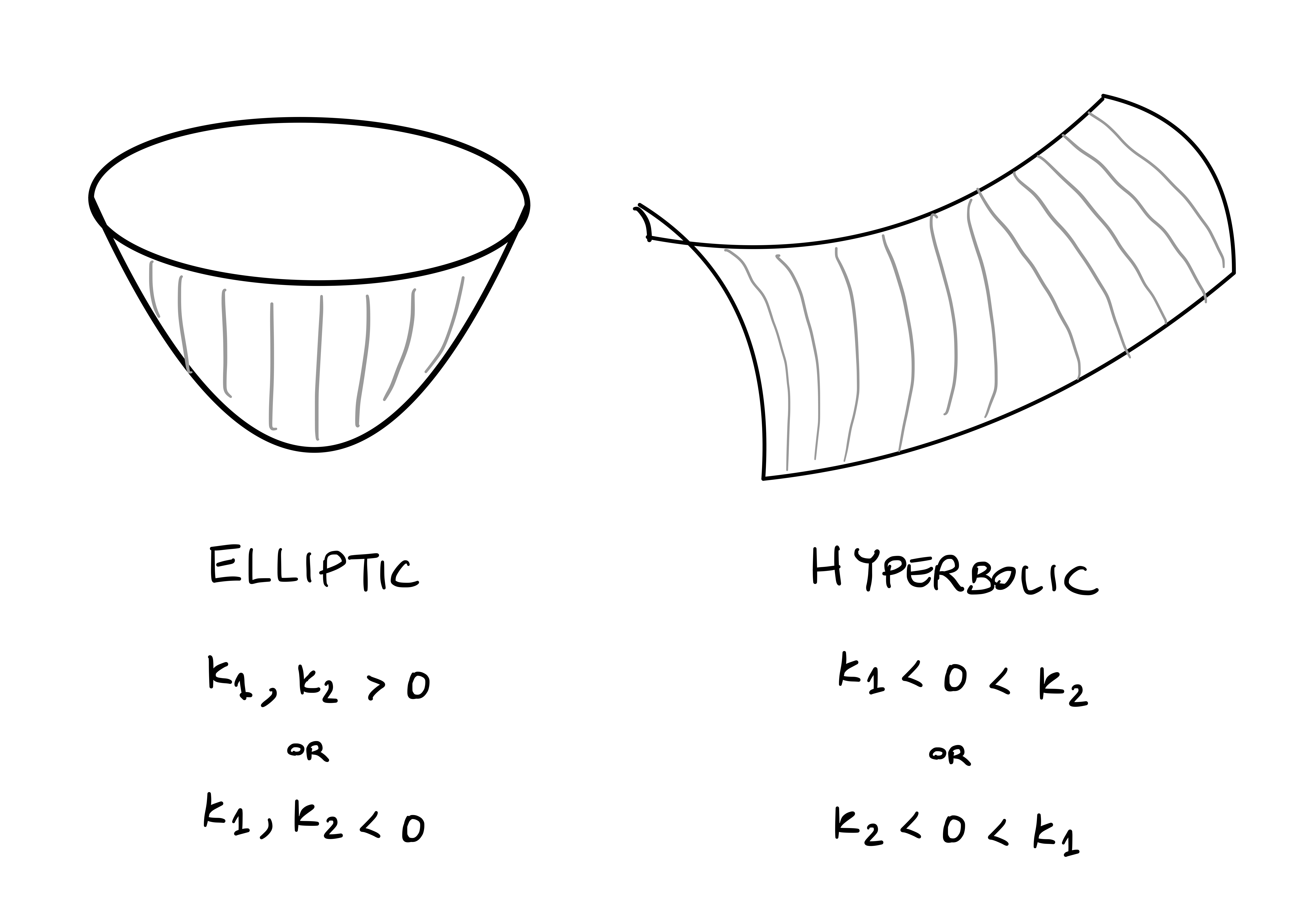
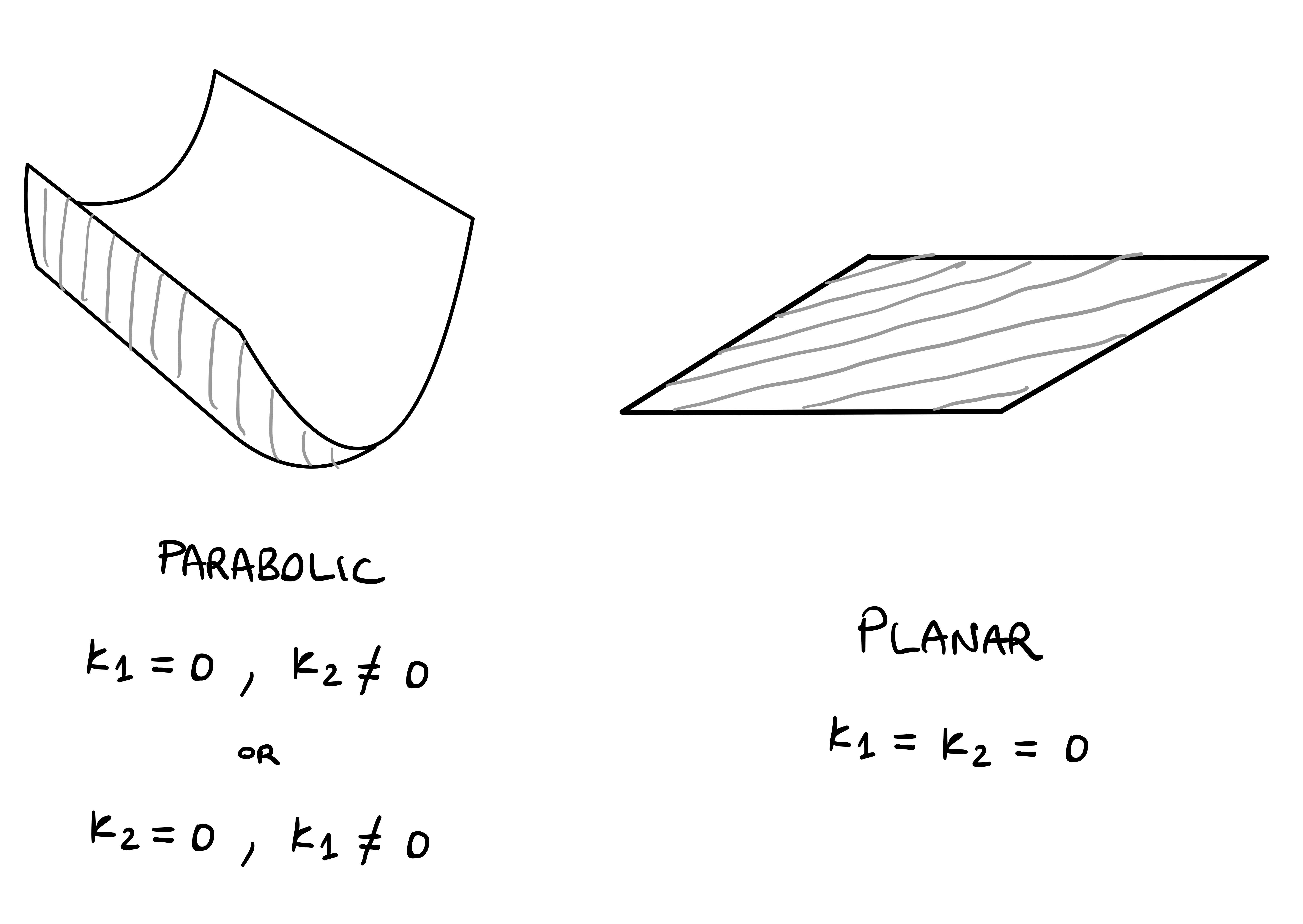
Sometimes it is not easy to compute the principal curvatures \(\kappa_1,\kappa_2\) explicitly. However, the Gaussian curvature \(K\) is simpler to compute, as it is just the determinant of the matrix of the Weingarten map. As \(K = \kappa_1\kappa_2\), we can still infer some information about the local shape type from the knowledge of \(K\).
Proposition 231: Gaussian curvature and local shape
Let \(\mathcal{S}\) be a regular surface, with \(K(\mathbf{p})\) the Gaussian curvature at \(\mathbf{p}\). The point \(\mathbf{p}\) is
Elliptic if \(K(\mathbf{p}) > 0\),
Hyperbolic if \(K(\mathbf{p}) < 0\),
Parabolic or Planar if \(K(\mathbf{p}) = 0\).
Proof
The Gaussian curvature satisfies \(K=\kappa_1\kappa_2\) where \(\kappa_1\) and \(\kappa_2\) are the principal curvatures of \(\mathcal{S}\).
If \(K > 0\), then we must have either \(\kappa_1,\kappa_2 > 0\) or \(\kappa_1,\kappa_2<0\). Therefore, the point is elliptic.
If \(K < 0\), then we must have either \(\kappa_1< 0 <\kappa_2\) or \(\kappa_2 < 0 < \kappa_1\). Therefore, the point is hyperbolic.
If \(K = 0\), then we might have
- \(\kappa_1 \neq 0\) and \(\kappa_2 = 0\), or \(\kappa_1 = 0\) and \(\kappa_2 \neq 0\). In both cases the point is parabolic.
- \(\kappa_1 = \kappa_2 = 0\), in which case the point is planar.
Example 232: Analysis of local shape
Question. Consider the surface chart \[ {\pmb{\sigma}}(u, v) = \left(u-v, u+v, u^{2}+v^{2}\right) \,. \]
- Compute the first fundamental form of \({\pmb{\sigma}}\).
- Compute the second fundamental form of \({\pmb{\sigma}}\).
- Compute the matrix of the Weingarten map.
- Show that \(\mathbf{p}= {\pmb{\sigma}}(1,0)\) is an elliptic point.
- Can there be points which are not elliptic?
Solution.
The FFF of \({\pmb{\sigma}}\) is \[\begin{align*} & {\pmb{\sigma}}_{u} =(1,1,2u) &\,& F = {\pmb{\sigma}}_{u} \cdot {\pmb{\sigma}}_v = 4uv \\ & {\pmb{\sigma}}_{v} =(-1,1,2v) &\,&G = {\pmb{\sigma}}_{v} \cdot {\pmb{\sigma}}_v = 2 (1+2v^2) \\ & E = {\pmb{\sigma}}_{u} \cdot {\pmb{\sigma}}_u = 2 (1+2u^2) &\,&\mathscr{F}_{1} = 2\left(\begin{array}{ll} 1 + 2u^2 & 2uv \\ 2uv & 1 + 2v^2 \end{array}\right) \end{align*}\]
The standard unit normal is \[\begin{align*} {\pmb{\sigma}}_{u} \times {\pmb{\sigma}}_{v} & =2(v-u,-u-v, 1) \\ \left\|{\pmb{\sigma}}_{u} \times {\pmb{\sigma}}_{v}\right\| & =2\left( 1 + 2u^2 + 2v^2\right)^{\frac{1}{2}} \\ \mathbf{N}& =\frac{(v-u,-u-v, 1)}{ \left( 1 + 2 u^2 + 2 v^2 \right)^{\frac{1}{2}}} \end{align*}\] The SFF of \({\pmb{\sigma}}\) is \[\begin{align*} & {\pmb{\sigma}}_{u u} =(0,0,2) \qquad \quad L = {\pmb{\sigma}}_{uu} \cdot \mathbf{N}=2 \left( 1 + 2u^{2}+ 2v^{2}\right)^{-\frac{1}{2}} \\ & {\pmb{\sigma}}_{u v} =(0,0,0) \qquad \quad M = {\pmb{\sigma}}_{uv} \cdot \mathbf{N}= 0 \\ & {\pmb{\sigma}}_{v v} =(0,0,2) \qquad \quad N = {\pmb{\sigma}}_{vv} \cdot \mathbf{N}= 2\left(1 + 2u^{2}+ 2v^{2}\right)^{-\frac{1}{2}} \\ & \mathscr{F}_{2} = \left( 1 + 2u^{2}+ 2v^{2}\right)^{-\frac{1}{2}} \, \left(\begin{array}{ll} 1 & 0 \\ 0 & 1 \end{array}\right) \,. \end{align*}\]
The inverse of \(\mathscr{F}_1\) is \[\begin{align*} \mathscr{F}_{1}^{-1} & = \frac{1}{\det (\mathscr{F}_1)} \left( \begin{array}{ll} G & -F \\ -F & E \end{array} \right) \\ & = \frac{1}{2(1 + 2u^2 + 2v^2)} \,\left(\begin{array}{ll} 1 + 2v^2 & -2uv \\ -2uv & 1 + 2u^2 \end{array}\right) \,. \end{align*}\] The matrix of the Weingarten map is \[\begin{align*} \mathcal{W}& = \mathscr{F}_1^{-1} \mathscr{F}_2 \\ & = \frac{1}{(1 + 2u^2 + 2v^2)^{\frac32}} \,\left(\begin{array}{ll} 1 + 2v^2 & -2uv \\ -2uv & 1 + 2u^2 \end{array}\right) \,. \end{align*}\]
For \(u=1\) and \(v=0\) we obtain \[ \mathcal{W} = \frac{1}{3^{\frac32}} \,\left(\begin{array}{ll} 1 & 0 \\ 0 & 3 \end{array}\right) = \left(\begin{array}{ll} 3^{-\frac32} & 0 \\ 0 & 3^{- \frac12} \end{array}\right) \,. \] Therefore the principal curvatures at \(\mathbf{p}\) are \[ \kappa_1(\mathbf{p}) = 3^{-\frac32} > 0 \,, \quad \kappa_2(\mathbf{p}) = 3^{-\frac12} > 0\,. \quad \] Therefore \(\mathbf{p}\) is an elliptic point.
No. This is because the Gaussian curvature is \[ K = \det(\mathcal{W}) = \frac{1}{(1 + 2u^2 + 2v^2)^2} >0\,. \] By Proposition 233 we conclude that every point is elliptic.
Definition 233: Umbilical point
Remark 234
Example 235: Plane and Sphere
Suppose that \(\mathbf{p}\) is an umbilic, that is, \[ \kappa_1(\mathbf{p})=\kappa_2 (\mathbf{p}) \,. \] Let \(\kappa_n\) be the normal curvature of a unit-speed curve \({\pmb{\gamma}}\) passing through \(\mathbf{p}\). By Theorem 223 we have \[ \kappa_n = \kappa_1 \cos^2(\theta) + \kappa_2 \sin^2(\theta) = \kappa_1 \,. \] Therefore \(\kappa_n\) does not depend on \({\pmb{\gamma}}\). Intuitively, this can only happen if in the vicinity of \(\mathbf{p}\) the surface looks like a sphere or a plane. Indeed, the following theorem holds.
Theorem 236: Structure theorem at umbilics
Proof
By assumption, we have \[ \kappa_1 (\mathbf{p}) = \kappa_2 (\mathbf{p}) = \kappa (\mathbf{p}) \,, \quad \forall \, \mathbf{p}\in \mathcal{S}\,. \tag{4.33}\]
Step 1. \(\kappa\) is constant.
By Theorem 207 the principal vectors \(\{\mathbf{t}_1,\mathbf{t}_2\}\) are an orthonormal basis of \(T_{\mathbf{p}} \mathcal{S}\). Hence, for each \(\mathbf{v}\in T_{\mathbf{p}} \mathcal{S}\) there exist \(\lambda,\mu \in \mathbb{R}\) such that \[ \mathbf{v}= \lambda \mathbf{t}_1 + \mu \mathbf{t}_2 \,. \] Using the linearity of \(\mathcal{W}_{\mathbf{p},\mathcal{S}}\) and (4.33) we obtain \[\begin{align*} \mathcal{W}_{\mathbf{p},\mathcal{S}} (\mathbf{v}) & = \lambda \mathcal{W}_{\mathbf{p},\mathcal{S}} ( \mathbf{t}_1) + \mu \mathcal{W}_{\mathbf{p},\mathcal{S}} (\mathbf{t}_2) \\ & = \lambda \kappa \mathbf{t}_1 + \mu \kappa \mathbf{t}_2 \\ & = \kappa \mathbf{v}\,, \end{align*}\] showing that \[ \mathcal{W}_{\mathbf{p},\mathcal{S}} (\mathbf{v}) = \kappa \mathbf{v}\,, \quad \forall \, \mathbf{v}\in T_{\mathbf{p}} \mathcal{S}\,. \tag{4.34}\] Let \({\pmb{\sigma}}\colon U \to \mathbb{R}^3\) be a chart of \(\mathcal{S}\). Up to restricting \({\pmb{\sigma}}\), we can assume that \(U\) is connected. By Lemma 18 we have \[ \mathcal{W}_{\mathbf{p},\mathcal{S}} ({\pmb{\sigma}}_u) = - \mathbf{N}_{u} \,, \quad \mathcal{W}_{\mathbf{p},\mathcal{S}} ({\pmb{\sigma}}_v) = - \mathbf{N}_{v} \,. \] On the other hand, by (4.34) we infer \[ \mathcal{W}_{\mathbf{p},\mathcal{S}} ({\pmb{\sigma}}_u) = \kappa {\pmb{\sigma}}_u \,, \quad \mathcal{W}_{\mathbf{p},\mathcal{S}} ({\pmb{\sigma}}_v) = \kappa {\pmb{\sigma}}_v \,, \] from which \[ \mathbf{N}_{u} = - \kappa {\pmb{\sigma}}_u \,, \quad \mathbf{N}_{v} = - \kappa {\pmb{\sigma}}_v \,. \tag{4.35}\] Thus \[ \left( \kappa {\pmb{\sigma}}_u \right)_v = - \left( \mathbf{N}_u \right)_v = - \left( \mathbf{N}_v \right)_u = \left( \kappa {\pmb{\sigma}}_v \right)_u \,. \] Moreover \[\begin{align*} \left( \kappa {\pmb{\sigma}}_u \right)_v & = \kappa_v {\pmb{\sigma}}_u + \kappa {\pmb{\sigma}}_{uv} \\ \left( \kappa {\pmb{\sigma}}_v \right)_u & = \kappa_u {\pmb{\sigma}}_v + \kappa {\pmb{\sigma}}_{uv} \,, \end{align*}\] so that \[ \kappa_v {\pmb{\sigma}}_u = \kappa_u {\pmb{\sigma}}_v \,. \tag{4.36}\] Recall that \({\pmb{\sigma}}_u\) and \({\pmb{\sigma}}_v\) are linearly independent, being \(\mathcal{S}\) regular. Hence the linear combination at (4.36) must be trivial, implying \[ \kappa_u = \kappa_v = 0 \,. \] Since \(U\) is connected, the above implies that \(\kappa\) is constant.
Step 2. We have the two cases \(\kappa = 0\) and \(\kappa \neq 0\).
Assume \(\kappa = 0\). By (4.35) we get that \[ \mathbf{N}_u = \mathbf{N}_v = {\pmb{0}}\,, \] which implies \(\mathbf{N}\) is constant. Therefore \[ \left( \mathbf{N}\cdot {\pmb{\sigma}}\right)_u = \mathbf{N}_u \cdot {\pmb{\sigma}}+ \mathbf{N}\cdot {\pmb{\sigma}}_u = 0 \] since \(\mathbf{N}_u = {\pmb{0}}\) and \(\mathbf{N}\cdot {\pmb{\sigma}}_u = 0\) because \(\mathbf{N}\) is orthogonal to \(T_{\mathbf{p}} \mathcal{S}\). Similarly we get \[ \left( \mathbf{N}\cdot {\pmb{\sigma}}\right)_v = 0 \,, \] showing that \(\mathbf{N}\cdot {\pmb{\sigma}}\) is constant. Hence there exists \(c \in \mathbb{R}\) such that \[ \mathbf{N}\cdot {\pmb{\sigma}}(u,v) = c \,, \quad \forall \, (u,v) \in U \,. \] This shows \({\pmb{\sigma}}(U)\) is contained in the plane \[ \pi = \{ \mathbf{x}\in \mathbb{R}^3 \, \colon \,\mathbf{N}\cdot \mathbf{x}= c \} \,. \]
Assume \(\kappa \neq 0\). Condition (4.35) implies \[ \mathbf{N}= -\kappa {\pmb{\sigma}}+ \mathbf{a} \] for some \(\mathbf{a} \in \mathbb{R}^3\) constant vector. Thus \[ \left\| {\pmb{\sigma}}- \frac{1}{\kappa} \mathbf{a} \right\|^2 = \left\| - \frac{1}{\kappa} \mathbf{N}\right\|^2 = \frac{1}{\kappa^2} \,, \] given that \(\| \mathbf{N}\| = 1\). Therefore \({\pmb{\sigma}}(U)\) is contained in the sphere of center \(\mathbf{a}/\kappa\) and radius \(1/\kappa\).
Proposition 237: Criterion for umbilics
Proof
Part 2. If \(K(\mathbf{p}) < 0\), then we cannot have that \(K(\mathbf{p}) = H^2(\mathbf{p})\). Therefore, by Part 1, \(\mathbf{p}\) cannot be umbilical.
Proposition 238: Chart criterion for umbilics
Proof
Example 239: Plane and Sphere
If the plane is charted as in Example 205, the FFF and SFF are \[ \mathscr{F}_1 = \left( \begin{array}{cc} 1 & 0 \\ 0 & 1 \end{array} \right) \,, \qquad \mathscr{F}_2 = \left( \begin{array}{cc} 0 & 0 \\ 0 & 0 \end{array} \right) \,. \] Therefore \(\mathscr{F}_2 = \kappa \mathscr{F}_1\) with \(\kappa = 0\), and all points are umbilical.
If the sphere is charted as in Example 214, the FFF and SFF are \[ \mathscr{F}_1 = \mathscr{F}_2 = \left( \begin{array}{cc} \cos^2(v) & 0 \\ 0 & 1 \end{array} \right) \,. \] Since \(\mathscr{F}_2 = \mathscr{F}_1\), all points on the sphere are umbilical.
Remark 240: How to find umbilics
Proof
Example 241: Local shape of the Monkey Saddle
Question. Consider the Monkey Saddle surface \(\mathcal{S}\) described by \[ z = x^3 - 3xy^2 \,. \]
- Compute the Gaussian curvature of \(\mathcal{S}\).
- Does \(\mathcal{S}\) contain any hyperbolic point?
- Prove that the origin is the only umbilical point.
Solution. The Monkey Saddle is charted by \[ {\pmb{\sigma}}(u,v) = (u,v, u^3 - 3uv^2) \,. \] The FFF of \({\pmb{\sigma}}\) is \[\begin{align*} & {{\pmb{\sigma}}}_{u}= (1,0,3(u^2 - v^2)) &&F = {{\pmb{\sigma}}}_{u}\cdot {{\pmb{\sigma}}}_{v}= - 18 uv (u^2 - v^2) \\ & {{\pmb{\sigma}}}_{v}= (0,1,-6uv) && G = {{\pmb{\sigma}}}_{v}\cdot {{\pmb{\sigma}}}_{v}= 1 + 36u^2v^2 \\ & E = {{\pmb{\sigma}}}_{u}\cdot {{\pmb{\sigma}}}_{u}= 1 + 9 (u^2 - v^2)^2 \\ \end{align*}\] The SFF of \({\pmb{\sigma}}\) is \[\begin{align*} {{\pmb{\sigma}}}_{u}\times {{\pmb{\sigma}}}_{v}& = (-3(u^2-v^2), 6uv, 1) \\ \left\| {{\pmb{\sigma}}}_{u}\times {{\pmb{\sigma}}}_{v} \right\| & = 1 + 36u^2v^2 + 9 (u^2 - v^2)^2 \\ & = 1 + 9u^4 + 9v^4 + 18u^2v^2 \\ & = 1 + 9 (u^2 + v^2)^2 \\ \mathbf{N}& = \frac{(-3(u^2-v^2), 6uv, 1)}{\sqrt{1 + 9 (u^2 + v^2)^2 }} \\ {\pmb{\sigma}}_{uu} & = (0,0,6u) \\ {\pmb{\sigma}}_{uv} & = (0,0,-6v) \\ {\pmb{\sigma}}_{vv} & = (0,0,-6u) \\ L & = {\pmb{\sigma}}_{uu} \cdot \mathbf{N}= \frac{6u}{\sqrt{1 + 9 (u^2 + v^2)^2 }}\\ M & = {\pmb{\sigma}}_{uv} \cdot \mathbf{N}= \frac{-6v}{\sqrt{1 + 9 (u^2 + v^2)^2 }}\\ N & = {\pmb{\sigma}}_{vv} \cdot \mathbf{N}= \frac{6u}{\sqrt{1 + 9 (u^2 + v^2)^2 }} \end{align*}\]
We have that \[\begin{align*} EG-F^2 & = (1 + 9 (u^2 - v^2)^2)(1 + 36u^2v^2) - (- 18 uv (u^2 - v^2))^2 \\ & = 1 + 36u^2v^2 + 9 (u^2 - v^2)^2 \\ & = 1 + 9u^4 + 9v^4 + 18u^2v^2 \\ & = 1 + 9 (u^2 + v^2)^2 \\ LN-M^2 & = -\frac{36(u^2 + v^2)}{ 1 + 9 (u^2 + v^2)^2 } \end{align*}\] Therefore the Gaussian curvature is \[ K = \frac{LN - M^2}{EG-F^2} = - \frac{36 (u^2 + v^2)}{[1 + 9 (u^2 + v^2)^2]^2} \,. \]
Note that \[ K < 0 \,, \quad \forall \, (u,v) \neq (0,0) \,. \] By Proposition 233, we conclude that all the points outside of the origin are hyperbolic.
Since \(K<0\) everywhere except at the origin, Proposition 239 implies that points outside the origin cannot be umbilic. At \((0,0)\), we have \[ \mathscr{F}_1 = du^2 + dv^2 \,, \quad \mathscr{F}_2 = 0 \,. \] Therefore \(\mathscr{F}_2\) is a multiple of \(\mathscr{F}_1\), and by Proposition 240 we conclude that \((0,0)\) is an umbilical point. Note: the matrix of the Weingarten map is \(\mathcal{W}= \mathscr{F}^{-1}_1 \mathscr{F}_2 = 0\). Therefore the principal curvatures are \(\kappa_1 = \kappa_2 = 0\), showing that \((0,0)\) is a planar point.

4.15 Conclusion: FTS and Theorema Egregium
We conclude by discussing two important and powerful Theorems:
- Fundamental Theorem of Surfaces (FTS)
- Theorema Egregium
We proceed in analogy with curves: for each point of the surface we assign a basis of \(\mathbb{R}^3\), analogous to the Frenet frame. Let \(\mathcal{S}\) be an orientable surface and \({\pmb{\sigma}}\) a chart at \(\mathbf{p}\). The triple \[ \{{\pmb{\sigma}}_u,{{\pmb{\sigma}}}_{v},\mathbf{N}\} \] gives a basis of \(\mathbb{R}^3\) (not orthonormal, but it does not matter). We can now express the derivatives of \({{\pmb{\sigma}}}_{u}\) and \({{\pmb{\sigma}}}_{v}\) with respect to such basis.
Proposition 242: Christoffel symbols
Proof
Note that the Christoffel symbols depend only on the first fundamental form of \(\boldsymbol{\sigma}\).
The question is whether there are relations between the first and second fundamental forms. As it turns out, all the existing relations are encoded in two sets of equations:
- Codazzi-Mainardi Equations
- Gauss Equations
Proposition 243: Codazzi-Mainardi and Gauss Equations
Let \({\pmb{\sigma}}\) be a regular chart, with first and second fundamental forms \[ E du^2 + F du dv + G dv^2 \,, \quad L du^2 + M du dv + N dv^2 \,, \] and Christoffel symbols as in Proposition 242. They are satisfied:
The Codazzi-Mainardi Equations \[ \begin{aligned} L_v-M_u & =L \Gamma_{12}^1+M\left(\Gamma_{12}^2-\Gamma_{11}^1\right)-N \, \Gamma_{11}^2 \\ M_v-N_u & =L \Gamma_{22}^1+M\left(\Gamma_{22}^2-\Gamma_{12}^1\right)-N \, \Gamma_{12}^2 \end{aligned} \]
The Gauss Equations \[ \begin{aligned} E K & =\left(\Gamma_{11}^2\right)_v-\left(\Gamma_{12}^2\right)_u+\Gamma_{11}^1 \Gamma_{12}^2+\Gamma_{11}^2 \Gamma_{22}^2-\Gamma_{12}^1 \Gamma_{11}^2-\left(\Gamma_{12}^2\right)^2 \\ F K & = \left(\Gamma_{12}^1\right)_u-\left(\Gamma_{11}^1\right)_v+\Gamma_{12}^2 \Gamma_{12}^1-\Gamma_{11}^2 \Gamma_{22}^1 \\ F K & = \left(\Gamma_{12}^2\right)_v-\left(\Gamma_{22}^2\right)_u+\Gamma_{12}^1 \Gamma_{12}^2-\Gamma_{22}^1 \Gamma_{11}^2 \\ G K & = \left(\Gamma_{22}^1\right)_u-\left(\Gamma_{12}^1\right)_v+\Gamma_{22}^1 \Gamma_{11}^1+\Gamma_{22}^2 \Gamma_{12}^1-\left(\Gamma_{12}^1\right)^2-\Gamma_{12}^2 \Gamma_{22}^1 \end{aligned} \] where \(K\) denotes the Gaussian curvature of \({\pmb{\sigma}}\).
The proof involves a lot of calculations, and we decide to omit it. For a reference, see Propositions 10.1.1 and 10.1.2 in (Pressley 2010).
The Codazzi-Mainardi and Gauss equations are necessary and sufficient to completely determine a surface, up to rigid motions. This is the statement of the Fundamental Theorem of Surfaces, which can be seen as the surfaces analogue of the Fundamental Theorem of Space Curves: Curvature and torsion completely characterize a regular curve, up to rigid motions. The equivalent Theorem for surfaces states that First and Second Fundamental Forms, with coefficients satisfying the Codazzi-Mainardi and Gauss equations, completely determine a surface, up to rigid motions.
Theorem 244: Fundamental Theorem of Surfaces (FTS)
Let \({\pmb{\sigma}}\colon U \to \mathbb{R}^3\) and \(\widetilde{{\pmb{\sigma}}}\colon U \to \mathbb{R}^3\) be regular surface charts with the same first and second fundamental form. Then, there exists a rigid motion \(M \colon \mathbb{R}^3 \to \mathbb{R}^3\) such that \[ \widetilde{{\pmb{\sigma}}}= M({\pmb{\sigma}}) \,. \]
Let \(V \subseteq \mathbb{R}^3\) be open, and \[ E,F,G,L,M,N \colon V \to \mathbb{R} \] be smooth functions on \(V\), such that \[ E>0, \quad G > 0 , \quad EG-F^2 > 0 \,, \] and satisfying the Codazzi-Mainardi and Gauss equations in Proposition 243, with \[ K = \frac{LN - M^2}{EG - F^2} \,. \] Then, if \((u_0,v_0) \in V\), there exists
- an open set \(U \subseteq V\) containing \((u_0,v_0)\)
- a regular surface chart \({\pmb{\sigma}}\colon U \to \mathbb{R}^3\) with first and second fundamental forms given by \[ E du^2 + F du dv + G dv^2 \,, \quad L du^2 + M du dv + N dv^2 \,. \]
The proof of the FTS is very complicated, as it involves PDEs, and is found at page 239 of (do Carmo 2017). The FTS is the reason why the differential geometry of surfaces is still an active field of research today:
- If one wishes to construct a surface with prescribed first and second fundamental form, then one needs to solve the Codazzi-Mainardi and Gauss Equations
- These are very complicated PDEs
- Examples of active research directions are
- Minimal Surfaces
- Costant Mean Curvature Surfaces
- Geometric Flows: a surface evolves following the direction of steepest descent of some energy
- An example of Geometric flow is the Mean Curvature Flow, in which \(\mathcal{S}\) minimizes \[ F(\mathcal{S}) = \int_{\mathcal{S}} H \, dA \,, \] where \(H\) is the mean curvature of \(\mathcal{S}\).
The other major result we want to talk about is the Theorema Egregium (which means remarkable) by Gauss.
Theorem 245: Theorema Egregium
Proof
The Theorem is remarkable because the Gaussian curvature is defined in terms of both first and second fundamental forms \[ K = \det(\mathcal{W}) = \frac{LN - M^2}{EG-F^2} \,. \] Being a curvature, \(K\) should depend on how the surface bends in space. Instead, the Theorema Egregium shows that \(K\) can be computed using only the first fundamental form, which is a quantity intrinsic to the surface.
As an immediate application, we obtain that there is no perfect World Map:
Proposition 246
Proof
In particular, we have have proven that a map \[ {\pmb{\sigma}}\colon U \subseteq \mathbb{R}^2 \to \mathbb{S}^2 \] cannot be equiareal and conformal at the same time, otherwise it would be an isometry. Therefore, world maps will always distort areas or angles, and there is no world map which preserves both.
The converse of the Theorema Egregium is false: there are surfaces which are not isometric but have the same Gaussian curvature, see the next Example.
Example 247
Question. Define the open set \(U = (0,2\pi) \times (0 ,\infty)\) and let \(\mathcal{S}\) and \(\widetilde{\mathcal{S}}\) the surfaces defined by \(\mathcal{S}={\pmb{\sigma}}(U)\), \(\widetilde{\mathcal{S}}= \widetilde{{\pmb{\sigma}}}(U)\) with \[\begin{align*} {\pmb{\sigma}}(u,v) & = (\cos(u)v, \sin(u)v, \log (v)) \,, \\ \widetilde{{\pmb{\sigma}}}(u,v) & = (\cos(u)v, \sin(u)v, u)\,. \end{align*}\] Note that \(\mathcal{S}\) is the surface of revolution obtained by rotating the curve \((v,0,\log(v))\), while \(\widetilde{\mathcal{S}}\) is a portion of Helicoid.
- Prove that \(\mathcal{S}\) and \(\widetilde{\mathcal{S}}\) are not locally isometric.
- Prove that \(\mathcal{S}\) and \(\widetilde{\mathcal{S}}\) have the same Gaussian curvature.
Solution.
Compute the first fundamental form of \({\pmb{\sigma}}\) \[ \begin{aligned} {{\pmb{\sigma}}}_{u}& = (-\sin(u)v, \cos(u)v, 0) \\ {{\pmb{\sigma}}}_{v}& = (\cos(u), \sin(u), 1/v) \\ E & = {{\pmb{\sigma}}}_{u}\cdot {{\pmb{\sigma}}}_{u}= v^2 \\ F & = {{\pmb{\sigma}}}_{u}\cdot {{\pmb{\sigma}}}_{v}= 0 \\ G & = {{\pmb{\sigma}}}_{v}\cdot {{\pmb{\sigma}}}_{v}= 1 + 1/v^2 \\ \mathscr{F}_1 & = \left( \begin{array}{cc} v^2 & 0 \\ 0 & 1 + 1/v^2 \end{array} \right) \,. \end{aligned} \] The first fundamental form of \(\widetilde{{\pmb{\sigma}}}\) is \[ \begin{aligned} {\widetilde{{\pmb{\sigma}}}}_{u}& = (-\sin(u)v, \cos(u)v, 1) \\ {\widetilde{{\pmb{\sigma}}}}_{v}& = (\cos(u), \sin(u), 0) \\ \widetilde{E}& = {\widetilde{{\pmb{\sigma}}}}_{u}\cdot {\widetilde{{\pmb{\sigma}}}}_{u}= 1 + v^2 \\ \widetilde{F}& = {\widetilde{{\pmb{\sigma}}}}_{u}\cdot {\widetilde{{\pmb{\sigma}}}}_{v}= 0 \\ \widetilde{G}& = {\widetilde{{\pmb{\sigma}}}}_{v}\cdot {\widetilde{{\pmb{\sigma}}}}_{v}= 1 \\ {\widetilde{\mathscr{F}}}_1 & = \left( \begin{array}{cc} 1 + v^2 & 0 \\ 0 & 1 \end{array} \right) \,. \end{aligned} \] Suppose by contradiction there was a local isometry \(f \colon \mathcal{S}\to \widetilde{\mathcal{S}}\). Therefore, the charts \({\pmb{\sigma}}\) and \(f \circ {\pmb{\sigma}}\) would have the same first fundamental form. Since \(f \circ {\pmb{\sigma}}\) and \(\widetilde{{\pmb{\sigma}}}\) are both charts for \(\widetilde{\mathcal{S}}\), there exists a diffeomorphism \(\Phi\) such that \[ f \circ {\pmb{\sigma}}= \Phi \circ \widetilde{{\pmb{\sigma}}}\,. \] In particular, the first fundamental form of \(f \circ {\pmb{\sigma}}\) is the same as the one of \(\Phi \circ \widetilde{{\pmb{\sigma}}}\). In conclusion, \({\pmb{\sigma}}\) and \(\Phi \circ \widetilde{{\pmb{\sigma}}}\) have the same first fundamental form. By Proposition 129, the first fundamental form of \(\Phi \circ \widetilde{{\pmb{\sigma}}}\) is \((J\Phi)^T \widetilde{\mathscr{F}}_1 J\Phi\). Therefore, we have \[ \mathscr{F}_1 = (J\Phi)^T \widetilde{\mathscr{F}}_1 J\Phi \,. \tag{4.41}\] Taking the determinant of both sides, we get \[ \det(\mathscr{F}_1) = \det(J\Phi)^2 \det (\widetilde{\mathscr{F}}_1) \,. \] We compute that \[ \det (\mathscr{F}_1) = \det (\widetilde{\mathscr{F}}_1) = 1 + v^2 \,, \] and thus \[ \det J \Phi = \pm 1 \,. \tag{4.42}\] On the other hand, \[\begin{align*} (J\Phi)^T \widetilde{\mathscr{F}}_1 J\Phi & = \left( \begin{array}{cc} a & c \\ b & d \\ \end{array} \right) \left( \begin{array}{cc} 1 + v^2 & 0 \\ 0 & 1 \\ \end{array} \right) \left( \begin{array}{cc} a & b \\ c & d \\ \end{array} \right) \\ & = \left( \begin{array}{cc} a^2 (1+v^2) + c^2 & \ast \\ \ast & \ast \\ \end{array} \right) \,. \end{align*}\] By (4.41), we get \[ \left( \begin{array}{cc} a^2 (1+v^2) + c^2 & \ast \\ \ast & \ast \\ \end{array} \right) = \left( \begin{array}{cc} v^2 & 0 \\ 0 & 1 + 1/v^2 \\ \end{array} \right) \,. \] Equating the first entries, we obtain \[ a^2 (1+v^2) + c^2 = v^2 \,, \quad \forall \, v > 0 \,. \] Taking the limit for \(v \to 0^+\) gives \[ \lim_{v \to 0^+} \left [ a^2(u,v) + c^2 (u,v) \right] = 0 \,, \] which implies \[ \lim_{v \to 0^+} a (u,v) = 0 \,, \qquad \lim_{v \to 0^+} c (u,v) = 0 \,. \] Therefore, we have that \[ \lim_{v \to 0^+} J\Phi(u,v) = \lim_{v \to 0^+} \left( \begin{array}{cc} a & b \\ c & d \\ \end{array} \right) = \left( \begin{array}{cc} 0 & b \\ 0 & d \\ \end{array} \right) \,. \] By continuity of the determinant, we infer \[ \lim_{v \to 0^+} \det J\Phi (u,v) = \det \left( \begin{array}{cc} 0 & b \\ 0 & d \\ \end{array} \right) = 0 \,. \] This contradicts (4.42). Hence, \(\mathcal{S}\) and \(\widetilde{\mathcal{S}}\) cannot be locally isometric.
Note that we could compute the Gaussian curvature from the first fundamental form, by first computing the Christoffel symbols, and then using the first Gauss Equation. However, we proceed as usual, and compute \(K\) as the determinant of the Weingarten map. To this end, compute the second fundamental forms of \({\pmb{\sigma}}\) and \(\widetilde{{\pmb{\sigma}}}\) \[ \begin{aligned} {\pmb{\sigma}}_{uu} & = (-\cos(u)v,-\sin(u)v, 0) \\ {\pmb{\sigma}}_{uv} & = (-\sin(u),\cos(u), 0) \\ {\pmb{\sigma}}_{vv} & = (0,0, -1/v^2) \\ {{\pmb{\sigma}}}_{u}\times {{\pmb{\sigma}}}_{v}& = (\cos(u),\sin(u),-v) \\ \left\| {{\pmb{\sigma}}}_{u}\times {{\pmb{\sigma}}}_{v} \right\| & = (1 + v^2)^{1/2} \\ \mathbf{N}& = (1 + v^2)^{-1/2} (\cos(u),\sin(u),-v) \\ L & = {\pmb{\sigma}}_{uu} \cdot \mathbf{N}= - v (1 + v^2)^{-1/2} \\ M & = {\pmb{\sigma}}_{uv} \cdot \mathbf{N}= 0 \\ N & = {\pmb{\sigma}}_{vv} \cdot \mathbf{N}= (1 + v^2)^{-1/2}/v \\ \widetilde{{\pmb{\sigma}}}_{uu} & = (-\cos(u)v,-\sin(u)v, 0) \\ \widetilde{{\pmb{\sigma}}}_{uv} & = (-\sin(u),\cos(u), 0) \\ \widetilde{{\pmb{\sigma}}}_{vv} & = (0,0,0) \\ {\widetilde{{\pmb{\sigma}}}}_{u}\times {\widetilde{{\pmb{\sigma}}}}_{v}& = (-\sin(u),\cos(u),-v) \\ \left\| {\widetilde{{\pmb{\sigma}}}}_{u}\times {\widetilde{{\pmb{\sigma}}}}_{v} \right\| & = (1+v^2)^{1/2} \\ \widetilde{\mathbf{N}}& = (1+v^2)^{-1/2} (-\sin(u),\cos(u),-v) \\ \widetilde{L}& = \widetilde{{\pmb{\sigma}}}_{uu} \cdot \widetilde{\mathbf{N}}= 0 \\ \widetilde{M}& = \widetilde{{\pmb{\sigma}}}_{uv} \cdot \widetilde{\mathbf{N}}= (1+v^2)^{-1/2} \\ \widetilde{N}& = \widetilde{{\pmb{\sigma}}}_{vv} \cdot \widetilde{\mathbf{N}}= 0 \end{aligned} \] Therefore, the Gaussian curvature of \({\pmb{\sigma}}\) is \[ K = \frac{LN - M^2}{EG-F^2} = -\frac{ 1 }{(1 + v^2)^2}\,, \] while the one of \(\widetilde{{\pmb{\sigma}}}\) is \[ \widetilde{K} = \frac{\widetilde{L}\widetilde{N}- \widetilde{M}^2}{\widetilde{E}\widetilde{G}- \widetilde{F}^2} = - \frac{ 1 }{ (1 + v^2)^2 } \,, \] showing that \(\mathcal{S}\) and \(\widetilde{\mathcal{S}}\) have the same Gaussian curvature.